Gigaset Communications A580IP UPCS Base Station User Manual Gigaset A580 IP
Gigaset Communications GmbH UPCS Base Station Gigaset A580 IP
User Manual
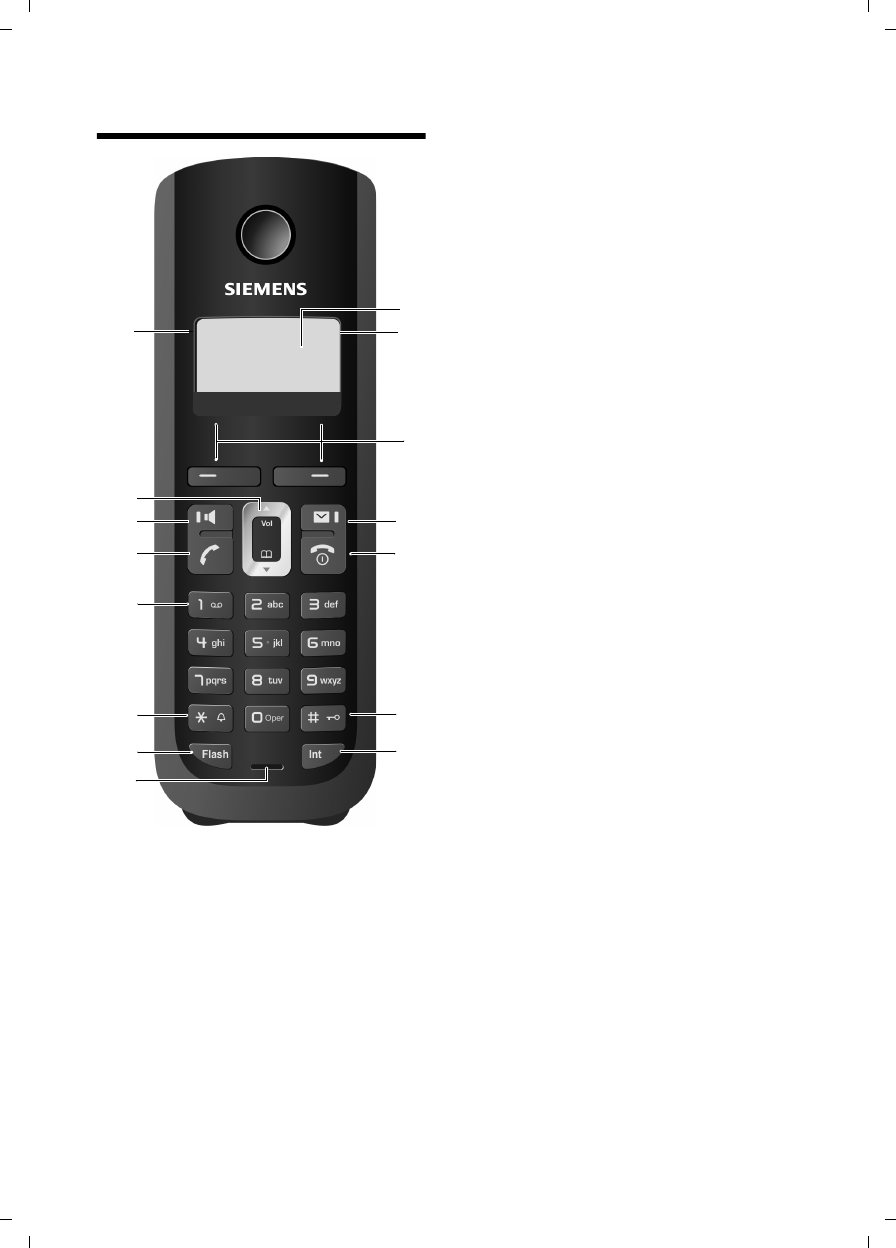
1
The handset at a glance
Gigaset A580 IP / US English / A31008-xxxx-xxxx-x-xxxx / overview.fm / 24.04.2009
Version 8, 03.09.2008
The handset at a glance Handset keys
1Display in idle status (example)
2Charge status of the batteries
(£Page 27)
3Display keys (£Page 30)
4Message key (£Page 58)
Access to Calls and Message lists;
Flashes: new message, new call or
new firmware or new provider profile avail-
able
5End Call key, On/Off key
End call, cancel function, go back one menu
level (press briefly), back to idle status (press
and hold), activate/deactivate handset
(press and hold in idle status)
6Pound key (#)
Keypad lock on/off (press and hold)
(£Page 32)
Switch between upper/lower case letters
and digits for text input (£Page 153)
7Internal key
Make an internal call (£Page 74)
8Microphone
9Flash key
Enter flash "F" (press briefly; £Page 127)
Fixed line network only:
Insert a dialing pause "P" (press and hold)
10 Asterisk key (*)
Idle status:
Ringer melody on/off (press and hold)
Fixed line network: switch between dial
pulsing/touch tone dialing
11 Key 1 (press and hold)
Call a network mailbox (if applicable)
12 Talk key
Answer call, open Last Number Redial list
(press briefly in idle status), select connec-
tion type and start dialing (press briefly/
press and hold after entering the number,
£Page 38)
13 Speaker key
Switch between earpiece and handsfree
mode
Lights up: handsfree talking activated
Flashes: incoming call
14 Control key (£Page 30)
15 Signal strength (£Page 27)
2
3
5
4
6
7
14
13
11
9
10
8
1
12
ÐV
INT 1
10.10.08 07:15
ÞMenu
15

2
Overview of display icons
Gigaset A580 IP / US English / A31008-xxxx-xxxx-x-xxxx / overview.fm / 24.04.2009
Version 8, 03.09.2008
Overview of display icons
=eVU
Charge status of the batteries (empty to fully charged)
=(flashes)
Batteries almost empty
e V U(flashes)
Charging
ÒÑiÐ Reception strength icon
Reception signal strength between the base station and the handset (low to
high)
| (flashes)No reception signal between the base station and the handset
Shortly after activating Eco , the ¼ symbol replaces the reception strength icon
in the top left of the handset's idle display.
ØKeypad lock activated
ÚRinger deactivated
ÅIncoming calls on the fixed line network connection (ringer icon)
MIncoming call on a VoIP connection
¼Alarm clock set
zOpen Last Number Redial list
The base station at a glance
Base station key
1Paging key
Lights up:
LAN connection active (phone is connected to
router)
Flashes:
data transfer to LAN connection
Press briefly:
Initiate paging (£Page 73),
Display the IP address on the handset
Press and hold:
Set base station to registration mode
(£Page 71)
1

3
Contents
Gigaset A580 IP / US English / A31008-xxxx-xxxx-x-xxxx / Gigaset_A580_IPIVZ.fm / 24.04.2009
Version 8, 03.09.2008
Contents
The handset at a glance . . . . . . . . . . . . . . . . . . . . . . . . . . . . . . . . . . 1
Overview of display icons . . . . . . . . . . . . . . . . . . . . . . . . . . . . . . . . 2
The base station at a glance . . . . . . . . . . . . . . . . . . . . . . . . . . . . . . 2
Safety precautions . . . . . . . . . . . . . . . . . . . . . . . . . . . . . . . . . . . . . . 7
Gigaset A580 IP – more than just making calls . . . . . . . . . . . . . . . 8
VoIP – making calls via the Internet . . . . . . . . . . . . . . . . . . . . . . . . 9
Gigaset HDSP – telephony with brilliant sound quality . . . . . . . . 9
First steps . . . . . . . . . . . . . . . . . . . . . . . . . . . . . . . . . . . . . . . . . . . . 10
Checking the package contents . . . . . . . . . . . . . . . . . . . . . . . . . . . . . . . . . . 10
Setting up the handset for use . . . . . . . . . . . . . . . . . . . . . . . . . . . . . . . . . . . 11
Installing the base station . . . . . . . . . . . . . . . . . . . . . . . . . . . . . . . . . . . . . . . 17
Connecting the base station . . . . . . . . . . . . . . . . . . . . . . . . . . . . . . . . . . . . . 18
Making settings for VoIP telephony . . . . . . . . . . . . . . . . . . . . . . . . . . . . . . . . 21
What would you like to do next? . . . . . . . . . . . . . . . . . . . . . . . . . . . . . . . . . . 29
Operating the handset . . . . . . . . . . . . . . . . . . . . . . . . . . . . . . . . . 30
Using the Control key . . . . . . . . . . . . . . . . . . . . . . . . . . . . . . . . . . . . . . . . . . 30
Using the Display keys . . . . . . . . . . . . . . . . . . . . . . . . . . . . . . . . . . . . . . . . . . 30
Using the keys on the keypad . . . . . . . . . . . . . . . . . . . . . . . . . . . . . . . . . . . . 31
Correcting text entry errors . . . . . . . . . . . . . . . . . . . . . . . . . . . . . . . . . . . . . . 31
Using the menus . . . . . . . . . . . . . . . . . . . . . . . . . . . . . . . . . . . . . . . . . . . . . . 31
Activating/deactivating the handset . . . . . . . . . . . . . . . . . . . . . . . . . . . . . . . 32
Activating/deactivating the keypad lock . . . . . . . . . . . . . . . . . . . . . . . . . . . . 32
Using this guide . . . . . . . . . . . . . . . . . . . . . . . . . . . . . . . . . . . . . . . . . . . . . . . 33
Menu trees . . . . . . . . . . . . . . . . . . . . . . . . . . . . . . . . . . . . . . . . . . . 34
Phone menu . . . . . . . . . . . . . . . . . . . . . . . . . . . . . . . . . . . . . . . . . . . . . . . . . 34
Web configurator menu . . . . . . . . . . . . . . . . . . . . . . . . . . . . . . . . . . . . . . . . 37
Making calls with VoIP and the fixed line network . . . . . . . . . . 38
Making an external call . . . . . . . . . . . . . . . . . . . . . . . . . . . . . . . . . . . . . . . . . 38
Ending a call . . . . . . . . . . . . . . . . . . . . . . . . . . . . . . . . . . . . . . . . . . . . . . . . . 41
Accepting a call . . . . . . . . . . . . . . . . . . . . . . . . . . . . . . . . . . . . . . . . . . . . . . . 41
Caller ID . . . . . . . . . . . . . . . . . . . . . . . . . . . . . . . . . . . . . . . . . . . . . . . . . . . . . 42
Using speaker mode . . . . . . . . . . . . . . . . . . . . . . . . . . . . . . . . . . . . . . . . . . . 44
Muting the handset . . . . . . . . . . . . . . . . . . . . . . . . . . . . . . . . . . . . . . . . . . . . 45
Deactivating your handset's microphone . . . . . . . . . . . . . . . . . . . . . . . . . . . 45
Making cost-effective calls . . . . . . . . . . . . . . . . . . . . . . . . . . . . . . . . . . . . . . 45

4
Contents
Gigaset A580 IP / US English / A31008-xxxx-xxxx-x-xxxx / Gigaset_A580_IPIVZ.fm / 24.04.2009
Version 8, 03.09.2008
VoIP telephony via Gigaset.net . . . . . . . . . . . . . . . . . . . . . . . . . . . 46
Opening the Gigaset.net directory . . . . . . . . . . . . . . . . . . . . . . . . . . . . . . . . 47
Searching for subscribers in the Gigaset.net directory . . . . . . . . . . . . . . . . . 48
Using other functions . . . . . . . . . . . . . . . . . . . . . . . . . . . . . . . . . . . . . . . . . . 50
Managing your own entry . . . . . . . . . . . . . . . . . . . . . . . . . . . . . . . . . . . . . . . 50
Calling a Gigaset.net subscriber . . . . . . . . . . . . . . . . . . . . . . . . . . . . . . . . . . 51
Network services . . . . . . . . . . . . . . . . . . . . . . . . . . . . . . . . . . . . . . 52
Blocking your Caller ID – Anonymous calling . . . . . . . . . . . . . . . . . . . . . . . . 52
Further network services for fixed line networks . . . . . . . . . . . . . . . . . . . . . 52
Further network services for VoIP . . . . . . . . . . . . . . . . . . . . . . . . . . . . . . . . . 53
Using lists . . . . . . . . . . . . . . . . . . . . . . . . . . . . . . . . . . . . . . . . . . . . 57
using the Last Number Redial list . . . . . . . . . . . . . . . . . . . . . . . . . . . . . . . . . 57
Opening lists with the Message key . . . . . . . . . . . . . . . . . . . . . . . . . . . . . . . 58
Using the directory . . . . . . . . . . . . . . . . . . . . . . . . . . . . . . . . . . . . 62
Using the network mailbox . . . . . . . . . . . . . . . . . . . . . . . . . . . . . . 66
Configuring the network mailbox for fast access . . . . . . . . . . . . . . . . . . . . . 66
Listening to messages on the network mailbox . . . . . . . . . . . . . . . . . . . . . . 67
ECO DECT: Conserving energy . . . . . . . . . . . . . . . . . . . . . . . . . . . 69
Setting the alarm clock . . . . . . . . . . . . . . . . . . . . . . . . . . . . . . . . . 70
Activating/deactivating the alarm clock . . . . . . . . . . . . . . . . . . . . . . . . . . . . 70
Changing the wake-up time . . . . . . . . . . . . . . . . . . . . . . . . . . . . . . . . . . . . . 70
When the alarm clock rings… . . . . . . . . . . . . . . . . . . . . . . . . . . . . . . . . . . . . 70
Using multiples handsets . . . . . . . . . . . . . . . . . . . . . . . . . . . . . . . 71
Registering handsets . . . . . . . . . . . . . . . . . . . . . . . . . . . . . . . . . . . . . . . . . . . 71
De-registering handsets . . . . . . . . . . . . . . . . . . . . . . . . . . . . . . . . . . . . . . . . 72
Locating a handset ("paging") . . . . . . . . . . . . . . . . . . . . . . . . . . . . . . . . . . . . 73
Changing a handset's internal number . . . . . . . . . . . . . . . . . . . . . . . . . . . . . 73
Changing the name of a handset . . . . . . . . . . . . . . . . . . . . . . . . . . . . . . . . . 74
Making internal calls . . . . . . . . . . . . . . . . . . . . . . . . . . . . . . . . . . . . . . . . . . . 74
Handset settings . . . . . . . . . . . . . . . . . . . . . . . . . . . . . . . . . . . . . . 77
Changing the date and time . . . . . . . . . . . . . . . . . . . . . . . . . . . . . . . . . . . . . 77
Changing the display language . . . . . . . . . . . . . . . . . . . . . . . . . . . . . . . . . . . 77
Activating/deactivating the screensaver . . . . . . . . . . . . . . . . . . . . . . . . . . . . 78
Quickly accessing functions . . . . . . . . . . . . . . . . . . . . . . . . . . . . . . . . . . . . . 79
Activating/deactivating auto answer . . . . . . . . . . . . . . . . . . . . . . . . . . . . . . . 80
Changing the handsfree/earpiece volume . . . . . . . . . . . . . . . . . . . . . . . . . . 80
Setting ringers . . . . . . . . . . . . . . . . . . . . . . . . . . . . . . . . . . . . . . . . . . . . . . . . 81
Activating/deactivating advisory tones . . . . . . . . . . . . . . . . . . . . . . . . . . . . . 82
Setting the battery low tone . . . . . . . . . . . . . . . . . . . . . . . . . . . . . . . . . . . . . 83
Restoring the handset default settings . . . . . . . . . . . . . . . . . . . . . . . . . . . . . 83

5
Contents
Gigaset A580 IP / US English / A31008-xxxx-xxxx-x-xxxx / Gigaset_A580_IPIVZ.fm / 24.04.2009
Version 8, 03.09.2008
Setting the base station via the handset . . . . . . . . . . . . . . . . . . . 84
Protecting against unauthorized access . . . . . . . . . . . . . . . . . . . . . . . . . . . . 84
Restoring the base station to the factory settings . . . . . . . . . . . . . . . . . . . . 85
Activating/deactivating music on hold . . . . . . . . . . . . . . . . . . . . . . . . . . . . . 86
Setting default connection . . . . . . . . . . . . . . . . . . . . . . . . . . . . . . . . . . . . . . 86
Entering local and extra area codes . . . . . . . . . . . . . . . . . . . . . . . . . . . . . . . 87
Updating the base station firmware . . . . . . . . . . . . . . . . . . . . . . . . . . . . . . . 87
Making VoIP settings on the handset . . . . . . . . . . . . . . . . . . . . . 89
Using the connection wizard . . . . . . . . . . . . . . . . . . . . . . . . . . . . . . . . . . . . . 89
Changing settings without the connection wizard . . . . . . . . . . . . . . . . . . . . 89
Setting the phone's IP address in LAN . . . . . . . . . . . . . . . . . . . . . . . . . . . . . . 91
Activating/deactivating the display of VoIP status messages . . . . . . . . . . . . 93
Checking the base station MAC address . . . . . . . . . . . . . . . . . . . . . . . . . . . . 93
Operating the base station on the PABX . . . . . . . . . . . . . . . . . . . 94
Changing the dialing mode . . . . . . . . . . . . . . . . . . . . . . . . . . . . . . . . . . . . . . 94
Setting recall . . . . . . . . . . . . . . . . . . . . . . . . . . . . . . . . . . . . . . . . . . . . . . . . . 94
Setting access codes (external line prefixes) . . . . . . . . . . . . . . . . . . . . . . . . 94
Setting pauses . . . . . . . . . . . . . . . . . . . . . . . . . . . . . . . . . . . . . . . . . . . . . . . . 95
Switching temporarily to touch tone dialing (DTMF) . . . . . . . . . . . . . . . . . . 95
Setting the phone with the PC . . . . . . . . . . . . . . . . . . . . . . . . . . . 96
Connecting the PC with the telephone's Web configurator . . . . . . . . . . . . . 96
Logging in, setting the Web configurator language . . . . . . . . . . . . . . . . . . . 98
Logging off . . . . . . . . . . . . . . . . . . . . . . . . . . . . . . . . . . . . . . . . . . . . . . . . . . 98
Using the Web pages . . . . . . . . . . . . . . . . . . . . . . . . . . . . . . . . . . . . . . . . . . . 99
Menu bar . . . . . . . . . . . . . . . . . . . . . . . . . . . . . . . . . . . . . . . . . . . . . . . . . . . . 99
Navigation area . . . . . . . . . . . . . . . . . . . . . . . . . . . . . . . . . . . . . . . . . . . . . . 100
Working area . . . . . . . . . . . . . . . . . . . . . . . . . . . . . . . . . . . . . . . . . . . . . . . . 100
Buttons . . . . . . . . . . . . . . . . . . . . . . . . . . . . . . . . . . . . . . . . . . . . . . . . . . . . . 101
Opening Web pages . . . . . . . . . . . . . . . . . . . . . . . . . . . . . . . . . . . . . . . . . . 101
Setting the phone with the Web configurator . . . . . . . . . . . . . . . . . . . . . . 102
Configuring the IP . . . . . . . . . . . . . . . . . . . . . . . . . . . . . . . . . . . . . . . . . . . . 103
Configuring telephone connections . . . . . . . . . . . . . . . . . . . . . . . . . . . . . . 106
Optimizing voice quality for VoIP connections . . . . . . . . . . . . . . . . . . . . . . 115
Setting the telephone's default connection . . . . . . . . . . . . . . . . . . . . . . . . 119
Activating the fixed line network connection as an alternate connection . 119
Assigning send and receive numbers to handsets . . . . . . . . . . . . . . . . . . . 120
Activating Call Forwarding for VoIP connections . . . . . . . . . . . . . . . . . . . . 121
Entering your own area code, activating/deactivating an automatic
area code for VoIP . . . . . . . . . . . . . . . . . . . . . . . . . . . . . . . . . . . . . . . . . . . . 122
Activating/deactivating network mailbox, entering numbers . . . . . . . . . . 125
Setting DTMF signaling for VoIP . . . . . . . . . . . . . . . . . . . . . . . . . . . . . . . . . 126
Defining Flash key functions for VoIP (hook flash) . . . . . . . . . . . . . . . . . . . 127
Configuring call forwarding via VoIP . . . . . . . . . . . . . . . . . . . . . . . . . . . . . . 127
Defining local communication ports for VoIP . . . . . . . . . . . . . . . . . . . . . . . 128
Messaging . . . . . . . . . . . . . . . . . . . . . . . . . . . . . . . . . . . . . . . . . . . . . . . . . . 130
Configuring info services/activating idle display . . . . . . . . . . . . . . . . . . . . . 133

6
Contents
Gigaset A580 IP / US English / A31008-xxxx-xxxx-x-xxxx / Gigaset_A580_IPIVZ.fm / 24.04.2009
Version 8, 03.09.2008
Changing internal handset numbers and names . . . . . . . . . . . . . . . . . . . . 133
Transferring handset directories to/from the PC . . . . . . . . . . . . . . . . . . . . . 134
Activating VoIP status message display . . . . . . . . . . . . . . . . . . . . . . . . . . . . 136
Starting a firmware update . . . . . . . . . . . . . . . . . . . . . . . . . . . . . . . . . . . . . 137
Activating/deactivating the automatic version check . . . . . . . . . . . . . . . . . 138
Copying the date/time from time server . . . . . . . . . . . . . . . . . . . . . . . . . . . 139
Querying the phone status . . . . . . . . . . . . . . . . . . . . . . . . . . . . . . . . . . . . . 140
Getting help with your phone . . . . . . . . . . . . . . . . . . . . . . . . . . 141
Questions and answers . . . . . . . . . . . . . . . . . . . . . . . . . . . . . . . . . . . . . . . . 141
Using VoIP status codes . . . . . . . . . . . . . . . . . . . . . . . . . . . . . . . . . . . . . . . . 145
Checking service information . . . . . . . . . . . . . . . . . . . . . . . . . . . . . . . . . . . 148
Protecting our environment . . . . . . . . . . . . . . . . . . . . . . . . . . . . 149
Our environmental mission statement . . . . . . . . . . . . . . . . . . . . . . . . . . . . 149
Appendix . . . . . . . . . . . . . . . . . . . . . . . . . . . . . . . . . . . . . . . . . . . . 150
Care . . . . . . . . . . . . . . . . . . . . . . . . . . . . . . . . . . . . . . . . . . . . . . . . . . . . . . . 150
Contact with liquid . . . . . . . . . . . . . . . . . . . . . . . . . . . . . . . . . . . . . . . . . . . 150
Specifications . . . . . . . . . . . . . . . . . . . . . . . . . . . . . . . . . . . . . . . . . . . . . . . . 150
Writing and editing text . . . . . . . . . . . . . . . . . . . . . . . . . . . . . . . . . . . . . . . . 152
Industry Canada Certification . . . . . . . . . . . . . . . . . . . . . . . . . . . . . . . . . . . 154
FCC / ACTA Information . . . . . . . . . . . . . . . . . . . . . . . . . . . . . . . . 155
Safety precautions . . . . . . . . . . . . . . . . . . . . . . . . . . . . . . . . . . . . . . . . . . . . 157
End-user limited warranty . . . . . . . . . . . . . . . . . . . . . . . . . . . . . . . . . . . . . . 159
Gigaset A580 IP – free software . . . . . . . . . . . . . . . . . . . . . . . . . 163
Accessories . . . . . . . . . . . . . . . . . . . . . . . . . . . . . . . . . . . . . . . . . . 171
Glossary . . . . . . . . . . . . . . . . . . . . . . . . . . . . . . . . . . . . . . . . . . . . . 172
Index . . . . . . . . . . . . . . . . . . . . . . . . . . . . . . . . . . . . . . . . . . . . . . . 185
Mounting the charging cradle to the wall . . . . . . . . . . . . . . . . . 196
Mounting the base station to the wall . . . . . . . . . . . . . . . . . . . 196
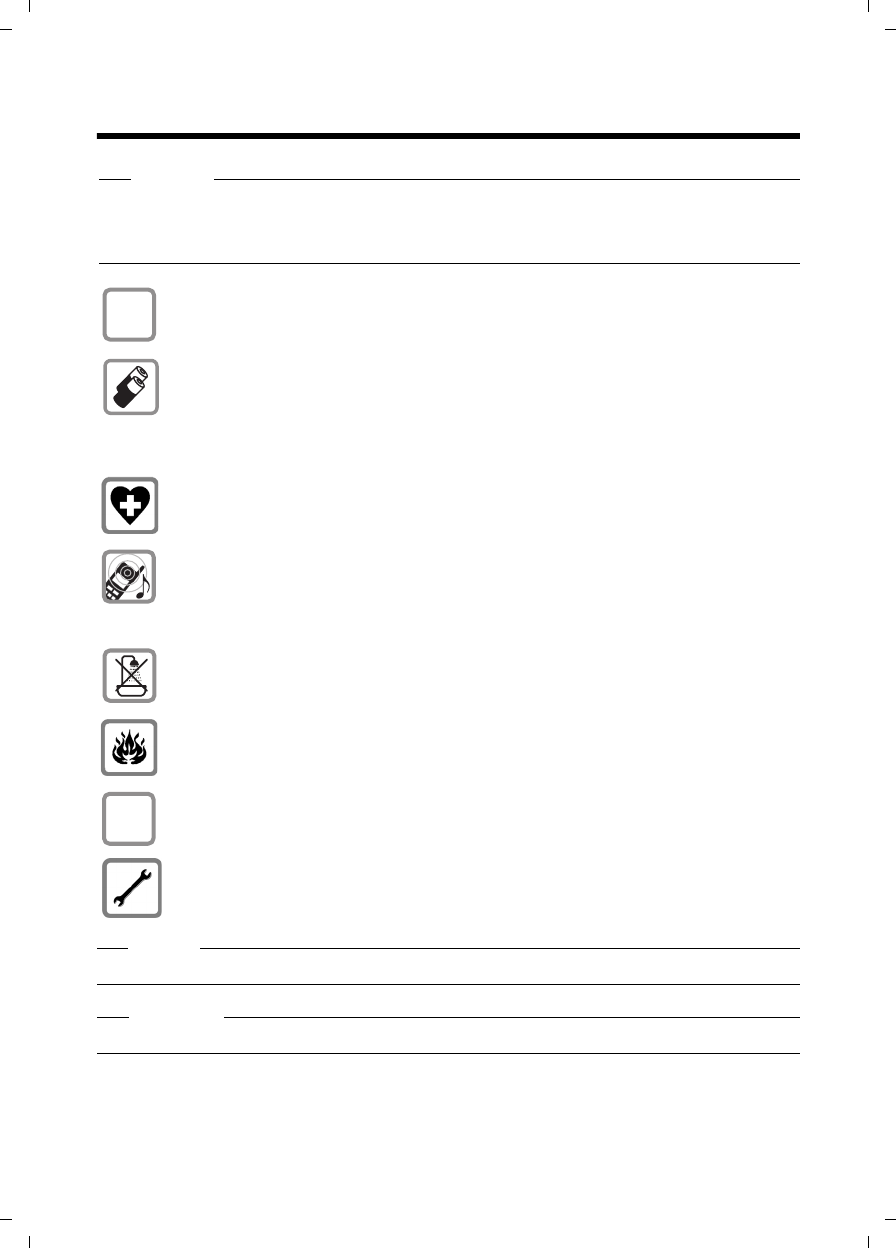
7
Safety precautions
Gigaset A580 IP / US English / A31008-xxxx-xxxx-x-xxxx / security.fm / 24.04.2009
Version 8, 03.09.2008
Safety precautions
Warning
Be sure to read this user guide and the safety precautions before using your telephone.
Explain their content and the potential hazards associated with using the telephone to
your children.
Use only the power adapter supplied, as indicated on the underside of the base
station or charging cradle.
Use only the recommended, rechargeable batteries (£Page 150). Using
conventional (non-rechargeable) batteries or other types of batteries could
result in significant health risks and personal injury.
Do not charge the handset in the charging unit or base station while the headset
is connected.
Using your telephone may affect nearby medical equipment. Be aware of the
technical conditions in your particular environment, e.g. doctor's surgery.
Do not hold the rear of the handset to your ear when it is ringing or when the
handsfree function is activated. Otherwise you risk serious and permanent dam-
age to your hearing.
The handset may cause an unpleasant humming noise in hearing aids.
Do not install the base station or charging cradle in bathrooms or shower rooms.
The handset, base station and charging cradle are not waterproof
(£Page 150).
Do not use the phone in environments with a potential explosion hazard,
e.g. paint shops.
If you give your phone to a third party, make sure you also give them the user
guide.
Remove faulty base stations from use as they could interfere with other wireless
services.
Warning
When the keypad lock is active, you cannot call emergency numbers!
Please note
Not all of the functions described in this user guide are available in all countries.
$
ƒ

8
Gigaset A580 IP – more than just making calls
Gigaset A580 IP / US English / A31008-xxxx-xxxx-x-xxxx / starting.fm / 24.04.2009
Version 8, 03.09.2008
Gigaset A580 IP – more than just making calls
You can use your phone to make calls via the fixed line network and also (cost
effectively) via the Internet (VoIP) without a PC. – Your phone can do much
more:
uMake calls with brilliant sound quality using High Definition Sound
Performance (HDSP) for either internal calls or calls made via VoIP
(£Page 9) – for internal calls or calls via VoIP.
uA simple press of a button each time you make a call indicates whether you
want to call via the fixed line network or the Internet (£Page 38).
uRegister up to six handsets on your base station. With your base station, you
can simultaneously conduct two calls via VoIP and one call via the fixed line
network.
uMultiline: Create up to six VoIP accounts with different VoIP providers.
Together with your fixed line number and the Gigaset.net number, your
phone can then be reached via up to eight different phone numbers.
uAssign each handset its own VoIP number as a send and receive number. If a
member of your family is called on their VoIP number, only their handset will
ring (£Page 120).
uYou can also use the VoIP accounts with different providers for cost control
purposes. When dialing, specify the VoIP connection/the VoIP account you
want to use for its lower rates (£Page 38).
uSetting dialing plans for phone numbers or area codes enables you to auto-
mate the selection of the most cost-effective VoIP connection
(£Page 123).
uUse Gigaset.net for VoIP calls. Connect your phone to the electrical power
supply and the Internet and enjoy free phone calls on Gigaset.net – without
making any further settings (£Page 46).
uConfigure the phone connection for VoIP without a PC. Your phone's con-
nection wizard downloads general data about your VoIP provider from the
Internet and guides you through entering your personal data (VoIP/SIP
account). This makes it easy for you to start using VoIP (£Page 21).
uIf necessary, make any further VoIP settings on a PC. The phone features a
Web interface (Web configurator) that can be accessed via your PC's Web
browser (£Page 96).
uMake sure your phone is always up-to-date. Keep yourself informed about
firmware updates on the Internet and download them onto your phone
(£Page 87).
uReduce the transmission power by activating Eco mode / Eco mode+
(£Page 69).
Have fun using your new phone!
Your Gigaset A580 IP has a protected operating system that offers increased
security against viruses from the Internet.

9
VoIP – making calls via the Internet
Gigaset A580 IP / US English / A31008-xxxx-xxxx-x-xxxx / starting.fm / 24.04.2009
Version 8, 03.09.2008
VoIP – making calls via the Internet
With VoIP (Voice over Internet Protocol), your calls are not made via a fixed con-
nection as with the telephone network, but rather they are transmitted via the
Internet in the form of data packets.
You can take advantage of all the benefits of VoIP with your phone:
uYou can make cost-effective calls in high voice quality with callers on the
Internet, the fixed line network or the cell phone network.
uVoIP providers will give you personal numbers, with which you can be
reached from the Internet, the fixed line network and any cell phone net-
work.
To use VoIP, you need:
uA broadband Internet connection (e.g. DSL) with flat rate (recommended)
or volume-based price.
uInternet access, i.e. you need a router that will connect your phone to the
Internet.
You can find a list of recommended routers on the Internet at:
www.gigaset.com/customercare
From here, go to the FAQ page and select "Gigaset A580 IP". Search for
"Router", for example.
uAccess the services of a VoIP provider. You can open up to six accounts with
different VoIP providers.
Gigaset HDSP – telephony with brilliant sound quality
Your Gigaset IP phone supports the Broadband codec
G.722. With your base station and the corresponding hand-
set, you can make calls via VoIP with brilliant sound quality
(High Definition Sound Performance).
If you register further broadband-capable handsets
(e.g. Gigaset S67H, S68H or SL37H) with your base station, internal calls
between these handsets will also be conducted via broadband.
Prerequisites for broadband connections to your base station are:
uFor internal calls:
Both handsets are broadband-capable, i.e. both support the codec G.722.
uFor external calls via VoIP:
– You make the call from a broadband-capable handset.
– You have selected codec G.722 for outgoing calls, £Page 115.
– Your VoIP provider supports broadband connections.
– The recipient's phone supports codec G.722 and accepts broadband con-
nections.
Please note
The VoIP service Gigaset.net (£Page 46) supports broadband connections.
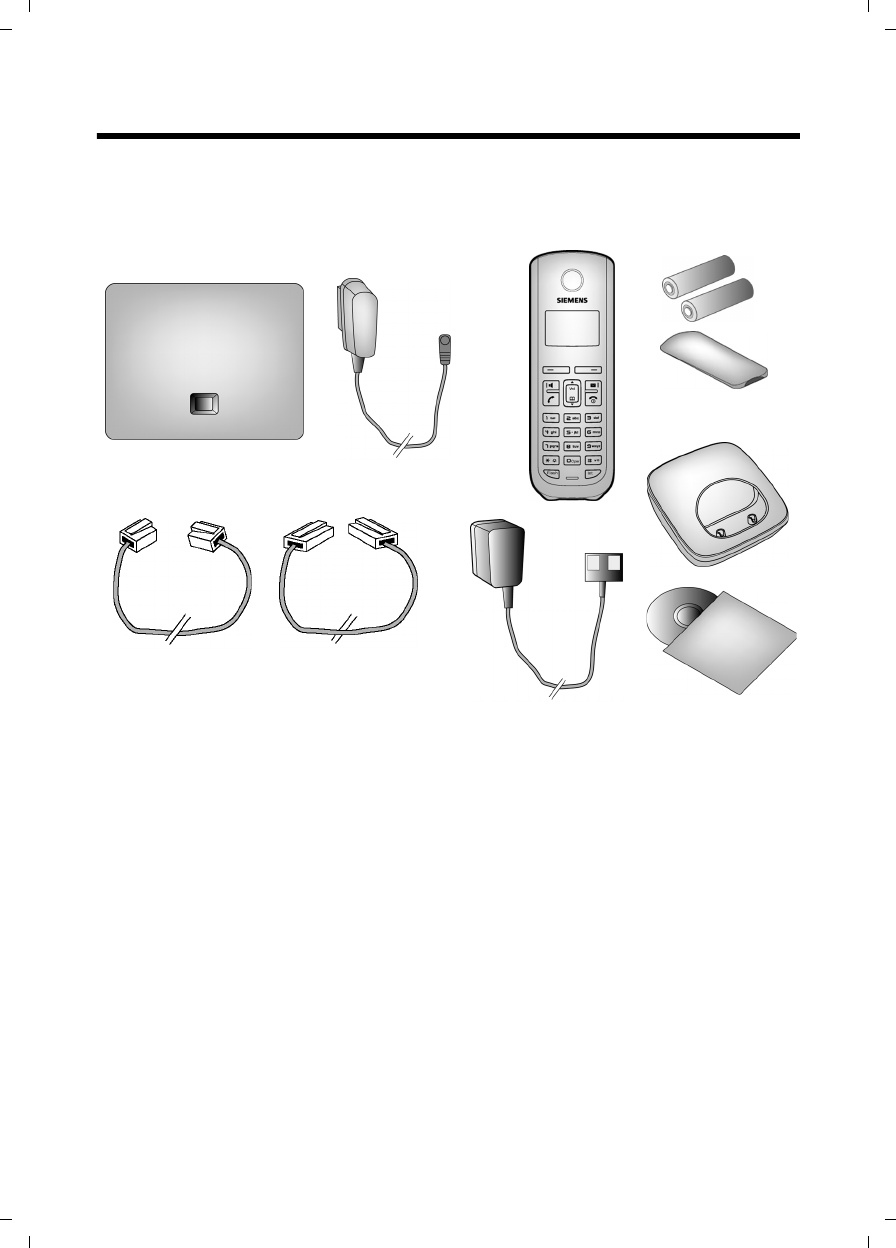
10
First steps
Gigaset A580 IP / US English / A31008-xxxx-xxxx-x-xxxx / starting.fm / 24.04.2009
Version 8, 03.09.2008
First steps
Checking the package contents
§§1§§ one Gigaset A580 IP base station
§§2§§ one power adapter for connecting the base station to the electrical power supply
§§3§§ one phone cord for connecting the base station to the fixed line network
§§4§§ one Ethernet (LAN) cable for connecting the base station to the router (LAN/Internet)
§§5§§ one Gigaset A58H handset
§§6§§ two batteries for the handset (uncharged)
§§7§§ one battery compartment cover for the handset
§§8§§ one handset charging cradle
§§9§§ one power adapter for connecting the charging cradle to the electrical power supply
§§10§§ one quick guide and a CD containing this user guide
12
34
56
7
8
9
10
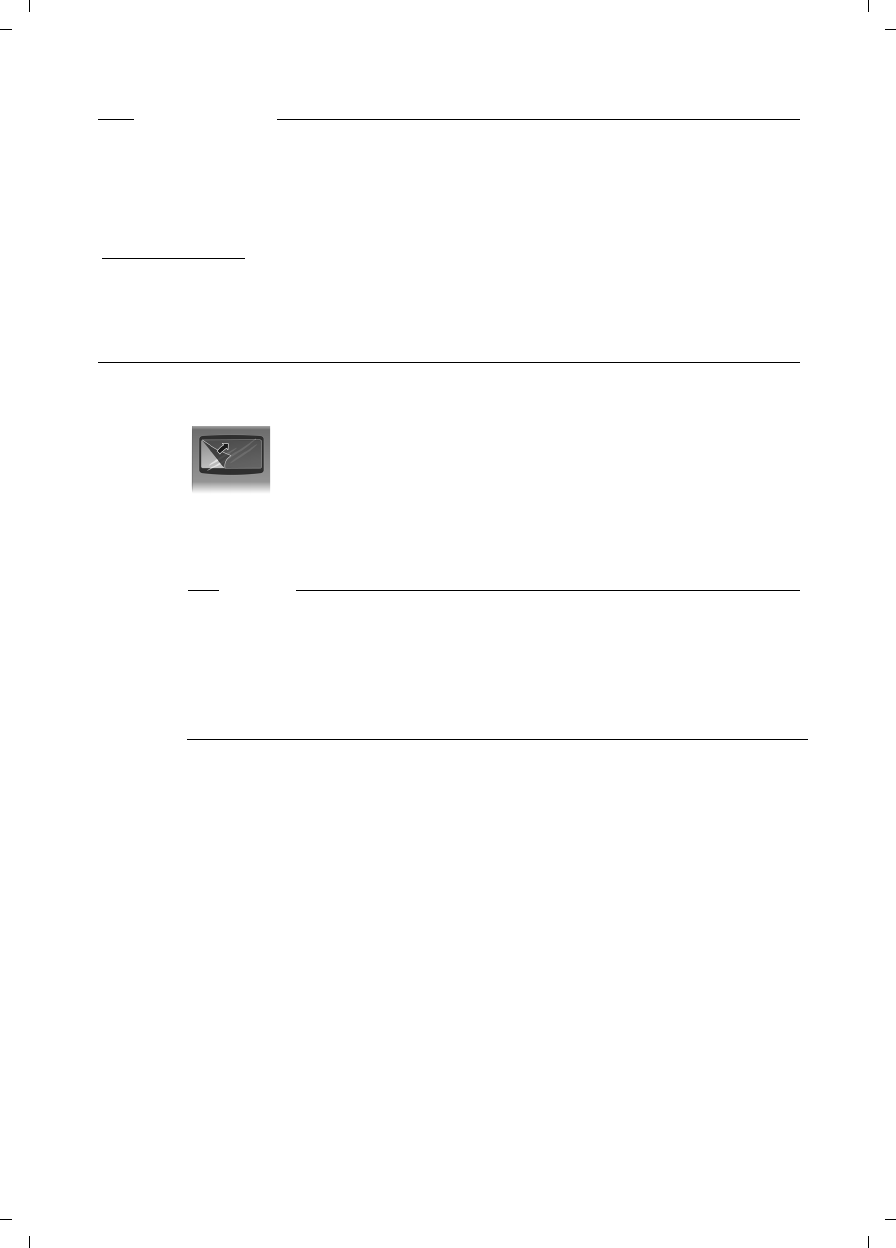
11
First steps
Gigaset A580 IP / US English / A31008-xxxx-xxxx-x-xxxx / starting.fm / 24.04.2009
Version 8, 03.09.2008
Setting up the handset for use
The display is protected by a plastic film.
Please remove the protective film!
Inserting the batteries and closing the battery cover
Use only the recommended, rechargeable batteries (£Page 150). Using con-
ventional (non-rechargeable) batteries or other types of batteries could result
in significant health risks and personal injury. For example, the outer casing of
the batteries could be destroyed or the batteries could explode. The phone
could also malfunction or be damaged as a result of using batteries that are not
of the recommended type.
Firmware updates
This user guide describes the basic functions from firmware version 179.
Whenever there are new or improved functions for your Gigaset A580 IP, base station
firmware updates will be made available for you to download to your telephone
(£Page 87). If this results in operational changes to your phone, a new version of this
user guide or the necessary amendments will be published on the Internet at
www.gigaset.com
Select "Gigaset A580 IP" in the product field to open the relevant product page where you
will find a link to the user guide.
For information on finding the current firmware version of your base station, £Page 140
(using the Web configurator) or £Page 148 (during an external call).
Warning
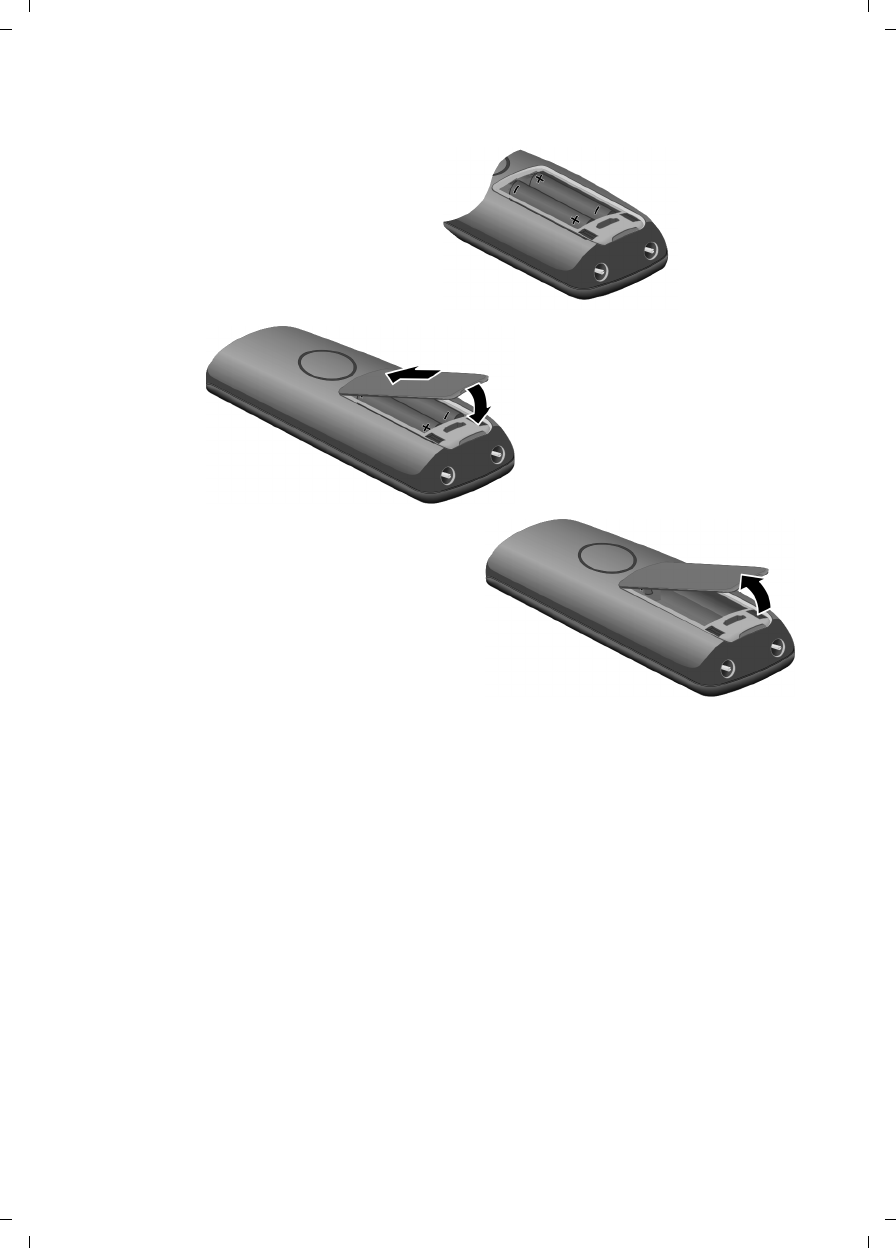
12
First steps
Gigaset A580 IP / US English / A31008-xxxx-xxxx-x-xxxx / starting.fm / 24.04.2009
Version 8, 03.09.2008
¤Insert the batteries
with the polarity in the
correct direction.
The polarity is indi-
cated in/on the battery
compartment.
¤First insert the battery cover
at the top 1.
¤Then press the cover 2 until
it clicks into place.
¤To open the battery cover, for
instance to replace the batteries,
remove the belt clip (if
attached). Insert a coin into the
cavity on the casing, then pull
the battery cover in an upward
direction.
1
2
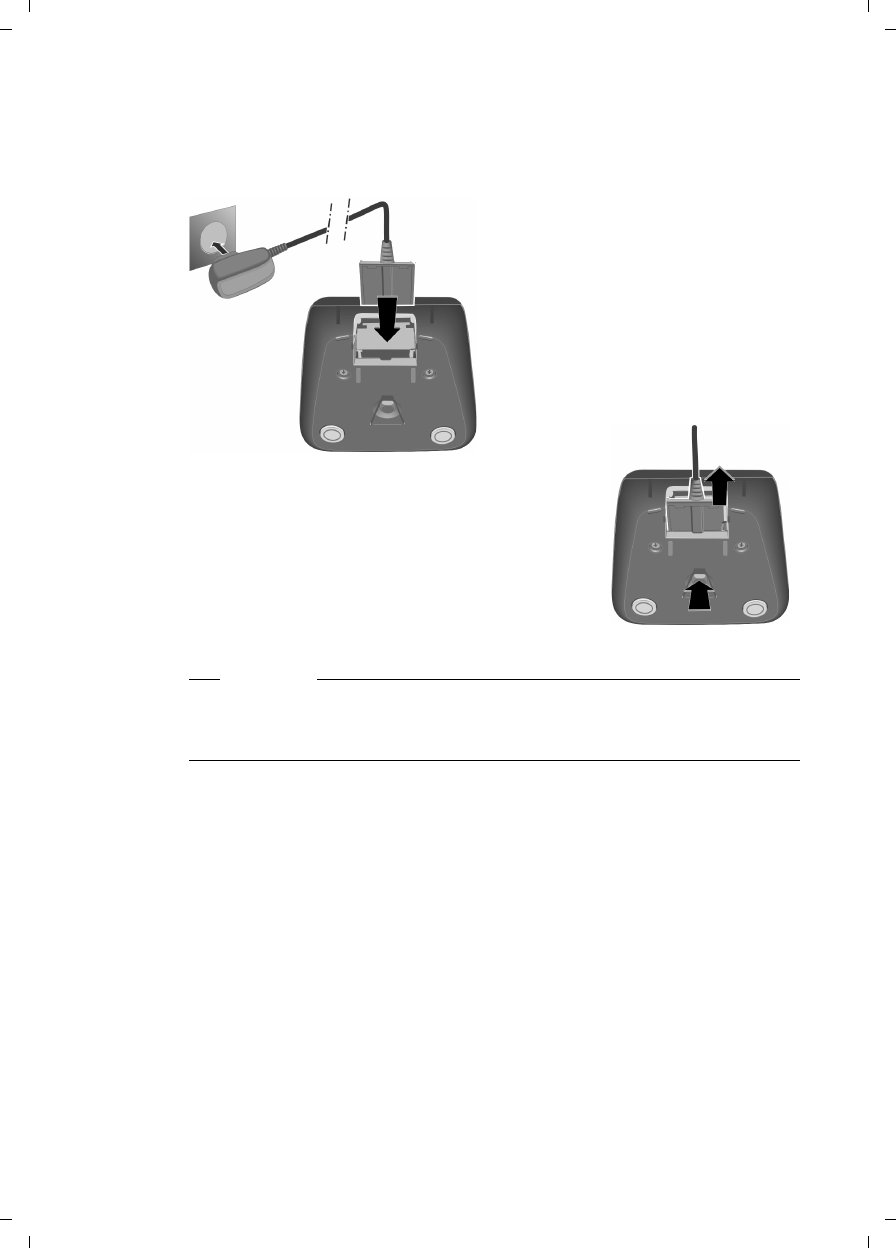
13
First steps
Gigaset A580 IP / US English / A31008-xxxx-xxxx-x-xxxx / starting.fm / 24.04.2009
Version 8, 03.09.2008
Connecting the charging cradle
The charging cradle is designed to be operated in enclosed, dry areas at tem-
peratures ranging from +41°F to +113°F.
If you have any questions and problems £Page 141.
For information on attaching the charging cradle to the wall, £Page 195.
¤Plug the electrical adapter into
the plug socket 2.
¤Connect the empty plug from the
power adapter 1.
To disconnect the plug from the charging
cradle, press the release button 1 and dis-
connect the plug 2.
1
2
1
2
Please note
uOnly place the handset in the charging cradle for which it is intended.
uIf the handset has turned itself off because the batteries are empty and is
then placed in the charging cradle, it will turn itself on automatically.

14
First steps
Gigaset A580 IP / US English / A31008-xxxx-xxxx-x-xxxx / starting.fm / 24.04.2009
Version 8, 03.09.2008
Initial charging and discharging of the batteries
¤Then remove the handset from the charging cradle and do not replace it
until the batteries are fully discharged.
The charge status is displayed in the idle display.
= e V U (empty to full) = flashes, the batteries are almost empty.
After the first battery charge and discharge, you may place your handset in the
charging cradle after every call.
Setting the date and time
The date and time must be set to have the correct time for incoming calls and
to use the alarm clock.
Setting up manually:
¤Place the handset in the charging cradle and wait until the
batteries are fully charged (approx. 10 hours).
Battery charging is indicated in the top right of the display
by the flashing battery icon e. 10 h
Warning
uAlways repeat the charging and discharging procedure if you remove the
batteries from the handset and reinsert them.
uThe batteries may warm up during charging.
This is not dangerous.
uAfter a while, the charge capacity of the batteries will decrease for technical
reasons.
Please note
The address of a time server on the Internet is stored on your telephone. The
date and time are taken from this time server, provided that the base station
is connected to the Internet and synchronization with the time server is acti-
vated (£Page 139). Manual settings are overwritten in this case.
¤Press the key below §Menu§ on the
display screen to open the main
menu.
ÞMenu
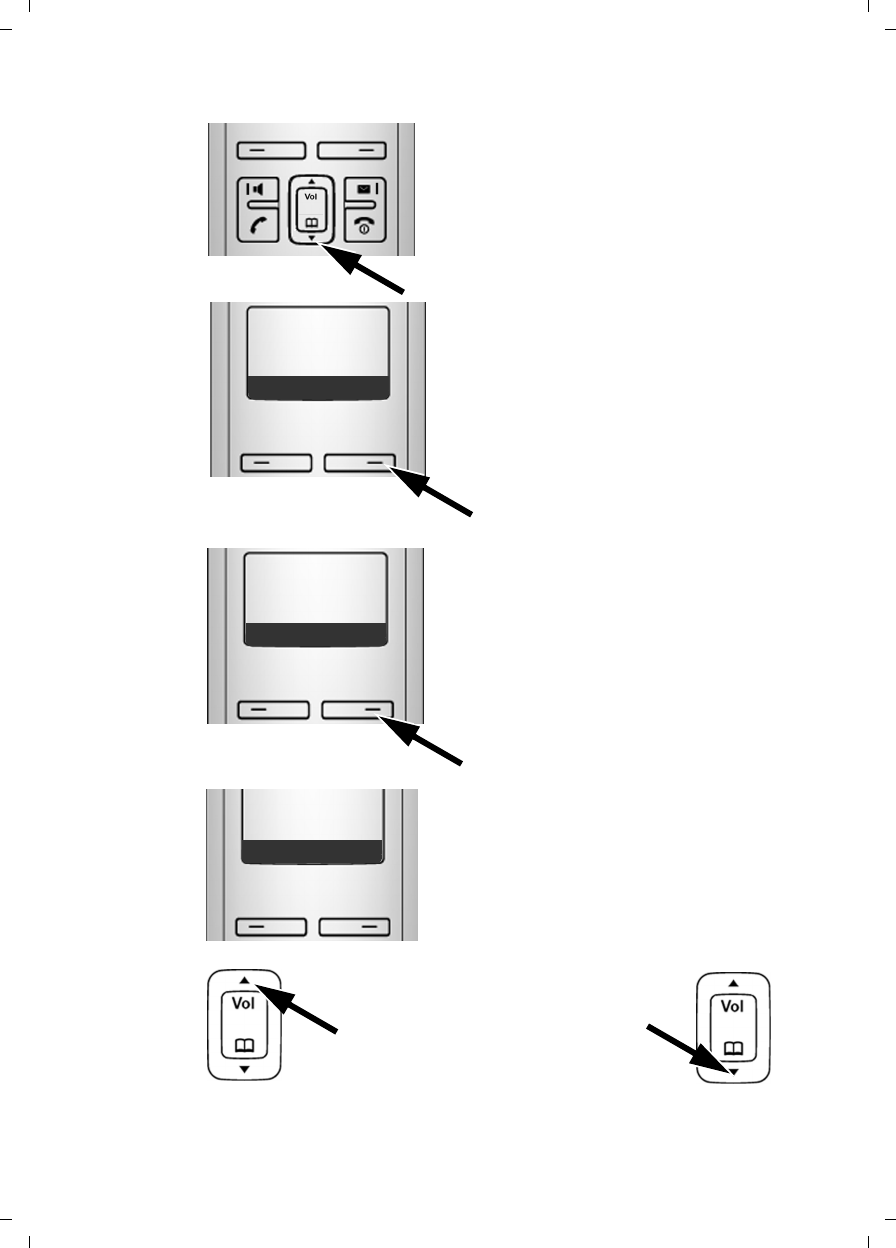
15
First steps
Gigaset A580 IP / US English / A31008-xxxx-xxxx-x-xxxx / starting.fm / 24.04.2009
Version 8, 03.09.2008
¤Press the Control key down
repeatedly ...
… until the Settings menu item
appears.
¤Press the key below §OK§ on the
display screen to confirm your
selection.
m
Settings
ÇUOK
The Date/Time menu item appears
on the display.
¤Press the key below §OK§ on the
display screen to open the input
field.
Date/Time
ÇUOK
¤The active line is marked [...].
Enter month, day and year as an 8-digit
number (MMDDYYYY) via the keypad,
e.g. QQ2QQN
for 10/10/2008.
To correct an entry, press up or down
on the Control key to toggle between
fields.
Enter Date:
10.10.2008]
ÇUOK
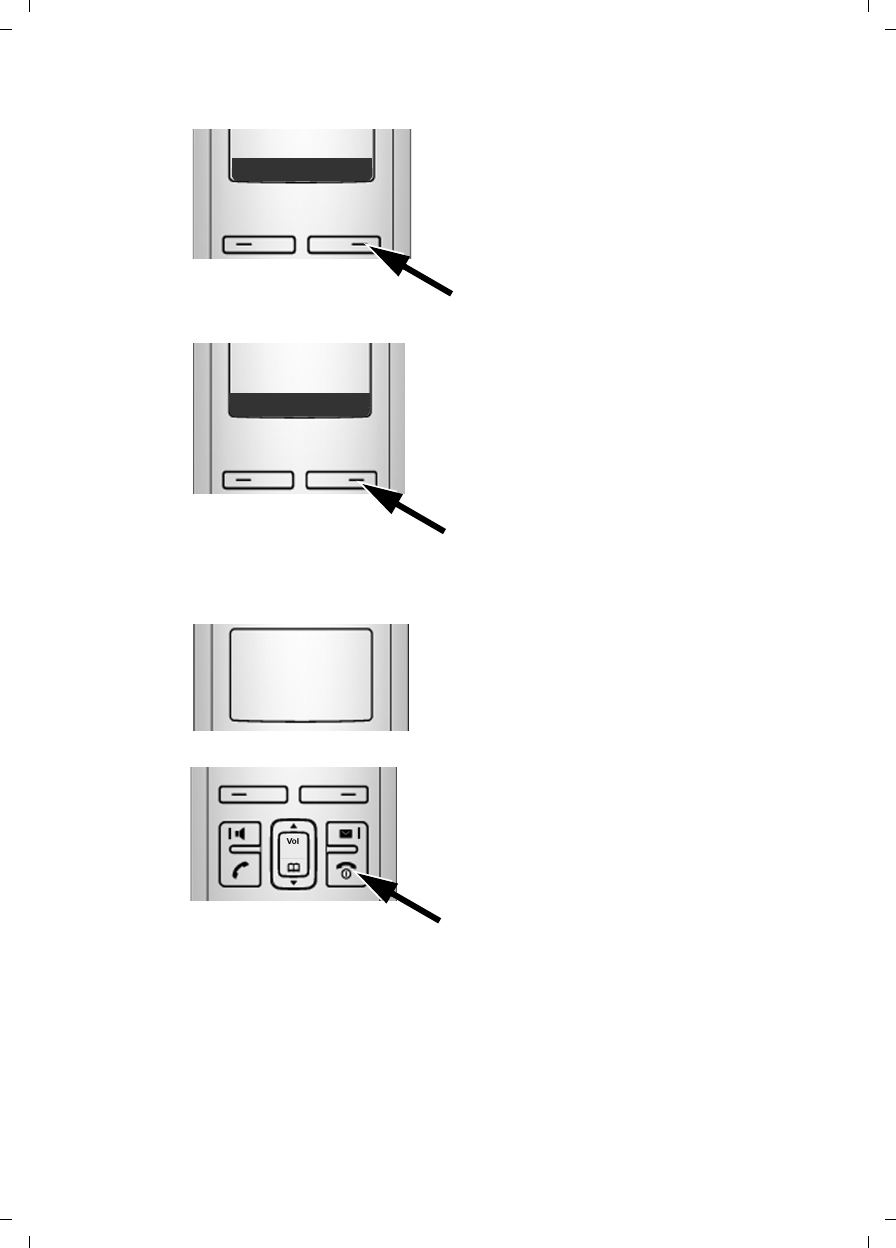
16
First steps
Gigaset A580 IP / US English / A31008-xxxx-xxxx-x-xxxx / starting.fm / 24.04.2009
Version 8, 03.09.2008
Registering the handset to the base station
Your handset is registered to the base station by default.
For information on registering additional handsets with the base station and
make free internal calls, £Page 71.
¤Press the key below §OK§ on the display
screen to confirm your selection.
ÇUOK
¤Enter the hours and minutes as 4-digit
numbers via the keypad,
e.g. QM5for 07:15 am.
If necessary, use the Control key to
toggle between fields.
¤Press the key below §am/pm§ on the
display screen to choose between am
and pm.
¤Press the key below §OK§ on the display
screen to confirm your selection.
Enter time:
[07:15] pm
am/pm UOK
¤Press and hold the End Call key a to
return to the idle status.
The display shows Saved.
You will hear a confirmation tone.
Saved

17
First steps
Gigaset A580 IP / US English / A31008-xxxx-xxxx-x-xxxx / starting.fm / 24.04.2009
Version 8, 03.09.2008
Installing the base station
The base station is designed for use in closed, dry rooms with a temperature
range of +41°F to +113°F.
¤Set up the base station at a central location on a flat, non-slip surface in your
house or apartment.
The phone's feet do not usually leave any marks on surfaces. However, due to
the multitude of different varnishes and polishes used on today's furnishings,
the occurrence of marks on the surfaces cannot be completely ruled out.
For information on mounting the base station on the wall, £Page 195.
Please note
Consider the range of the base station.
This is up to 328 yards in unobstructed outdoor areas and up to 54 yards inside
buildings. The range is reduced when eco mode is activated (£Page 69).
Warning
uNever expose the telephone to any of the following: heat sources, direct
sunlight or other electrical appliances.
uProtect your Gigaset from moisture, dust, corrosive liquids and fumes.
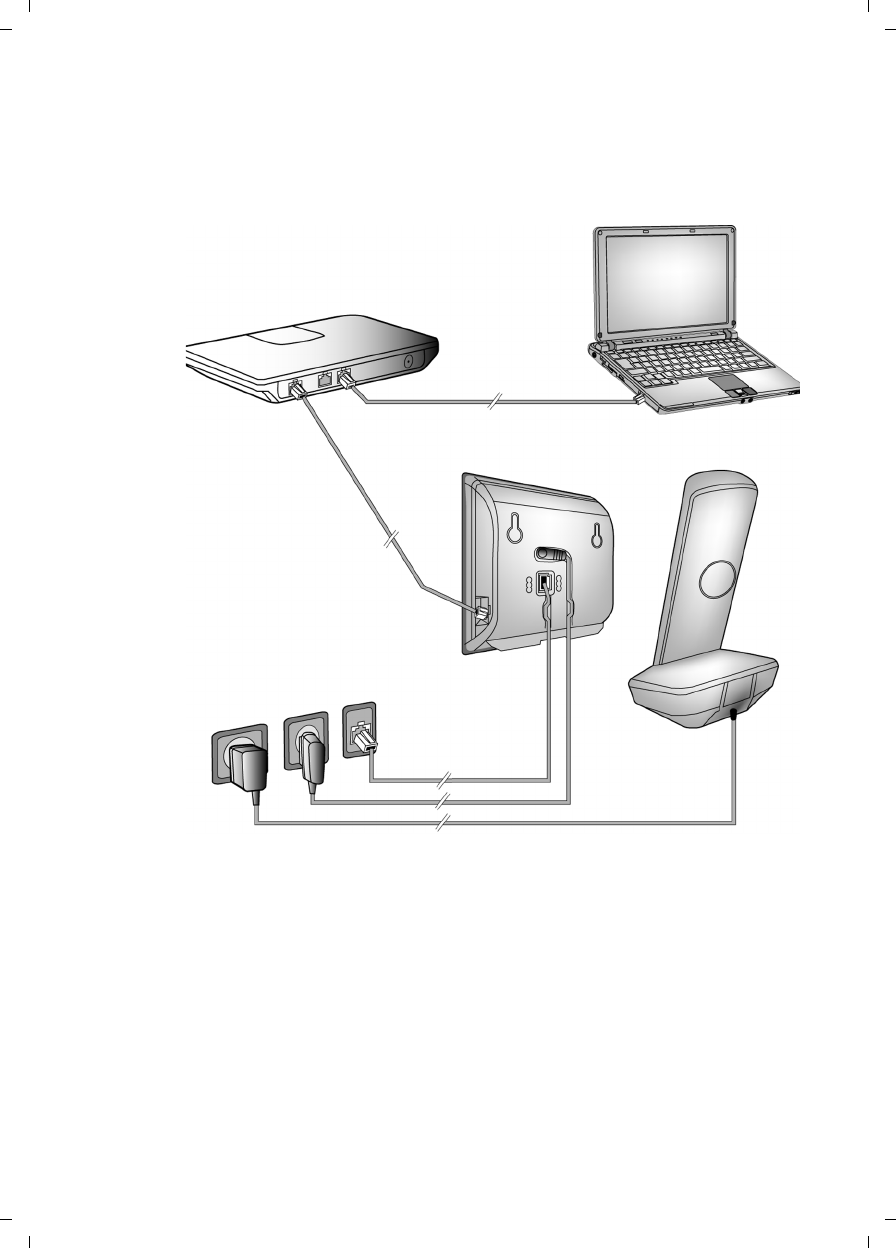
18
First steps
Gigaset A580 IP / US English / A31008-xxxx-xxxx-x-xxxx / starting.fm / 24.04.2009
Version 8, 03.09.2008
Connecting the base station
To make calls with your phone via the fixed line network and via VoIP, you
must connect the base station to the fixed line network and the Internet,
£Figure 1.
Follow the steps in the order given below (£Figure 1):
§§1§§ Connect the phone cord and power lead to the base station.
§§2§§ Connect the base station to the fixed line network and the electrical power
supply.
§§3§§ To connect the base station to the Internet, first connect the base station to
the router
(connection via router and modem or via router with integrated modem).
§§4§§ Connect the PC and router (optional) – for advanced configuration of the
base station (£Page 96).
Figure 1 Connecting the phone to the fixed line network and the Internet
§§4§§
§§1§§
§§2§§
§§3§§
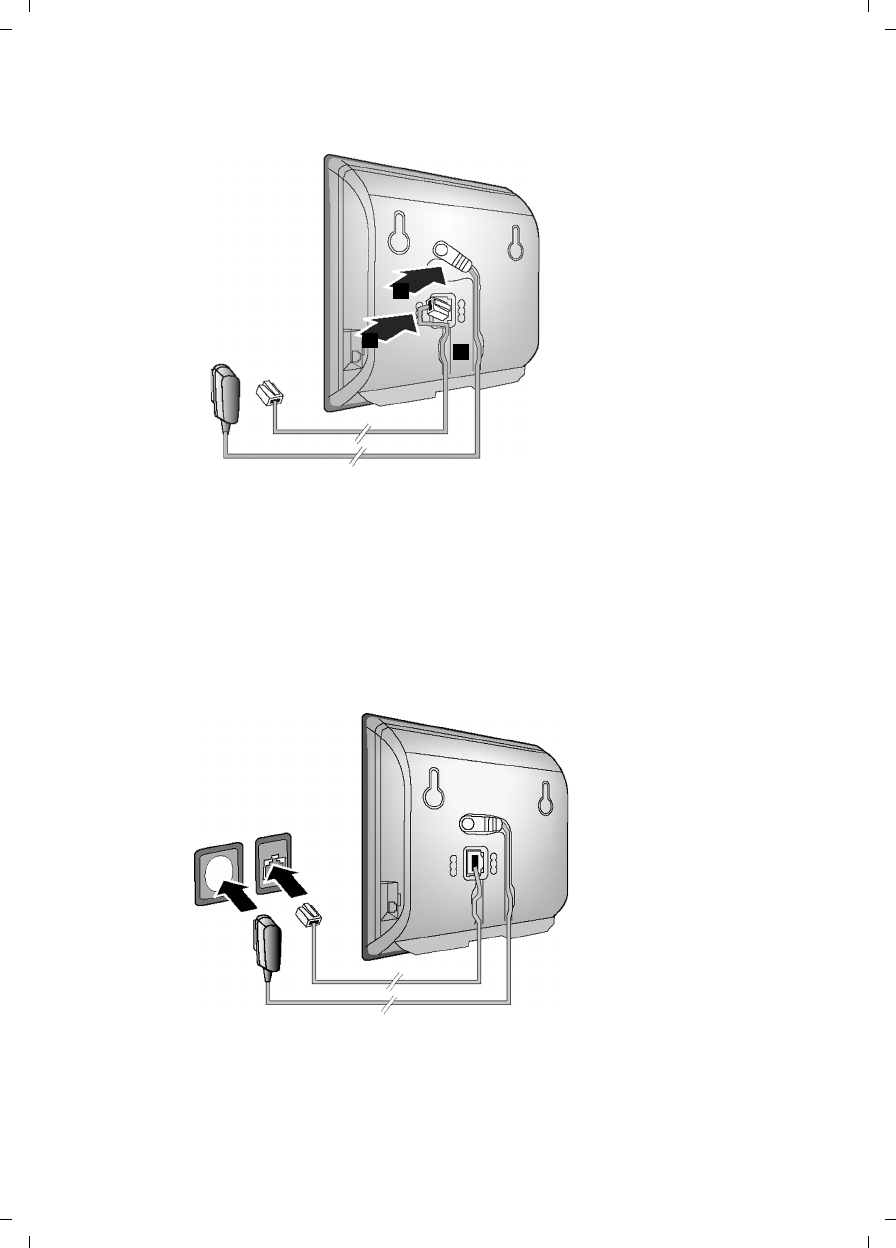
19
First steps
Gigaset A580 IP / US English / A31008-xxxx-xxxx-x-xxxx / starting.fm / 24.04.2009
Version 8, 03.09.2008
1. Connect the phone cord and power lead to the base station
§§1§§ Insert the phone cord into the lower connection socket at the rear of the
base station.
§§2§§ Insert the power lead of the power adapter into the upper connection socket
at the rear of the base station.
§§3§§ Push both cables into the appropriate cable channels.
2. Connect the base station to the fixed line network and the
electrical power supply
§§1§§ Insert the phone cord into the fixed line network connection socket.
§§2§§ Then insert the power adapter into the electrical socket.
2
13
§§2§§ §§1§§
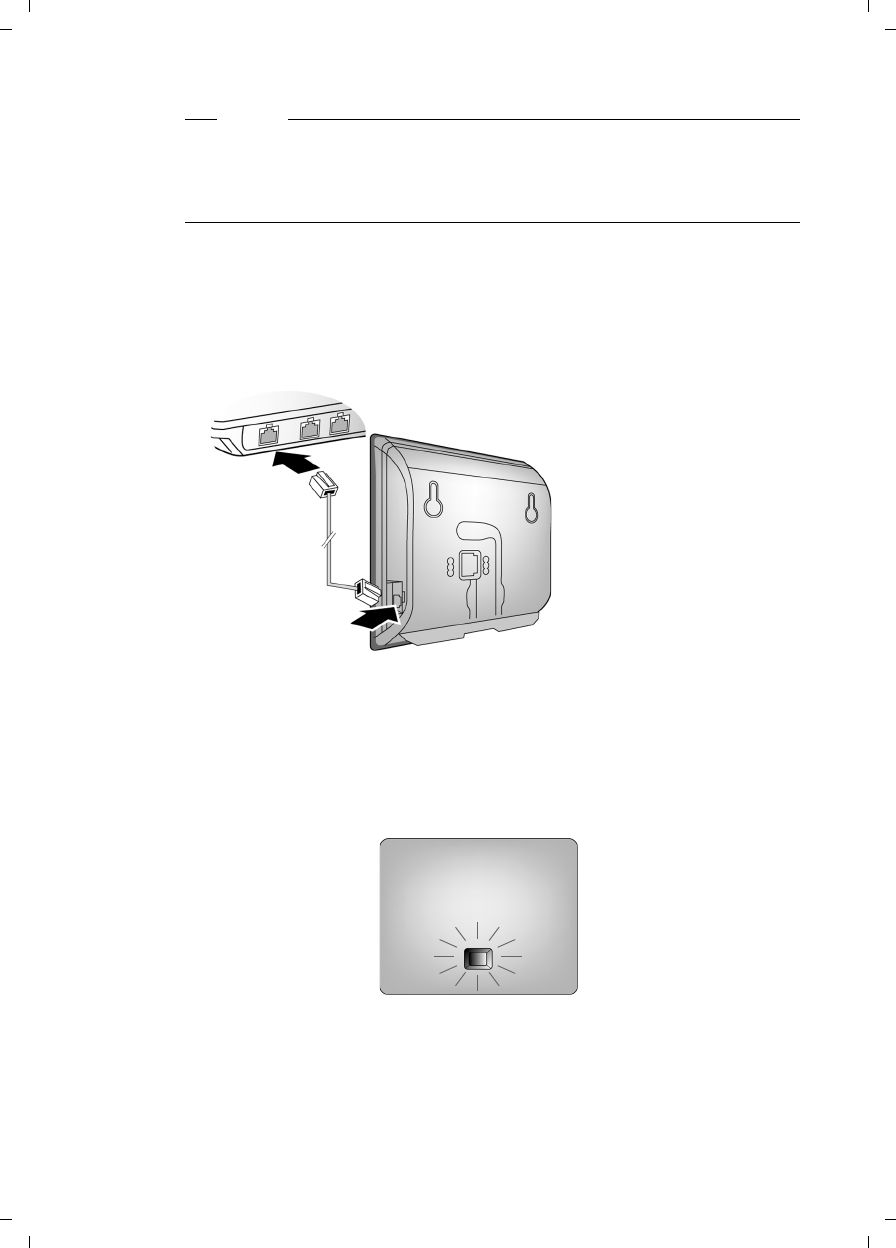
20
First steps
Gigaset A580 IP / US English / A31008-xxxx-xxxx-x-xxxx / starting.fm / 24.04.2009
Version 8, 03.09.2008
You can now use your phone to make calls via the fixed line network and can be
reached on your fixed line number.
3. Connect the base station with the router (Internet)
For Internet access you need a router connected to the Internet via a modem
(this may be integrated in the router).
§§1§§ Connect an Ethernet cable plug into the LAN port at the side of the base sta-
tion.
§§2§§ Then insert the other end of the Ethernet cable plug into a LAN port on the
router.
As soon as the cable connecting the phone and router is plugged in and the
router is activated, the key lights up on the front of the base station
(Paging key).
You are now ready to establish VoIP connections within Gigaset.net
(£Page 46).
Warning
uKeep the power adapter plugged in at all times for operation, as the phone
does not work without an electrical power connection.
uUse only the power adapter and phone cord supplied. Pin connections on
telephone cords can vary (pin connections £Page 152).
§§2§§
§§1§§
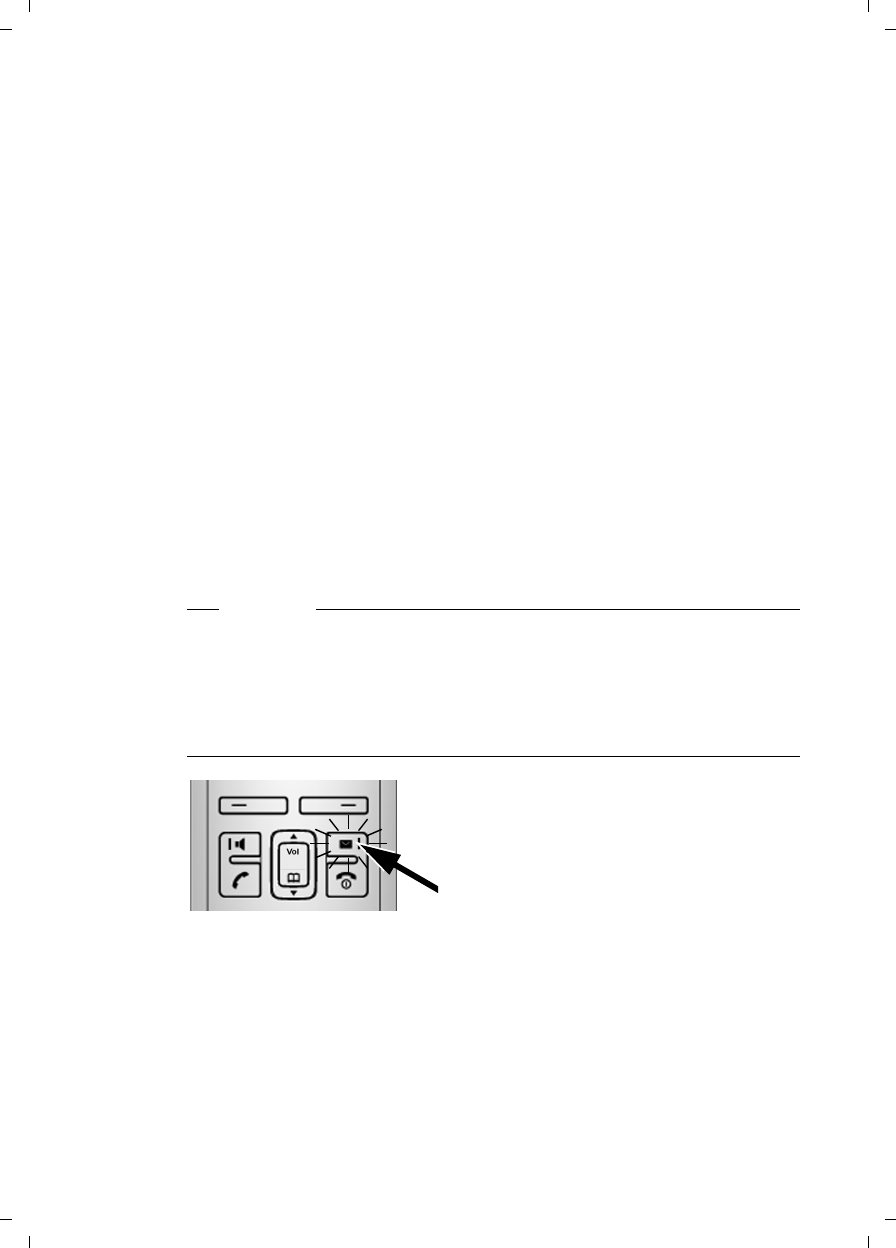
21
First steps
Gigaset A580 IP / US English / A31008-xxxx-xxxx-x-xxxx / starting.fm / 24.04.2009
Version 8, 03.09.2008
Making settings for VoIP telephony
Before you can use the Internet (VoIP) to phone any other numbers on the
Internet, the fixed line network or the cellular phone network, you need the
services of a VoIP provider who supports the VoIP SIP standard.
Prerequisite: You have registered with such a VoIP provider (e.g. via your PC)
and set up at least one VoIP account.
To use VoIP, you need to enter the access data for your VoIP account. You will
receive all the necessary data from your VoIP provider. This will include:
uYour user name (if requested by the VoIP provider) is the user identification
(Caller ID) for your account, which is often identical to your phone number
uYour authentication name or login ID
uThe (login) password registered with the VoIP provider
uGeneral settings for your VoIP provider (server addresses, etc.)
Your phone connection wizard can help you make these entries.
Starting the connection wizard
Prerequisite:
The base station is connected to the electrical power supply and a router. Your
router is connected to the Internet (£Page 20).
Please note
Your phone is preconfigured for dynamic assignment of the IP address. In
order for your router to "recognize" the phone, dynamic IP address assignment
must also be activated on the router, i.e. the router's DHCP server must be acti-
vated.
If the DHCP server cannot or should not be activated, you must first assign a
fixed IP address to the phone. For further information, see Page 91.
As soon as the handset battery is sufficiently
charged, the Message keyf on the handset
will flash (approx. 20 minutes after you have
put the handset in the charging cradle).
¤Press the Message key f.
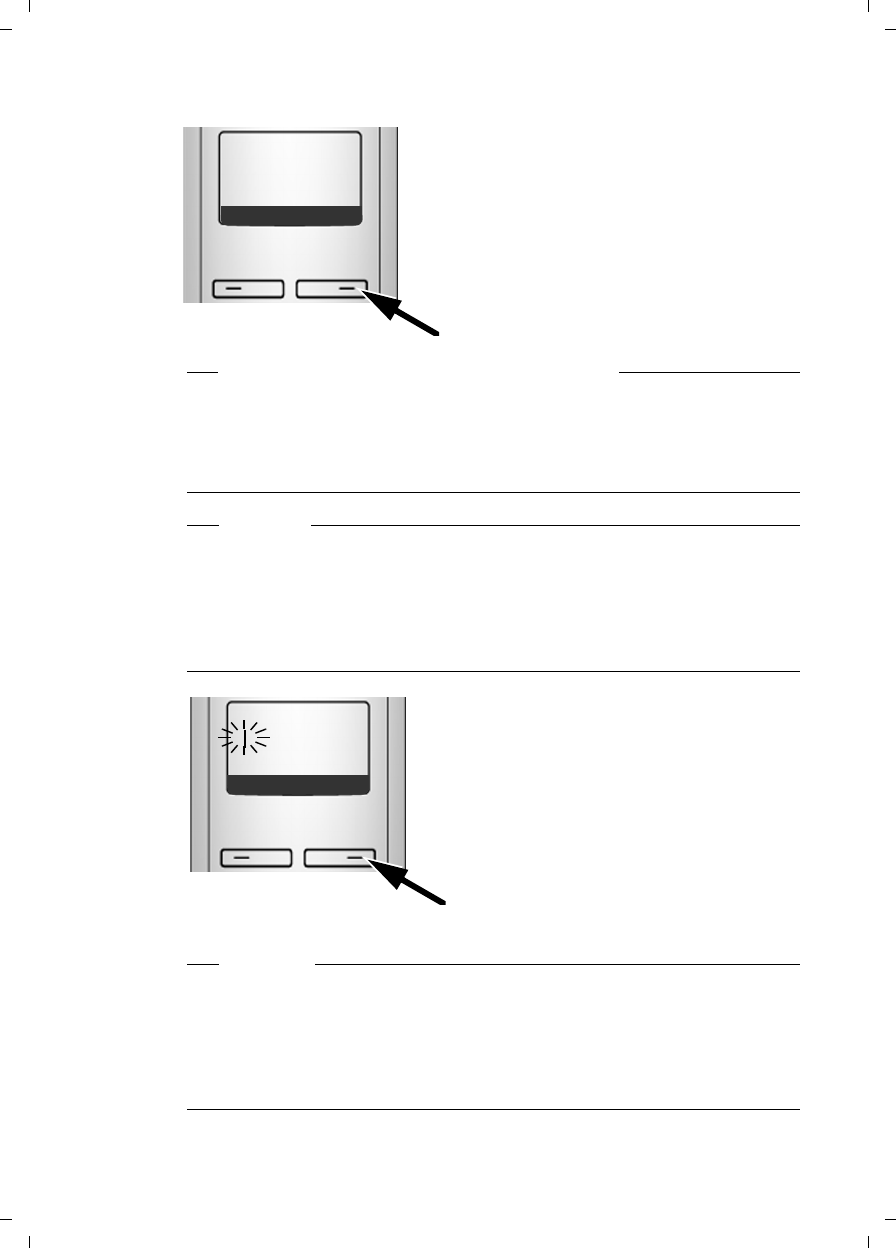
22
First steps
Gigaset A580 IP / US English / A31008-xxxx-xxxx-x-xxxx / starting.fm / 24.04.2009
Version 8, 03.09.2008
You will see the following display.
¤Press the key below §Yes§ on the display
screen.
You will be prompted to enter your phone's
system PIN.
Start VoIP
connection
wizard?
No Yes
New firmware available appears in the display.
New/improved firmware is available for your phone on the Internet. First per-
form an automatic update of the firmware (£Page 88). Once the update has
been completed (after approx. 3 minutes) the handset's idle display appears
again and the Message key f flashes. If you press f, the display shown in
the picture above appears and you can start the connection wizard.
Please note
To protect your phone and its system settings from unauthorized access,
please define a 4-digit number code (system PIN) known only to yourself. This
code must be entered before you can register/de-register handsets or alter
your phone's VoIP or LAN settings.
The default system PIN is 0000 (4 x zero). For further information, see
Page 84.
The active line is marked [----].
¤Enter your phone's current system PIN
using the keypad.
¤Press the key below §OK§ on the display
screen.
The connection wizard is launched.
System PIN:
[ _ _ _ _ ]
ÇOK
Please note
uYou can also call up the connection wizard at any time via the menu
(£Page 89).
uThe connection wizard will also start automatically if you try to establish a
connection via the Internet before you have made the necessary settings.
Prerequisite: You have not activated the fixed line network connection as
a replacement connection (£Page 119):
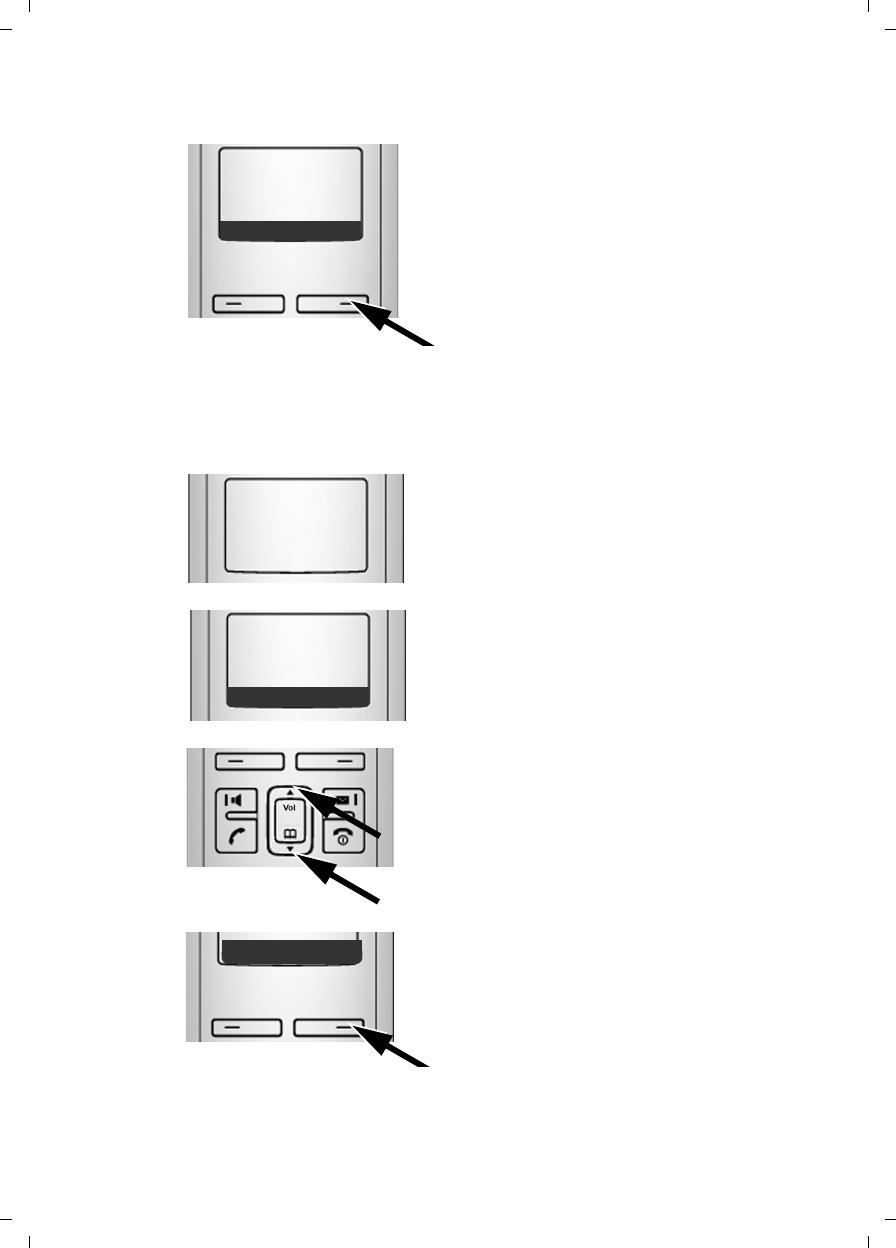
23
First steps
Gigaset A580 IP / US English / A31008-xxxx-xxxx-x-xxxx / starting.fm / 24.04.2009
Version 8, 03.09.2008
Downloading VoIP provider data
The connection wizard establishes a connection with the Gigaset configuration
server on the Internet. Various profiles with general access data for different
VoIP providers can be downloaded here.
After a brief period you will see the following display:
¤Press the key below §Yes§ on the display
screen.
Select VoIP
provider?
No Yes
A list of countries is loaded.
The first country in the list appears in the
display.
¤Press up or down on the Control key
repeatedly ...
... until the country in which you are
using the phone appears on the display.
¤Press the key below §OK§ on the display
screen to confirm your selection.
Select
country
Germany
ÇVOK
ÇUOK
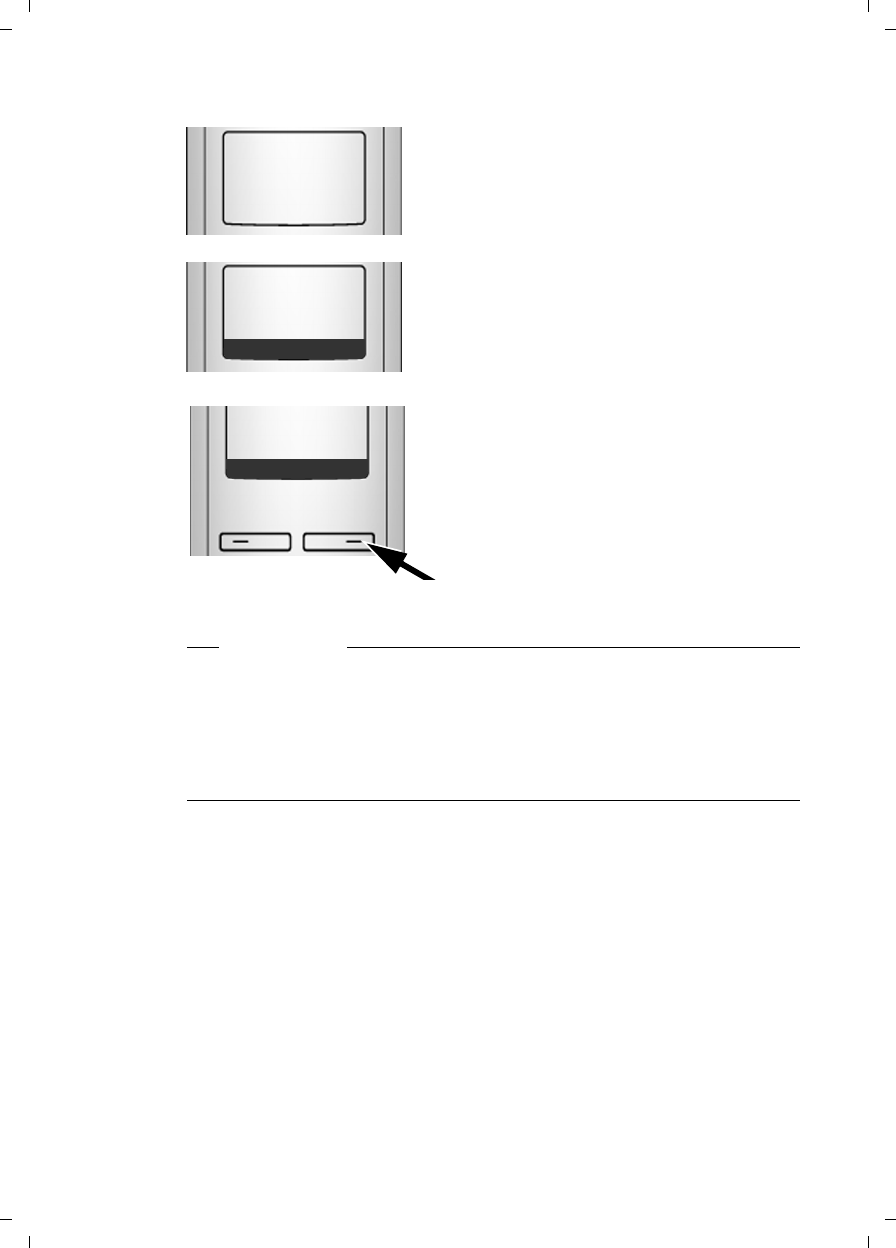
24
First steps
Gigaset A580 IP / US English / A31008-xxxx-xxxx-x-xxxx / starting.fm / 24.04.2009
Version 8, 03.09.2008
The general access data for your VoIP provider is downloaded.
Entering user data for your first VoIP account
You will now be prompted to enter your personal access data for your VoIP
accounts.
The following are provider-dependent:
u Username, Authentication Name, Authentication Password
Or:
uAuthentication Name, Authentication Password
A list of VoIP providers whose data you can
download is loaded.
The first VoIP provider in the list appears in
the display.
¤Press up or down on the Control key
repeatedly q ...
... until your VoIP provider appears on
the display.
¤Press the key below §OK§ on the display
screen to confirm your selection.
Select
provider
Provider 1
ÇVOK
Provider x
ÇUOK
Please note
If the data for your VoIP provider is not available for downloading, press the ”
display key twice. You can then carry out the following steps with the connec-
tion wizard.
You must then make the settings needed for the VoIP provider using the Web
configurator (£Page 107).
Your VoIP provider will supply you with this data.
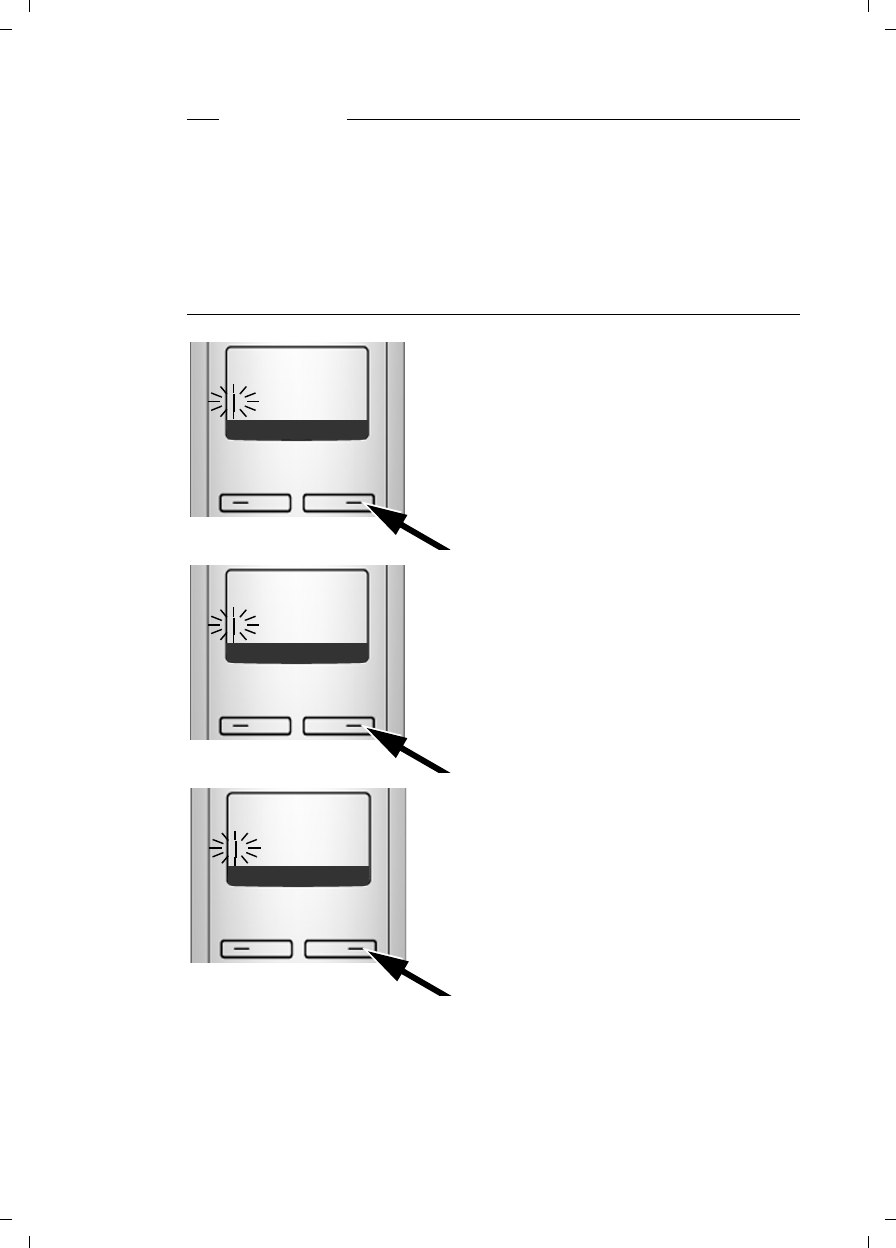
25
First steps
Gigaset A580 IP / US English / A31008-xxxx-xxxx-x-xxxx / starting.fm / 24.04.2009
Version 8, 03.09.2008
Please note
When entering case sensitive access data:
uTo switch between upper and lower case and digits, press the # key
(several times if necessary). You can see briefly in the display whether
upper case, lower case or digits is selected.
uCharacters entered incorrectly can be deleted using the left Display key
below X. The character to the left of the cursor will be deleted.
uYou can navigate within the input field using the Control key p (press up/
down).
If your VoIP provider does not require a
user name, skip this step.
¤Using the keypad, enter the user name
that you received from your VoIP pro-
vider.
¤Press the key below §OK§ on the display
screen.
¤Using the keypad, enter the authentica-
tion name that you received from your
VoIP provider.
¤Press the key below §OK§ on the display
screen.
¤Use the keypad to enter your password.
¤Press the key below §OK§ on the display
screen.
Username:
ÛTOK
Authentication
Name:
ÛTOK
Authentication
Password:
ÛTOK

26
First steps
Gigaset A580 IP / US English / A31008-xxxx-xxxx-x-xxxx / starting.fm / 24.04.2009
Version 8, 03.09.2008
Completing the VoIP settings
After the entries have been completed, the handset reverts to idle status.
¤Test whether your VoIP data is complete and has been stored in the phone
correctly.
Calling via VoIP:
Enter a number using the handset keypad and press and hold the Talk
key c.
If a VoIP connection cannot be established, a corresponding message is shown
in the display.
You can now use your phone to make calls via the fixed line network and the
Internet! Callers can reach you on your fixed line number and your VoIP number.
Please note
uTo ensure that you can always be reached via the Internet, the router must
be permanently connected to the Internet.
uIf you have started the connection wizard via the menu, once the entries
are completed, press and hold the End Call key a to return the handset to
idle status.
uIf you try to make a call via a VoIP connection that is not configured cor-
rectly, the following VoIP status message will appear in the display:
VoIP config. error: xxx (xxx = VoIP status code). The various status codes and
their respective meanings are listed on Page 145.
Please note
You can enter five additional VoIP accounts (VoIP phone numbers) via the Web
configurator later (£Page 106). Together with your fixed line network
number and the Gigaset.net number, your phone can then be reached via up
to eight different phone numbers. You can assign the phone numbers to the
individual handsets that are registered with the base station as send and
receive numbers (£Page 120).
ÐV
INT 1
ÞMenu

27
First steps
Gigaset A580 IP / US English / A31008-xxxx-xxxx-x-xxxx / starting.fm / 24.04.2009
Version 8, 03.09.2008
Icons on the idle display
The following is displayed:
uthe internal number, e.g. INT 1.
uthe quality of the reception signal between base station and handset (signal
strength):
–poor to good:ÒÑiÐ
–no reception: | flashes
ubattery charge status:
–= e V U(empty to full)
–=flashes: batteries almost empty
–e V Uflashes: charging procedure
No connection to the Internet/VoIP server
If one of the following messages is displayed instead of the internal name after
the connection wizard is closed, errors have occurred:
uServer not accessible!
uSIP registration failed
Below you will find possible causes and measures you can take.
Server not accessible!
The phone has no connection to the Internet.
¤Check the cable connections between the base station and the router (the
LED on the base station must light up) and the connection between the
router and the Internet connection.
¤Verify that the phone is connected to the LAN.
– It may not have been possible to dynamically assign an IP address to the
phone
or
– You have assigned a static IP address to the phone that has either already
been assigned to another LAN subscriber or does not belong to the
router's address block.
¤Press the Paging key on the base station. The IP address appears on the
handset display.
¤Press the Talk key on the handset to end paging call.
¤Start the Web configurator with the IP address.
¤If no connection can be established, change the settings on the router
(activate DHCP server) or the phone's IP address.

28
First steps
Gigaset A580 IP / US English / A31008-xxxx-xxxx-x-xxxx / starting.fm / 24.04.2009
Version 8, 03.09.2008
SIP registration failed
uYour personal data for registering with the VoIP provider may have been
entered incompletely or incorrectly.
¤Check your entries for Username, Authentication Name and Authentication
Password. Particularly check your use of upper and lower case.
To do this, open the following menu on your handset:
§Menu§ ¢Settings ¢Base ¢Telephony ¢VoIP (enter system PIN)
(£Page 90)
uThe server address for the VoIP server has not yet been entered, or has been
entered incorrectly.
¤Start the Web configurator.
¤Open the following Web page: Settings ¢Telephony ¢Connections.
¤Click the Edit button next to the first VoIP connection.
¤Edit the server address where necessary.
Please note
If port forwarding is activated on your router for the ports (£Page 128) that
have been registered as the SIP and RTP ports, we recommend to deactivate
DHCP and assign the phone a static IP address (otherwise you may not be able
to hear the other party during VoIP calls):
uAssign an IP address via the handset menu:
§Menu§ £Settings £Base £Local Network
Or
uAssign an IP address via the Web configurator:
¤Open the following Web page: Settings £IP Configuration.
¤Select IP address type.
Please note that the IP address and subnet mask depend on the router's
address block.
You must also enter the default gateway and DNS server. The IP address for the
router is generally entered here.

29
First steps
Gigaset A580 IP / US English / A31008-xxxx-xxxx-x-xxxx / starting.fm / 24.04.2009
Version 8, 03.09.2008
What would you like to do next?
Now you have successfully started your phone, you will probably want to adapt
it to your personal requirements. Use the following guide to quickly locate the
most important subjects.
If you are unfamiliar with menu-driven devices such as other Gigaset tele-
phones first read the section "Operating the handset" £Page 30.
If you have any questions about using your phone, please read the
troubleshooting tips in the section "Questions and answers" (£Page 141), or
contact our Customer Care team (£Page 141).
Information on ... ... is located here.
Making calls via VoIP or the fixed line network Page 38
Setting the ringer melody and volume Page 81
Setting the handset volume Page 80
Entering local area code/extra codes Page 87
Eco mode Page 69
Operating the telephone on a PABX Page 94
Registering existing handsets to a base station Page 71
Transferring directory entries from existing Gigaset
handsets to the new handset(s)
Page 65
Entering additional VoIP accounts Page 106
g
g
g
g
g
g
g
g
g
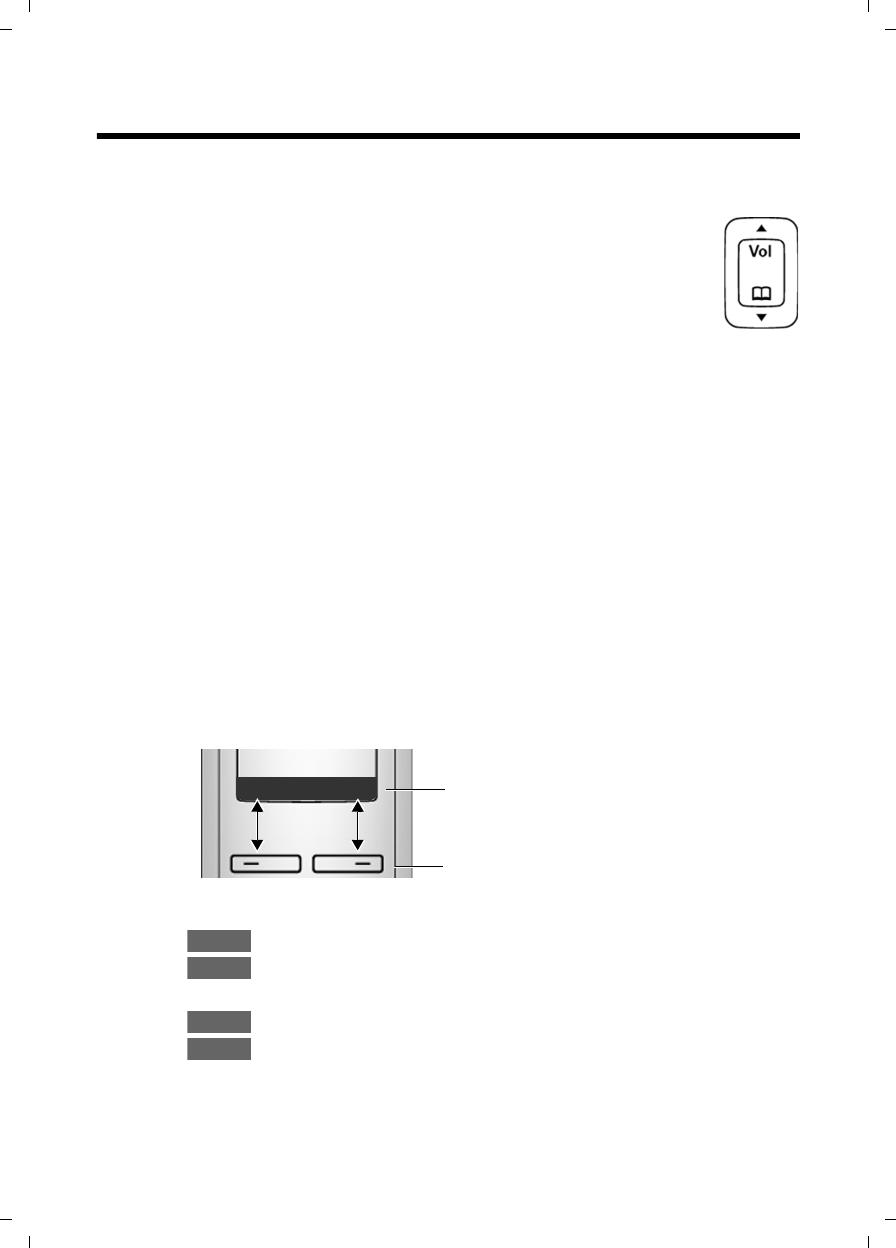
30
Operating the handset
Gigaset A580 IP / US English / A31008-xxxx-xxxx-x-xxxx / starting.fm / 24.04.2009
Version 8, 03.09.2008
Operating the handset
Using the Control key
In the following description, the side of the Control key you need to
press for each operation is indicated accordingly, e.g. tfor "press
up on the Control key".
The Control key has a number of different functions:
With the handset in idle status (without a screensaver)
s Press briefly to open the handset directory.
Press and hold: open Gigaset.net directory.
tCall up the menu to set the ringer volume (£Page 81).
In the main menu, in submenus and lists
t/ s Scroll up/down line by line.
In input fields
Use the Control key to move the cursor to the left t or right s.
During an external call
s Press briefly to open the handset directory.
tAdjust the loudspeaker volume for earpiece and handsfree mode.
Using the Display keys
The function of the display keys changes depending on the particular operating
situation. Example:
Important Display keys:
Open a context-dependent menu.
Confirm selection.
WDelete key: deletes one character at a time from right to left.
Go back one menu level or cancel operation.
Open the Last Number Redial list.
ÇUOK Current Display key functions are shown in
the bottom display line.
Display keys
Menu
OK
Ç
Þ

31
Operating the handset
Gigaset A580 IP / US English / A31008-xxxx-xxxx-x-xxxx / starting.fm / 24.04.2009
Version 8, 03.09.2008
Using the keys on the keypad
c/ Q/ *, etc.
Press the matching key on the handset.
~Enter digits or letters.
Correcting text entry errors
You can correct incorrect characters in the text by navigating to the incorrect
entry using the Control key. You can then:
uPress X to delete the character to the left of the cursor
uInsert characters to the left of the cursor
uOverwrite the (flashing) character when entering the time and date, etc.
Using the menus
Your telephone's functions are accessed using a menu that has a number of lev-
els.
Main menu (first menu level)
¤When the handset is in idle status, press §Menu§to open the main menu.
The main menu functions are shown on the display as a list with name and
icon.
To access a function, i.e. to open the corresponding submenu (next menu
level):
¤Navigate to the function using the Control key q. Press the Display key §OK§.
Submenus
The functions in the submenus are displayed as lists.
To access a function:
¤Scroll to the function with the Control key q and press §OK§.
Or:
¤Enter the corresponding digit combination (£Page 34).
Briefly press the End Call key a once to return to the previous menu level/
cancel the operation.

32
Operating the handset
Gigaset A580 IP / US English / A31008-xxxx-xxxx-x-xxxx / starting.fm / 24.04.2009
Version 8, 03.09.2008
Reverting to idle status
You can revert to idle status from anywhere in the menu as follows:
¤Press and hold the End Call key a.
Or:
¤Do not press any key: after 2 minutes the display will automatically revert
to idle status.
Any settings you have not confirmed by pressing §OK§ will be discarded.
An example of the display in idle status is shown on £Page 26.
Activating/deactivating the handset
aWith the phone in idle status, press and hold the End Call key (con-
firmation tone) to switch off the handset.
Press and hold the End Call key again to switch the handset on.
Activating/deactivating the keypad lock
The keypad lock prevents any inadvertent use of the phone.
#Press and hold the Pound key (#) to activate or deactivate the key-
pad lock. You will hear the confirmation tone.
When the keypad lock is activated you will see the Ø icon on the display and
a message when you press a key.
The keypad lock is deactivated automatically if someone calls you. It is reacti-
vated when the call is finished.
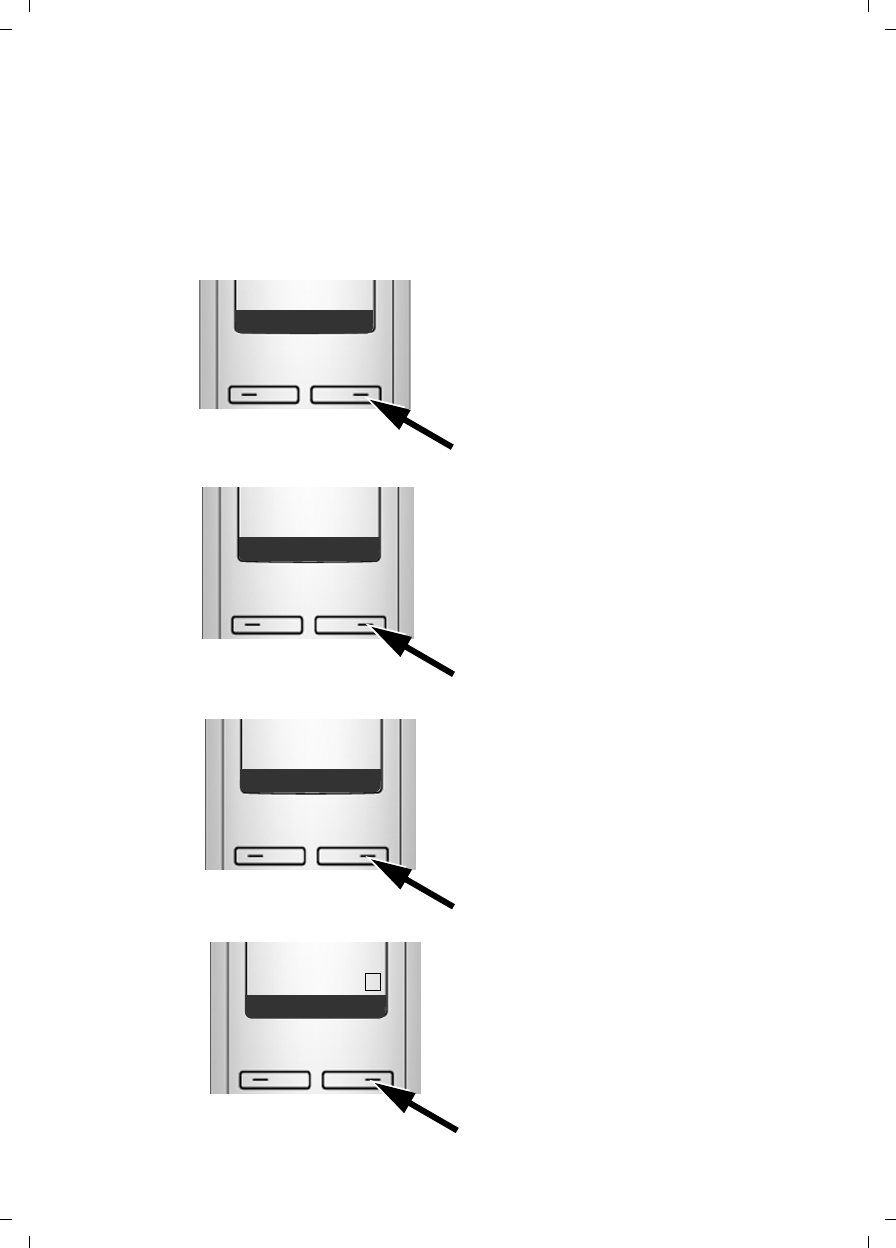
33
Operating the handset
Gigaset A580 IP / US English / A31008-xxxx-xxxx-x-xxxx / starting.fm / 24.04.2009
Version 8, 03.09.2008
Using this guide
The operating steps are shown in abbreviated form.
Example:
§Menu§ ¢Settings ¢Handset ¢Auto Answer (‰=on)
This illustration represents:
¤Press the Display key below §Menu§
to open the main menu.
ÞMenu
Settings
ÇUOK
¤Press down on the Control key s
repeatedly until the Settings
menu item appears on the dis-
play.
¤Press the Display key below §OK§
to confirm your selection.
Handset
ÇUOK
¤Press down on the Control key s
repeatedly until the Handset menu
item appears on the display.
¤Press the Display key below §OK§ to
confirm your selection.
Auto
Answer
ÇUOK
‰
The Auto Answer menu item appears on
the display.
¤Press the key below §OK§ to activate/
deactivate the function. If the
function is activated, this is
indicated by ‰.
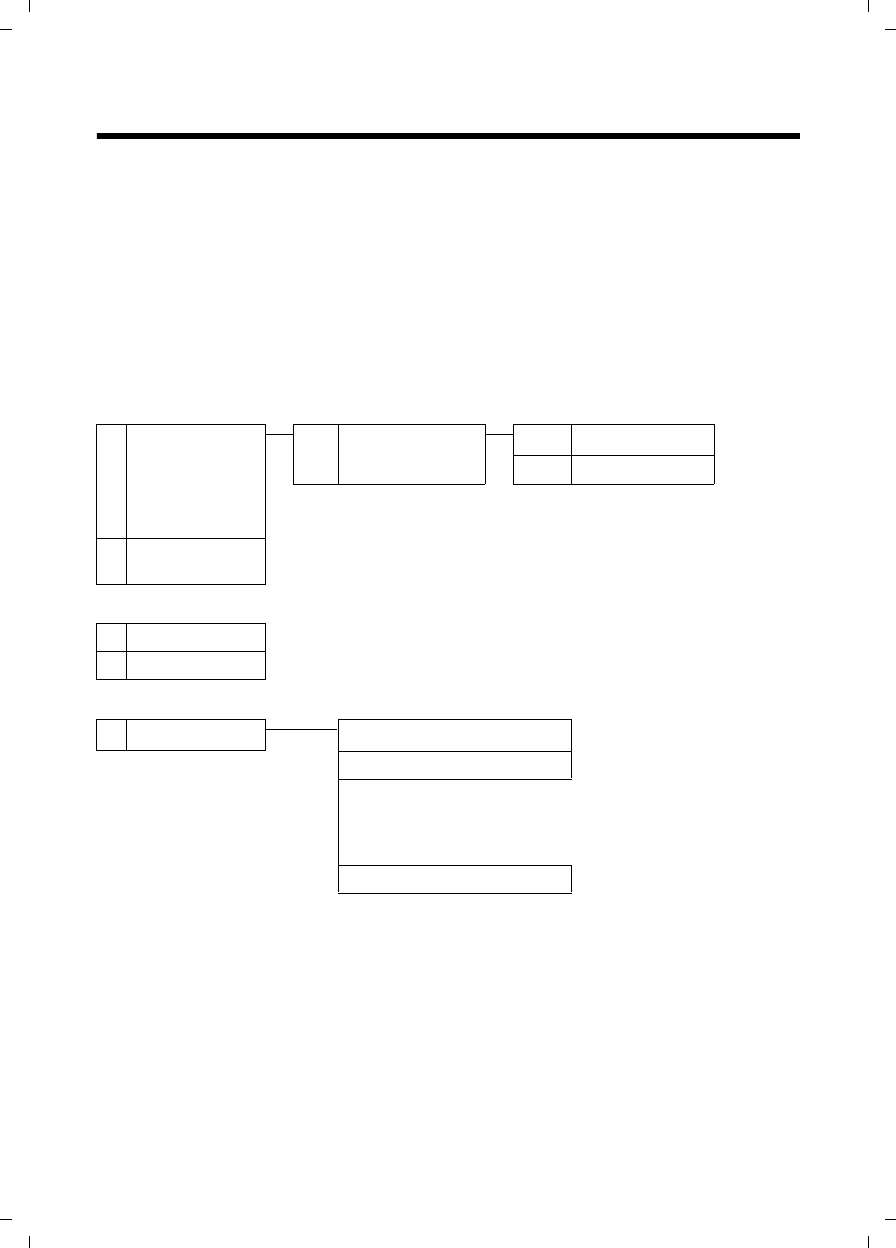
34
Menu trees
Gigaset A580 IP / US English / A31008-xxxx-xxxx-x-xxxx / menuetree.fm / 24.04.2009
Version 8, 03.09.2008
Menu trees
Phone menu
Open the main menu on your phone by clicking on the right Display key §Menu§ when the
handset is in idle status. There are two ways to select a function:
Using number combinations ("shortcut")
¤Enter the number combination that is in front of the function in the menu tree.
Example: §Menu§ M32 for "Set handset language".
Scrolling through the menus
¤Scroll to the function with the Control key q (press up or down) and press §OK§.
3êSelect Services
3-1 VoIP 3-1-6 For All Calls 3-1-6-1 Call Diversion £Page 53
3-1-6-3 Call Waiting £Page 54
3-3 All calls
anonymous £Page 52
3-4 Next call
anonymous £Page 52
4 ì Alarm Clock
4-1 Activation £Page 70
4-2 Wake up time £Page 70
5þ Voice Mail
5-2 Set Key 1 Net AM: Fixed Line £Page 66
Net AM: IP1
:
:
(dependent on the number of configured VoIP phone
numbers and receive numbers on the handset)
Net AM: IP6
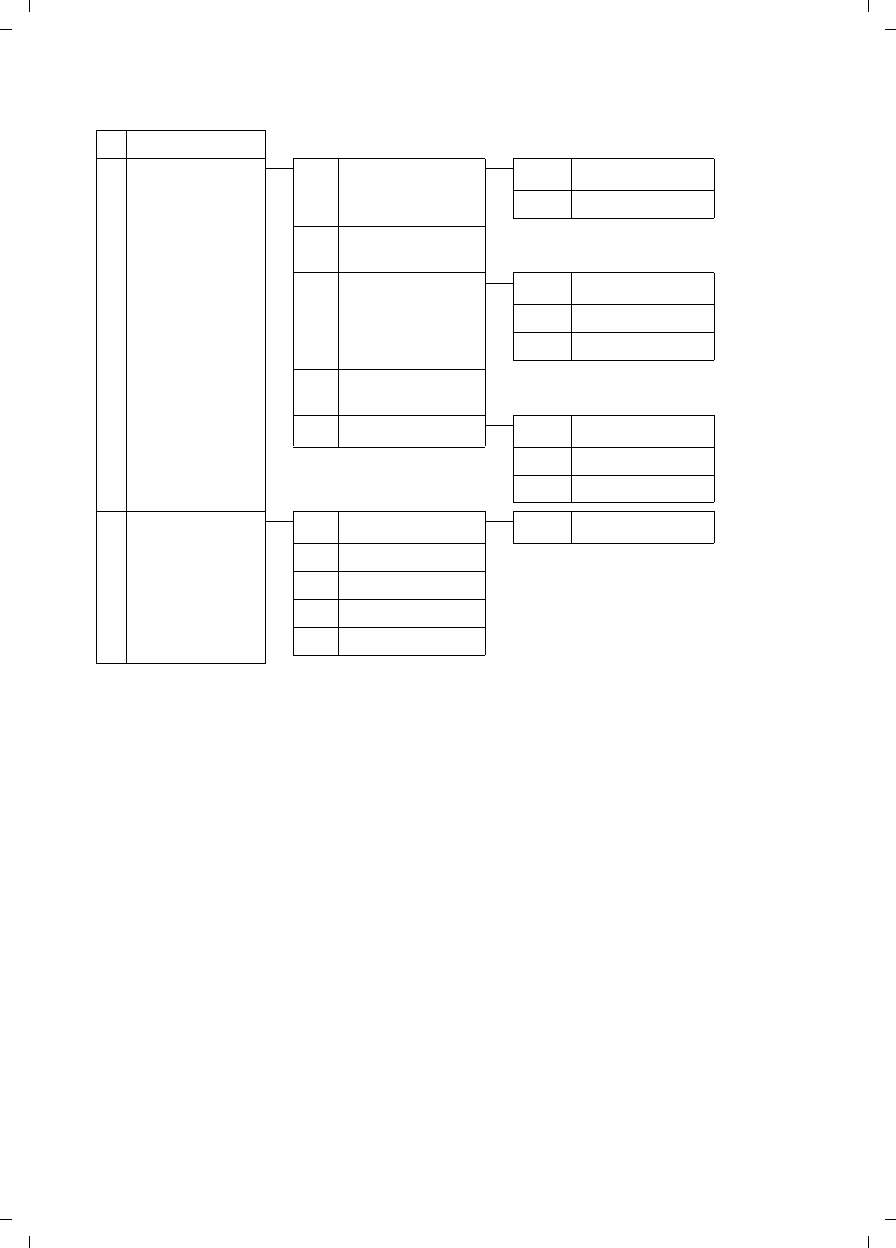
35
Menu trees
Gigaset A580 IP / US English / A31008-xxxx-xxxx-x-xxxx / menuetree.fm / 24.04.2009
Version 8, 03.09.2008
7 m Settings
7-1 Date/Time £Page 14
7-2 Audio Settings 7-2-1 Call Volume 7-2-1-1 Earpiece Volume £Page 80
7-2-1-2 Handsfree Volume
7-2-2 Ringer Volume £Page 8
1
7-2-3 Ringer Melody 7-2-3-1 External Calls £Page 81
7-2-3-2 Internal Calls
7-2-3-3 Alarm Clock
7-2-4 Advisory Tones £Page 8
2
7-2-5 Battery Low 7-2-5-1 Off £Page 83
7-2-5-2 On
7-2-5-3 During Call
7-3 Handset 7-3-1 Display 7-3-1-1 Screensaver £Page 78
7-3-2 Language £Page 77
7-3-3 Auto Answer £Page 80
7-3-4 Register Handset £Page 71
7-3-5 Reset Handset £Page 83

36
Menu trees
Gigaset A580 IP / US English / A31008-xxxx-xxxx-x-xxxx / menuetree.fm / 24.04.2009
Version 8, 03.09.2008
7-4 Base 7-4-1 Calls List Type 7-4-1-1 Missed Calls £Page 59
7-4-1-2 All Calls
7-4-2 Music on hold £Page 86
7-4-3 System PIN £Page 84
7-4-4 Base Reset £Page 85
7-4-5 Additional Features 7-4-5-2 Access Code £Page 94
7-4-5-4 Eco mode £Page 69
7-4-6 Local Network 7-4-6-1 Dynamic
IP address £Page 91
7-4-6-2 IP Address
7-4-6-3 Subnet Mask
7-4-6-4 DNS Server
7-4-6-5 Default Gateway
7-4-7 Telephony 7-4-7-1 Default Line Type £Page 86
7-4-7-2 Connection Wizard £Page 89
7-4-7-4 Area Code £Page 87
7-4-7-5 Extra Codes £Page 87
7-4-7-6 Fixed line £Page 94
7-4-7-7 VoIP £Page 89
7-4-8 Firmware Update £Page 87
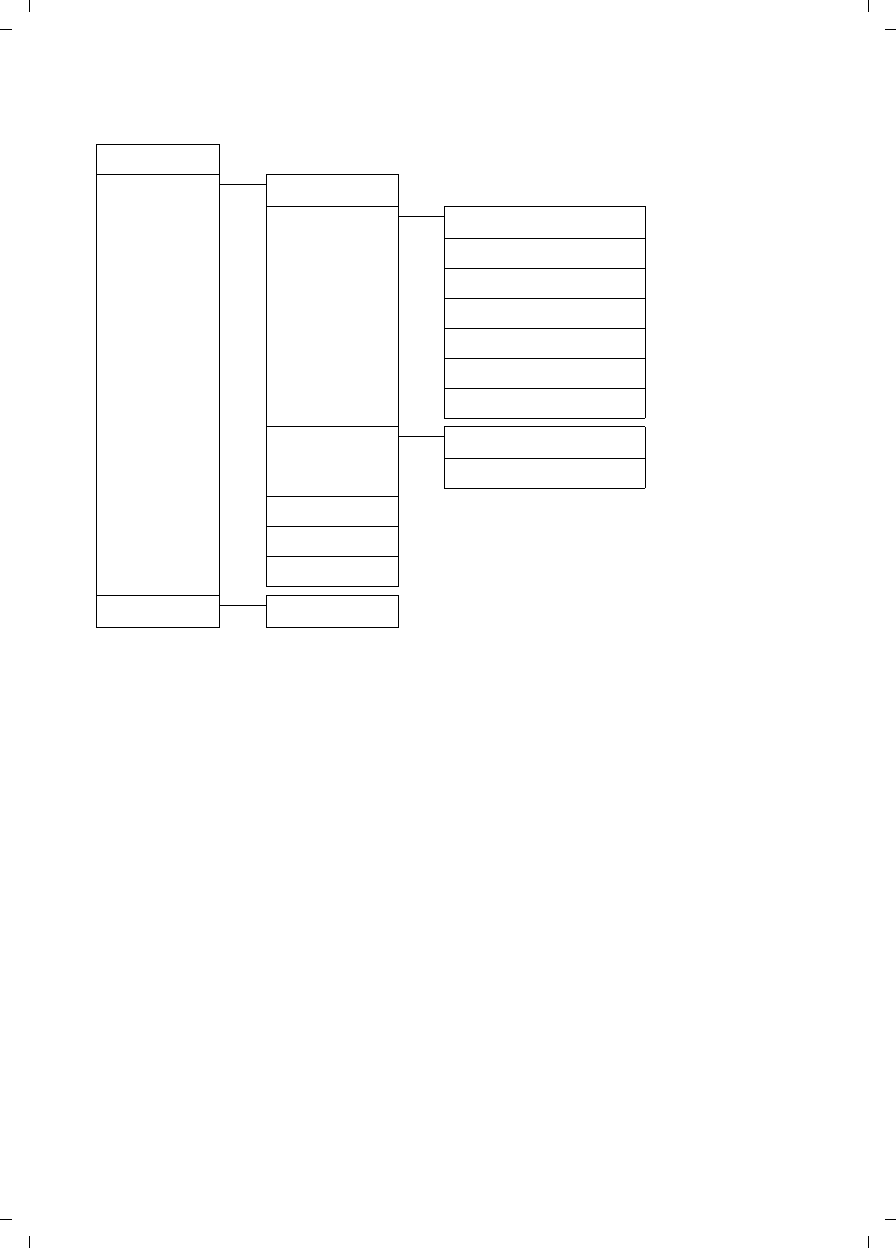
37
Menu trees
Gigaset A580 IP / US English / A31008-xxxx-xxxx-x-xxxx / menuetree.fm / 24.04.2009
Version 8, 03.09.2008
Web configurator menu
Home £Page 99
Settings IP Configuration £Page 103
Telephony Connections £Page 106
Audio £Page 115
Number Assignment £Page 120
Call Forwarding £Page 121
Dialing Plans £Page 123
Network Mailbox £Page 125
Advanced Settings £Page 126
Messaging Messenger £Page 130
E-Mail £Page 132
Services £Page 133
Handsets £Page 133 and Page 134
Miscellaneous £Page 137 to Page 139
Status Device £Page 140

38
Making calls with VoIP and the fixed line network
Gigaset A580 IP / US English / A31008-xxxx-xxxx-x-xxxx / telephony.fm / 24.04.2009
Version 8, 03.09.2008
Making calls with VoIP and the fixed line network
Making an external call
External calls are calls made via the public telephone network (fixed line
network) or via the Internet (VoIP). You decide which connection type you want
to use for a specific call when you dial the number. You have the following
options:
uSelect the connection type with the Talk key c (briefly press/press and
hold c), £Page 38.
uSelect the connection type via the display keys by assigning VoIP or the fixed
line network to your left Display key, £Page 39
uSelect a special connection via your line suffix, £Page 38
Use the Talk key to select the type of connection and make the call
By briefly pressing or pressing and holding the Talk key c, you can determine
the type of connection for the call you want to make (fixed line network or
VoIP).
Prerequisite: You enter the number without a line suffix (£Page 38) and
have not defined any dialing plans for this number (£Page 123).
~c Enter number (without suffix) and briefly press/press and hold
the Talk key.
A default connection is established on your phone (fixed line network or VoIP
£Page 86/Page 119).
¤Briefly press the Talk key c to make a call via this default connection.
¤Press and hold the Talk key c to make the call via the other connection
type.
Please note
uYou can conduct three separate external calls via your base station (using
different handsets): two calls via VoIP and one via the fixed line network.
uYou can define dialing plans for certain numbers or area codes by determin-
ing the connection and therefore the billing method to be used (cost con-
trol £Page 123) when these numbers are dialed.
uDialing with the Directory (£Page 62), Shortcut keys (£Page 64) or Last
Number Redial list (£Page 57) saves repeated keying of phone numbers.
You can modify or add to these numbers on a call-to-call basis.
uIf you use VoIP to make a call to the fixed line network, you may also have
to dial your local area code for local calls (depending on the VoIP provider).
You can avoid having to dial your own area code by entering it into the con-
figuration ( £Page 87, Page 122) and activating the option Predial area
code for local calls through VoIP (£Page 122).
uDepending on the exchange, you may not have to dial your own area code
when making local calls via the fixed line network.

39
Making calls with VoIP and the fixed line network
Gigaset A580 IP / US English / A31008-xxxx-xxxx-x-xxxx / telephony.fm / 24.04.2009
Version 8, 03.09.2008
If you have assigned a number of VoIP numbers to your phone, you can define
which VoIP number (VoIP account) is used for external calls from each specific
handset (handset send number, £Page 120).
Use the Display key to select the type of connection and make the call
Prerequisite: §Phone§ or §IP§ is assigned to your handset's left Display key
(£Page 79).
§Phone§ / §IP§ Press the Display key to define the connection type.
~/sEnter number or select from the directory.
c/ dPress the Talk or Handsfree key.
The number is dialed via the selected line type.
Exception:
If you have activated the option "Automatic Fallback to Fixed Line" (Web configu-
rator, £Page 119) and the attempt to establish a connection via VoIP fails, an
attempt is made automatically to establish the connection via the fixed line
network.
Selecting and dialing a connection via your line suffix
You can configure up to six VoIP numbers on your phone in addition to the fixed
line network number and the Gigaset.net number. A (line) suffix is assigned to
each number (line) of your phone:
uThe fixed line network number has the suffix #0
uVoIP numbers have the suffixes #1 to #6 (£Page 107)
uAnd the Gigaset.net number has the suffix #9
When dialing, you can use this line suffix to specify the connection via which
you would like to call or be charged.
Please note
uIf you are using a GAP compatible handset other than the Gigaset handsets
A58H, S67H, S68H, SL37H, S45 and C45, every call will be made via the
standard connection, even if you press and hold the Talk key.
uIf you have activated the option Automatic Fallback to Fixed Line with the Web
configurator (£Page 119):
If the attempt to establish a connection fails, an attempt is made automat-
ically to establish the connection via the fixed line network.
Please note
If you have pressed the Display key §IP§ before dialing and ...
uDialed the number with suffix #1 to #6, your call will be made via the VoIP
account assigned to the suffix. The number will not be dialed if the suffix is
invalid (e.g. no VoIP connection assigned).
uDialed the number without a suffix or with the suffix #0, your call will be
made via the handset's VoIP send number.
Do not enter a suffix if you have pressed the Display key §Phone§ prior to dialing.
Otherwise the suffix will be dialed together with the number via the fixed line
network. This may cause errors!

40
Making calls with VoIP and the fixed line network
Gigaset A580 IP / US English / A31008-xxxx-xxxx-x-xxxx / telephony.fm / 24.04.2009
Version 8, 03.09.2008
~ Enter the number of the party you wish to call.
~ Add the suffix of the connection (your phone number) from which
the call is to be made and charged to.
cPress the Talk key.
The connection is always made via the line with the assigned suffix, regardless
of whether you press the Talk key c briefly or press and hold.
Entering an IP address (provider-dependent)
You can also dial an IP address instead of a phone number using VoIP.
¤Press the Asterisk key * to separate the sections of the IP address
(e.g. 149*246*122*28).
¤If necessary press the Pound #key to attach the SIP port number of the
person you are calling to the IP address (e.g. 149*246*122*28#5060).
You cannot dial IP addresses using a line suffix.
If your VoIP provider does not support the choice of IP addresses, each part of
the address will be interpreted as a normal phone number.
Canceling the dialing operation
You can cancel the dialing operation with the End Call key a.
Dialing emergency numbers – defining dialing plans
You can use the Web configurator to block certain numbers or to define which
of your numbers (fixed line network, VoIP) should be used to call specific num-
bers (Dialing Plans, £Page 123).
If you enter a number that has a defined dialing plan, the call will be made via
the line defined in the dialing plan – regardless of whether the Talk key is
pressed briefly or pressed and held. Any automatic area code will not be pre-
fixed to the number.
Example
If you enter the number 1234567890#1 and press the Talk key c, the
number 1234567890 will be dialed via the first VoIP connection in the config-
uration.
Please note
uIf you specify a suffix for which no VoIP connection is configured in your
base station, the VoIP status code 0x33 is displayed. The number will not be
dialed.
uIf you have activated the option Automatic Fallback to Fixed Line with the Web
configurator (£Page 119):
If the attempt to establish a connection fails, an attempt is made automat-
ically to establish the connection via the fixed line network.

41
Making calls with VoIP and the fixed line network
Gigaset A580 IP / US English / A31008-xxxx-xxxx-x-xxxx / telephony.fm / 24.04.2009
Version 8, 03.09.2008
Emergency numbers
Dialing plans for emergency numbers (e.g. the local emergency service
number) are preset for certain countries. Emergency calls are then always
made via the fixed line network.
You cannot delete or deactivate these dialing plans. However, you can change
the connection through which each emergency number should be called (e.g.
if the phone is not connected to the fixed line network). You must make sure
that the VoIP provider for the selected connection supports emergency calls.
If your phone does not have default dialing plans for emergency calls, define
the rules yourself (£Page 123). Assign them to a connection that you know
supports emergency calls. Calls to emergency numbers are always supported
by fixed line networks.
Ending a call
aPress the End Call key.
Accepting a call
The handset indicates an incoming call in three ways: by ringing, by a display
on the screen and by the flashing Handsfree key d.
You can accept the call by:
¤Pressing the Talk key c.
¤Pressing the Handsfree key d.
If the handset is in the charging cradle and the Auto Answer function is activated
(£Page 80), the handset will take a call automatically when you lift it out of
the cradle.
To deactivate the ringer, press the §Menu§ Display key and select Silent. You can
accept the call as long as it is displayed on the screen.
Please note
uIf no rules are defined for emergency numbers and you have programmed
an automatic local area code (£Page 122), the code will be prefixed to
emergency numbers as soon as they are dialed via a VoIP connection.
uEmergency numbers cannot be dialed if the keypad lock is activated. Before
dialing, press and hold the Pound key #, to release the keypad lock.
Please note
Only calls to receive numbers assigned to your handset will be signaled
(£Page 120). The following conditions apply in particular:
uCalls made to a number that is not assigned to a handset as a receive
number will be signaled on all handsets.
uIf you have not assigned receive numbers to any of the handsets, calls to all
connections will be signaled on all handsets.
uCalls to your IP address are always signaled on all handsets.
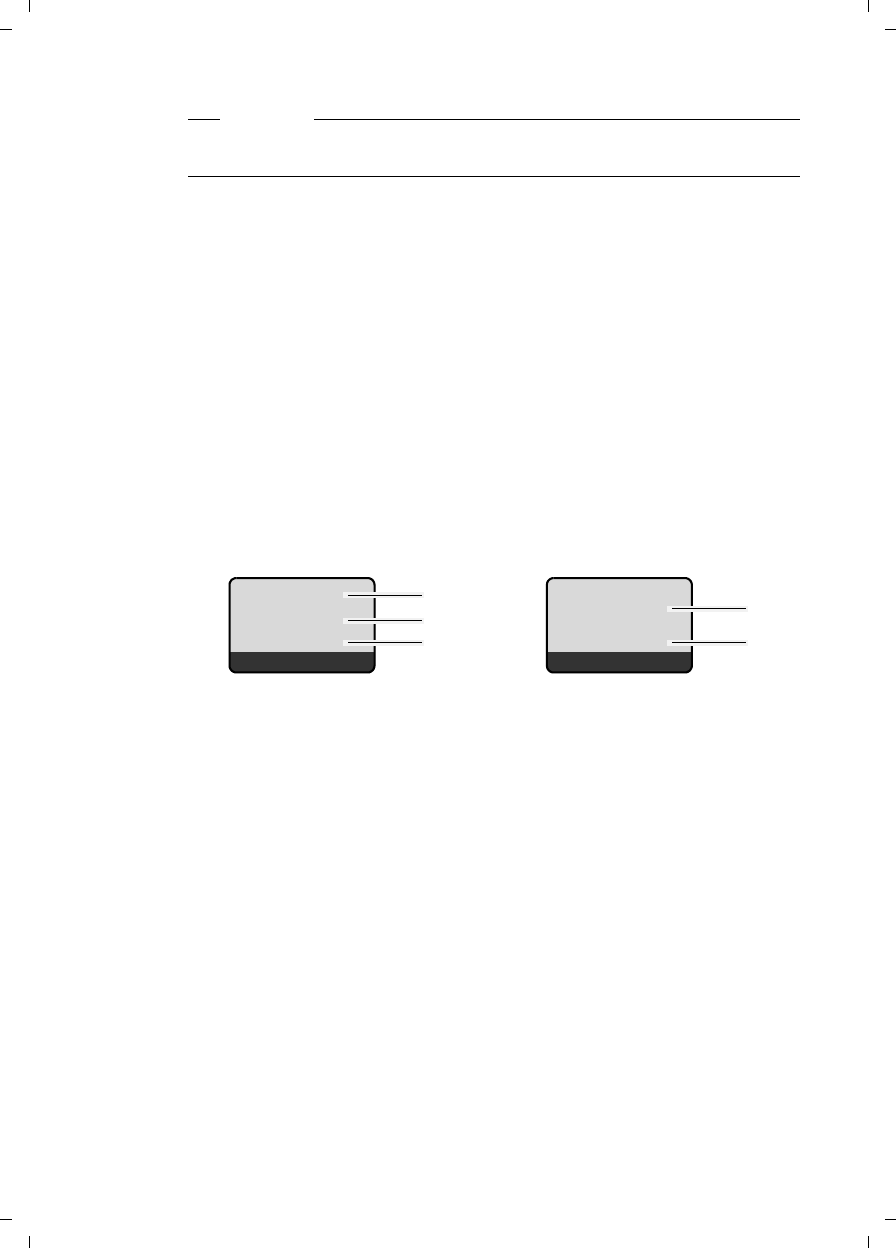
42
Making calls with VoIP and the fixed line network
Gigaset A580 IP / US English / A31008-xxxx-xxxx-x-xxxx / telephony.fm / 24.04.2009
Version 8, 03.09.2008
Caller ID
When you receive a call from the Internet, the caller's number or the name they
have specified is displayed on the screen.
When you receive a call from the fixed line network, the caller's number and/or
name is displayed on the screen if you have requested Caller ID (CID) from your
network provider.
If the phone number is identified and the caller's number is saved in the direc-
tory, the name is displayed from the directory.
Call display
You can use the display to determine whether the call is for your fixed line net-
work number or one of your VoIP numbers.
1 Ringer icon
2 Number or name of the caller if available
3 Receive number: indicates which of your phone numbers the caller has dialed. Assign
the name when you are configuring the phone with the Web configurator
(£Page 108/Page 114). For calls from Gigaset.net, For Gigaset.net is displayed.
Withholding calling line display
The number or name of the caller is not displayed in the following cases:
uThe caller has activated the "anonymous calling" function.
uA caller from the fixed line network has not requested Caller ID from the
fixed line network provider.
Please note
You can reject VoIP calls by pressing the End Call key a. The caller receives
an appropriate message (provider-dependent).
Calls to your fixed line number Calls to one of your VoIP numbers
Å
1234567890
For Fixed Line
Menu
1234567890
1234567890
For IP1
Menu
2
3
1
2
3
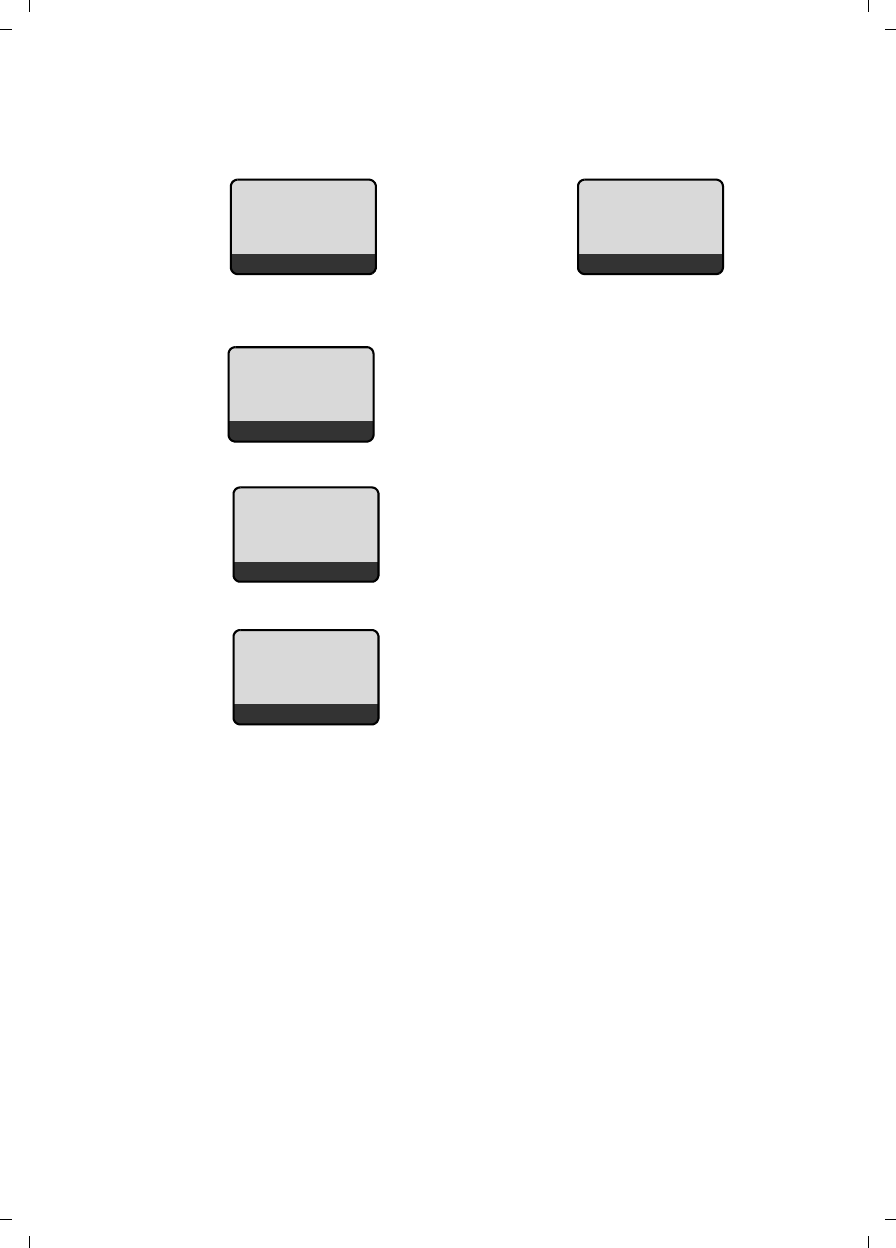
43
Making calls with VoIP and the fixed line network
Gigaset A580 IP / US English / A31008-xxxx-xxxx-x-xxxx / telephony.fm / 24.04.2009
Version 8, 03.09.2008
The following is displayed in place of the number:
uWith a call to one of your VoIP phone numbers, the display is provider-
dependent (examples):
uFor a call to your fixed line network number:
– If no number is transmitted:
– If the caller has withheld Caller ID:
– If the caller has not arranged Caller ID:
Screen display with CID (fixed line network)
Prerequisite: Call is made from a fixed line network connection to your fixed
line network number.
If you have CID, then the name (town/city) that is registered with your network
provider for the caller's number will also be displayed. If the caller's number is
stored in your directory then the directory entry will be shown.
The display shows:
uExternal Call, if no number is transmitted.
uPrivate, if the caller has suppressed Caller ID
uNot available, if the caller has not arranged Caller ID.
Private
anonymous
For IP1
Menu
M
External Call
For IP1
Menu
or
Å
External Call
For Fixed Line
Menu
Å
Private
For Fixed Line
Menu
Å
Not available
For Fixed Line
Menu

44
Making calls with VoIP and the fixed line network
Gigaset A580 IP / US English / A31008-xxxx-xxxx-x-xxxx / telephony.fm / 24.04.2009
Version 8, 03.09.2008
VoIP: Displaying the called party's phone number (COLP)
Prerequisites:
uYour VoIP provider supports COLP (Connected Line Identification Presenta-
tion). You may have to ask your provider to activate COLP (contact your VoIP
provider for more information).
uThe called party has not activated COLR (Connected Line Identification
Restriction).
For outgoing VoIP calls, the phone number of the connection on which the call
is received is displayed on the handset.
The displayed number may differ from the number you have dialed. Examples:
uThe called party has activated call forwarding.
uThe call is answered by another connection within a PABX system.
If there is an entry in the directory for this phone number, the corresponding
name is displayed.
Using speaker mode
In speaker mode, instead of holding the handset to your ear you can put it
down, for example on the table in front of you. This allows others to participate
in the call.
Activating/deactivating speaker mode
Activating while dialing
~d Enter number and briefly press/press and hold the Speaker key to
select the connection type (£Page 38).
¤Inform your caller before you use the speaker function so that they know
someone else may be listening.
Switching between earpiece and speaker mode
¤Press the Speaker key d to activate or deactivate the speaker during a call
and when listening to the answering machine.
If you wish to place the handset in the charging cradle during a call:
¤Press and hold the Speaker key d while placing the handset in the charg-
ing cradle.
¤If the Speaker key d does not light up, press the key again.
For instructions on adjusting the handset volume, see £Page 80.
Please note
uThe number of the connection you have reached (or the assigned name)
will also be displayed instead of the called number during toggling, confer-
ence calls and consultation calls.
uWhen the phone number is copied to the directory (§Menu§ £Copy to phone-
book) and the Last Number Redial list, the dialed number (not the displayed
number) is copied.

45
Making calls with VoIP and the fixed line network
Gigaset A580 IP / US English / A31008-xxxx-xxxx-x-xxxx / telephony.fm / 24.04.2009
Version 8, 03.09.2008
Muting the handset
You can deactivate the microphone in your handset during an external call. The
other party will hear music on hold, if activated (£Page 86).
kPress the Display key to mute the handset.
/ a Press the Display or the End Call key, to reactivate the microphone.
Deactivating your handset's microphone
You can deactivate your handset's microphone during an external call (includ-
ing during a conference or when toggling). The other party can no longer hear
you, but you can still hear them.
§Mute§ Press the Display key to mute the handset.
Your handset's microphone is deactivated. Im"Microphone is turned
off." appears in the display.
§On§ Press the Display key to switch the microphone back on.
Making cost-effective calls
You can use your phone's cost control function for calls to fixed line or mobile
phone networks. Open accounts with various VoIP providers who offer favora-
ble rates for calls to other networks. In the phone configuration, define the
most cost-effective VoIP connections (account), e.g. for specific regional,
national and cellular network prefixes, to be used when calls are made (Dialing
Plans, £Page 123). Or define the VoIP connection to be used when dialing the
number ( £dialing with line suffix, Page 38).
If you are using your fixed line network to make a call, choose a network pro-
vider that offers particularly favorable rates (call-by-call).
Ç
Please note
Under the following circumstances, the microphone is automatically reacti-
vated:
uIf, during an external call (you have deactivated the microphone), you
establish a second connection, either by accepting a waiting call or by suc-
cessfully connecting to an external/internal consultation call, the micro-
phone is activated. If you go back to the first party, the microphone remains
activated.
(If you reject a waiting call or are unable to connect to a consultation call,
the microphone remains deactivated.)
uIf you have deactivated the microphone during call swapping, it is reacti-
vated for both connections as soon as you swap to the other party.
uIf you have deactivated the microphone during a conference call, the micro-
phone is reactivated when you end the conference call by pressing §Menu§
¢End Conference (call swap).

46
VoIP telephony via Gigaset.net
Gigaset A580 IP / US English / A31008-xxxx-xxxx-x-xxxx / telephony.fm / 24.04.2009
Version 8, 03.09.2008
Displaying the call duration
The duration of each call appears in the display for calls made via a fixed line
network and VoIP
uDuring the conversation,
uUntil about three seconds after the call has ended if you do not replace the
handset in the charging cradle.
VoIP telephony via Gigaset.net
You can use Gigaset.net to make free phone calls via the Internet directly to
other Gigaset.net users, without having to set up an account with a VoIP pro-
vider or make any further settings. You simply have to connect your phone to
the power supply and the Internet connection and, if necessary, enter yourself
in the Gigaset.net online directory under a name of your choice (£Page 47/
Page 50).
Gigaset.net is a VoIP service provided by Gigaset Communications GmbH* to
which all users of a Gigaset VoIP device can subscribe.
You can call other subscribers to Gigaset.net free of charge, i.e. there are no
telephone charges other than the costs for your Internet connection. Connec-
tions to/from other networks are not possible.
Every Gigaset VoIP device is assigned a Gigaset.net phone number by default
(£Page 148).
All registered subscribers are included in the Gigaset.net directory, which you
are able to access.
An echo service is available on the phone number 12341#9 (English),
12344#9 (French) or 12346#9 (Spanish) for you to check your VoIP connec-
tion.
After an announcement, the echo service sends back the voice data you have
received immediately in the form of an echo.
Exclusion of liability
Gigaset.net is a voluntary service provided by Gigaset Communications GmbH
with no liability for or guarantee of network availability. This service can be ter-
minated at any time with a notice period of three months.
Please note
The actual duration of the call can vary from that shown by a few seconds.
* Gigaset Communications GmbH is a licensee of the Siemens trademark.
Please note
If you do not use your Gigaset.net connection for six weeks, it is automatically
deactivated. You cannot be reached for calls from Gigaset.net.
The connection is reactivated:
uAs soon as you start a search in the Gigaset.net directory or
uMake a call via Gigaset.net (dial a number with #9 at the end) or
uActivate the connection via the Web configurator (£Page 114).
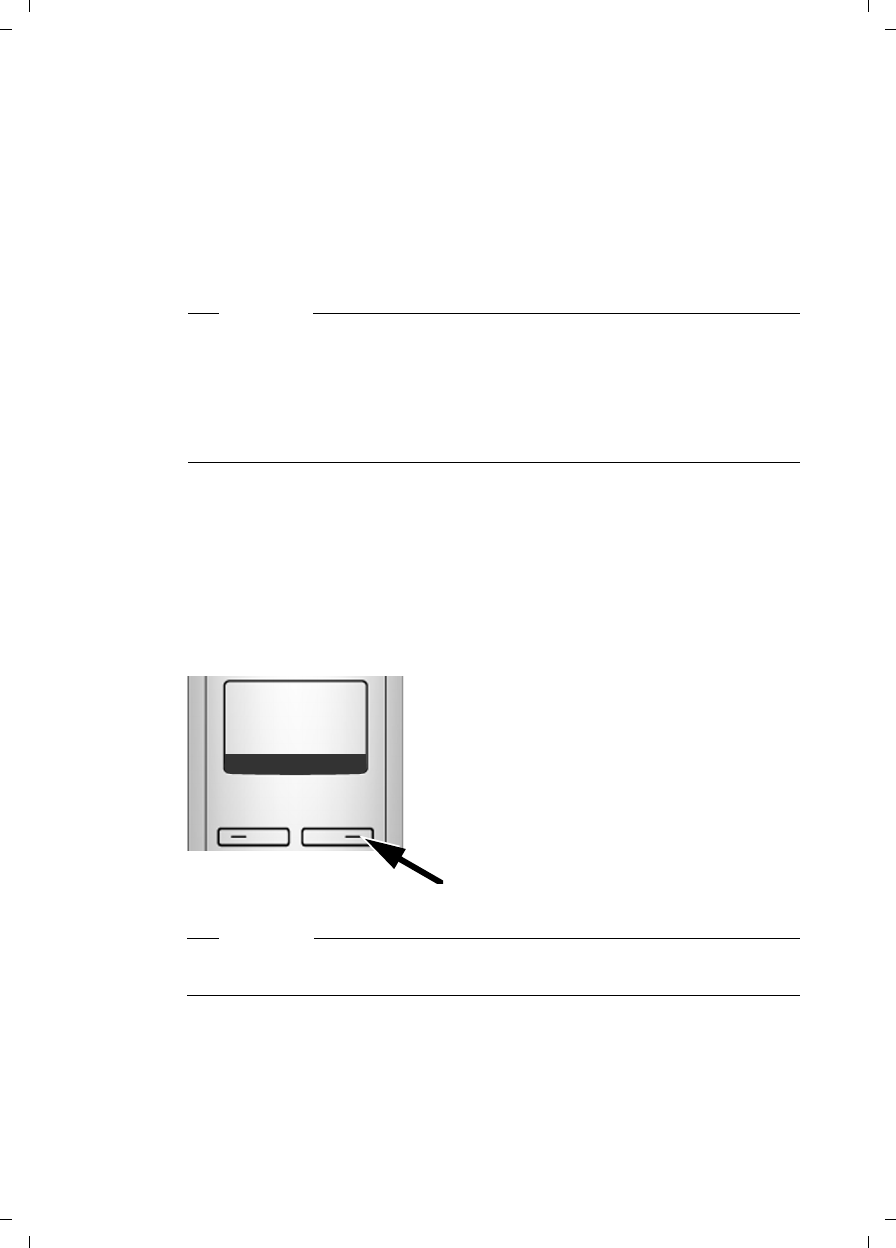
47
VoIP telephony via Gigaset.net
Gigaset A580 IP / US English / A31008-xxxx-xxxx-x-xxxx / telephony.fm / 24.04.2009
Version 8, 03.09.2008
Opening the Gigaset.net directory
Your handset is in idle status.
sPress and hold.
Or:
¤Open the directory with the s button.
¤Select Gigaset.net from the directory and press the Talk key c. A connection
to the Gigaset.net directory is established.
If a connection cannot be made to the Gigaset.net directory, an error message
will be sent and the handset will go into idle status.
After opening the Gigaset.net directory for the first time
When opening the Gigaset.net directory for the first time you can use the
Gigaset.net wizard to create an entry in the Gigaset.net directory for your
phone.
You will see the following display:
¤Press the Display key §Yes§ to start the wizard.
Please note
uThe Gigaset.net directory entry is transferred to a handset when it is regis-
tered with the base station, if the handset can send and receive directory
entries.
uCalls to the Gigaset.net directory are always free of charge.
uYou can also open the Gigaset.net directory by dialing 1188#9 (phone
number of the Gigaset.net directory) and pressing the Talk key c.
Start
Gigaset.net
wizard?
No Yes
Please note
If you press §No§ the wizard will be canceled. You can then create the entry later
via the Gigaset.net directory (£Page 50).
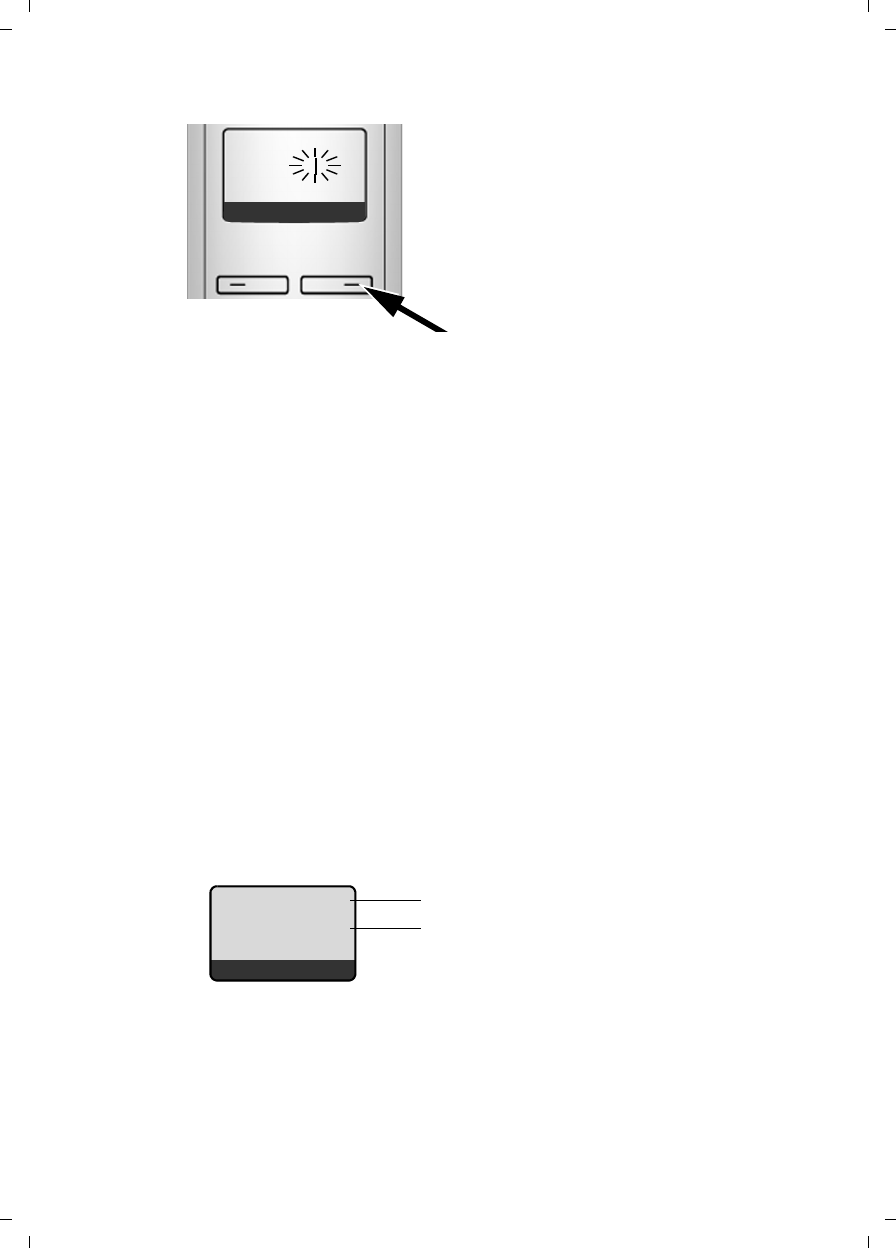
48
VoIP telephony via Gigaset.net
Gigaset A580 IP / US English / A31008-xxxx-xxxx-x-xxxx / telephony.fm / 24.04.2009
Version 8, 03.09.2008
When the wizard has been started the following display will appear (example):
¤Using the keypad, enter the name that you would like to be listed under in
the Gigaset.net directory. The name may contain a maximum of 25 charac-
ters.
¤Press the key below §OK§.
If there is already an entry under this name, you will receive a message to this
effect and you will be asked to enter a name again: Please choose another name.
If an entry in the Gigaset.net directory is successful, the message Name added to
Gigaset.net is displayed.
You have not been able to enter a name
If the attempt to create the entry fails you can create it via the Gigaset.net
directory (£Page 50).
Searching for subscribers in the Gigaset.net directory
Once the connection has been established, you will be asked to enter a name
that you want to search for.
Nickname:Enter the name or part of a name (maximum 25 characters).
§Menu§ Press the Display key.
Start search Select and press §OK§.
If the search has been successful, a Hit list of all the names that begin with the
specified character string is displayed.
Example:
1. 5/25: Entry number/number of hits
2. Name of the entry, the name is displayed in full, if necessary over several lines
You can scroll through the Hit list with q.
Your nickname:
1happyuser
ÛTOK
5/25
Sand, Anna Mag
dalena
View UMenu
1
2

49
VoIP telephony via Gigaset.net
Gigaset A580 IP / US English / A31008-xxxx-xxxx-x-xxxx / telephony.fm / 24.04.2009
Version 8, 03.09.2008
If it has not been possible to find a matching entry, a corresponding message
is displayed. You have the following options:
¤Press the Display key §New§ to start a new search.
Or
¤Press the Display key §Change§ to change the search criteria. The previously
entered name is copied and can be edited.
If there are too many matching entries in the Gigaset.net directory, the mes-
sage Too many entries found is displayed instead of a Hit list.
¤Press the Display key §Refine§ to start a refined search. The previously entered
name is copied and can be edited/expanded.
Calling participants
q Select the subscriber from the Hit list.
c Press the Talk key.
Viewing the subscriber's number
q Select the subscriber from the Hit list.
§View§ Press the Display key.
The display shows the Gigaset.net number and the subscriber's name.
Depending on the length of the information, the name may cross several lines.
Example:
1234567#9
Sand, Anna Mag
dalena
ÇUOK
Please note
uConnections to Gigaset.net are always established via the Internet regard-
less of which default connection is set on your phone. Pressing and holding
c or pressing it briefly have no effect.
uYou can open the Gigaset.net directory and establish connections, even if
you have not entered yourself in the Gigaset.net directory.

50
VoIP telephony via Gigaset.net
Gigaset A580 IP / US English / A31008-xxxx-xxxx-x-xxxx / telephony.fm / 24.04.2009
Version 8, 03.09.2008
Using other functions
Prerequisite: The Hit list is displayed.
q(select entry) ¢§Menu§
The following functions can be selected with q:
Copy to Directory
Copy the entry to the handset directory. The number and name (abbreviated
if necessary, maximum 16 characters) are copied to the directory.
¤Edit and save entry where appropriate (£Page 63).
The Hit list is displayed again.
Show number
Display the number of the entry.
¤Press the Display key §OK§, to return to the Hit list.
New search
Start a search with a new name (£Page 48).
Refine search
Start detailed search. The previously entered Nickname can be edited/
expanded and the search can be restarted (£Page 48).
Your name in Gigaset.net
£ "Managing your own entry", Page 50.
Managing your own entry
You have the following options:
uEdit the name of your entry in the Gigaset.net directory
uDelete your entry from the Gigaset.net directory
Viewing own entry
¤You are connected to the Gigaset.net directory:
Select §Menu§ ¢ Your name in Gigaset.net and press §OK§.
Or:
¤You are in a Gigaset.net Hit list:
Select §Menu§ ¢ Own information and press §OK§.
Your Gigaset.net number and, where applicable, your currently entered name
are displayed.
Please note
If you select a Gigaset.net number from the local directory, the connection is
automatically established via Gigaset.net (Internet).

51
VoIP telephony via Gigaset.net
Gigaset A580 IP / US English / A31008-xxxx-xxxx-x-xxxx / telephony.fm / 24.04.2009
Version 8, 03.09.2008
Entering/editing a name
§Edit§ Press the Display key.
~ Edit name or enter new name (maximum 25 characters) and
press §OK§.
You can delete the name with X.
If there is no existing entry with this name in the Gigaset.net directory, the
name is saved. A message to this effect is displayed. The handset switches to
idle status.
If there is an existing entry with this name, or the entered name contains
invalid characters, you will be requested to enter a different name.
Deleting your own entry from the Gigaset.net directory
Prerequisite: You are connected to the Gigaset.net directory:
§Menu§ ¢ Your name in Gigaset.net / Own information
Select and press §OK§.
§Edit§ Press the Display key.
X Delete name and press §OK§.
Your entry is deleted from the directory. You are no longer "visible" to other
Gigaset.net subscribers. However, you can still be reached via your Gigaset.net
number.
Calling a Gigaset.net subscriber
You can call a Gigaset.net subscriber directly via the Gigaset.net directory (see
above) or via their Gigaset.net number:
~/s Enter the Gigaset.net number (including the #9) or select from the
handset directory.
cPress the Talk key.
Every number ending with #9 is dialed via Gigaset.net.
Please note
For instructions on displaying your Gigaset.net number, see Page 148.

52
Network services
Gigaset A580 IP / US English / A31008-xxxx-xxxx-x-xxxx / netservices_SAG.fm / 24.04.2009
Version 8, 03.09.2008
Network services
Network services are functions made available by your fixed line network or
VoIP provider.
Blocking your Caller ID – Anonymous calling
Phone number identification can be blocked. Your phone number will not be
displayed when making outgoing calls. You are calling anonymously.
Prerequisites:
uFor anonymous calls via your fixed line network connection you need to
have requested the relevant service (feature) from your fixed line network
provider.
uAnonymous calls are only possible via VoIP connections through providers
that support the "anonymous calling" function. You may have to ask your
VoIP provider to activate this function.
Activating/deactivating "anonymous calling" for all calls
Withholding caller ID can be activated/deactivated permanently for all of your
phone's connections (fixed line network and VoIP).
When this function is activated, the phone number will be withheld both for
fixed line network calls and for calls via a VoIP connection. Withholding caller
ID is activated for all registered handsets.
§Menu§ ¢Select Services
All calls anonymous
Select and press §OK§ (‰=on).
Activating/deactivating "anonymous calling" for the next call
You can activate/deactivate withholding caller ID for the next call.
§Menu§ ¢Select Services ¢Next call anonymous
Yes / No Select and press §OK§.
~ If necessary, enter the phone number with line suffix.
§Send§ Press the Display key. The phone number is dialed. If you have not
specified a line suffix, the number will be dialed via the default con-
nection.
Further network services for fixed line networks
The following network services can only be used for making calls via the fixed
line network. You will need to request them from your fixed line network pro-
vider.
¤Contact your network provider for further assistance.

53
Network services
Gigaset A580 IP / US English / A31008-xxxx-xxxx-x-xxxx / netservices_SAG.fm / 24.04.2009
Version 8, 03.09.2008
Functions during a call
Initiating ringback
You have dialed a number via the fixed line network and can hear the busy
tone.
§Menu§ ¢Ringback
aPress the End Call key.
As soon as the dialed number becomes available, the phone rings.
¤Press the Talk key c, to establish a connection to that number.
Consultation calls
During a call:
§Menu§ ¢External Call
Select and press §OK§.
~Enter a number or copy it from the directory and press §OK§.
The number will be dialed via the fixed line connection.
uConference call:
– Talk to both participants: §Menu§ ¢Conference Call.
– End call with both participants: press the End Call key a.
Further network services for VoIP
You can use the following network services to make calls via the VoIP connec-
tion.
Settings for all calls
General call forwarding
Prerequisite: The VoIP provider supports call forwarding.
§Menu§ ¢Select Services ¢VoIP ¢For All Calls ¢Call Diversion
The display shows a list of configured and activated VoIP phone numbers and
the Gigaset.net number of your telephone. Numbers for which call forwarding
is activated are marked with ‰.
qSelect the phone number for which you want to activate or change
call forwarding and press §OK§.
All Calls / No Answer / When Busy
Select and press §OK§ (‰= on).
On Select and press §OK§.
Please note
After a few seconds, the number selected for a consultation call is saved in the
Last Number Redial list.

54
Network services
Gigaset A580 IP / US English / A31008-xxxx-xxxx-x-xxxx / netservices_SAG.fm / 24.04.2009
Version 8, 03.09.2008
~If necessary, enter the number to which the call is to be forwarded.
You can specify a fixed line network, VoIP or mobile number for for-
warding calls from a VoIP number.
You must specify another Gigaset.net number for call forwarding
from your Gigaset.net number.
§OK§ Press the Display key.
a Press and hold (idle status).
Call forwarding is activated for the selected phone number (receive number).
This does not result in calls for the other VoIP numbers or your fixed network
numbers being forwarded.
Deactivating call forwarding
qSelect the VoIP phone number for which you want to deactivate call
forwarding and press §OK§.
All Calls / No Answer / When Busy
Select and press §OK§ (‰= on).
Off Select and press §OK§.
a Press and hold (idle status).
Call forwarding is deactivated.
Activating/deactivating call waiting
Prerequisite: Your phone will permit two parallel VoIP connections (see Allow
1 VoIP call only, £Page 116).
If call waiting is activated, a caller on one of your VoIP connections will hear the
ringer if you are already on a call using this VoIP connection. This call is
announced sound and visually on your handset screen.
Calls on the fixed line connection are not signaled as call waiting. They are sig-
naled on other registered handsets to which the fixed line number has been
assigned as a receive number. If no other handset is available, the caller will
hear the busy tone.
Accepting/rejecting a waiting call, £Page 56.
§Menu§ ¢Select Services ¢VoIP ¢For All Calls ¢Call Waiting
On / Off Select and press §OK§.
a Press and hold (idle status).
Please note
Forwarding VoIP phone numbers can incur additional costs. Please consult
your VoIP provider.
Please note
The setting applies to all VoIP phone numbers. It does not affect the procedure
for call waiting on the fixed line network.

55
Network services
Gigaset A580 IP / US English / A31008-xxxx-xxxx-x-xxxx / netservices_SAG.fm / 24.04.2009
Version 8, 03.09.2008
Functions during a call
Prerequisite: Your phone will permit two parallel VoIP connections (see Allow
1 VoIP call only, £Page 116).
Consultation calls
During an external call:
§Menu§ ¢External Call
Select and press §OK§.
~ Enter the number (if necessary the suffix) or copy it from the direc-
tory.
cPress the Talk key.
The number is always dialed via VoIP. If no suffix is entered, it is selected via the
VoIP send number.
If the participant does not answer:
¤Press the Display key §End§, to return to the waiting call.
If the participant answers, you have the following options:
uToggling:
¤Use q to toggle between the participants.
¤End call with active participant: §Menu§ ¢End Active Call.
Press the End Call key a, to end the current call. The participant who
was previously waiting will automatically call you back.
uConference call:
¤Talk to both participants: §Menu§ ¢Conference Call.
¤End conference call (toggle): §Menu§ ¢End Conference.
¤End call with both participants: press the End Call key a.
Please note
After a few seconds, the number selected for a consultation call is saved in the
Last Number Redial list.

56
Network services
Gigaset A580 IP / US English / A31008-xxxx-xxxx-x-xxxx / netservices_SAG.fm / 24.04.2009
Version 8, 03.09.2008
uCall forwarding (provider-dependent):
You can connect the two external participants.
Prerequisites:
– You are toggling calls and you phoned the currently active participant
yourself.
– You have activated call forwarding via the Web configurator
(£Page 127)
Depending on the setting in the Web configurator (£Page 127):
¤Press the End Call key a.
Or:
¤Press key S.
If call forwarding was successful, a message will appear to this effect. The
handset will then switch to idle.
If call forwarding was not successful, the party that was previously waiting
will call you back.
Accepting a waiting call
Prerequisite: Call waiting is activated (£Page 54).
§Menu§ ¢Accept Call Waiting
You have the option of toggling or holding a conference call.
Rejecting a waiting call
Menu§ ¢Reject Call Waiting
The caller hears the busy tone.
Please note
uIf the first call was an internal call, the internal connection is ended.
uAn internal, waiting call is shown on the display. You can neither accept the
internal call nor reject it.

57
Using lists
Gigaset A580 IP / US English / A31008-xxxx-xxxx-x-xxxx / directories_charges.fm / 24.04.2009
Version 8, 03.09.2008
Using lists
The options are:
uLast Number Redial list
uCalls list
uNetwork mailbox
using the Last Number Redial list
The Last Number Redial list contains the ten numbers last dialed with the
handset (maximum 32 numbers). If one of the numbers is in the directory, the
corresponding name is displayed.
Dialing from the Last Number Redial list
cPress the key briefly.
sSelect entry.
cBriefly press/press and hold the Talk key. The number is dialed using
the selected connection type (£Page 38).
Managing entries in the Last Number Redial list
cPress the key briefly.
sSelect entry.
§Menu§ Open menu.
The following functions can be selected with q:
Use Number
Save or modify a saved number and then dial with c or save as a new
entry; to do so, press §Menu§ ¢Copy to phonebook ¢§OK§after the number
appears on the display.
Copy to Directory
Copy an entry to the directory (£Page 65).
Delete Entry
Delete selected entry.
Delete List
Delete complete list.

58
Using lists
Gigaset A580 IP / US English / A31008-xxxx-xxxx-x-xxxx / directories_charges.fm / 24.04.2009
Version 8, 03.09.2008
Opening lists with the Message key
You can use the Message key f to open the following list selection:
uCalls list
uNetwork mailbox, £Page 67
A separate list is displayed for each network mailbox.
Prerequisite: Its number is saved in the base station, it is switched on
(£Page 125) and the corresponding VoIP/fixed line network number is
assigned to the handset as a receive number.
An advisory tone sounds as soon as a new message arrives in a list. The f
key flashes (it goes off when the key is pressed). The message You have new mes-
sages appears in the display in idle status.
List selection
The lists displayed after pressing the message key f depend on whether
there are any new messages.
f key does not flash (no new messages): All lists are displayed. Select a list
with q. To open, press §OK§.
f key flashes (new messages received): All the lists that contain new
messages are displayed as well as the network mailbox lists, whose connection
is assigned to the handset as a receive number (Net AM Fixed Line, Net AM
IP1,...).
Network Mailbox lists
If you select a Network Mailbox list and press §OK§ you will be connected directly
to the network mailbox. For information on network mailboxes, £Page 67.
Calls list
The Calls list contains the last 20 numbers, depending on the type of list set
uAll calls
–answered calls
– unanswered calls
uMissed calls
– unanswered calls
Multiple calls from the same number will be stored once in the list of missed
calls (the latest call). The number of calls from this number is shown in brackets
after the entry.
Multiple calls from the same number are stored several times in the list of
answered calls.
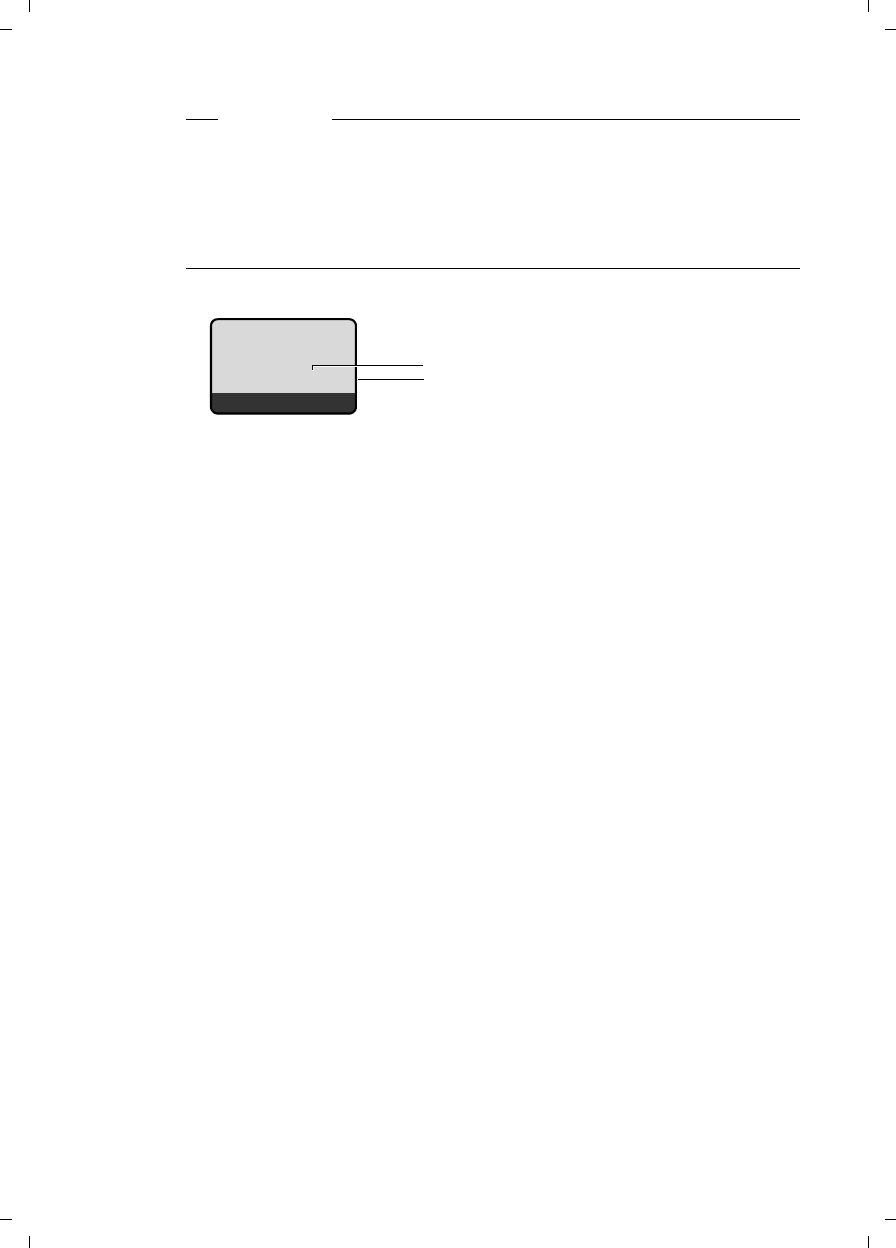
59
Using lists
Gigaset A580 IP / US English / A31008-xxxx-xxxx-x-xxxx / directories_charges.fm / 24.04.2009
Version 8, 03.09.2008
The Calls list is displayed as follows:
1 Number of new entries
2 Number of old, read entries
Setting the Calls list type
§Menu§ ¢Settings ¢Base ¢Calls List Type
Missed Calls / All Calls
Select and press §OK§ (‰=on).
a Press and hold (idle status).
The Calls list entries are retained when you change the list type.
Open the Calls list
f ¢Calls List 01+02
Select and press §OK§.
qSelect entry.
The last incoming call is displayed in the Calls list.
Please note
uOnly calls to the receive numbers assigned to your handset are stored in the
Calls list (£Page 120).
If no receive numbers are assigned, all calls will be stored in the Calls list for
all handsets.
uMissed calls are not stored in the Calls list if they were taken on another
phone registered with the same VoIP access data.
Calls List:
02+03
ÇUOK
1
2

60
Using lists
Gigaset A580 IP / US English / A31008-xxxx-xxxx-x-xxxx / directories_charges.fm / 24.04.2009
Version 8, 03.09.2008
List entry
Example of a list entry:
uStatus of entry
New Call: new missed call.
Old Call: entry already read.
Call recv.: call answered (in list type All Calls).
uEntry number
01/02 means e.g. first new entry of a total of two new entries.
uNumber or name of the caller (the number is always stored in the list with
the area code)
uCall date and time (if set, £Page 77).
Managing entries in the Calls list
Prerequisite:
You have opened the Calls list and selected an entry.
§Menu§ Press the Display key.
The following functions can be selected with q:
Delete Entry
Delete selected entry.
Copy to Directory
Copy a displayed number to the directory.
Show Name
VoIP:
If a URI was received and stored for a VoIP call, this will be shown. The URI is
dialed if you press the Talk key c. The URI is not entered on the Last
Number Redial list.
Fixed line network: £ "Displaying CID information", Page 61.
Show Connection
Display the name of the connection (fixed line network/VoIP account), for
which the call was received.
Delete List
Delete complete list.
New Call 01/02
1234567890
10.10.08 12:14
ÇUMenu

61
Using lists
Gigaset A580 IP / US English / A31008-xxxx-xxxx-x-xxxx / directories_charges.fm / 24.04.2009
Version 8, 03.09.2008
Displaying CID information
If you have CID, you can display the name and town/city that is registered with
your network provider for this number.
You have selected a list entry.
§Menu§ ¢Show Name
If the name and town/city are not shown, it means that the caller has not
requested Caller ID or that Caller ID has been withheld.
Press §OK§ to return to the list.
Selecting from the Calls list
f ¢Calls List 01+02
qSelect entry.
cBriefly press/press and hold the Talk key. The number is dialed using
the selected connection type (£Page 38).
Please note
Store your own area code on your phone ( £Page 87, Page 122) so that the
area code is automatically withheld during local calls on the fixed line net-
work.

62
Using the directory
Gigaset A580 IP / US English / A31008-xxxx-xxxx-x-xxxx / directories_charges.fm / 24.04.2009
Version 8, 03.09.2008
Using the directory
You can save up to 150 entries in your directory (number dependent on the
number of individual entries).
You can create a personalized directory for your own individual handset.
However, you can send the list or individual entries to other handsets
£Page 65.
In the directory you can save numbers and corresponding names.
¤With the handset in idle status, open the directory by pressing the s key.
Entry length
Number: maximum 32 digits
Name: maximum 16 characters
Saving the first number in the directory
sOpen the directory.
The display shows Dir. empty New entry?.
§OK§ Press the Display key.
~ Enter the number and press §OK§.
~ Enter the name and press §OK§.
Please note
For quick access to a number from the directory (shortcut), you can assign the
number to a key (£Page 64).
Please note
Some VoIP providers do not support local calls for calls to the fixed line net-
work. In this case, always enter the fixed line number with the area code in
your directory. Alternately, you can also use the Web configurator to define an
area code, which is automatically prefixed to all numbers that are dialed via
VoIP without an area code (£Page 122).
Please note that (depending on the fixed line network provider), when local
calls are made via the fixed line network the number cannot be dialed with an
area code.

63
Using the directory
Gigaset A580 IP / US English / A31008-xxxx-xxxx-x-xxxx / directories_charges.fm / 24.04.2009
Version 8, 03.09.2008
Storing a number in the directory
s ¢§Menu§ ¢New Entry
~ Enter the number and press §OK§.
~ Enter the name and press §OK§.
Order of directory entries
The directory entries are usually sorted in alphabetical order. Spaces and digits
take first priority. The sort order is as follows:
§§1§§ Space
§§2§§ Digits (0–9)
§§3§§ Letters (alphabetical)
§§4§§ Other characters
To work round the alphabetical order of the entries, insert a space or a digit in
front of the name. These entries will then move to the beginning of the direc-
tory. Names that you have prefixed with an asterisk will move to the end of the
directory.
Selecting a directory entry
s Open the directory.
You have the following options:
uUse s to scroll through the entries until the required name is selected.
uEnter the first character of the name and scroll to the entry using s if
required.
Dialing with the directory
s ¢s(Select entry).
c Briefly press/press and hold the Talk key. The number is dialed using
the selected connection type (£Page 38).
Please note
uFor information on entering IP addresses, £Page 40.
uTo dial a number using a certain line connection each time, you can add the
relevant line suffix to the number in question (Page 38).
uYou can use the Web configurator to save the directory to a file on your PC,
where it can be edited and then sent back to the handset (£Page 134).
Or you can transfer Outlook contacts from the PC to the handset's directory.
Please note
You can only dial IP addresses via VoIP.

64
Using the directory
Gigaset A580 IP / US English / A31008-xxxx-xxxx-x-xxxx / directories_charges.fm / 24.04.2009
Version 8, 03.09.2008
Managing directory entries
s ¢s(Select entry).
Editing entries
§Menu§ ¢Edit Entry
~ Edit the number if required, and press §OK§.
~ Edit the name if required, and press §OK§.
Using other functions
§Menu§ Press the Display key.
The following functions can be selected with q:
Use Number
Save or modify a saved number and then dial with c or save as a new
entry; to do so, press §Menu§ ¢Copy to phonebook ¢§OK§after the number
appears on the display.
Delete Entry
Delete selected entry.
Send Entry
Send a single entry to a handset (£Page 65).
Delete List
Delete all directory entries.
Send List
Send complete list to a handset (£Page 65).
Shortcut
Assign the phone number of the current entry to a number key as a shortcut
(Shortcut key).
Using Shortcut keys
You can assign phone numbers from the directory to number keys on your
handset ( £Shortcut, Page 64). Number keys to which phone numbers are
assigned are known as Shortcut keys.
¤Press and hold the required Shortcut key.
If there is a valid line suffix at the end of the number in the directory (e.g.: #1),
the number will be dialed via the line belonging to the suffix (£Page 107).
The number is dialed via the default connection. Exception: A dialing plan has
been defined for the number (£Page 123).

65
Using the directory
Gigaset A580 IP / US English / A31008-xxxx-xxxx-x-xxxx / directories_charges.fm / 24.04.2009
Version 8, 03.09.2008
Transferring the directory to another handset
Prerequisites:
uThe sending and receiving handsets must both be registered to the same
base station.
uThe other handset and the base station can send and receive directory
entries.
s ¢s(Select entry) ¢§Menu§ (Open menu) ¢Send Entry / Send List
sSelect the internal number of the receiving handset and press §OK§.
Successful transmission is confirmed by the message Entry copied. You can
transfer several individual entries one after the other by responding §OK§ to the
Next entry? prompt.
Copying a displayed number to the directory
You can copy numbers displayed in a list, e.g. the Calls list or Last Number
Redial list, to the directory.
If you have CID, the first 16 characters of the transmitted name are copied to
the Enter Name line.
A number is displayed:
§Menu§ ¢Copy to phonebook
¤Complete the entry, £Page 63.
Copying a number from the directory
There are many operating situations in which you can open the directory, e.g.
to copy a number. Your handset need not be in idle status.
sOpen the directory.
qSelect entry.
§Menu§ Press the Display key.
Select function with q.
Please note
uEntries with identical numbers are not overwritten on the receiving
handset.
uThe transfer is canceled if the phone rings or if the memory of the receiving
handset is full.

66
Using the network mailbox
Gigaset A580 IP / US English / A31008-xxxx-xxxx-x-xxxx / T-NetBox_SAG-registration.fm / 24.04.2009
Version 8, 03.09.2008
Using the network mailbox
Some fixed network providers and VoIP providers offer answer machines on the
network – these are known as network mailboxes.
Each network mailbox accepts incoming calls made via the corresponding line
(fixed line network or corresponding VoIP phone number). To record all calls,
you should therefore set up network mailboxes for both the fixed line network
and for each of your VoIP connections.
úYou can activate/deactivate the network mailboxes for your VoIP connections
using the Web configurator. To do this, you only need the network mailbox
phone number.
For information activating/deactivating network mailboxes via the Web config-
urator and to change their assigned numbers, £Page 125.
úYou need to have requested the network mailbox for your fixed line network
connection from your fixed line network provider. You can store the phone
number for the fixed line network mailbox in the Web configurator on the base
station (£Page 125).
You cannot activate/deactivate the network mailbox for the fixed line network
connection via the Web configurator. For activating/deactivating the network
mailbox for the fixed line network connection please refer to the fixed line net-
work provider's information.
Configuring the network mailbox for fast access
With fast access you can dial a network mailbox directly.
Assigning key 1 of the handset, changing assignments
The setting for fast access is handset-specific. You can assign a different mail-
box to key on each registered handset.
No mailbox is preconfigured for fast access in the default settings.
Prerequisites:
uAt least one receive number is assigned to the handset.
uThe corresponding network mailbox has been entered and activated for at
least one of the receive numbers on the handset.
Fast access has not yet been set on the handset:
Press and hold key .
Please note
uFor many VoIP network mailboxes, the phone number is automatically
saved on the base station when the general VoIP provider data is down-
loaded.
uIf you have registered a Gigaset C47H, S67H or S68H handset to your base
station, you can also enter and activate the network mailbox via this hand-
set. For further information on this, read the user guide for the Gigaset
C470 IP or S675 IP on the Internet.

67
Using the network mailbox
Gigaset A580 IP / US English / A31008-xxxx-xxxx-x-xxxx / T-NetBox_SAG-registration.fm / 24.04.2009
Version 8, 03.09.2008
Or:
§Menu§ ¢Voice Mail ¢Set Key 1
Select and press §OK§.
s Select network mailbox and press §OK§ (=on).
The selection includes the network mailboxes that belong to a VoIP/fixed line
network connection and whose phone number is assigned to the handset as a
receive number. Net AM: xxx where xxx is replaced by the standard name in the
connection (IP1 to IP6, Fixed Line).
If a number is already saved to the base station for the selected network mail-
box, fast access is activated.
aPress and hold (idle status).
If no number has been saved for the network mailbox the message Not possible!
is displayed. You then have to first enter the mailbox number using the Web
configurator (£Page 125).
Calling the network mailbox and listening to messages
Press and hold.
If you have set a network mailbox for fast access you will be connected directly
to this network mailbox (external call).
dIf necessary, press the Handsfree key.
You will hear the answer machine announcement.
Listening to messages on the network mailbox
Under the Message key f you will find a list for each network mailbox that
fulfills the following requirements:
uThe corresponding connection is assigned to the handset as a receive
number.
uThe network mailbox phone number is saved on the base station.
uThe network mailbox is on (activated £Page 125).
You can use the list to call the network mailbox directly and listen to the mes-
sages.
‰
Please note
You can only assign fast access to one mailbox.
However, you can also call the network mailbox assigned to a handset's receive
numbers directly via the Message key (£Page 67).

68
Using the network mailbox
Gigaset A580 IP / US English / A31008-xxxx-xxxx-x-xxxx / T-NetBox_SAG-registration.fm / 24.04.2009
Version 8, 03.09.2008
When you press the Message key f, the following is displayed (example):
1 Network mailbox name. Net AM IP1, ..., Net AM IP6 or Net AM Fixed Line isdisplayed. IP1
... are the standard names of the corresponding connections. The default names are
always displayed regardless of which connection name you specified when configur-
ing via the Web configurator.
2 The number of new messages is displayed (2 = two new messages). If there are no
new messages, (0) is displayed. The number of messages stored in the network mail-
box is not displayed.
Displaying new messages on the handset
If a new message is present on one of the network mailboxes that is assigned
to the handset via its receive number, the Message key f flashes.
Calling the network mailbox and checking messages
fPress the Message key.
Net AM Fixed Line / Net AM IP1 / ... / Net AM IP6
Select the network mailbox and press §OK§.
You are connected directly to the network mailbox (external call) and hear its
announcement.
Messages can generally be played back using your handset keypad (digit
codes). Listen to the announcement.
úYou must define how the digit codes for VoIP should be converted to DTMF
signals and transmitted. The Web configurator is used to make this setting
£Page 126.
Ask your VoIP provider which type of DTMF transmission it supports.
Net AM : IP1
[2]
ÇUOK
1
2
Please note
uThe network mailbox is automatically called via the corresponding connec-
tion. An area code predefined for your phone is not prefixed.
uAfter the call, the number of new messages on the handset returns to (0),
even if not all or no new messages have been listened to.

69
ECO DECT: Conserving energy
Gigaset A580 IP / US English / A31008-xxxx-xxxx-x-xxxx / T-NetBox_SAG-registration.fm / 24.04.2009
Version 8, 03.09.2008
ECO DECT: Conserving energy
The base station of your phone is an ECO DECT base station, this means that:
uThe base station and the charging cradle consume less power because they
are equipped with a power-saving electrical power adaptor.
uThe reduction of the handset's transmission power is dependent on the
handset's proximity to the base station.
uThe base station can also be switched to the Eco mode. Eco mode reduces
the transmission power and the power consumption of the base station
further.
Eco mode means:
80% reduction of the transmission power in standby mode and when
making calls. Eco mode is available when the handset(s) and the base station
are close together, e.g. when the phone is being used in an office.
The setting can be made on the handset.
Activating/deactivating Eco mode
§Menu§ ¢Settings ¢Base ¢Additional Features
Eco mode
Select and press §OK§ (‰=on).
Reception display
Screen icon Reception strength:
ÒÑiÐ
| (flashes)
– poor to good
– no reception
Please note
uActivating Eco mode reduces the range of the base station.

70
Setting the alarm clock
Gigaset A580 IP / US English / A31008-xxxx-xxxx-x-xxxx / T-NetBox_SAG-registration.fm / 24.04.2009
Version 8, 03.09.2008
Setting the alarm clock
Prerequisite: The date and time have already been set (£Page 14).
Activating/deactivating the alarm clock
§Menu§ ¢Alarm Clock
Activation Select and press §OK§ (‰=on).
After you activate the alarm clock, the menu for setting the wake-up time
opens automatically.
~Enter the wake-up time in 4 digits (hours and minutes) and
press §OK§.
aPress and hold (idle status).
If the alarm clock is set, the wake-up time appears with the ¼icon in the display
instead of the date.
Changing the wake-up time
§Menu§ ¢Alarm Clock ¢Wake up time
~Enter the 4-digit wake-up time (in hours and minutes) and then
press §OK§.
aPress and hold (idle status).
When the alarm clock rings…
A wake-up call with the selected ringer melody is signaled on the handset
(£Page 81). The wake-up call lasts for a maximum of 5 minutes. If no key is
pressed, the wake-up call is repeated twice at five minute intervals and then
turned off for 24 hours.
During a call, the wake-up call is only signaled by a short tone.
Alarm repeated after 5 minutes (snooze mode)
§Snooze§ Press the Display key or any other key (apart from the left Display
key).
If you press §Snooze§ three times, the alarm clock switches off for 24 hours.
Turning off the alarm clock for 24 hours
§Off§ Press the Display key.

71
Using multiples handsets
Gigaset A580 IP / US English / A31008-xxxx-xxxx-x-xxxx / T-NetBox_SAG-registration.fm / 24.04.2009
Version 8, 03.09.2008
Using multiples handsets
Registering handsets
You can register up to six handsets to your base station.
When you register a new Gigaset handset, the base station transfers the
Gigaset.net entry for the Gigaset.net directory (£Page 48) to its local direc-
tory to enable you to use the Gigaset.net directory on your new handset.
Prerequisite: The handset can send and receive directory entries. See the
handset’s user guide for further information.
Successful registration is acknowledged with the message Data Transfer x entries
rec for this reason.
Registering another Gigaset A58H handset on the Gigaset A580 IP
Before you can use your handset, you must register it to the base station.
You must initiate handset registration on the handset and on the base station.
The handset will return to idle status if registration was successful. The hand-
set's internal name is shown in the display, e.g. INT 1. If it does not appear,
repeat the procedure. Registration can take up to one minute.
¤On the handset: Select §Menu§ ¢Settings ¢Handset ¢Register Handset and
press §OK§.
¤Enter the system PIN of the base station (the default is 0000) and press §OK§.
Handset is registering flashes on the display.
¤Within the next 60 seconds press and hold (for approx. 3 seconds) the
Registration/Paging key (£Page 2) on the base station.
The handset is assigned the lowest available internal number (1-6). The inter-
nal number appears in the display after registration, e.g. INT 2. This means that
the internal number 2 has been assigned to the handset.
Please note
uIf several handsets are registered on your base station, you can simultane-
ously make two calls via the Internet and one via the fixed line network.
Up to two additional internal connections are also possible.
uSelecting the connection via the Talk key (£Page 38) is not supported on
GAP handsets. This means that if you enter a number without a line suffix
and without defining a dialing plan for the phone number it will be dialed
via the default connection (£Page 86).
uAfter registration, all the phone numbers for the phone will be assigned to
the handset as receive numbers. It will use the fixed line network number
and the first VoIP number in the configuration as send numbers.
For information on changing the assignments, £Page 120.

72
Using multiples handsets
Gigaset A580 IP / US English / A31008-xxxx-xxxx-x-xxxx / T-NetBox_SAG-registration.fm / 24.04.2009
Version 8, 03.09.2008
Registering other handsets on the Gigaset A580 IP
You can register other Gigaset handsets and handsets for other devices with
GAP functionality as follows.
¤Start the registration procedure on the handset in accordance with the
handset's operating instructions.
¤Press and hold (for approx. 3 seconds) the Registration/Paging key
(£Page 2) on the base station.
De-registering handsets
You can de-register any registered handset from any registered Gigaset A58H
handset.
ÑÑ Open list of internal participants.
The handset which you are using is marked with <.
qSelect the handset to be de-registered.
§Menu§ Press the Display key.
De-register Handset
Select and press §OK§.
~Enter the system PIN of the base station (the default is 0000) and
press §OK§.
De-register handset?
Press §OK§, to confirm the prompt.
aPress and hold (idle status).
The handset is de-registered immediately, even if it is not in idle status.
Please note
If six handsets are already registered to the base station, there are two options:
uThe handset with the internal number 6 is in idle status: the handset you
wish to register is assigned the number 6. The handset that was previously
number 6 is de-registered.
uThe handset with the internal number 6 is being used: the handset you
wish to register cannot be registered.

73
Using multiples handsets
Gigaset A580 IP / US English / A31008-xxxx-xxxx-x-xxxx / T-NetBox_SAG-registration.fm / 24.04.2009
Version 8, 03.09.2008
Locating a handset ("paging")
You can locate your handset using the base station.
¤Briefly press the Registration/Paging key on the base station (£Page 2).
All handsets will ring simultaneously ("paging"), even if ringer melodies are
switched off.
The current (local) IP address for the base station appears in the handset
displays.
Example:
Ending paging
¤Briefly press the Registration/Paging key on the base station (£Page 2).
Or
¤Press the Talk key c or End Call key a on any handset.
Or
¤Do not press any key on the base station or handset:
After approx. 30 seconds, the paging call will end automatically.
Changing a handset's internal number
A handset is automatically assigned the lowest free number when it is regis-
tered. In the list of internal participants, the handsets are sorted according to
their internal number.
You can change the internal number of all registered handsets (1–6). The
numbers 1-6 can only be assigned once each.
kOpen the list of registered handsets.
§Menu§ Press the Display key.
Edit Handset Number
Select and press §OK§.
qSelect handset.
~Enter the new internal number (1–6). The handset's old number is
overwritten.
q~ If necessary, select another handset and change its number.
Please note
uAn incoming external call will not interrupt the paging process.
uIf there is an internal connection between the two handsets, paging is not
possible.
Å
Paging
192.168.0.100

74
Using multiples handsets
Gigaset A580 IP / US English / A31008-xxxx-xxxx-x-xxxx / T-NetBox_SAG-registration.fm / 24.04.2009
Version 8, 03.09.2008
After all the changes are completed:
§OK§ Press the Display key to save the input.
a Press and hold (idle status).
You will hear the error tone if an internal number has been assigned twice.
¤Repeat the procedure with a free number.
Changing the name of a handset
The names "INT 1", "INT 2", etc. are assigned automatically on registration. You
can change these names. The changed name is displayed in every handset's
list.
kOpen the list of registered handsets.
qSelect handset.
§Menu§ Press the Display key.
Change Handset Name
Select and press §OK§. The handset's current name is displayed.
X Delete the old name if necessary.
~Enter new name (maximum 10 characters) and press §OK§.
a Press and hold (idle status).
Making internal calls
Internal calls to other handsets registered on the same base station are free.
Calling a specific handset
kOpen the list of registered handsets.
s Select handset.
cPress the Talk key.
Or:
kOpen the list of registered handsets.
~Enter the internal handset number (1–6).
Calling all handsets ("group call")
k Open the list of registered handsets.
*Press the Asterisk key. All handsets are called.
Or:
kOpen the list of registered handsets.
Call All Select.
cPress the Talk key. All handsets are called.
Please note
If you delete the current handset name with Xand then press §OK§ without
entering a new name, the handset will automatically be assigned the default
name "INT x" (x= internal number).

75
Using multiples handsets
Gigaset A580 IP / US English / A31008-xxxx-xxxx-x-xxxx / T-NetBox_SAG-registration.fm / 24.04.2009
Version 8, 03.09.2008
Ending a call
a Press the End Call key.
Transferring a call to another handset
You can forward (connect) an external call, made via the fixed line network or
VoIP, to another handset.
Prerequisite: You are conducting an external call.
kOpen the list of registered handsets.
sSelect handset or Call all.
§OK§ /cPress the Display key or the Talk key.
Or:
kOpen the list of registered handsets.
~Enter the internal number of the handset.
The external participant hears music on hold if activated (£Page 86).
When the internal participant answers:
¤If necessary announce the external call.
a Press the End Call key.
The external call is transferred to the other handset.
If the internal participant does not respond or is busy:
§Menu§ ¢Back
Select and press §OK§.
You are reconnected with the external participant.
You can also press the End Call key a when forwarding a call before the inter-
nal participant picks up the call.
Then, if the internal participant does not answer or the line is busy, the call will
automatically return to you (the display will show Recall).
Initiating internal consultation call, conference call
You are talking to an external participant (via fixed line network or VoIP) and
can call an internal participant at the same time to hold a consultation call.
Prerequisite: You are conducting an external call.
kOpen the list of registered handsets.
sSelect handset or Call all.
§OK§ /cPress the Display key or the Talk key.
Or:
kOpen the list of registered handsets.
Please note
uYou can reject an internal call by pressing the End Call key a. Other hand-
sets will continue to signal an internal "group call".
uIf the called handset is not answered, the busy tone sounds after approx.
3minutes.

76
Using multiples handsets
Gigaset A580 IP / US English / A31008-xxxx-xxxx-x-xxxx / T-NetBox_SAG-registration.fm / 24.04.2009
Version 8, 03.09.2008
~Enter the internal number of the handset.
The external participant hears music on hold if activated (£Page 86).
When an internal participant answers you can speak to them.
You have the following options:
Ending a consultation call
§Menu§ ¢Back
Select and press §OK§.
You are reconnected with the external participant.
Initiating a conference call
§Menu§ ¢Conference Call
Select and press §OK§.
You are in a three-way conference call with the external participant and the
internal participant.
During an internal consultation/conference call
If the internal participant who has been called ends the call (press End Call key
a), you will be reconnected with the external participant.
If you press the End Call key a,the external call will be transferred to the
internal participant ( £ „Transferring a call to another handset“, Page 75).
Accepting/rejecting call waiting during an internal call
If you receive an external call during an internal call, you will hear the call
waiting tone (short tone). With Caller ID, the caller's number or name will
appear in the display.
Ending an internal call, accepting an external call
§Menu§ ¢Accept Call Waiting
Select and press §OK§.
The internal call is ended. You are connected to the external caller.
Rejecting an external call (only possible for calls to your fixed line network
number)
§Menu§ ¢Reject Call Waiting
Select and press §OK§.
The call waiting tone is turned off. You remain connected with the internal par-
ticipant. The ringer melody can still be heard on the other registered handsets.

77
Handset settings
Gigaset A580 IP / US English / A31008-xxxx-xxxx-x-xxxx / settings_bs_hs_pabx.fm / 24.04.2009
Version 8, 03.09.2008
Handset settings
Your handset is preconfigured, but you can change the settings to suit your individual
requirements.
Changing the date and time
To manually change the time, open the input field with:
§Menu§ ¢Settings ¢Date/Time
Select and press §OK§.
Enter Date: Enter the month, day and year in 8-digit format,
e.g. QQ2QQO for 10/1/2009.
Enter time: Enter the hours and minutes in 4-digit format,
e.g. QM5for 07:15 AM.
Press the Display key am/pm to switch between am and pm.
§OK§ Press the Display key.
Changing the display language
You can view the display texts in different languages.
§Menu§ ¢Settings ¢Handset ¢Language
Select and press §OK§.
The current language is indicated by a ‰.
qSelect a language and press §OK§.
a Press and hold (idle status).
If you accidentally choose a language you do not understand:
§Menu§ M32
Press keys in sequence.
q Select the correct language and press §OK§.
Please note
The address of a time server on the Internet is stored on your telephone.
The date and time are taken from this time server provided that the base sta-
tion is connected to the Internet and synchronization with the time server is
activated (£Page 139). Manual settings are overwritten in this case.

78
Handset settings
Gigaset A580 IP / US English / A31008-xxxx-xxxx-x-xxxx / settings_bs_hs_pabx.fm / 24.04.2009
Version 8, 03.09.2008
Activating/deactivating the screensaver
You can have a screensaver displayed on the handset. The screensaver replaces
the display screen when the handset is in idle status. It hides the date, time and
internal name.
You have the following options:
No Screensaver
The screensaver is deactivated. The idle display status (£Page 1) is dis-
played.
Digital Clock
Approx. 10 seconds after the handset returns to idle status, a digital clock
appears on the display.
Info Services
Approx. 10 seconds after the handset returns to idle status, a digital clock
and (if available) text information from the Internet appear in the display
(e.g. weather reports, RSS feeds). The text information is displayed below
the clock as a scrolling message.
Parts of the menu are not displayed in the language selected ...
... and three or more handsets are registered on your base station. A language
that is not one of the standard languages for the base station (= English (North
America), Français (Amér. du Nord), Español) is set on at least three handsets.
Cause: Some display texts are only stored for the standard languages English,
Français and Español on your base station. In addition, these display texts can
be stored in the base station in two other languages or in another language
for two different types of Gigaset handsets. When selecting the language on
the handset, these texts are downloaded to the base station from the Internet.
If another non-standard language is set on a third handset, then display texts
appear in one of the standard languages on this handset.
Both the non-standard languages, which are set on the handsets with the
lowest internal numbers, are stored on the base station.
If there is no further handset registered on the base station whose type and
language setting correspond to an additionally loaded language, then the
memory is freed up. If necessary, the language set for another registered
handset is loaded onto the base station.
10:33
10:33
IP info
10:33
IP info
10:33
P info IP

79
Handset settings
Gigaset A580 IP / US English / A31008-xxxx-xxxx-x-xxxx / settings_bs_hs_pabx.fm / 24.04.2009
Version 8, 03.09.2008
The text information is initially displayed once. Then the digital clock is
displayed by itself.
The text information is displayed again when:
– New information is received
– You remove the handset from the charging cradle or place it in the
charging cradle
– You press any key on the handset.
The display backlight switches itself on.
The text information can be made up of separate pieces of information
(£Page 133). The weather report is preset.
Setting the screensaver
§Menu§ ¢Settings ¢Handset ¢Display ¢Screensaver
The current setting is displayed.
No Screensaver / Digital Clock / Info Services
Select and press §OK§. A brief preview of the selected screensaver is
displayed. The selection is marked with ‰.
a Press and hold (idle status).
The selected screensaver is displayed after approx. 10 seconds.
Quickly accessing functions
The §z§ function (open the Last Number Redial list) is preset on the left Display
key of your handset. You can change the configuration, i.e. assign a different
function to the Display key.
To start the function, you then simply need to press the button.
Changing the assignment of the Display key
¤When the handset is in idle status, press and hold the left Display key.
¤Select a function with the Control key q and press §OK§.
The following features are available:
uINT (§INT§)
Open the list of internal participants with the k key.
Please note
uIf you have set the screensaver Info Services, and you want to make a call or
change settings on the handset, you may, if necessary, need to repeat the
first key press (e.g. press the §Menu§ key twice to open the main menu). The
first key press activates the display of text information.
uThe screensaver is not displayed in certain situations, e.g. during a call or if
the handset is de-registered.
uIf the screensaver conceals the display, press the End Call key a briefly to
show the idle display with time and date.

80
Handset settings
Gigaset A580 IP / US English / A31008-xxxx-xxxx-x-xxxx / settings_bs_hs_pabx.fm / 24.04.2009
Version 8, 03.09.2008
uFixed Line call (§Phone§)
Opens the predialing option for making a call via the fixed line network.
uIP call (§IP§)
Opens the predialing option for making a call via VoIP.
Activating/deactivating auto answer
If you activate this function, when you receive a call you can simply lift the
handset out of the charging cradle without having to press the Talk key c.
§Menu§ ¢Settings ¢Handset
Auto Answer
Select and press §OK§ (‰=on).
a Press and hold (idle status).
Changing the handsfree/earpiece volume
You can adjust the volume for handsfree talking to one of five settings
(1-5, e.g. volume 3 = Š) and the earpiece volume to one of three
(1-3, e.g. volume 2 = ‰).
Setting the volume during a call
The setting applies to the current mode (earpiece or handsfree).
You are conducting an external call.
tPress up on the Control key.
q Set the volume.
The setting will automatically be saved after approx. 3 seconds, if not then
press the display key §OK§.
If t is assigned with another function:
§Menu§ Open menu.
Volume Select and press §OK§.
q Set the volume.
Adjusting the volume via the menu
tBriefly press up on the Control key.
Call Volume Select and press §OK§.
Earpiece Volume / Handsfree Volume
Select and press §OK§.
q Adjust the volume and press §OK§.
aPress and hold (idle status).
Please note
You can also adjust the volume via §Menu§ £Settings £Audio Settings
£Call Volume.

81
Handset settings
Gigaset A580 IP / US English / A31008-xxxx-xxxx-x-xxxx / settings_bs_hs_pabx.fm / 24.04.2009
Version 8, 03.09.2008
Setting ringers
uVolume:
You can choose between five volumes (1–5; e.g. volume 3 = ˆ) and the
"crescendo" ring (6; volume increases with each ring = ‡).
uRinger melodies:
You can select various ringers from a list of pre-loaded ringer melodies. The
first three melodies are "classical" ringers.
You can set different ringer melodies for the following functions:
uExternal Calls: for external calls
uInternal Calls: for internal calls
uAlarm Clock: for the alarm clock
Setting the ringer volume
The ringer volume is the same for all types of ring.
When the handset is in idle status:
tBriefly press up on the Control key.
Ringer Volume
Select and press §OK§.
q Adjust the volume and press §OK§.
Setting the ringer melody
Set different ringer melodies for external calls, internal calls and the alarm
clock.
tBriefly press up on the Control key.
Ringer Melody
Select and press §OK§.
External Calls / Internal Calls / Alarm Clock
Select and press §OK§.
qSelect melody (‰=on) and press §OK§.
aPress and hold (idle status).
Please note
You can also adjust the ringer volume via §Menu§ £Settings £Audio Settings
£Ringer Volume.
Please note
You can also adjust the ringer melody via §Menu§ £Settings £Audio Settings
£Ringer Melody.

82
Handset settings
Gigaset A580 IP / US English / A31008-xxxx-xxxx-x-xxxx / settings_bs_hs_pabx.fm / 24.04.2009
Version 8, 03.09.2008
Activating/deactivating the ringer
You can deactivate the ringer on your handset before you answer a call or when
the handset is in idle status; the ringer can be deactivated permanently or just
for the current call. The ringer cannot be re-activated while an external call is
in progress.
Deactivating the ringer permanently
*Press and hold the Asterisk key until the Ú icon appears in the dis-
play.
Reactivating the ringer
*Press and hold the Asterisk key in idle status.
Deactivating the ringer for the current call
§Menu§ Open menu.
Silent Select and press §OK§.
Activating/deactivating advisory tones
Your handset uses various advisory tones to tell you about different activities
and statuses.
uKey click: every key press is confirmed.
uConfirmation tone (ascending tone sequence): at the end of an entry/
setting and when a new entry arrives in the Calls list
uError tone (descending tone sequence): when you make an incorrect entry
uMenu end tone: when scrolling to the end of a menu
You cannot deactivate the confirmation tone for placing the handset in the
base station.
tBriefly press up on the Control key.
Advisory Tones
Select and press §OK§ (‰=on).
aPress and hold (idle status).

83
Handset settings
Gigaset A580 IP / US English / A31008-xxxx-xxxx-x-xxxx / settings_bs_hs_pabx.fm / 24.04.2009
Version 8, 03.09.2008
Setting the battery low tone
The battery warning tone advises that the batteries need to be charged. You
can activate it, deactivate it or decide whether or not it should sound during a
call.
tBriefly press up on the Control key.
Battery Low Select and press §OK§.
On / Off / During Call
Select and press §OK§ (‰=on).
aPress and hold (idle status).
Restoring the handset default settings
Each individual handset setting is reset – in particular the language, display,
volume, ringer melodies and alarm clock settings (£Page 77). The Last
Number Redial list is cleared.
This will not affect entries in the directory, Calls list or the handset's registration
to the base station.
§Menu§ ¢Settings ¢Handset ¢Reset Handset
§OK§ Press the Display key.
You can cancel the factory reset by pressing a or the Display key .
aPress and hold (idle status).

84
Setting the base station via the handset
Gigaset A580 IP / US English / A31008-xxxx-xxxx-x-xxxx / settings_bs_hs_pabx.fm / 24.04.2009
Version 8, 03.09.2008
Setting the base station via the handset
The base station settings are performed using a registered Gigaset A58H handset.
Some settings can also be carried out via the base station Web configurator. The ú icon
identifies functions that you can perform via the Web configurator.
Protecting against unauthorized access
Protect the system settings of the base station with a PIN known only to
yourself. The system PIN must be entered, for example, when activating and
deactivating the handset, when changing the VoIP settings, with firmware
updates, when resetting the base station default settings and for launching the
Web configurator.
Changing the system PIN
You can change the 4-digit system PIN set on the base station (default setting:
0000) to a 4-digit PIN known only by you.
§Menu§ ¢Settings ¢Base ¢System PIN
~Enter the current system PIN and press §OK§.
~Enter your new system PIN and press §OK§.
~Now re-enter the new system PIN and press §OK§.
For security reasons, "****" is displayed instead of the system PIN.
a Press and hold (idle status).
Resetting the system PIN
If you have forgotten your system PIN, you can reset the base station to the
original PIN 0000. To do this, you must reset your base station using the key
on the base station ( £ Resetting the base station using a key on the base
station on Page 85).
Please note that this will restore all other base station settings too
(£Page 85).

85
Setting the base station via the handset
Gigaset A580 IP / US English / A31008-xxxx-xxxx-x-xxxx / settings_bs_hs_pabx.fm / 24.04.2009
Version 8, 03.09.2008
Restoring the base station to the factory settings
Resetting the base station via the menu
Each individual setting is reset, in particular:
uVoIP settings such as VoIP provider and account data and DTMF settings
(£Page 89, Page 106, Page 126)
uSettings for the local network (£Page 91, Page 103)
uDefault connection (£Page 86)
uThe names of the handsets (£Page 74)
uEco mode is deactivated (£Page 69)
uPABX connection settings (£Page 94)
Calls list is deleted.
The following are not reset:
uDate and time
uSystem PIN
The handsets are still registered.
§Menu§ ¢Settings ¢Base ¢Base Reset
~Enter the system PIN and press §OK§.
§OK§ Press the display key to confirm.
Resetting the base station using a key on the base station
As with resetting the base station via the menu, all individual settings are reset.
The system PIN will also be reset to 0000 and only the handsets registered
to the base station at delivery are registered.
¤Remove the cable connections from the base station to the router
(£Page 20) and fixed line network (£Page 19).
¤Remove the base station power adapter from the socket (£Page 19).
¤Press and hold the Registration/Paging key (£Page 2).
¤Plug the power adapter back into the electrical socket.
¤Press and hold the Registration/Paging key (at least 10 sec.).
¤Release the Registration/Paging key. The base station has now been reset.
You will then need to "prepare to use" the base station again, i.e. re-establish
the cable connections to the fixed line network and the router and make the
settings for VoIP telephony (£Page 21).
Please note
For further information about reregistering the handsets after resetting,
where applicable, £Page 71.

86
Setting the base station via the handset
Gigaset A580 IP / US English / A31008-xxxx-xxxx-x-xxxx / settings_bs_hs_pabx.fm / 24.04.2009
Version 8, 03.09.2008
Activating/deactivating music on hold
§Menu§ ¢Settings ¢Base
Music on hold
Select and press §OK§ to activate or deactivate the music on hold
(‰=on).
Setting default connection
You can make settings according to whether you want to make calls via VoIP or
the fixed line network as standard.
§Menu§ ¢Settings ¢Base ¢Telephony ¢Default Line Type
IP / Fixed LineSelect and press §OK§ (‰=on).
When making calls:
¤Briefly press the Talk key c to make a call via this default connection.
¤Press and hold the Talk key c to make the call via the other connection
type.
úFor information on making the setting on the Web configurator, £Page 119.
Please note
The default connection is only relevant when dialing numbers that are not sub-
ject to dialing plans (£Page 123) and are entered without a line suffix
(£Page 38).

87
Setting the base station via the handset
Gigaset A580 IP / US English / A31008-xxxx-xxxx-x-xxxx / settings_bs_hs_pabx.fm / 24.04.2009
Version 8, 03.09.2008
Entering local and extra area codes
Use the following guidelines to make local calls (calls to the local fixed line net-
work):
uDepending on the exchange, area codes are not dialed for local calls via your
fixed line network. However, all calls are stored in the Calls list with access
codes. To call back a caller using the Calls list, you must store the local area
code in the phone in whose area your phone is being used. If your phone is
in a "multiple area code" area, you must also enter the other area codes that
belong to this area as extra codes.
uWith local calls via your VoIP connection the area code must also be dialed.
If you have stored your area code in the phone and activated the Predial area
code for local calls through VoIP option (£Page 122), the area code entered
is dialed automatically when dialing numbers without an area code
(e.g. when dialing from the directory).
úFor entering the area code with the Web configurator, £Page 122.
Entering a local area code
§Menu§ ¢Settings ¢Base ¢Telephony
Area Code Select and press §OK§.
~Enter a local area code (permitted characters (maximum 3) are "*",
"#") and press §OK§.
aPress and hold (idle status).
Entering extra codes
§Menu§ ¢Settings ¢Base ¢Telephony
Extra Codes Select and press §OK§.
qSelect entry ("–––" = blank entry).
XIf necessary, delete an existing extra code.
~Enter an extra code (permitted characters (maximum 3) are "*", "#")
and press §OK§.
Repeat the above steps until you have entered all the extra codes for your area.
A maximum of 5 extra codes can be stored.
aPress and hold (idle status).
Updating the base station firmware
If necessary, you can update your base station firmware.
The firmware update is downloaded directly from the Internet by default.
The relevant Web page is preconfigured in your phone.

88
Setting the base station via the handset
Gigaset A580 IP / US English / A31008-xxxx-xxxx-x-xxxx / settings_bs_hs_pabx.fm / 24.04.2009
Version 8, 03.09.2008
Prerequisite:
The base station is in idle status, i.e.:
uNo calls are being made via the fixed line network or VoIP.
uThere is no internal connection between registered handsets or to GHC
devices.
uNo other handset has opened the base station menu.
Starting the firmware update manually
§Menu§ ¢Settings ¢Base
Firmware Update
Select and press §OK§.
~Enter the system PIN and press §OK§.
The base station is connected to the Internet.
§Yes§ Press the Display key to start the firmware update.
Automatic firmware update
Your phone will check daily whether a more recent firmware version is available
on the Gigaset configuration server on the Internet. If this is the case, the mes-
sage New firmware available is displayed when the handset is in idle status, and
the Message key fflashes.
f Press the Message key.
§Yes§ Press the Display key to confirm the prompt.
The firmware will be loaded onto your phone.
If you respond to the prompt with §No§, the handset changes to idle status. Your
phone will then remind you again about the firmware update at a later date
(New firmware available is displayed again). However, you can also carry out a
firmware update manually (£Page 88).
úYou can deactivate the automatic version check via the Web configurator
(£Page 138).
Please note
uThe firmware update can last up to 3 minutes.
uWhen updating from the Internet, checks are made to ensure that no newer
version of the firmware exists. If this is not the case, the operation is termi-
nated and a message is issued to that effect.
Please note
If the telephone is not connected to the Internet at the time when the check
for new firmware is to be carried out (e.g. because the router is deactivated),
the check is carried out as soon as the phone is reconnected to the Internet.

89
Making VoIP settings on the handset
Gigaset A580 IP / US English / A31008-xxxx-xxxx-x-xxxx / settings_bs_hs_pabx.fm / 24.04.2009
Version 8, 03.09.2008
Making VoIP settings on the handset
To use VoIP, you must set a few parameters for your phone.
You can make the following settings using your handset.
uDownload the general access data for your VoIP provider from the Gigaset
configuration server and store it on your phone.
uEnter your personal access data for your first VoIP account (first VoIP phone
number). You can configure the access data for five further VoIP accounts
via the phone's Web configurator.
uSet the phone's IP address in the LAN.
The connection wizard on your phone can help you make the settings.
úYou can set these and other parameters conveniently via the Web configurator
on a PC connected to your local network (£Page 96).
Using the connection wizard
The connection wizard starts automatically when you set the handset and base
station up for the first time, or when you try to connect to the Internet before
making the necessary settings.
You can also start the connection wizard via the menu:
§Menu§ ¢Settings ¢Base ¢Telephony
Connection Wizard
Select and press §OK§.
~Enter the system PIN and press §OK§.
For entering VoIP settings using the connection wizard, £Page 21.
Changing settings without the connection wizard
You can change your provider's VoIP settings and the VoIP user data via the
menu without starting the connection wizard.
Downloading your VoIP provider's settings
The general settings for various VoIP providers are available to download on the
Internet. The relevant Web page is preconfigured in your phone.
Prerequisite: Your phone is connected to the Internet.
§Menu§ ¢Settings ¢Base ¢Telephony ¢ VoIP
~Enter the system PIN and press §OK§.
Select VoIP Provider
Select and press §OK§.
The phone establishes a connection to the Internet.
qSelect country and press §OK§.
qSelect your VoIP provider and press §OK§.
Your VoIP provider data is downloaded and saved in your phone.

90
Making VoIP settings on the handset
Gigaset A580 IP / US English / A31008-xxxx-xxxx-x-xxxx / settings_bs_hs_pabx.fm / 24.04.2009
Version 8, 03.09.2008
If only one provider is available, the countries and providers lists are not dis-
played. Only the name of this provider will then appear in the display. To start
the download, confirm with §OK§.
úIf your VoIP provider is not included in the list, you need to enter or adjust the
general VoIP settings manually via your phone's Web configurator,
£Page 107.
Automatic update for the VoIP provider settings
After the first download of the VoIP provider settings, your phone will check
daily whether a newer version of the file for your VoIP provider is available via
the Internet on the Gigaset configuration server. If this is the case, the message
New profile available is displayed when the handset is in idle status, and the Mes-
sage key fflashes.
f Press the Message key.
§Yes§ Press the Display key to confirm the prompt.
~Enter the system PIN and press §OK§.
The new data for your VoIP provider will be downloaded and saved on the
phone.
If you respond to the prompt with §No§, the display will not be repeated. The
message New profile available will only be shown again if a newer version of the
VoIP settings than the one rejected is available.
Entering/changing VoIP user data
You must complete the VoIP settings with your personal data. You will receive
all necessary data from your VoIP provider.
§Menu§ ¢Settings ¢Base ¢Telephony ¢ VoIP
~Enter the system PIN and press §OK§.
Username / Authentication Name / Authentication Password
Select and press §OK§ one after the other.
~Enter/change the user data and press §OK§.
When making these entries, please remember the VoIP user data is
case sensitive. To enter text £Page 152.
Enter the caller ID for your VoIP provider account as the Username. The User-
name is usually identical to your Internet phone number (the first part of your
SIP address £Page 110).
For Authentication Name and Authentication Password enter the provider-depend-
ent access data that has to be transferred by the phone to the SIP service at reg-
istration.
Please note
If an error occurs during the download, an error message is displayed. You can
find possible messages and measures in the table on Page 141.
Please note
A previously set password is not displayed.

91
Making VoIP settings on the handset
Gigaset A580 IP / US English / A31008-xxxx-xxxx-x-xxxx / settings_bs_hs_pabx.fm / 24.04.2009
Version 8, 03.09.2008
Setting the phone's IP address in LAN
The base station requires an IP address in order to be "recognized" by the LAN
(the router).
The IP address can be assigned to the base station automatically (by the router)
or manually.
uIf performed dynamically, the router's DHCP server automatically assigns
the base station an IP address. The base station's IP address can be changed
according to router settings.
uIf performed manually/statically, you assign the base station a static IP
address. This may be necessary depending on your network configuration.
úFor information on making the local network settings on the Web configurator,
£Page 103.
Activating/deactivating dynamic assignment
§Menu§ ¢Settings ¢Base ¢Local Network
~Enter the system PIN and press §OK§.
Dynamic IP address (‰=on)
Select and press §OK§ to change the current settings.
If you deactivate dynamic assignment, you must set the IP address and subnet
mask of the base station, the default gateway and DNS server manually.
A corresponding message is displayed.
Viewing/changing the base station IP address
You can only change the IP address if you have deactivated dynamic assign-
ment.
192.168.2.2 is the default.
§Menu§ ¢Settings ¢Base ¢Local Network
~Enter the system PIN and press §OK§.
IP Address Select and press §OK§.
The current IP address is displayed.
~If necessary, enter the IP address and press §OK§.
For information on the IP address, please see Page 103 and the glossary on
Page 178.
Please note
To assign the IP address dynamically, the DHCP server on the router must be
activated. Please also read the user guide for your router.

92
Making VoIP settings on the handset
Gigaset A580 IP / US English / A31008-xxxx-xxxx-x-xxxx / settings_bs_hs_pabx.fm / 24.04.2009
Version 8, 03.09.2008
Viewing/changing the subnet mask
You can only change the subnet mask if you have deactivated dynamic assign-
ment.
255.255.255.0 is the default.
§Menu§ ¢Settings ¢Base ¢Local Network
~Enter the system PIN and press §OK§.
Subnet Mask
Select and press §OK§.
The current subnet mask is displayed.
~If necessary, enter the subnet mask and press §OK§.
For information on the subnet mask, please see Page 103 and the glossary on
Page 182.
Viewing/changing the DNS server
Enter the IP address for the preferred DNS server. The DNS server (Domain
Name System) converts the symbolic name of a server (DNS name) into the
public IP address for the server when the connection is made.
You can specify your router's IP address here. The router forwards phone
address requests to its DNS server.
192.168.2.1 is the default.
§Menu§ ¢Settings ¢Base ¢Local Network
~Enter the system PIN and press §OK§.
DNS Server Select and press §OK§.
~If necessary, enter the IP address of your preferred DNS server and
press §OK§.
Viewing/changing the default gateway to the Internet
Enter the IP address for the default gateway, by means of which the local net-
work is connected to the Internet. This is generally the local (private) IP address
for your router (e.g. 192.168.2.1). Your phone requires this information to
access the Internet.
192.168.2.1 is the default.
§Menu§ ¢Settings ¢Base ¢Local Network
~Enter the system PIN and press §OK§.
Default Gateway
Select and press §OK§.
~If necessary, enter the IP address of the default gateway and
press §OK§.

93
Making VoIP settings on the handset
Gigaset A580 IP / US English / A31008-xxxx-xxxx-x-xxxx / settings_bs_hs_pabx.fm / 24.04.2009
Version 8, 03.09.2008
Activating/deactivating the display of VoIP status messages
If the function is activated, a VoIP status code for your service provider is
displayed.
Activate the function if, for example, you have problems with VoIP connections.
You will receive a provider-specific status code, which supports the service
when the problem is analyzed. You will find a table with the possible status
screens in the appendix (£Page 145).
§Menu§ ¢Settings ¢Base ¢Telephony ¢VoIP
~Enter the system PIN and press §OK§.
Status on HS
Select and press §OK§ (‰=on).
aPress and hold (idle status).
úFor information on making the setting on the Web configurator, £Page 140.
Checking the base station MAC address
Depending on your network configuration, you may have to enter your base
station MAC address, for example, into your router's access Control list. You can
check your base station MAC address:
§Menu§ M4OM5
The base station MAC address is displayed.
aPress and hold (idle status).
úFor information on checking your MAC address on the Web configurator,
£Page 140.

94
Operating the base station on the PABX
Gigaset A580 IP / US English / A31008-xxxx-xxxx-x-xxxx / settings_bs_hs_pabx.fm / 24.04.2009
Version 8, 03.09.2008
Operating the base station on the PABX
The following settings are only necessary when your PABX requires them; see
the PABX user guide. The settings only affect fixed line network connections.
Changing the dialing mode
You can set the dialing mode.
§§Menu§ ¢Settings ¢Base ¢Telephony ¢Fixed line ¢Dialing Mode
Tone / Pulse
Select and press §OK§ (‰=on).
a Press and hold (idle status).
Setting recall
Your phone is preset at the factory for operation on the main connection (recall
250 ms). For operation on a PABX, you may have to change this value. Please
refer to the user guide for your PABX.
§§Menu§ ¢Settings ¢Base ¢Telephony ¢Fixed line ¢Recall
qSelect recall and press §OK§.
The current setting is indicated by ‰.
a Press and hold (idle status).
Setting access codes (external line prefixes)
Depending on your PABX, to obtain an external line you must dial an access
code before making external calls. You can store this access code in your
phone. It is then added automatically to the numbers, e.g. when dialing using
the Calls list.
§Menu§ ¢Settings ¢Base ¢Additional Features
Access Code
Select and press §OK§.
~Enter or edit the access code (maximum 3 characters) and
press §OK§.
a Press and hold (idle status).
Please note
uSuffix dialing (for selecting the connection) is not possible in conjunction
with pulse dialing: a pound "#" is displayed during dialing but ignored when
pulse dialing is used.
uEnter an asterisk "*" to switch temporarily to touch tone dialing. The asterisk
is not displayed.

95
Operating the base station on the PABX
Gigaset A580 IP / US English / A31008-xxxx-xxxx-x-xxxx / settings_bs_hs_pabx.fm / 24.04.2009
Version 8, 03.09.2008
If an access code is set, the following applies:
uThe access code is added automatically when dialing from the Calls list and
when dialing emergency numbers.
uWhen dialing manually and dialing numbers from the directory, you must
add the access code yourself.
Setting pauses
Changing pause after line activity
You can set the length of the pause inserted between pressing the Talk key c
and sending the phone number.
§Menu§ M4OL
~Enter a number for the length of the pause (1=1sec.; 2=3sec.;
3= 7 sec.) and press §OK§.
Changing the pause after the Flash key
You can change the length of the pause if your PABX requires this (refer to the
user guide for your PABX).
§Menu§ M4O
~Enter a number for the length of the pause (1=800 ms;
2= 1600 ms; 3= 3200 ms) and press §OK§.
Switching temporarily to touch tone dialing (DTMF)
If your PABX still operates with dial pulsing (DP), but you need touch tone dial-
ing for a connection (e.g. to listen to the network mailbox for your fixed line
network connection), you must switch to touch tone dialing for the call.
Prerequisite: You are currently conducting an external call via the fixed line
network or you have dialed an external fixed line network number or an exter-
nal call is signaled.
§Menu§ Open menu.
Tone dialing Select and press §OK§.
Touch tone dialing is now activated for this call only.

96
Setting the phone with the PC
Gigaset A580 IP / US English / A31008-xxxx-xxxx-x-xxxx / web_server.fm / 24.04.2009
Version 8, 03.09.2008
Setting the phone with the PC
The Web configurator is the Web interface for your phone. It allows you to
select the settings for your phone's base station via your PC's Web browser.
The Web configurator on your phone provides you with the following options:
uConfigure your phone access to the local network (IP address, gateway to
the Internet).
uConfigure your phone for VoIP. Assign up to six VoIP phone numbers to your
telephone.
uLoad new firmware onto the phone if necessary.
uUse Internet services: display text information on the handset (info
services).
uSynchronize the telephone's date/time with a time server on the Internet.
uCopy contacts from the Outlook address book on your PC into the handset
directories or back up your handsets' directories on your PC.
uManage the names and internal numbers of registered handsets and your
local directories
uObtain information about your phone's status (firmware version, MAC
address, etc.).
Prerequisites:
uA standard Web browser is installed on the PC, e.g. Internet Explorer version
6.0 or higher, or Firefox version 1.0.4 or higher.
uThe phone and PC are connected with each other via a router.
Connecting the PC with the telephone's Web configurator
Prerequisite: The settings of an available firewall installed on your PC allow the
PC and phone to communicate with each other.
There are two ways of connecting your PC to the base station Web configurator:
uVia the (local) IP address of the base station
uVia Gigaset config
Please note
uDepending on your VoIP provider, it is possible that you will be unable to
change individual settings in the Web configurator.
uThe phone is not blocked while you select your settings in the Web config-
urator. You can also use your phone to make calls or change base station or
handset settings on your handset at the same time.
uWhile you are connected to the Web configurator, it is blocked to other
users. It cannot be accessed by more than one user at any time.

97
Setting the phone with the PC
Gigaset A580 IP / US English / A31008-xxxx-xxxx-x-xxxx / web_server.fm / 24.04.2009
Version 8, 03.09.2008
Establishing a connection via the IP address:
¤Establish the telephone's current IP address on the handset:
You can see the phone's current IP address in the handset display by briefly
pressing the Registration/Paging key on the base station.
Your phone's IP address can change if you have activated dynamic IP address
assignment (£Page 103).
¤Launch the Web browser on your PC.
¤Enter http:// and the telephone's current IP address (for example: http://
192.168.2.2) into the address field of the Web browser.
¤Press the Return key.
A connection is established to the phone's Web configurator.
Establish a connection via Gigaset config:
Prerequisite: The router is connected to the Internet and your PC can access
the Internet via the router.
¤Launch the Web browser on your PC.
¤Enter the following URL into the Web browser's address field:
http://www.Gigaset-config.com.
¤Press the Return key.
You will receive a message stating that the connection will be forwarded to
your base station.
If several Gigaset VoIP phones can be reached via your Internet connection, you
will be asked to which one of these phones you would like to be connected.
After successfully forwarding the connection, the Login Web page of the Web
configurator is displayed in the Web browser.
Warning
If one of the four parts of the IP address contains leading zeros (e.g. 002),
these zeros must not be entered in the Web browser address field. Other-
wise the Web browser will not be able to establish a connection to the Web
configurator.
Example: The IP address 192.168.002.002 is displayed on the handset. Enter
192.168.2.2 in the address field.
Please note
The connection between the PC and the Web configurator is a local connection
(LAN connection). The Internet is only accessed to establish the connection.

98
Setting the phone with the PC
Gigaset A580 IP / US English / A31008-xxxx-xxxx-x-xxxx / web_server.fm / 24.04.2009
Version 8, 03.09.2008
Logging in, setting the Web configurator language
Once you have successfully established the connection, the Login Web page is
displayed in the Web browser.
You can select the language you want the menus and Web configurator dia-
logues to be displayed in. The language that is currently selected is displayed in
the top field of the Web page.
¤If necessary, click to open the list of available languages.
¤Select the language.
¤Enter your phone's system PIN (default setting: 0000) in the bottom field of
the Web page, to access the Web configurator functions.
¤Select OK.
Once you have successfully logged in, a Home screen opens with general infor-
mation on the Web configurator.
If you enter an incorrect system PIN, a corresponding message is displayed. You
will be prompted to re-enter the PIN.
If you enter an incorrect system PIN a second time, the PIN field will be blocked
for a short time (grayed out). The duration of the block will double each time a
PIN is subsequently entered incorrectly.
Logging off
In the menu bar (£Page 99) at the top right of every Web page in the Web
configurator, you will see the Log Off command. Select Log Off to log off from
the Web configurator.
Please note
uIf you have forgotten your system PIN, you must restore your device's fac-
tory settings. Please note that this will restore all other settings too
(£Page 85).
uAfter approximately 10 minutes of inactivity, you will be automatically
logged off. The next time you try to make an entry or open a Web page, the
Login Web page is displayed. Enter the system PIN again to log in back.
uAny entries that you did not save on the phone before automatic log-off
will be lost.
Warning
Always use the Log Off command to end the connection to the Web configura-
tor. If, for example, you close the Web browser without logging off before-
hand, it is possible that access to the Web configurator will be blocked for a
few minutes.
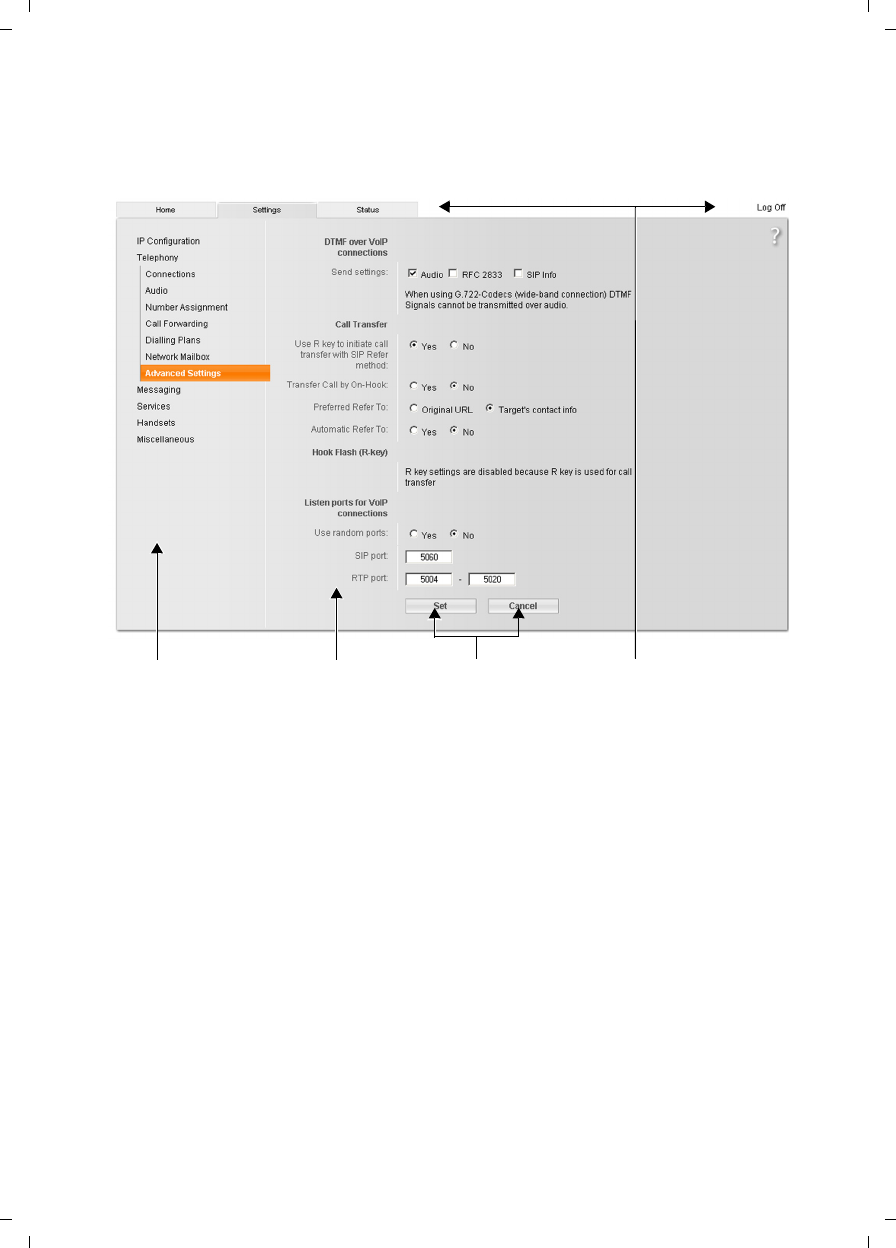
99
Setting the phone with the PC
Gigaset A580 IP / US English / A31008-xxxx-xxxx-x-xxxx / web_server.fm / 24.04.2009
Version 8, 03.09.2008
Using the Web pages
The Web pages contain the UI elements displayed in Figure 2.
Menu bar
In the menu bar, the Web configurator menus are displayed in the form of tab
pages.
The following menus are available:
Home The start screen is opened once you have registered with the Web configurator.
It contains information on the Web configurator functions.
Settings This menu allows you to make settings on your phone (£Page 102).
If you select the Settings menu, a list with this menu's functions is displayed in
the navigation area (£Page 100).
Status This menu provides you with information about your phone (£Page 140).
Log Off You will find the Log Off function to the right of the menu bar on every Web
page (£Page 98).
Figure 2 Example of the structure of a Web page
Working areaNavigation area Menu barButtons

100
Setting the phone with the PC
Gigaset A580 IP / US English / A31008-xxxx-xxxx-x-xxxx / web_server.fm / 24.04.2009
Version 8, 03.09.2008
Navigation area
In the navigation area, the functions of the menu selected in the menu bar
(£Page 99) are listed.
If you select a function, the associated page opens in the working area with
information and/or fields for your inputs.
If a function is assigned subfunctions, these are displayed with the function as
soon as you select the function. The relevant page for the first subfunction is
displayed in the working area.
Working area
Depending on the function selected, information or dialog boxes are displayed
in the working area, which allow you to make or change your phone settings.
Making changes
Settings can be changed via input fields, lists or options.
uThere may be restrictions regarding the possible values for a field, e.g. the
maximum number of characters, entering special characters or certain value
ranges.
uTo open a list, select . You can select from preset values.
uThere are two kinds of options:
– Options in a list, from which you can activate one or several options.
Active, i.e. selected options are highlighted with , non-active options
with . You can activate an option by selecting . The status of the
other options in the list does not change. You can deactivate an option by
selecting .
– Alternate options. The active option in the list is highlighted with , and
the non-active with . You can activate an option by selecting . The
previously activated option is deactivated. You can only deactivate an
option by activating another option.
Entering Cyrillic and Arabic characters
In the following, the specified maximum number of characters permitted in a
field refers to Latin characters and digits (1 character = 1 byte), i.e. 1 character
means 1 byte.
Cyrillic and Arabic characters require 2 bytes each, i.e. with a field length of
16 characters, for example, you can enter a maximum of 8 Cyrillic or Arabic
characters.
If you enter too many characters into a field, the entry will be rejected (not
saved on the base station). The "old" field content (e.g. the default settings)
remains in place and is displayed again when the web page is updated. No
warning/confirmation is given.
Please note
An overview of the Web configurator menu £Page 37.

101
Setting the phone with the PC
Gigaset A580 IP / US English / A31008-xxxx-xxxx-x-xxxx / web_server.fm / 24.04.2009
Version 8, 03.09.2008
Applying changes
As soon as you have made your change on a page, activate the new setting on
the phone by selecting Set.
If your input in a field does not comply with the rules for this field, an appropri-
ate error message is displayed. You can then repeat the input.
Buttons
Buttons are displayed in the bottom section of the working area.
Set Save entries on the phone.
Cancel Reject changes made on the Web page and reload the settings that are cur-
rently saved in your phone to the Web page.
Opening Web pages
A brief outline of the navigation to the individual Web configurator functions is
given below.
Warning
Changes that have not been saved on your phone are lost if you move to
another Web page or if the Web configurator is logged off, e.g. due to exceed-
ing the time limit (£Page 98).
Example
Setting DTMF signaling
Settings ¢Telephony ¢Advanced Settings
To open the Web page, carry out the following steps after registration:
¤Select the Settings menu in the menu bar.
¤Select the Telephony function in the navigation area.
The Telephony subfunctions are displayed in the navigation tree.
¤Click the Advanced Settings subfunction.
The Web page from Figure 2 will be shown in the Web browser.

102
Setting the phone with the PC
Gigaset A580 IP / US English / A31008-xxxx-xxxx-x-xxxx / web_server.fm / 24.04.2009
Version 8, 03.09.2008
Setting the phone with the Web configurator
You can make the following settings using the Web configurator:
uConnect your phone to the local network (£Page 103).
uConfiguration for telephony:
– Enter settings for the VoIP provider and configure or activate/deactivate
VoIP accounts (£Page 107).
– Specify the name of the fixed line network (£Page 114).
– Activate/deactivate the Gigaset.net connection (£Page 114).
– Activate/deactivate call forwarding for calls to your VoIP numbers or to
your Gigaset.net number (£Page 121).
– Configure settings to improve voice quality for the VoIP connections
(£Page 115).
– Define the default connection for your telephone (fixed line network or
VoIP) (£Page 119).
– Assign VoIP phone numbers to the individual handsets (£Page 120).
– Define user-specific dialing plans for emergency numbers and for cost
control purposes (£Page 123).
– Enter and activate/deactivate the network mailbox for each number
assigned to the telephone (£Page 125).
– Define the type of DTMF signaling (e.g. for remote operation of a VoIP
network mailbox) and the Flash key function for VoIP (£Page 126).
– Enter settings for call forwarding via VoIP (call placing, i.e. connecting
two external callers to each other, £Page 127).
uOutput of information from an IP info service on the handset (£Page 133).
uSynchronize date and time on the base station with a time server on the
Internet (£Page 139).
uStart firmware updates (£Page 137).
uManage registered handsets:
– Change names and internal numbers of the registered handsets
(£Page 133).
– Copy contacts from your PC's Outlook address book to the handset direc-
tories or save handset directories to your PC (£Page 134).
– Activate/deactivate the display of VoIP status messages on your handset
(£Page 136).

103
Setting the phone with the PC
Gigaset A580 IP / US English / A31008-xxxx-xxxx-x-xxxx / web_server.fm / 24.04.2009
Version 8, 03.09.2008
Configuring the IP
Assigning the IP address
Select the necessary settings for operating your phone in your local network
and to connect it to the Internet. For more detailed explanations of the individ-
ual components/terms, see the glossary (£Page 172).
¤Open the following Web page: Settings ¢IP Configuration.
¤In the Address Assignment area, select the IP address type.
Select Obtained automatically to use a dynamic IP address assigned by a DHCP
server in your local network. No further settings are necessary for the local net-
work.
Select Static to set up a static local IP address for your phone. A static IP address
is, for example, useful if port forwarding or a DMZ is set up on the router for
the phone.
The following fields are displayed when you select IP address type = Static:
IP address Enter an IP address for your phone. This IP address allows your phone to be
reached by other subscribers in your local network (e.g. PC).
192.168.2.2 is the default.
Please note the following:
uThe IP address must be from the address block for private use that is used in
the router. This is generally in the range 192.168.0.1 – 192.168.255.254
with Subnet mask 255.255.255.0. The subnet mask determines that the first
three parts of the IP address must be identical for all subscribers in your LAN.
uThe static IP address must not belong to the address block (IP pool range)
that is reserved for the DHCP server of the router. It must also not be used
by another device on the router.
If necessary, check the settings on the router.
Subnet mask
Enter the subnet mask for your device's IP address. For addresses from the
address block 192.168.0.1 – 192.168.255.254, the subnet mask
255.255.255.0 is generally used. This is preconfigured when the phone is sup-
plied.
Default gateway
Enter the IP address for the default gateway uses to connect the local network
to the Internet. This is generally the local (private) IP address for your router
(e.g. 192.168.2.1). Your phone requires this information to access the Internet.
192.168.2.1 is the default.

104
Setting the phone with the PC
Gigaset A580 IP / US English / A31008-xxxx-xxxx-x-xxxx / web_server.fm / 24.04.2009
Version 8, 03.09.2008
Preferred DNS server
Enter the IP address for the preferred DNS server. DNS (Domain Name System)
allows you to assign public IP addresses to symbolic names. The DNS server is
required to convert the DNS name into the IP address when a connection is
being established to a server.
You can specify your router's IP address here. The router forwards phone
address requests to its DNS server.
192.168.2.1 is the default.
Alternate DNS server (optional)
Enter the IP address for the alternate DNS server that should be used in situa-
tions where the preferred DNS server cannot be reached.
¤Select Set to save the changes.
Or
¤Select Cancel to reject the changes.
After you have changed the IP configuration the base station is rebooted. You
will be logged off by the Web configurator. The Login Web page is displayed
again after the reboot.
Allowing access from other networks
The default setting for your phone is set so that you can only access your
phone's Web configurator via a PC that is in the same local network as your
phone. The subnet mask of the PC must match that of the phone.
You can also allow access from PCs in other networks.
¤Open the following Web page: Settings ¢IP Configuration.
Area: Remote Management
¤Activate the Yes option to permit access from other networks.
To deactivate remote access, activate the No option Access is then limited to
PCs in your own local network.
Access to the Web configurator services from other networks is only possible if
your router is set accordingly. The router must pass on the service requests
from "outside" to Port 80 (default port) of the phone. Please also read the user
guide for your router.
To establish a connection, the public IP address or the DNS name of the router
and, where applicable, the port number on the router must be indicated in the
Web browser of the remote PC.
Warning
Expansion of access entitlement to other networks increases the risk of unau-
thorized access. It is therefore recommended that you deactivate remote
access again if you no longer require it.

105
Setting the phone with the PC
Gigaset A580 IP / US English / A31008-xxxx-xxxx-x-xxxx / web_server.fm / 24.04.2009
Version 8, 03.09.2008
Entering an HTTP proxy server
(only when connected to an internal company network)
Direct connections between network participants and the Internet are often
not permitted within internal company or organization networks (intranet). In
such cases, all HTTP calls from the network are "transferred" by a proxy server.
The proxy server is a computer or program within the network.
If your phone is connected to such a network, you must store the address of this
HTTP proxy server on the phone and activate handling of HTTP calls via the
HTTP proxy server.
Only then will you be able to access, for example, the Gigaset.net directory or
obtain weather information, etc. in idle display (information services).
¤Open the following Web page: Settings ¢IP Configuration.
Area: HTTP proxy
Enable proxy
Click the Yes option if your phone is to handle HTTP calls via your network's
HTTP proxy server.
If you select No, the phone attempts to access the Internet directly.
Proxy server address
Enter the URL (£Page 183) of the proxy server to which your phone is to send
HTTP calls. The proxy server then creates the connection to the Internet.
Proxy server port
Specify the communication port used on the HTTP proxy server (number
between 0 and 55000). Port 80 is usually assigned.
¤Select Set to save your settings.
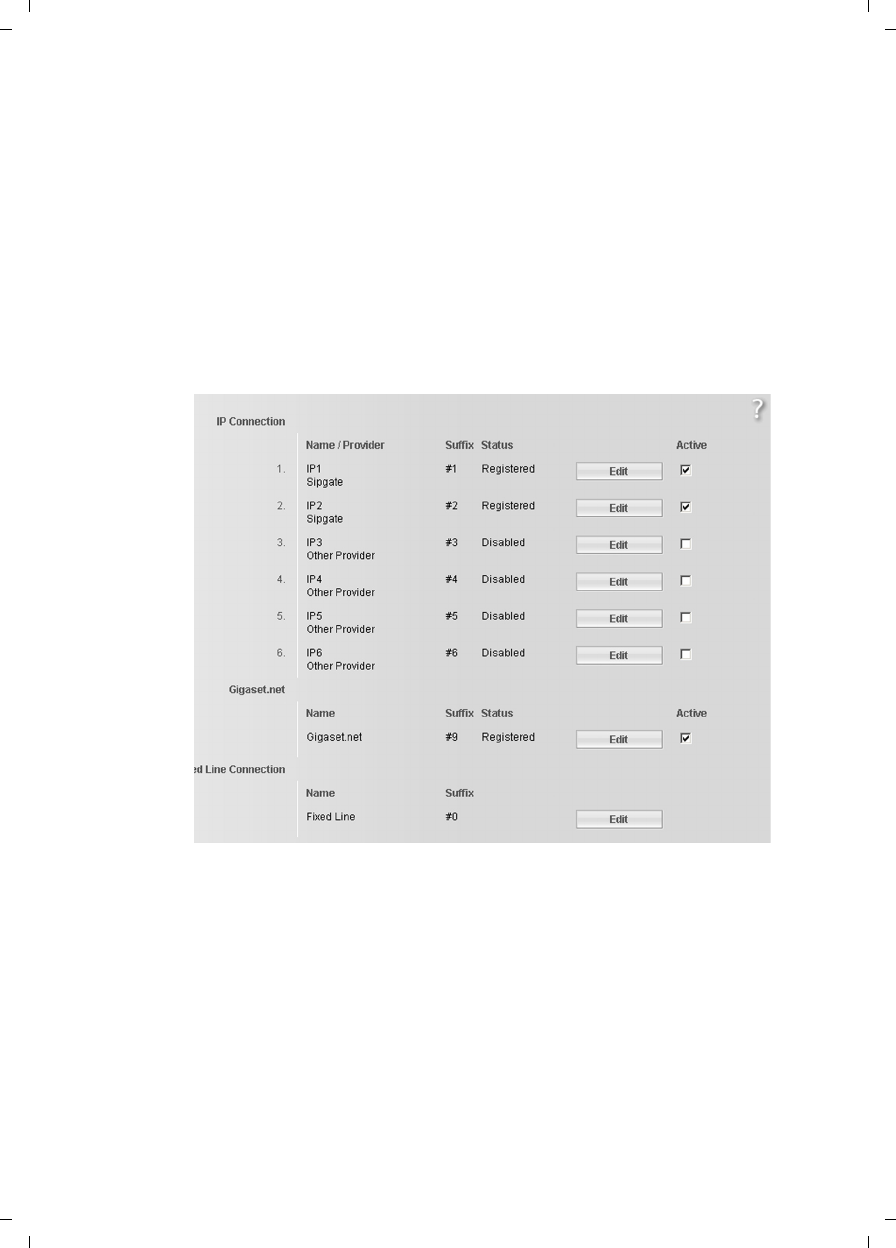
106
Setting the phone with the PC
Gigaset A580 IP / US English / A31008-xxxx-xxxx-x-xxxx / web_server.fm / 24.04.2009
Version 8, 03.09.2008
Configuring telephone connections
You can configure up to eight numbers on your phone: your fixed line network
number, your Gigaset.net number and six VoIP numbers.
You need to set up a VoIP account with a VoIP provider for each VoIP phone
number. You must save the access data for each account and for the relevant
VoIP provider in the phone. You can assign a name to each connection (VoIP
and fixed line network).
To configure the connections:
¤Open the following Web page: Settings ¢Telephony ¢Connections.
A list (£Figure 3) will be shown containing all the possible connections that
you can configure, or have already configured, on your phone.
The list will show the following:
Name / Provider
Name of the connection. This will show the name that you have defined for the
connection (£Page 108, Page 114) or the default name (IP1 to IP6 for VoIP
connections, Fixed Line for the fixed line network connection and Gigaset.net).
VoIP connections also display the name of the VoIP provider with which you
have opened the account. If the name is unknown the display will show Other
Provider.
Figure 3 List of possible connections

107
Setting the phone with the PC
Gigaset A580 IP / US English / A31008-xxxx-xxxx-x-xxxx / web_server.fm / 24.04.2009
Version 8, 03.09.2008
Suffix Line suffix that you have to add to the phone number of an outgoing call to
allow the account assigned to the suffix to be used as the sending account.
Status The status of the connection will be shown for VoIP connections:
Registered
The connection is activated. The phone has been successfully registered.
You can use the connection to make calls.
Disabled
The connection is deactivated. The phone is not registering with the corre-
sponding account with the VoIP service. You cannot use the connection to
make or receive calls.
Registration failed / Server not accessible
Your phone was unable to register with the VoIP service, e.g. because the
VoIP access data is incorrect or incomplete or the phone is not connected to
the Internet. You can find further information in section "Getting help with
your phone", £Page 141.
Active You can use the option in the Active column to activate ( ) and deactivate ( )
VoIP connections. If a connection is deactivated, the phone will not register for
this connection. The connection can be activated/deactivated by clicking
directly on the option. The change does not need to be saved.
To configure a connection or to change the configuration of a connection:
¤Select Edit button next to the connection.
This will open a Web page where you can make the settings needed. More
information is available
uIn the section "Configuring the VoIP connection", £Page 107 or
uIn the section "Configuring the fixed line connection", £Page 114 or
uIn the section "Configuring the Gigaset.net connection", £Page 114.
Configuring the VoIP connection
¤Open the following Web page: Settings ¢Telephony ¢Connections.
¤Select the Edit button next to the VoIP connection that you want to configure
or the configuration you wish to change.
This will open a Web page where you can make the settings that your phone
needs to access your provider's VoIP server.
The Web page always displays the following areas:
uIP Connection (£Page 108),
uAuto Configuration (£Page 108)
Example
If you dial 123456765#1, the connection will be made and billed through the
first VoIP account, regardless of the VoIP number you have assigned to your
handset as the send number and whether you briefly press/press and hold the
Talk key.
If you dial 123456765#0, the connection will be made via the fixed line net-
work.

108
Setting the phone with the PC
Gigaset A580 IP / US English / A31008-xxxx-xxxx-x-xxxx / web_server.fm / 24.04.2009
Version 8, 03.09.2008
uPersonal Provider Data (£Page 110).
The areas
uGeneral Provider Data (£Page 111) and
uNetwork (£Page 111)
can be shown and hidden by selecting the Show Advanced Settings and Hide
Advanced Settings buttons.
You must enter the VoIP provider's general access data in these areas. You can
download this data for many VoIP providers from the Internet ( £ "Area: Auto
Configuration", Page 108).
¤Make the settings on the Web page.
¤Save them in the phone £Page 113.
¤Activate the connection if necessary £Page 114.
Area: IP Connection
Connection Name or Number
Enter a name for the VoIP connection or the VoIP phone number (maximum
16 characters). This name is used to display the connection on the handset and
the Web configurator interface, e.g. during allocation of send and receive num-
bers (£Page 120), for the call display (£Page 42).
Area: Auto Configuration
The entire configuration process or a large part of the configuration for a VoIP
connection is automated for many VoIP providers. You can download the nec-
essary VoIP access data to your phone from the Internet.
You have the following options:
uFully automated configuration
Prerequisites:
– You have received an auto configuration code from your VoIP provider.
– The general access data for your VoIP provider is available for download-
ing.
You can download all the data required for VoIP access from the Internet:
¤Enter the auto configuration code you received from your VoIP provider
in the Auto Configuration area in the Auto Configuration Code field (maxi-
mum 32 characters).
¤Select the Start Auto Configuration button.
The telephone establishes a connection to the Internet and downloads all
data required for the VoIP connection, i.e. the general provider information
and your personal provider data (account data) are saved to your base sta-
tion.
If you have already entered details on the Web page, this is deleted as soon
as Start Auto Configuration is selected. The fields in the Personal Provider Data
and General Provider Data areas and the server addresses in the Network area
are overwritten by the downloaded data.

109
Setting the phone with the PC
Gigaset A580 IP / US English / A31008-xxxx-xxxx-x-xxxx / web_server.fm / 24.04.2009
Version 8, 03.09.2008
Generally, you should not have to enter any additional data on this Web
page.
When the download is complete, the Connections list is displayed.
¤Activate the connection as described on Page 114.
You can then be reached on the corresponding VoIP phone number.
uAutomatic configuration of general VoIP provider data
Prerequisite: You have received your account details from your VoIP pro-
vider (e.g. Authentication Name, Authentication password).
Profile files for the most important VoIP providers are available to download
from the Internet via the Gigaset configuration server. The address for the
server is stored in your phone (£Page 137).
To load the data onto your telephone, proceed as follows:
¤Select Select VoIP Provider in the Auto Configuration area. This will display
information on the download procedure.
The download procedure consists of several steps:
¤Select the Next button.
¤From the list, select the country for which the list of VoIP providers is to
be loaded.
¤Select the Next button.
¤Select your VoIP provider from the list.
If your provider is not included in the list, select Other Provider. In this case
you will have to enter the general provider data by hand (see "Area: Gen-
eral Provider Data" and "Area: Network" below).
¤Select the Finish button.
The details of the selected provider are loaded to your phone and saved
under General Provider Data (£Page 111) and Network (£Page 111). You
cannot make any further entries in these areas.
Please note
If the message Download of settings not possible! File is corrupt! appears, no
data will be loaded onto the phone. Possible causes of this are:
uThe incorrect code has been entered (e.g. upper/lower case rules have
not been followed). If necessary, enter the code again.
uThe file that has been downloaded is invalid. Please consult your VoIP
provider.
Please note
If you select the Select VoIP Provider button, any changes that have been
made to the Web page will be saved and checked. Values may need to be
corrected before the Select VoIP Provider operation is started.
Please note
If only one provider is available, the countries and providers lists are not
displayed. The name of the provider is then displayed directly.

110
Setting the phone with the PC
Gigaset A580 IP / US English / A31008-xxxx-xxxx-x-xxxx / web_server.fm / 24.04.2009
Version 8, 03.09.2008
The Provider field shows the name of the selected provider or Other Provider.
A link to the provider's homepage is displayed where available.
To complete configuration of your VoIP connection, enter your account data
in the Personal Provider Data area.
Area: Personal Provider Data
Enter the configuration data that is necessary for accessing your VoIP provider's
SIP service. This data can be obtained from your VoIP provider.
The field names in this area (Authentication Name, etc.) listed in the following are
standard names and may change. If you have already downloaded the pro-
vider's general details ("Select VoIP Provider" button, see above), field entries will
be replaced by provider-specific names to facilitate orientation (e.g. SIP-ID
instead of Authentication Name).
Authentication Name
Specify the registration or authentication ID agreed with your VoIP provider
(maximum 32 digits). The registration ID serves as the access ID that your
phone must specify when registering with the SIP proxy/registrar server. The
Authentication Name is usually identical to the Username, i.e. to your Internet
phone number.
Authentication password
Enter the password that you have agreed with your VoIP provider in the Authen-
tication password field (maximum 32 characters). The phone needs the pass-
word when registering with the SIP proxy/registrar server.
Username Enter the caller ID for your VoIP provider account (maximum 32 characters).
This ID is usually identical to the first part of your SIP address (URI, your Internet
phone number).
Display name (optional)
Enter any name that should be shown in the other caller's display when you call
them via the Internet (example: Anna Sand). All characters in the UTF8 charac-
ter set (Unicode) are permitted. The name must not exceed 32 characters.
If you do not enter a name, your Username or your VoIP phone number is dis-
played.
Ask your VoIP provider if this feature is supported.
Please note
After the first download of the VoIP provider settings, your phone will check
daily whether a newer version of the file for your VoIP provider is available via
the Internet on the Gigaset configuration server (£Page 90).
Example
Example: If your SIP address is "987654321@provider.com", enter
"987654321" as the Username.

111
Setting the phone with the PC
Gigaset A580 IP / US English / A31008-xxxx-xxxx-x-xxxx / web_server.fm / 24.04.2009
Version 8, 03.09.2008
Area: General Provider Data
If you have downloaded the general settings for the VoIP provider from the
Gigaset configuration server (£Page 108), then the fields in this area will be
preset with the data from the download. Generally, you do not need to config-
ure any settings in this area.
Domain Specify the last part of your SIP address (URI) here (maximum 74 characters).
Proxy server address
The SIP proxy is your VoIP provider's gateway server. Enter the IP address or the
(fully-qualified) DNS name of your SIP proxy server (maximum 74 characters).
Example: myprovider.com.
Proxy server port
Enter the number of the communication port that the SIP proxy uses to send
and receive signaling data (SIP port).
Port 5060 is used by most VoIP providers.
Registrar server
Enter the (fully-qualified) DNS name or the IP address of the registrar server
(maximum 74 characters).
The registrar is needed when the phone is registered. It assigns the public IP
address/port number to your SIP address (Username@Domain) used by the
phone to log in. With most VoIP providers, the registrar server is identical to the
SIP server. Example: reg.myprovider.com.
Registrar server port
Enter the communication port used in the registrar. Usually, port 5060 is used.
Registration refresh time
Enter the time intervals at which the phone should repeat the registration with
the VoIP server (SIP proxy) (a request will be sent to establish a session). The
repeat is required so that the entry of the phone in the tables of the SIP proxy
is retained and the phone can therefore be reached. The repeat will be carried
out for all activated VoIP phone numbers.
The default is 180 seconds.
If you enter 0 seconds, the registration will not be repeated periodically.
Area: Network
Example
For the SIP address "987654321@provider.com", enter "provider.com" in
Domain.
Please note
If you have downloaded the general settings for your VoIP provider from the
Gigaset configuration server (£Page 109), then some fields in this area will
be preset with the data from the download (e.g. the settings for the STUN
server and outbound proxy).

112
Setting the phone with the PC
Gigaset A580 IP / US English / A31008-xxxx-xxxx-x-xxxx / web_server.fm / 24.04.2009
Version 8, 03.09.2008
If your phone is connected to a router with NAT (Network Address Translation)
and/or a firewall, you must select some settings in this area so that your phone
can be reached from the Internet (i.e. can be addressed).
Through NAT, the IP addresses of subscribers in the LAN are concealed behind
the public IP address of the router.
For incoming calls
If port forwarding is activated or a DMZ is set up for the phone on the router,
no special settings are required for incoming calls.
If this is not the case, an entry in the NAT routing table (in the router) is neces-
sary in order for the phone to be reached. This entry is created when the phone
is registered with the SIP service. In the interest of security, this entry is auto-
matically deleted at certain intervals (session timeout). The phone must there-
fore confirm its registration at certain intervals (see NAT refresh time,
£Page 113), so that the entry stays in the routing table.
For outgoing calls
The phone needs its public address to receive caller voice data.
There are two possibilities:
uThe phone requests the public address from a STUN server on the Internet
(Simple Transversal of UDP over NAT). STUN can only be used with asymmet-
ric NATs and non-blocking firewalls.
uThe phone does not direct the connection request to the SIP proxy but to an
outbound proxy on the Internet that supplies the data packets along with
the public address.
The STUN server and outbound proxy are used alternately to work around the
NAT/firewall in the router.
STUN enabled
Select Yes if you want your phone to use STUN as soon as it is used on a router
with asymmetric NAT.
STUN server
Enter the (fully-qualified) DNS name or the IP address of the STUN server on the
Internet (maximum 74 characters).
If you selected Yes in the STUN enabled field, you must enter a STUN server here.
STUN port Enter the number of the communication port on the STUN server. The default
port is 3478.
STUN refresh time
Enter the time intervals at which the phone should repeat the registration with
the STUN server. The repeat is required so that the entry of the phone in the
tables of the STUN server is retained. The repeat will be carried out for all acti-
vated VoIP phone numbers.
Ask your VoIP provider for the STUN refresh time.
The default is 240 seconds.
If you enter 0 seconds, the registration will not be repeated periodically.

113
Setting the phone with the PC
Gigaset A580 IP / US English / A31008-xxxx-xxxx-x-xxxx / web_server.fm / 24.04.2009
Version 8, 03.09.2008
NAT refresh time
Specify the intervals at which you want the phone to update its entry in the
NAT routing table. Specify an interval in seconds that is a little shorter than the
NAT session timeout.
You should not need to change the preconfigured value for the NAT refresh time.
Outbound proxy mode
Specify when the outbound proxy should be used.
Always
All signaling and voice data sent by the phone is sent to the outbound proxy.
Auto
Data sent by the phone is only sent to the outbound proxy when the phone
is connected to a router with symmetric NAT or blocking firewall. If the
phone is behind an asymmetric NAT, the STUN server is used.
If you have set STUN enabled = No or have not entered a STUN server, the out-
bound proxy is always used.
Never
The outbound proxy is not used.
If you do not make an entry in the Outbound proxy field, the phone behaves
independently of the selected mode, as with Never.
Outbound proxy
Enter the (fully qualified) DNS name or the IP address of your provider's out-
bound proxy (maximum 74 characters).
Outbound proxy port
Enter the number of the communication port used by the outbound proxy.
The default port is 5060.
Saving settings on the phone
¤Select Set to save the changes.
The Connections list will be shown after saving (£Figure 3 on Page 106).
To discard the changes:
¤Select the Cancel button.
If all fields are to be reset to the default settings:
¤Select the Delete button.
Fields without default settings are empty.
Please note
With many providers, the outbound proxy is identical to the SIP proxy.

114
Setting the phone with the PC
Gigaset A580 IP / US English / A31008-xxxx-xxxx-x-xxxx / web_server.fm / 24.04.2009
Version 8, 03.09.2008
Activating a new connection
If you have configured a new VoIP connection, you must also activate it.
In the Connections list:
¤Activate the relevant option in the Active column ( = activated).
Your phone will register itself with the VoIP provider using the relevant access
data. Refresh the Web page (e.g. by pressing F5).
The Status Registered column will appear if registration was successful. You can
now be reached on this VoIP phone number.
Configuring the fixed line connection
You can assign a name to your fixed line connection. This name is used to dis-
play the connection on the handset and the Web configurator interface, e.g.
during allocation of send and receive numbers (£Page 120), for the call dis-
play (£Page 42).
¤Open the following Web page: Settings ¢Telephony ¢Connections.
¤Select the Edit button in the Fixed Line Connection area.
¤Enter your fixed line network number or the name of your choice
(maximum 16 characters) for your fixed line connection in the Connection
Name or Number field. The default is "Fixed Line".
Configuring the Gigaset.net connection
Your phone is assigned a Gigaset.net phone number by default. As soon as you
have connected your phone to the Internet, you can make calls using the
Gigaset.net and receive calls from other Gigaset.net subscribers, provided that
your Gigaset.net connection has been activated. You can deactivate the
Gigaset.net connection.
Activating/deactivating the Gigaset.net connection
¤Open the following Web page: Settings ¢Telephony ¢Connections. The list
of connections is displayed (£Figure 3 on Page 106).
¤In the Gigaset.net area: use the option in the Active column to activate ( )
or deactivate ( ) the Gigaset.net connection.
Please note
If you do not make any entries for a longer period, the connection to the Web
configurator is automatically terminated. Unsaved entries are lost. If neces-
sary, save intermittently. You can subsequently continue the entry and make
changes if necessary.
Please note
Once the new entry has been made, the VoIP phone number is assigned to
each handset as a receive number. For adjusting the assignment,
£Page 120.

115
Setting the phone with the PC
Gigaset A580 IP / US English / A31008-xxxx-xxxx-x-xxxx / web_server.fm / 24.04.2009
Version 8, 03.09.2008
Activating/deactivating the STUN server of the Gigaset.net connection
The Gigaset.net connection is preconfigured in your phone. The Gigaset.net
uses a STUN server as standard. In the sent data packets, Gigaset.net replaces
the private IP address of your phone with its public IP address.
If you operate your phone behind a router with symmetrical NAT, STUN cannot
be used. Otherwise, when making Gigaset.net calls you will not be able to hear
the caller.
In this case, deactivate STUN for the Gigaset.net connection.
¤Open the following Web page: Settings ¢Telephony ¢Connections.
¤Select Edit in the Gigaset.net area.
STUN enabled
Click No to deactivate STUN.
Select Yes if you want your phone to use STUN.
¤Select Set to save the changes.
Optimizing voice quality for VoIP connections
You can make general and connection-specific settings to improve the voice
quality for VoIP telephony.
¤Open the following Web page: Settings ¢Telephony ¢Audio.
The voice quality for VoIP connections is mainly determined by the voice codec
used for transferring the data and the available bandwidth of your DSL con-
nection.
In the case of the voice codec, the voice data is digitalized (coded/decoded) and
compressed. A "better" codec (better voice quality) means more data needs to
be transferred, i.e. perfect voice data transfer requires a DSL connection with a
larger bandwidth.
The following voice codecs are supported by your phone:
G.722 Excellent voice quality. The broadband speech codec G.722 works at the same
bit rate as G.711 (64 kbit/s per speech connection) but with a higher sampling
rate. This allows higher frequencies to be played back. The speech tone is there-
fore clearer and better than for the other codecs (High Definition Sound Per-
formance).
Gigaset S67H, S68H and SL37H are examples of HDSP-compatible handsets.
Please note
If you do not use your Gigaset.net connection for six weeks, it is automatically
deactivated. You cannot be reached for calls from Gigaset.net.
The connection is reactivated:
uAs soon as you start a search in the Gigaset.net directory (£Page 48) or
uMake a call via Gigaset.net, i.e. dial a number ending in #9 (two attempts
may be necessary) or
uActivate the connection via the Web configurator as described above.

116
Setting the phone with the PC
Gigaset A580 IP / US English / A31008-xxxx-xxxx-x-xxxx / web_server.fm / 24.04.2009
Version 8, 03.09.2008
G.711 a law / G.711 µ law
Excellent voice quality (comparable with ISDN). The necessary bandwidth is 64
kbit/s per voice connection.
G.726 Good voice quality (inferior to that with G.711 but better than with G.729).
Your phone supports G726 with a transmission rate of 32 kbit/s per voice con-
nection.
G.729 Average voice quality. The necessary bandwidth is less than or equal to 8 kbit/
s per voice connection.
Both parties involved in the telephone connection (caller/sender and recipient
side) must use the same voice codec. The voice codec is negotiated between
the sender and the recipient when establishing a connection.
You can influence the voice quality by selecting (bearing in mind the band-
width of your DSL connection) the voice codecs your phone is to use, and spec-
ifying the order in which the codecs are to be suggested when a VoIP connec-
tion is established.
Area: Settings for Bandwidth
The settings in this area influence all VoIP connections (VoIP phone numbers).
Allow 1 VoIP call only
You can usually make two VoIP calls at the same time on your phone. If, how-
ever, your DSL connection has a narrow bandwidth, there may be problems if
two VoIP calls are made at the same time. The data is no longer transferred
properly (long voice delay, data losses, etc.).
¤Select Yes after Allow 1 VoIP call only to prevent any further parallel VoIP
phone connections being established.
¤If you wish to permit two VoIP connections, select No.
Voice Quality
Default settings for the codecs used are stored in your phone: one setting opti-
mized for narrow and one for wide bandwidths.
¤Activate one of the options Optimized for low bandwidth / Optimized for high
bandwidth if you wish to accept a default setting for all VoIP connections. The
settings are shown in the Settings for Connections area and cannot be
changed.
¤Activate the Own Codec preference option if you wish to select and set connec-
tion-specific voice codecs yourself ( ¢"Area: Settings for Connections").
Please note
If only one VoIP connection is permitted, the following VoIP network services
will no longer be available:
uCall waiting is not displayed during a call via VoIP.
uExternal consultation call from a VoIP call
uToggling and initiating a conference call via VoIP

117
Setting the phone with the PC
Gigaset A580 IP / US English / A31008-xxxx-xxxx-x-xxxx / web_server.fm / 24.04.2009
Version 8, 03.09.2008
Area: Settings for Connections
In this area you can make specific settings for each of your VoIP phone num-
bers.
You can make the following settings for each VoIP phone number configured
on your phone:
Volume for VoIP Calls
Depending on the VoIP provider, it is possible that the received voice/earpiece
volume is too low or too high, so that adjusting the volume via the handset is
not adequate.
Specify whether the received volume range is too high or too low. The follow-
ing options are available:
Low
Voice/earpiece volume is too high. Activate this option to reduce the volume
by 6 dB.
Normal
The voice/earpiece volume does not need to be raised/lowered.
High
Voice/earpiece volume is too low. Activate this option to increase the vol-
ume by 6 dB.
Voice codecs
Prerequisite: The Own Codec preference option is activated for the Voice Quality
in the Settings for Bandwidth area.
Select the voice codecs your phone is to use, and specify the order in which the
codecs are to be suggested when a VoIP connection is established via this VoIP
phone number.
¤Apply the voice codecs that your phone is to suggest for outgoing calls into
the Selected codecs list.
To do this, in the Available codecs list select the voice codec that you want to
apply (you can mark several entries using the Shift key or the Ctrl key).
Select <Add.
¤Move the voice codecs that you do not want the phone to use into the
Available codecs list.
Select the voice codecs in the Selected codecs list (see above) and click the
Remove> button.
¤Sort the voice codecs in the Selected codecs list into the order in which they
should be suggested to the receiving device when a connection is estab-
lished. To do this, use the Up and Down buttons.
When establishing a VoIP connection, the phone suggests the 1st voice codec
in the Selected codecs list to the receiving device to begin with. If the receiving
device does not accept this voice codec (e.g. because it is not supported), the
2nd voice codec on the list is suggested, and so on.
If the receiving device does not accept any of the voice codecs in the Selected
codecs list, the connection is not established. An appropriate message is dis-
played on the handset.

118
Setting the phone with the PC
Gigaset A580 IP / US English / A31008-xxxx-xxxx-x-xxxx / web_server.fm / 24.04.2009
Version 8, 03.09.2008
If the phone always starts by trying to establish a broadband connection, put
the G.722 codec at the top of the Selected codecs list.
Area: Settings for Codecs
To save additional bandwidth and transmission capacity, on VoIP connections
that use the G.729 codec you can suppress the transmission of voice packets in
pauses ("Silence Suppression"). Then, instead of the background noises in your
environment, your caller hears a synthetic noise generated in the receiver.
Please note: "Silence Suppression" can sometimes lead to deterioration in the
voice quality.
¤In the Enable Annex B for codec G.729 field, state whether the transmission of
data packets during pauses should be suppressed when using the G.729
codec, (select Yes).
Saving settings on the phone
¤Select Set to save the settings for the voice quality.
Voice quality and infrastructure
With your Gigaset A580 IP, you have the opportunity to make calls with good
voice quality via VoIP.
However, your phone's performance with VoIP – and therefore the voice quality
– also depends on the properties of the entire infrastructure.
The following VoIP provider components are just some of the things that can
impact performance:
uRouter
uDSLAM
uDSL transmission line and speed
uConnection paths over the Internet
uIf applicable, other applications that also use the DSL connection
Please note
uOnly deactivate codecs (put them in the Available codecs list) if there is a par-
ticular reason. The more codecs that are deactivated increases the risk of
calls not being established due to unsuccessful codec negotiations. In par-
ticular you can only establish broadband connections if you permit the
G.722 codec.
uWith incoming calls, all supported voice codecs are always permitted.
Please note
Please observe the following for good voice quality:
uWhen making calls using VoIP, avoid performing other Internet activities
(e.g. surfing the Internet).
uPlease note that voice delays can occur depending on the codec used and
the network capacity utilization.

119
Setting the phone with the PC
Gigaset A580 IP / US English / A31008-xxxx-xxxx-x-xxxx / web_server.fm / 24.04.2009
Version 8, 03.09.2008
In VoIP networks, voice quality is affected by various things including the "Qual-
ity of Service" (QoS). If the entire infrastructure demonstrates QoS, voice qual-
ity is higher (fewer delays, less echoing, less crackling, etc.).
If, for example, the router does not have QoS, then the voice quality is not as
good. Please see the specialist documentation for further information.
Setting the telephone's default connection
The default telephone connection defines which line type (VoIP or fixed line
network) will be used to dial numbers when you briefly press the c Talk key.
The default connection is applied to all registered handsets.
¤Open the following Web page: Settings ¢Telephony ¢Number Assignment.
Area Default Connection
¤Select the default connection for your phone. This can be done by selecting
option VoIP or Fixed Line after Linetype for outgoing calls.
¤Select Set to activate your settings.
Activating the fixed line network connection as an alternate
connection
You can activate the fixed line network connection on your phone as an alter-
nate connection. If an attempt to establish a connection via VoIP then fails, an
attempt is made automatically to establish the connection via the fixed line
network.
An alternate connection would be used in the following cases:
uYour VoIP connections are busy.
uThe SIP server for the VoIP connection cannot be accessed.
uThe dialed VoIP connection has not (yet) been configured correctly
(e.g. incorrect password).
uThe base station does not have a connection to the Internet, e.g. because
your router is deactivated or not connected to the Internet.
¤Open the following Web page: Settings ¢Telephony ¢Number Assignment.
Please note
uThe default connection is only relevant when dialing numbers that are not
subject to dialing plans and are entered without a line suffix.
uYou can change the settings for the default connection via any registered
handset (£Page 86).
Exceptions
If a URI or IP address is dialed instead of a phone number, the connection can-
not be created via the fixed line network.

120
Setting the phone with the PC
Gigaset A580 IP / US English / A31008-xxxx-xxxx-x-xxxx / web_server.fm / 24.04.2009
Version 8, 03.09.2008
Area Default Connection
¤To activate the fixed line network connection as an alternate connection,
click the Yes option next to Automatic Fallback to Fixed Line. Select No to deac-
tivate the function.
¤Select Set to activate your settings.
Assigning send and receive numbers to handsets
You can assign up to eight phone numbers on your phone: your fixed line net-
work number, your Gigaset.net number and six VoIP numbers.
You can assign as many of these numbers as you like to each handset as receive
numbers. Receive numbers determine which handset(s) will ring when a call is
received.
You can assign one of your VoIP numbers to each handset as a (VoIP) send
number. Send numbers define which VoIP account should be used generally to
make and pay for outgoing VoIP calls. Exceptions:
uA phone number is dialed with a line suffix (£Page 107) or
uA dialing plan has been defined for the phone number (£Page 123).
The Gigaset.net number and fixed line network number are permanently
assigned to each registered handset as send numbers.
¤Open the following Web page: Settings ¢Telephony ¢Number Assignment.
The display shows all registered handsets. A list is displayed for each handset
showing the phone numbers that are configured and activated for the phone.
The connection names are shown in the column Connections. The fixed line net-
work connection is always at the end of the list.
¤Define a VoIP phone number as the send number for each handset. To do
this, click the option following the phone number in the for outgoing calls col-
umn. The previous assignment will automatically be deactivated.
Please note
A handset is assigned the following numbers after it is registered on the base
station:
uReceive numbers: all phone numbers assigned to the phone (fixed line net-
work, Gigaset.net and VoIP).
uSend numbers: the fixed line network number and the VoIP phone number
that you entered at the start of the phone configuration.
Please note
The fixed line network number is permanently assigned to each handset as a
send number. This assignment cannot be deactivated. It ensures that emer-
gency numbers can be called from every handset.
The Gigaset.net number is also permanently assigned to each handset.

121
Setting the phone with the PC
Gigaset A580 IP / US English / A31008-xxxx-xxxx-x-xxxx / web_server.fm / 24.04.2009
Version 8, 03.09.2008
¤Select the phone numbers for each handset (fixed line network, VoIP) that
are to be assigned to the handset as receive numbers. To do this, click the
option following the phone number in the for incoming calls column. Every
handset can be assigned several phone numbers or no phone number
(=assigned).
¤Select Set to save your settings.
Activating Call Forwarding for VoIP connections
You can forward calls to your VoIP numbers and to your Gigaset.net number.
You can forward calls to your VoIP numbers to any external number (VoIP, fixed
line or mobile network number). The forwarding is done via a VoIP connection.
You can forward calls to your Gigaset.net number within the Gigaset.net, i.e. to
another Gigaset.net number.
You can define if and when calls to your Gigaset.net number and some of your
VoIP numbers (VoIP account) should be forwarded to this VoIP number.
You can also use the handset to set and activate/deactivate call forwarding,
£Page 53.
¤Open the following Web page: Settings ¢Telephony ¢Call Forwarding.
The display shows a list of all your configured VoIP connections and your
Gigaset.net number.
Connections
Select the name you have assigned to the VoIP number, or select Gigaset.net.
When Select when a call to this VoIP number should be forwarded: When busy / No reply
/ Always. Select Off to deactivate call forwarding.
Call number Enter the phone number to which the calls should be forwarded. Please note
that you may have to enter the area code when forwarding to a fixed line
network number in the same area (depending on your VoIP provider and the
setting for the automatic area code £Page 122).
The settings only affect the phone number selected in Connections.
Please note
uIf a VoIP phone number that has been assigned to a handset as a send
number is deleted, the handset will automatically be assigned the first con-
figured VoIP phone number.
uCalls made to a number that is not assigned to a handset as a receive
number will not be signaled on any handset.
uIf you have not assigned receive numbers to any of the handsets, calls to all
connections will be signaled on all handsets.

122
Setting the phone with the PC
Gigaset A580 IP / US English / A31008-xxxx-xxxx-x-xxxx / web_server.fm / 24.04.2009
Version 8, 03.09.2008
Entering your own area code, activating/deactivating an automatic
area code for VoIP
On the base station, save the complete code (with international code) for the
area in which you are using the phone.
For VoIP calls you must generally always dial the area code – even for local calls.
You can save the need to dial the area code for local calls by setting your phone
to prefix this code for all VoIP calls made in the same local area ( £Predial area
code for local calls through VoIP option).
For calls made via VoIP, the area code entered is then prefixed to all numbers
that do not start with 0 – even when dialing numbers from the directory and
other lists.
Exceptions: Phone numbers for which you have defined dialing plans and
deactivated the Use Area Codes option (£Page 123).
When making calls via the fixed line network, the area code entered is with-
held, e.g. when dialing using the Calls list (£Page 61).
¤Open the following Web page: Settings ¢Telephony ¢Dialling Plans.
Area Area Codes
Make the following settings here:
¤From the Country list, select the country in which you are using your phone.
This way the country code and the prefix of the area code are automatically
set (in International Prefix / Area Code and Local Prefix fields).
¤In the Local Area Code field, enter the area code for your town/city without a
prefix (maximum 8 characters 0–9, *, #, R, P, r, p), e.g. 617 (for Boston).
¤Select Yes next to Predial area code for local calls through VoIP to activate the
function.
Select No to deactivate the function. You will then need to enter the area
code for local calls made via VoIP. Numbers in the directory must always
contain the area code when dialing via VoIP.
¤Select Set to save the settings.
Please note
For information on entering your area code via the handset, £Page 87.
Please note
uThe area code will also be prefixed to VoIP calls made to emergency
numbers if there are no defined dialing plans for these numbers.
uThe numbers of your network mailbox saved in the base station are not
prefixed with an area code (£Page 125).

123
Setting the phone with the PC
Gigaset A580 IP / US English / A31008-xxxx-xxxx-x-xxxx / web_server.fm / 24.04.2009
Version 8, 03.09.2008
Defining dialing plans – cost control
You can define dialing plans to reduce costs:
uYou can define the connection (one of your VoIP accounts, the fixed line
network) through which calls to specific numbers should be made and paid
for.
If you enter just a few digits (e.g. local area, national or cellular network
code) any call to a number beginning with these digits will be made via the
elected connection.
uYou can block specific numbers, i.e. your phone will not establish a connec-
tion to these numbers (e.g. 1900 numbers).
These dialing plans apply to all registered handsets. The settings for the default
connection (briefly press/press and hold c) and the send numbers of hand-
sets do not apply to numbers governed by a dialing plan.
Tips:
uCompare the rates for long-distance calls (especially for international calls)
offered by your fixed line network and VoIP providers, and determine which
connection should be used specifically for these countries/locations, e.g. a
dialing plan for the Phone Number "01133" would apply to every call made to
France.
uUse dialing plans to define that numbers starting with a call-by-call number
are always made via your fixed line network connection. To do so, enter the
call-by-call number in the Phone Number field.
Defining dialing plans
¤Open the following Web page: Settings ¢Telephony ¢Dialling Plans.
Area Dialling Plans
Specify dialing plans for your phone. Specify the following:
Phone Number
Enter the number or the first digits of the phone number (e.g. an area code) to
which the dialing plan should apply (maximum 15 digits).
Use Area Codes
Activate this option if the area code is to be added automatically for all calls via
VoIP for the phone number in Phone Number or all phone numbers that begin
with the digits in Phone Number (£Page 122).
Please note
You can override dialing plans, with the exception of blocks, as follows:
uDial the number with a line suffix (e.g. 123456789#3, £Page 38).
uBefore entering the number, define another connection type by pressing
the §Phone§ or §IP§ Display key (£Page 79).
If, for example, you press §Phone§, the number will be dialed via the fixed line
network, even if the dialing plan states that a VoIP connection should be
used.

124
Setting the phone with the PC
Gigaset A580 IP / US English / A31008-xxxx-xxxx-x-xxxx / web_server.fm / 24.04.2009
Version 8, 03.09.2008
Connection Type
The list shows all the VoIP connections that you have configured as well as your
fixed line network connection. It also displays the name assigned to each con-
nection.
¤From the list, select the connection via which the number or numbers that
start with the specified sequence of digits should be dialed.
Or:
¤Select Block if the number or numbers that start with the sequence of digits
should be blocked.
The display will show Not possible! if an attempt is made to dial a blocked
number.
Comment (optional)
You can enter a description of the dialing plan here (maximum of 20 charac-
ters).
¤Select Add.
The dialing plan is activated immediately.
A new empty line for a new dialing plan will appear if your phone still has
enough space to add further plans.
Activating/deactivating dialing plans
¤Select the option in the Active column to activate/deactivate the correspond-
ing dialing plan ( = activated).
A deactivated dialing plan will not take effect until it is reactivated.
Please note
If dialing plans overlap, the one with the greatest concordance will apply.
Example:
There is a dialing plan for the number "21" and one for the number "217". If
you dial "2171..." the second plan will apply; if you dial "2101..." the first plan
will apply.
Example
uYou want to block your phone for all 1900 numbers.
Dialing plan:
Phone Number = 0190 Connection Type =Block
uAll calls to the cellular phone network should be made via your VoIP connec-
tion with provider B.
Dialing plans:
Phone Number = 020 Connection Type =IP3,providerB
and the corresponding entries for "030" and "040", etc.

125
Setting the phone with the PC
Gigaset A580 IP / US English / A31008-xxxx-xxxx-x-xxxx / web_server.fm / 24.04.2009
Version 8, 03.09.2008
Deleting dialing plans
¤Select Delete next to the dialing plan you wish to delete.
The dialing plan is deleted from the list immediately. The space in the list is
released.
Emergency numbers
Dialing plans for emergency numbers (e.g. the local emergency service
number) are preset for certain countries. The fixed line network is determined
as the Connection Type.
These dialing plans cannot be deleted, deactivated or blocked. However, you
can change the Connection Type.
This should only be changed if the phone is not connected to the fixed line
network. If you choose a VoIP connection, please make sure the VoIP provider
supports calls to emergency numbers.
If no emergency numbers are set by default, define dialing plans for emergency
numbers yourself and assign them to a connection that you know supports
emergency calls. Deactivate the Use Area Codes option for these dialing plans.
Calls to emergency numbers are always supported by fixed line networks.
Activating/deactivating network mailbox, entering numbers
Many fixed network providers and VoIP providers offer answer machines on the
network – these are known as network mailboxes.
Each network mailbox accepts incoming calls made via the corresponding line
(fixed line network or corresponding VoIP phone number).
You can enter the relevant network mailbox for each configured connection
(VoIP, fixed line network) via the Web configurator. You can activate or deacti-
vate the network mailbox for your VoIP connections.
¤Open the following Web page: Settings ¢Telephony ¢Network Mailbox.
A list with all possible connections is displayed on the Web page. The names of
the connections are displayed in the Connection column.
Please note
Predefined dialing plans set as defaults (for emergency numbers) cannot be
deactivated and cannot be deleted.
Warning
uEmergency numbers cannot be dialed if the keypad lock is activated. Before
dialing, press and hold the Pound key #, to release the keypad lock.
uIf you have activated an automatic area code (£Page 122) and if no
dialing plan for emergency numbers is defined, the area code will also be
prefixed to emergency calls made via VoIP.

126
Setting the phone with the PC
Gigaset A580 IP / US English / A31008-xxxx-xxxx-x-xxxx / web_server.fm / 24.04.2009
Version 8, 03.09.2008
Entering numbers
¤Enter the network mailbox number in the Call number column after the
desired connection.
With some VoIP providers your mailbox number will be downloaded
together with the general VoIP provider data (£Page 109), saved to your
base station and displayed under Call number.
¤Select Set to save your settings.
Activating/deactivating the network mailbox
¤You can activate ( ) and deactivate ( ) individual network mailboxes
using the option in the Active column. Activating/deactivating is carried out
by selecting the appropriate option. The change does not need to be saved.
Setting DTMF signaling for VoIP
DTMF signaling, for example, is required to check and control some network
mailboxes via digit codes.
To send DTMF signals via VoIP you must first define how key codes should be
converted into and sent as DTMF signals: as audible information via the speech
channel or as a "SIP Info" message.
Ask your VoIP provider which type of DTMF transmission it supports.
¤Open the following Web page: Settings ¢Telephony ¢Advanced Settings.
Area DTMF over VoIP connections
Make the required settings for sending DTMF signals.
¤Activate Audio or RFC 2833, if DTMF signals are to be transmitted acoustically
(in voice packets).
¤Activate SIP Info if DTMF signals are to be transmitted as code.
¤Select Set to save your settings.
‰
Please note
You need to have requested the network mailbox for your fixed line network
connection from your fixed line network provider.
Please note
uThe settings for DTMF signaling apply to all VoIP connections (VoIP
accounts).
uDTMF signals cannot be transmitted in the audio path (Audio) on broadband
connections (the G.722 codec is used).

127
Setting the phone with the PC
Gigaset A580 IP / US English / A31008-xxxx-xxxx-x-xxxx / web_server.fm / 24.04.2009
Version 8, 03.09.2008
Defining Flash key functions for VoIP (hook flash)
Your VoIP provider may support special performance features. To make use of
these features, your phone needs to send a specific signal (data packet) to the
SIP server. You can assign this "signal" to your phone's Flash key.
If you press the Flash key during a VoIP call the signal will be sent to the server.
Prerequisite:
uDTMF reminders via SIP info messages is activated, i.e. the option SIP Info on
this Web page is activated (£Page 126).
uThe S key is not used for call forwarding, i.e. Use the R key to initiate call
transfer with the SIP Refer method. = No is set for call forwarding (£Page 127).
If one of these prerequisites is not fulfilled, the field in the Hook Flash (R-key)
area is hidden.
¤Open the following Web page: Settings ¢Telephony ¢Advanced Settings.
Area Hook Flash (R-key)
¤In the Application Type fields, (maximum 31 characters) and Application Signal
fields (maximum 15 characters) enter the data that you have received from
your VoIP provider.
¤Select Set to save your settings.
The setting for the Flash key applies to all registered handsets.
Configuring call forwarding via VoIP
If you are toggling calls via VoIP connections, you can connect the two external
callers (provider-dependent). You can configure settings for this type of call for-
warding.
¤Open the following Web page: Settings ¢Telephony ¢Advanced Settings.
Area Call Transfer
¤Make your settings for call forwarding via VoIP in the following fields:
Use the R key to initiate call transfer with the SIP Refer method.
If you activate the Yes option, the two external parties you are toggling
between will be connected when you press the End Call key S. Your connec-
tions with the callers will be terminated.
Transfer Call by On-Hook
If you select Yes, the external parties you are toggling between will be con-
nected when you press the End Call key a. Your connections with the callers
will be terminated.

128
Setting the phone with the PC
Gigaset A580 IP / US English / A31008-xxxx-xxxx-x-xxxx / web_server.fm / 24.04.2009
Version 8, 03.09.2008
Preferred Refer To
Define the protocol (the contents of the "Refer To" information) that should be
used with preference when forwarding calls:
Target’s contact info
This protocol is recommended for "closed" networks (internal company and
business networks).
Original URL
This protocol is recommended when the base station is connected to the
Internet via a router with NAT.
Automatic Refer To
If you select Yes, the base station will automatically attempt to determine the
best protocol.
If the base station cannot determine the best protocol, it will use the protocol
defined in Preferred Refer To.
¤Select Set to save your settings.
Defining local communication ports for VoIP
Specify which local communication ports (port numbers) the telephone is to
use for VoIP telephony. The ports must not be used by any other subscriber in
the LAN.
The following communication ports are used for VoIP telephony:
uSIP port
Communication port via which the phone receives (SIP) signaling data.
uRTP port
Two consecutive RTP ports (consecutive port numbers) are required for each
VoiP connection. Voice data is received via one port and control data via the
other.
You can set port numbers or port number areas for SIP and RTP ports, or set
your telephone so that it can use any number of free ports from a predefined
range of port numbers.
¤Open the following Web page: Settings ¢Telephony ¢Advanced Settings.
Please note
For information on forwarding a call when you deactivate both Use the R key to
initiate call transfer with the SIP Refer method. and Transfer Call by On-Hook,
£Page 56.

129
Setting the phone with the PC
Gigaset A580 IP / US English / A31008-xxxx-xxxx-x-xxxx / web_server.fm / 24.04.2009
Version 8, 03.09.2008
Area Listen ports for VoIP connections
Use random ports
Click No if you want the phone to use the ports specified in the fields SIP port
and RTP port.
Click Yes if you do not want the phone to use fixed ports for SIP port and RTP
port, but rather to use any free ports from predefined ranges of port numbers.
The use of random ports makes sense if you want several phones to be oper-
ated on the same router with NAT. The phones must then use different ports so
that the router's NAT is only able to forward incoming calls and voice data to
one (the intended) phone.
Use random ports =No
SIP port Specify the port number for the SIP port. Enter a number between 1024 and
49152 in the field.
The default port number for SIP signaling is 5060.
The port number specified must not be in the RTP port number range.
RTP port Specify a range of port numbers that are to be used as RTP ports. This range
must be used in the LAN (router) for the phone.
Enter the lowest port number in the left-hand field and the highest number in
the right-hand field (numbers between 1024 and 55000).
Size of the port number range:
The difference between the port numbers must be at least 6 if you permit two
simultaneous VoIP calls on your phone. The difference must be at least 4 if you
only permit one VoIP call ( ¢Allow 1 VoIP call only option on Page 116).
The lower of the port numbers in the range (in the left-hand field) must be an
even number. If you enter an odd number, the next lower even number will be
selected automatically (e.g. if you enter 5003, then 5002 is set automatically).
The default port number for voice transmission is 5004.
Use random ports =Yes
SIP port Enter the port number range from which the SIP port is to be selected.
Specify the lowest port number in the left-hand field and the highest number
in the right-hand field (number between 1024 and 49152).
This port number range must not overlap the range specified for RTP port.
The default range is 5060 to 5076.
RTP port Specify a range of port numbers from which the RTP ports are to be selected.
Specify the lowest port number in the range in the left-hand field and the high-
est number in the right-hand field.
The default range is 5004 to 5020.
¤Select Set to save your settings.

130
Setting the phone with the PC
Gigaset A580 IP / US English / A31008-xxxx-xxxx-x-xxxx / web_server.fm / 24.04.2009
Version 8, 03.09.2008
Messaging
Your Gigaset A580 IP base station has messaging functions that can be used via
a messaging capable handset, e.g. a Gigaset S67H, S68H, SL37H or C47H hand-
set, which you can register to your base station.
The following messaging functions are available:
uMessenger functions
The messenger client in your base station enables instant messaging
(immediate message transfer, chatting). The phone supports the XMPP mes-
senger (Jabber).
uE-mail functions
Your phone checks at regular intervals whether new e-mail messages have
arrived in your incoming e-mail server. New e-mail messages are displayed
on a messaging-capable handset in the form of e-mail notifications (e-mail
sender and subject). You can read approximately the first 500 to 600 char-
acters of a text e-mail on the handset.
Saving messenger access data
To use your base station's messenger functions, you need to register a handset
with messaging capability and save the access data for your message server in
the phone.
Your base station is already registered with the Gigaset.net Jabber server. An
account has been assigned to your phone. You can chat to other Gigaset.net
subscribers via this account. To do this, you need to log on to the Gigaset.net
message server via your PC's Web browser using only this account, and then
create a Buddy list ( £ "Setting up a Gigaset.net Jabber account",
Page 131).
You can also register with another instant messaging provider that supports
XMPP Messenger (Jabber).
In order for you to use your phone's messenger to "go online" and "chat" on the
Internet, the access data of a message server must be saved on your phone.
You can define a Resource name and a Priority for your phone. Both are required
if you are logged in (online) with the message server with several devices
(phone, desktop PC and laptop) at the same time using the same Jabber ID.
The Resource name is used to distinguish between these devices. The phone
cannot log in to the message server if it does not have a resource name.
Assign a Priority as each message will only be sent to one device for each Jabber
ID. The Priority determines which of the devices receives the message.
¤Open the following Web page: Settings ¢Messaging ¢Messenger.
Example
You are online using one of your phone's handsets and your PC both at the
same time. You have assigned your phone (Resource name "phone") Priority 5
and your PC (Resource name "PC") priority 10. In this case, any message
addressed to your Jabber ID will be sent to your phone.

131
Setting the phone with the PC
Gigaset A580 IP / US English / A31008-xxxx-xxxx-x-xxxx / web_server.fm / 24.04.2009
Version 8, 03.09.2008
¤In the Messenger Account field, select whether you wish to use the Gigaset.net
Jabber server or another provider's message server (Other).
The access data for Gigaset.net is already stored in the base station. It is dis-
played in Jabber ID, Authentication password and Jabber server. With this data
you can also register with the Gigaset.net Jabber server through your PC.
¤Enter the user ID (maximum 50 characters) and password (maximum
20 characters) that you used to register with the message server in the Jab-
ber ID and Authentication password fields. If you have selected = Messenger
Account Gigaset.net, the fields are preset with your Gigaset.net account.
¤In the Jabber server field, enter the IP address or the DNS name of the mes-
sage server with which you are registered for instant messaging.
Max. 74 alphanumeric characters.
If you have selected Messenger Account = Gigaset.net, the field is preconfig-
ured with the name of the Gigaset.net server.
¤Enter the number of the communication port on the Jabber server in the
Jabber server port field. The default port is 5222.
If you have selected Messenger Account = Gigaset.net, the port number is pre-
configured.
¤Enter a resource name (maximum 20 characters) in the Resource field.
The default is phone.
¤Enter the priority for your phone in the Priority field. Select a number
between -128 (highest priority) and 127 (lowest priority) for the priority.
The default is: 5
¤Select Set.
Setting up a Gigaset.net Jabber account
Your phone is already registered with the Gigaset.net Jabber server. An account
has been assigned to your phone.
To chat with other Gigaset.net subscribers via this account, you must transfer
the required Gigaset.net subscribers to a Contact list (Buddy list) on your PC.
You can use any conventional Jabber client for this (e.g. PSI, Miranda; see e.g.
http://www.swissjabber.ch).
Do the following to use your Gigaset.net Jabber account:
¤Start the Web configurator, open the Settings ¢Messaging ¢Messenger
Web page and select the Messenger Account Gigaset.net field. Your account
data is displayed in Jabber ID and Authentication password. You will need these
to create a Buddy list via the Jabber client on the PC.
¤Start your Jabber client on the PC.
¤Enter your Gigaset.net Jabber ID on the Jabber client as a new account. The
Jabber ID consists of your Gigaset.net number and "@jabber.gigaset.net"
Example: 12345678901#9@jabber.gigaset.net
¤Then enter your Authentication password.

132
Setting the phone with the PC
Gigaset A580 IP / US English / A31008-xxxx-xxxx-x-xxxx / web_server.fm / 24.04.2009
Version 8, 03.09.2008
¤Now you can enter Gigaset.net subscribers as contacts (buddies).
For the Jabber ID of each subscriber, enter the subscriber's Gigaset.net
number with "@jabber.gigaset.net" (example: 2141524901#9@jab-
ber.gigaset.net).
A request to "Add to Contact list" will be sent to the subscriber.
If the subscriber accepts this request, they will be added to your Buddy list.
Configuring incoming e-mail
You must store the address or DNS name of your incoming e-mail server and
your personal access data in the phone and activate the e-mail check with the
incoming e-mail server, so that the phone can establish a connection to the
incoming e-mail server and connect to your mailbox.
¤Open the following Web page: Settings ¢Messaging ¢E-Mail.
¤Enter the user name (account name) agreed with the Internet provider
(maximum 74 characters) in the Authentication Name field.
¤Enter the password agreed with the provider for accessing the incoming
e-mail server (maximum 32 characters; case sensitive) in the Authentication
password field.
¤Enter the name of the incoming e-mail server (POP3 server) (maximum 74
characters) in the POP3 Server field. Example: pop.theserver.com.
¤Select from the Check for new e-mail list the time interval at which your phone
should check whether new messages have arrived in your incoming e-mail
server. Select Never to deactivate the request. Select one of the other values
to activate the prompt for new e-mail messages.
¤Select the Set button to save the settings in your phone.
Please note
uDo not select the option "Create new account". Your Gigaset.net Jabber
account has already been created in Gigaset.net.
uThe option "SSL connection" must be deactivated in the Jabber client.
Please note
For information on going online with your messaging-capable handset and
chat with or call buddies, please see the extensive user guides for the
Gigaset S675 IP or C470 IP for example. These are available on the Internet at:
www.gigaset.com
Please note
For information on how e-mail messages are displayed and opened on the
messaging-capable handset, please see the extensive user guides for the
Gigaset S675 IP or C470 IP for example. These are available on the Internet at:
www.gigaset.com

133
Setting the phone with the PC
Gigaset A580 IP / US English / A31008-xxxx-xxxx-x-xxxx / web_server.fm / 24.04.2009
Version 8, 03.09.2008
Configuring info services/activating idle display
You can configure your registered Gigaset A58H handsets to display custom-
ized text information (e.g. weather reports, RSS feeds) in the idle display. To do
this you must set the Info Services screensaver on the handset (£Page 78). The
same applies to a registered Gigaset C38H handset.
Configuring info services
¤Open the following Web page: Settings ¢Services.
¤Click the link in the Info Services Configuration area.
www.gigaset.net/myaccount
or enter the URL into the address field of a different browser window.
The Web page for Gigaset.net info services is opened. You are now regis-
tered with your Gigaset.net user ID. Your Gigaset.net user ID and password
are displayed in the Info Services Configuration area of the Web configurator
Services page.
This will open a website where you can compile your info service.
¤Define which information should be sent regularly to your handset.
Activating the display of info services for Gigaset S67H, S68H, SL37H and C47H
handsets
You can also display the selected text information on a Gigaset S67H, S68H,
SL37H or C47H handset that is registered to your base station.
If one of these handsets is registered to your base station the Activate Info Serv-
ices area in which you can activate the display for these handsets is displayed
on the Services Web page.
¤Open the following Web page: Settings ¢Services.
¤In the Activate Info Services area, activate Yes /No to activate or deactivate the
display of text information.
¤Select the Set button to save the settings in your phone.
If text information is available it is displayed (in idle display) on all registered
Gigaset S67H, S68H, SL37H or C47H handsets for which the digital clock is set
as the screensaver.
The text information overwrites the digital clock.
Changing internal handset numbers and names
Each handset is automatically assigned an internal number (1 to 6) and an
internal name ("INT 1", "INT 2", etc.) when it registers with the base station
(£Page 71).
The internal numbers and names of all registered handsets can be changed.
Please note
The weather report is preset. It is shown in the handset's idle display as soon as you set
the Info Services as the screensaver.

134
Setting the phone with the PC
Gigaset A580 IP / US English / A31008-xxxx-xxxx-x-xxxx / web_server.fm / 24.04.2009
Version 8, 03.09.2008
¤Open the following Web page: Settings ¢Handsets.
The names and internal numbers of all registered handsets are displayed in the
Registered Handsets area.
¤Select the handset whose number/name you want to change.
¤Changing numbers: Select the internal number that you want to assign to
the handset in the No. column of the handset. If a handset with this internal
number already exists, you will also have to change the number assigned for
this handset. The internal numbers 1-6 can only be assigned once each.
¤Changing names: If necessary, change the name of the handset in the Name
column. The name may contain up to 10 characters.
¤If necessary, repeat the process for other handsets.
¤Select Set to save the settings.
The changes are saved in the internal lists of all registered handsets. Handsets
are sorted by their internal numbers in the internal list. The order of the hand-
sets in the list can be changed.
Transferring handset directories to/from the PC
The Web configurator has the following options for editing the directories of
the registered handsets.
uStore the handset directories on a PC. Entries are stored in vCard format in a
vcf file on the PC. You can edit these files with an ASCII editor (e.g. Notepad/
Editor in Windows Accessories) and load them onto any registered handset.
You can also transfer directory entries to your PC address book (e.g. Outlook
Express™ address book).
uTransfer contact details from your PC address book to handset directories.
Export the contacts, e.g. with Outlook Express ™ to vcf files (vCards) and
transfer them to handset directories using the Web configurator.
uDelete the directory on the handset. If you have edited the directory file (vcf
file) on the PC and would like to use this modified directory on the handset,
you can delete the current directory from the handset first.
Tip: Back up the current directory on your PC before deleting it. You can then
reload it onto the handset if the modified directory is affected by formatting
errors and some, or all, of it cannot be loaded onto the handset.
Please note
For information on changing internal names and numbers, £Page 73.
Please note
If an internal number has been entered twice, a message will appear. The
internal numbers are not changed.

135
Setting the phone with the PC
Gigaset A580 IP / US English / A31008-xxxx-xxxx-x-xxxx / web_server.fm / 24.04.2009
Version 8, 03.09.2008
Prerequisites:
uThe handset can send and receive directory entries.
uThe handset is activated and is in idle status.
¤Open the following Web page: Settings ¢Handsets.
The names of all registered handsets are displayed in the Directory area.
¤Select the handset for which you want to save or edit the directory. To do
this, click on the option before the handset.
Loading the directory file from the PC to the handset
¤In the Transfer directory to handset area, specify the vcf file you want to load
on to the handset (complete path name), or select Browse... and navigate
your way to the file.
¤Select Transfer button to start the transfer.
The display will show how many of the entries from the vcf file are being trans-
ferred to the directory.
Transfer rules
The directory entries from a vcf file that are loaded onto the handset will be
added to the directory. If an entry already exists for a name, it will either be sup-
plemented or a new entry for the name will be created. The process will not
overwrite or delete any phone numbers.
Loading the directory from the handset to the PC
¤Select Save in the Handset Directory area. A Windows dialog box will be shown
to save the file.
¤Enter the directory on the PC (complete path name) in which the directory
file is to be stored. Select Save or OK.
Please note
uYou can find information on the vCard format (vcf) on the Internet, e.g. at:
www.en.wikipedia.org/wiki/VCard or www.de.wikipedia.org/wiki/VCard
(You can set the display language at the bottom left-hand side in the navi-
gation area of the Web page.)
uTo transfer a handset directory (vcf file) saved on the PC that contains
numerous entries to a Microsoft Outlook™ address book, be aware that
Microsoft Outlook™ only transfers the first (directory) entry from the vcf
file to its address book.
Please note
Depending on your handset type, up to three entries with the same name will
be created in the handset directory for each vCard – one entry per entered
number.

136
Setting the phone with the PC
Gigaset A580 IP / US English / A31008-xxxx-xxxx-x-xxxx / web_server.fm / 24.04.2009
Version 8, 03.09.2008
Deleting the directory
¤Select Delete in the Handset Directory area.
¤Confirm the security prompt Telephone directory of the selected handset will be
deleted. Continue? with OK.
This deletes all the entries in the directory,.
Directory file content (vcf file)
The following data (if available) is written into the vcf file for entry into the
directory or transferred from a vcf file into the handset directory.
§§1§§ Name
§§2§§ First name
§§3§§ Number
§§4§§ Number (office)
§§5§§ Number (cell)
§§6§§ E-mail address
§§7§§ Date (YYYY-MM-DD) and time of the reminder call (HH:MM) separated by a
"T" (example: 2008-01-12T11:00).
§§8§§ Identification as VIP (X-SIEMENS-VIP:1)
Other information that a vCard may contain is not entered into the handset
directory.
Example for an entry in vCard format:
BEGIN:VCARD
VERSION:2.1
N:Smith;Anna
TEL;HOME:1234567890
TEL;WORK:0299123456
TEL;CELL:0175987654321
EMAIL:anna@smith.com
BDAY:2008-01-12T11:00
X-SIEMENS-VIP:1
END:VCARD
Activating VoIP status message display
You can display VoIP status messages on your handset when there are VoIP con-
nection problems. These messages give you information on the status of a con-
nection and contain a provider-specific status code that helps the service team
when they are analyzing the problem.
¤Open the following Web page: Settings ¢Handsets.
Please note
For deleting the directory on the handset, £Page 64.

137
Setting the phone with the PC
Gigaset A580 IP / US English / A31008-xxxx-xxxx-x-xxxx / web_server.fm / 24.04.2009
Version 8, 03.09.2008
Area VoIP Status
¤Select Yes after Show VoIP status on handset to activate the status message dis-
play.
If you select No, no VoIP status messages are displayed.
¤Select Set to save the changes.
Starting a firmware update
If necessary, you can load updates of the base station firmware onto your
phone.
The server on which Gigaset Communications makes new firmware versions
available for your base station is set by default. The URL of the Internet server
is displayed in the Data server field.
Only change this URL when requested by Customer Care. This address is
also used to load provider information from the Internet. Make sure you write
down the default URL exactly before changing it. Otherwise, you will only be
able to reactivate the default URL by resetting the base station back to the
default settings (£Page 85).
Prerequisites:
uNo calls are being made via the fixed line network or VoIP.
uThere is no internal connection between registered handsets or to GHC
devices.
uThe base station menu is not open in any of the handsets.
¤Open the following Web page: Settings ¢Miscellaneous.
¤Select the Update Firmware button.
The firmware is updated. This process can take up to three minutes.
Please note
This user guide contains a table with possible status codes and their defini-
tions, £Page 145.
Please note
uWhen updating from the Internet, checks are made to ensure that no
newer version of the firmware exists. If this is not the case, the operation
is terminated.
uThe firmware is only loaded from the Internet if you have not entered a
local file in the User defined firmware file field prior to the update.
Please note
You can also start the firmware update on the handset (£Page 87).

138
Setting the phone with the PC
Gigaset A580 IP / US English / A31008-xxxx-xxxx-x-xxxx / web_server.fm / 24.04.2009
Version 8, 03.09.2008
Firmware update from local firmware file
In extraordinary circumstances you may receive, for example, a firmware file
from Service that you can upload from your PC to your telephone (e.g. because
the firmware update via the Internet did not work).
Prerequisite: A Web server is running on the local PC (e.g. Apache).
¤First load the firmware file onto your PC.
¤In the User defined firmware file field enter the IP address of the PC in your local
network and the complete path and name of the firmware file on the PC
(maximum 74 characters).
Example: 192.168.2.105/A580IP/FW_file.bin.
¤Select Set to save the changes.
¤Select the Update Firmware button to start the update.
This setting is automatically used for this particular firmware update. The URL
in the Data server field is saved and used again for subsequent firmware
updates. You will have to re-enter the IP address and file name to carry out
another update with a firmware file on your local PC.
Activating/deactivating the automatic version check
When the version check is activated, the phone checks on a daily basis whether
the Gigaset configuration server has a new version of the phone firmware/pro-
vider profile (general provider data).
If a new version is available, a notification is sent to the handset and the
Message key flashes. You can then perfom an automatic update of the
firmware (£Page 88) or carries out a provider data update.
¤Open the following Web page: Settings ¢Miscellaneous.
¤Select Yes next to Automatic check for software/profile updates to activate the
automatic version check.
Select No if you do not want a version check to be carried out.
¤Select Set to save the changes.
Please note
If an error occurs during a firmware update from a local PC, the most recent
version of the firmware is automatically downloaded from the Internet.
Please note
If the telephone is not connected to the Internet at the time when the check
for new firmware is to be carried out (e.g. because the router is deactivated),
the check is carried out as soon as the phone is reconnected to the Internet.

139
Setting the phone with the PC
Gigaset A580 IP / US English / A31008-xxxx-xxxx-x-xxxx / web_server.fm / 24.04.2009
Version 8, 03.09.2008
Copying the date/time from time server
The date and time are shown in the idle display of registered handsets. They are
important, for example, for stating the correct time in the Calls list and for the
"alarm clock" function.
There are two methods for updating the time and date on your base station:
manually with one of the registered handsets (£Page 14) or automatically by
synchronization with a time server on the Internet.
Activate/deactivate synchronization with a time server as follows:
¤Open the following Web page: Settings ¢Miscellaneous.
¤In the Automatic adjustment of System Time with Time Server field select Yes to
activate synchronization between base station and a time server. If you
select No the base station will not adopt time settings from a time server.
In this case set the time and date manually using a handset.
¤The Last synchronisation with time server field shows the last time the base sta-
tion compared the time and date settings with a time server.
¤In the Time Server field, enter the Internet address or name of the time server
from which the base station should adopt its time and date settings (maxi-
mum 74 characters). The time server "europe.pool.ntp.org" is set as default
on the base station. You can overwrite the setting.
¤From the Country list, select the country in which your base station is being
operated.
¤The Time Zone field shows the valid time zone for the Country. It shows the
deviation between local time (not daylight saving time) and Greenwich
Mean Time (GMT).
If a country is divided into various time zones, they will all appear in the list.
Select the appropriate Time Zone for the base station from the list.
¤The Automatically adjust clock to summer-time changes field is displayed if your
time zone differentiates between daylight saving time and standard time.
Select On to change the time automatically to daylight saving time or stand-
ard time when daylight saving time begins and ends respectively.
Select Off if you do not want to change to daylight saving time.
Please note: If the date and time are updated by a time server that automat-
ically switches between daylight saving time and standard time, you must
always select Off here.
¤Select the Set button to save the settings in your phone.
Once you have activated synchronization, the time and date will be compared
with a time server as soon as an Internet connection is established.
Synchronization will usually occur once a day (at night) if synchronization is
activated. Any additional synchronization will take place only after each new
system start of the base station (e.g. after a firmware update or a power cut).
If you register a new handset on your base station it will assume the time and
date of the base station without any additional synchronization with the time
server.

140
Setting the phone with the PC
Gigaset A580 IP / US English / A31008-xxxx-xxxx-x-xxxx / web_server.fm / 24.04.2009
Version 8, 03.09.2008
Date and time settings are transferred to every handset after synchronization.
Querying the phone status
General information about your phone is displayed.
¤In the menu list, select the Status tab.
The following information is displayed:
Area: IP Configuration
IP address The phone's current IP address within the local network. For information on
assigning the IP address, £Page 103.
MAC address
The phone's device address.
Area: Software
Firmware version
Version of the firmware currently downloaded. You can download updates of
the firmware to your phone (£Page 87). Firmware updates are available on
the Internet.
EEPROM version
Version of your phone's EEPROM storage chip (£Page 175).
Please note
uThe default time server "europe.pool.ntp.org" will remain stored in the
base station even if you overwrite it. If you delete your time server from the
Time Server field and synchronization is still activated, the base station will
continue to synchronize with the default time server. However, it will no
longer appear in the Time Server field.
uIf you have entered your own time server in the Time Server field and the
base station is unable to synchronize for ten consecutive attempts, the base
station will synchronize with the default time server.
uIf you have deactivated synchronization with a time server, and if the date
and time are not set on any handset, then the base station will attempt to
reference date and time settings from the CID information of an incoming
call.

141
Getting help with your phone
Gigaset A580 IP / US English / A31008-xxxx-xxxx-x-xxxx / appendix.fm / 24.04.2009
Version 8, 03.09.2008
Getting help with your phone
Questions and answers
If you have any questions about the use of your phone, you can contact us
24/7 at www.gigaset.com/customercare. The table below contains a list of
common problems and possible solutions.
Please note
To ensure the quickest and most efficient response from Customer Service,
please have the following information available:
uVersion of firmware, EEPROM and your phone's MAC address
You can check this information with the Web configurator (£Page 140).
For displaying the MAC address on your handset, £Page 93
uVoIP status code (£Page 145)
For problems with VoIP connections, set VoIP status messages to be dis-
played on your handset (£Page 90, Page 136). These messages contain a
status code that helps when the problem is analyzed.
The display is blank.
1. The handset is not switched on.
¥Press and hold the End Call key a.
2. The battery is flat.
¥Charge the battery or replace it (£Page 11).
"Base" flashes in the display.
1. The handset is out of range of the base station or the base station's range has
decreased because Eco mode is active.
¥Move the handset closer to the base station.
¥If necessary, deactivate Eco mode (£Page 69).
2. The handset has been deregistered.
¥Register the handset (£Page 71).
3. The base station is not turned on.
¥Check the base station's power adapter (£Page 18).
4. The base station firmware is currently being updated (automatically).
¥Please wait until the update is complete.

142
Getting help with your phone
Gigaset A580 IP / US English / A31008-xxxx-xxxx-x-xxxx / appendix.fm / 24.04.2009
Version 8, 03.09.2008
Handset does not ring.
1. The ringer melody is deactivated.
¥Activate the ringer melody (£Page 82).
2. Call forwarding set to All Calls.
¥Deactivate call forwarding (VoIP £Page 53/Page 121).
You cannot hear a ringer melody/dialing tone from the fixed line network.
The phone cord supplied has not been used or has been replaced by a new cord with the
wrong pin connections.
¥Please always use the phone cord supplied or ensure that the pin connections are
correct when purchasing from a retailer (£Page 152).
Error tone sounds after system PIN prompt.
You have entered the wrong system PIN.
¥Re-enter system PIN.
Have you forgotten the system PIN?
¥Reset the base station to set the system PIN back to 0000 (£Page 85).
The other party cannot hear you.
You have pressed the k key or the §Mute§ Display key. The handset is "muted".
¥Press the or §On§ Display key to re-activate the microphone (£Page 45).
When making calls from the fixed line network, the caller's phone number is not
displayed although CID (£Page 42) is set.
Caller ID is not enabled.
¥The caller should ask his network provider to enable Caller ID (CID).
You hear an error tone when keying an input (a descending tone sequence).
Action has failed/invalid input.
¥Repeat the operation.
Watch the display and refer to the user guide if necessary.
You cannot connect to the router and the phone is assigned a static IP address.
¥Check on the router whether the IP address is already being used by another device
in the LAN or belongs to the block of IP addresses that is reserved on the router for
dynamic address assignment.
¥If necessary, change the phone's IP address (£Page 91).
You have made a call via VoIP but cannot hear the other caller.
Your phone is connected to a router with NAT/firewall.
¥Your STUN server (£Page 112) or outbound proxy (£Page 113) settings are
incomplete or incorrect. Check the settings.
¥No outbound proxy is entered or the outbound proxy mode Never is activated
(£Page 113) and your phone is connected to a router with symmetric NAT or a
blocking firewall.
¥Port forwarding is activated on your router, but no permanent IP address has been
assigned to your phone.
Ç

143
Getting help with your phone
Gigaset A580 IP / US English / A31008-xxxx-xxxx-x-xxxx / appendix.fm / 24.04.2009
Version 8, 03.09.2008
You cannot make calls via VoIP. Server not accessible! is displayed.
¥First wait a few minutes. This is often a short-term event that corrects itself after a
short time.
If the message continues to be displayed, proceed as follows:
¥Check whether your phone's Ethernet cable is correctly connected to the router.
¥Check your router's cable connection to the Internet.
¥Check whether the phone is connected to the LAN. Send a ping command, e.g. from
your PC, to the phone (ping s<local IP address of the phone>). It may be that no IP
address could be assigned to the phone or a permanently set IP address is already
assigned to another LAN subscriber. Check the settings on the router, you may have
to activate the DHCP server.
You cannot make calls via VoIP. SIP registration failed is displayed.
¥First wait a few minutes. This is often a short-term event that corrects itself after a
short time.
The message may still be displayed for the following reasons:
1. The personal VoIP access data ( Username, Authentication Name and Authentication Pass-
word) that you have entered is incomplete or incorrect.
¥Check your information. Particularly check your use of upper and lower case.
2. The general settings for your VoIP provider are incomplete or incorrect (incorrect
server address).
¥Start the Web configurator and check the settings.
You cannot make calls via VoIP. VoIP config. error: xxx appears in the display
(xxx = VoIP status code).
You are trying to make a call via a VoIP connection that is not properly configured.
¥Start the Web configurator and check the settings. Possible status codes and their
meanings are listed on Page 145.
The phone does not dial an entered number. The display shows Not possible!.
The number may be blocked (dialing plan).
¥Open the Dialling Plans Web page of the Web configurator and delete or deactivate
the block if necessary.
You cannot establish a connection to the phone with your PC's Web browser.
¥When establishing a connection, check the phone's local IP address that has been
entered. You can check the IP address on your handset.
¥Check the LAN connections for the PC and phone.
¥Check that your phone can be reached. Send a ping command, e.g. from your PC, to
the phone (ping s <local IP address of the phone>).
¥You have tried to reach the phone via a secure http (https://…).
Try again with http://…
You cannot be reached for calls from the Internet.
¥There is no entry for your phone in your router's routing table. Check the settings for
the NAT refresh time (£Page 113).
¥Your phone is not registered with the VoIP provider.
¥You have entered the wrong user ID or an incorrect domain (£Page 110).

144
Getting help with your phone
Gigaset A580 IP / US English / A31008-xxxx-xxxx-x-xxxx / appendix.fm / 24.04.2009
Version 8, 03.09.2008
No firmware update or VoIP profile download is carried out.
1. If Not possible, try later. is displayed, the VoIP connections may be busy or a download/
update is already being carried out.
¥Repeat the process at a later time.
2. If File corrupt is displayed, the firmware or profile file may be invalid.
¥Please only use firmware and downloads that are available on the preconfigured
Gigaset configuration server (£Page 137) or at
www.gigaset.com/customercare.
3. If Server not available is displayed, the download server may not be accessible.
¥The server is currently not accessible. Repeat the process at a later time.
¥You have changed the preconfigured server address (£Page 137). Correct the
address. If necessary, reset the base station.
4. If Transmission error XXX is displayed, an error has occurred during the transmission of
the file. An HTTP error code is displayed for XXX.
¥Repeat the process. If the error occurs again, consult the Service department.
5. If Check IP settings. is displayed, your phone may not be connected to the Internet.
¥Check the cable connections between the phone and router and between the
router and the Internet.
¥Check whether the phone is connected to the LAN, i.e. it can be reached at its IP
address.
You cannot listen to or control a network mailbox.
VoIP:
Your VoIP provider does not support the type of DTMF signaling set up on your phone.
¥Ask your VoIP provider which signaling it supports and change the settings on your
phone (£Page 126) if necessary.
When operating the base station within a PABX:
Your PABX is set for dial pulsing.
¥Set your PABX to touch tone dialing.
No time is specified for a message in the Calls list.
Date and time have not been set.
¥Set date/time (£Page 14) or
¥Activate base station synchronization with a time server on the Internet
(£Page 139).

145
Getting help with your phone
Gigaset A580 IP / US English / A31008-xxxx-xxxx-x-xxxx / appendix.fm / 24.04.2009
Version 8, 03.09.2008
Using VoIP status codes
If you have problems with your VoIP connections, activate the Status on HS func-
tion (£Page 93, Page 136). You will then receive a VoIP status code that will
support you during the problem analysis. Provide the code to the Service
department during the problem analysis.
In the following tables you will find the meaning of the most important status
codes and messages.
Status
code
Meaning
0x31 VoIP config. error: IP domain not entered.
0x33 VoIP config. error: SIP user name (Authentication Name) not entered.
This is shown, for example, when dialing with a line suffix, if no connection is
configured for the suffix on the base station.
0x34 VoIP config. error: SIP password (Authentication password) not entered.
0x300 The called party can be reached under several phone numbers. If the VoIP pro-
vider supports this, a list of the phone numbers is transmitted as well as the
status code. The caller can select to which number he wants to make the con-
nection.
0x301 Permanently redirected.
The called party can no longer be reached under this number. The new
number is transferred to the phone together with the status code, and the
phone then no longer accesses the old number but dials the new address
immediately.
0x302 Temporarily redirected.
The phone is informed that the called party cannot be reached under the
dialed number. The call is redirected for a limited period. The phone is also
notified of the length of the redirection.
0x305 The query is sent to a different "proxy server", e.g. to balance incoming que-
ries. The phone will make the same query once again to another proxy server.
This is not a redirection of the address per se.
0x380 Other service:
The query or call could not be transferred. But the phone is notified what
other options there are to connect the call.
0x400 Wrong call
0x401 Not authorized
0x403 The requested service is not supported by the VoIP provider.
0x404 Wrong phone number.
No connection on this number.
Example: In a local call you have not dialed the area code although your VoIP
provider does not support local calls.
0x405 Method not permitted.
0x406 Not acceptable.
The requested service cannot be provided.
0x407 Proxy authentication required.
0x408 The party cannot be reached (e.g. account has been deleted).

146
Getting help with your phone
Gigaset A580 IP / US English / A31008-xxxx-xxxx-x-xxxx / appendix.fm / 24.04.2009
Version 8, 03.09.2008
0x410 The requested service is not available from the VoIP provider.
0x413 Message is too long.
0x414 URI is too long.
0x415 Query format is not supported.
0x416 URI is faulty.
0x420 Incorrect ending
0x421 Incorrect ending
0x423 The requested service is not supported by the VoIP provider.
0x480 The dialed number is temporarily unavailable.
0x481 The recipient is not available.
0x482 Double service query
0x483 Too many "jumps":
The query was rejected because the service server (proxy) has decided that
this query has already passed through too many service servers. The maxi-
mum number is defined beforehand by the original sender of the query.
0x484 Wrong number:
In most cases this response means that you have simply omitted one or more
digits in the phone number.
0x485 The URI dialed is not unique and cannot be processed by the VoIP provider.
0x486 The called party is busy.
0x487 General faults:
The call was canceled before a call was established. The status code confirms
receipt of the interruption signal.
0x488 The server cannot process the query because the data entered in the media
description is not compatible.
0x491 The server notifies that the query will be processed as soon as a previous
query has been completed.
0x493 The server rejects the query because the phone cannot decrypt the message.
The sender has used an encryption method that neither the server nor the
receiver phone can decrypt.
0x500 The proxy or the receiving device has discovered a fault while executing the
query. It is therefore impossible to execute the query. If this occurs, the caller
or the phone displays the fault and repeats the query after a few seconds. The
number of seconds after which the query can be repeated may be transmitted
to the caller or phone by the receiving device.
0x501 The query cannot be processed by the recipient because the recipient does
not have the functionality that the caller requires. If the recipient understands
the query but does not process it because the sender does not have the nec-
essary rights or the query is not permitted in the current context, status code
405 is transmitted instead of 501.
0x502 In this case, the receiving device that transmits this error code is a proxy or a
gateway and has received an invalid response from its gateway via which this
query is to be processed.
Status
code
Meaning

147
Getting help with your phone
Gigaset A580 IP / US English / A31008-xxxx-xxxx-x-xxxx / appendix.fm / 24.04.2009
Version 8, 03.09.2008
0x503 The query can currently not be processed by the receiving device or the proxy
because the server is either overloaded or is being serviced. If it is possible for
the query to be repeated in the foreseeable future, the server informs the
caller or the phone of this.
0x504 Time limit exceeded at the gateway.
0x505 The server rejects the query because the indicated version number of the SIP
protocol does not at least concur with the version that is used by server or the
SIP device involved in this query.
0x515 The server rejects the query because the message exceeds the maximum per-
mitted size.
0x600 The called party is busy.
0x603 The called party has rejected the call.
0x604 The called URI does not exist.
0x606 The communication settings are not acceptable.
0x701 The called party has hung up.
0x703 Connection canceled because of time-out.
0x704 Connection interrupted because of a SIP error.
0x705 Wrong dialing tone
0x706 No connection established
0x751 Busy tone:
No codec match between the calling and called party.
0x810 General socket layer error: User is not authorized.
0x811 General socket layer error:
Wrong socket number
0x812 General socket layer error: Socket is not connected.
0x813 General socket layer error:
Memory error.
0x814 General socket layer error: Socket not available – check IP settings/connection
problem/VoIP setting incorrect.
0x815 General socket layer error:
Illegal application on the socket interface.
Status
code
Meaning

148
Getting help with your phone
Gigaset A580 IP / US English / A31008-xxxx-xxxx-x-xxxx / appendix.fm / 24.04.2009
Version 8, 03.09.2008
Checking service information
You may need the service information of your phone (base station and hand-
set) for Customer Service.
Base station service information
Prerequisite: You are conducting an external call. The connection has been
established for at least 8 seconds.
§Menu§ ¢Service Info
Confirm selection with §OK§.
The following information/functions can be selected with q:
1: Serial number of the base station (RFPI)
2: Serial number of your handset (IPUI)
3: Informs the service employees of the base station settings (in hex
format), e.g. the number of registered handsets. The last 4 digits
indicate the number of operating hours (hexadecimal).
4: Variant (digits 1 to 2), version of the base station firmware
(digits 3 to 5).
5: Gigaset.net number of your phone. With this number a service
employee can call you over the Internet without you needing to be
registered with a VoIP provider. This means that the employee can
test online connections and VoIP telephony regardless of the VoIP
provider.
6: Device number of the base station. Contains further information
for the service employee.
Unlock System
Confirm selection with §OK§.
You can use a code to cancel any provider-specific device lock that
may have been set.
Update Profile
Confirm selection with §OK§.
The current profiles of your VoIP providers (general provider data of
all configured VoIP connections) are automatically loaded onto
your phone. The general settings for all VoIP connections for which
profiles are available on the Gigaset server are updated.
Handset service information
When the handset is in idle status:
Press the Display key §Menu§.
¤Press the following keys one after the other: *#QL#.
The information displayed on the handset includes:
1: Serial number (IPUI)
2: Number of operating hours
3: Variant, version of handset software

149
Protecting our environment
Gigaset A580 IP / US English / A31008-xxxx-xxxx-x-xxxx / appendix.fm / 24.04.2009
Version 8, 03.09.2008
Protecting our environment
Our environmental mission statement
We, Gigaset Communications GmbH, bear social responsibility and are actively
committed to a better world. Our ideas, technologies and actions serve people,
society and the environment. The aim of our global activity is to secure sustain-
able life resources for humanity. We are committed to a responsibility for our
products that comprises their entire life cycle. The environmental impact of
products, including their manufacture, procurement, distribution, utilization,
service and disposal, are already evaluated during product and process design.
Further information on environmentally friendly products and processes is
available on the Internet at www.gigaset.com.
Environmental management system
Gigaset Communications GmbH is certified pursuant to the
international standards EN 14001 and ISO 9001.
ISO 14001 (Environment): certified since September 2007 by
TüV SÜD Management Service GmbH.
ISO 9001 (Quality): certified since 17/02/1994 by TüV Süd
Management Service GmbH.
Ecological energy consumption
The use of ECO DECT (£Page 69) saves energy and is an active contribution
towards protecting the environment.
Disposal
Batteries should not be disposed of in general household waste. Observe the
local waste disposal regulations, details of which can be obtained from your
local authority or the dealer you purchased the product from.
All electrical and electronic equipment must be disposed of separately from
general household waste using the sites designated by local authorities.
If a product displays this symbol of a crossed-out trash can, the
product is subject to European Directive 2002/96/EC.
Appropriate disposal and separate collection of used equip-
ment help to prevent potential harm to both the environment
and health. They are a prerequisite for the re-use and recycling
of used electrical and electronic equipment.
For further information on disposing of your used equipment, please contact
your local authority or refuse collection service or the dealer you purchased the
product from.

150
Appendix
Gigaset A580 IP / US English / A31008-xxxx-xxxx-x-xxxx / appendix.fm / 24.04.2009
Version 8, 03.09.2008
Appendix
Care
Wipe the base station, charging cradle and the handset with a damp cloth
(do not use solvent) or an antistatic cloth.
Never use a dry cloth as this can cause static.
Contact with liquid
If the handset should come into contact with liquid:
¤Switch off the handset and remove the battery pack immediately.
¤Allow the liquid to drain from the handset.
¤Pat all parts dry, then place the handset with the battery compartment open
and the keypad facing down in a dry, warm place for at least 72 hours (not
in a microwave, oven, etc.).
¤Do not switch on the handset again until it is completely dry.
When it has fully dried out, you will normally be able to use it again.
Specifications
Recommended batteries
Technology:
Nickel-metal-hydride (NiMH)
Size: AAA (Micro, HR03)
Voltage: 1.2 V
Capacity: 550–1000 mAh
We recommend the following battery types, because these are the only ones
that guarantee the specified operating times, full functionality and long service
life:
uGP 700 mAh
uYuasa Phone 700 mAh
uYuasa Phone 800 mAh
uYuasa AAA 800
uPeacebay 600 mAh
The device is supplied with two recommended rechargeable batteries.
!

151
Appendix
Gigaset A580 IP / US English / A31008-xxxx-xxxx-x-xxxx / appendix.fm / 24.04.2009
Version 8, 03.09.2008
Handset operating times/charging times
The operating time of your Gigaset depends on the capacity and age of the bat-
teries and the way they are used. (All times are maximum possible times).
At the time of going to print, batteries up to 800 mAh were available and had
been tested in the system. Due to the constant progression in battery develop-
ment, the list of recommended batteries in the FAQ section of the Gigaset
Customer Care pages is regularly updated:
www.gigaset.com/customercare
Base station power consumption
The power consumption for the base station is approx. 1.3 watt.
Power consumption of the charging cradle
Capacity (mAh) approx.
550 650 800 1000
Standby time (hours) 180 210 265 330
Talktime (hours) 23 25 33 41
Operating time for 1.5 hrs of calls per day (hours) 80 95 115 145
Charging time, base station (hours) 8 10 12 15
Charging time, charging cradle (hours) 6 7 9 11
Charging (maximum charge current): approx. 1.4 watt
Sustained charge: approx. 0.6 watt
Not charging (only the network adaptor): approx. 0.3 watt

152
Appendix
Gigaset A580 IP / US English / A31008-xxxx-xxxx-x-xxxx / appendix.fm / 24.04.2009
Version 8, 03.09.2008
General specifications
Pin connections on the telephone jack
If you buy a replacement phone cord from a retailer, make sure that the phone
jack has the correct pin assignment.
Writing and editing text
The following rules apply when writing text:
uUse ts to move the cursor to the right or left.
uCharacters are inserted to the left of the cursor.
uThe first letter of the name of directory entries is automatically capitalized,
followed by lower case letters.
Interfaces Fixed line network, Ethernet
No. of channels 60 duplex channels
Radio frequency range 1880–11900 MHz
Duplex method Time multiplex, 10 ms frame length
Channel grid 1728 kHz
Bit rate 1152 kbit/s
Modulation GFSK
Language code 32 kbit/s
Transmission power 10 mW, average power per channel
Range up to 328 yards outdoors, up to 55 yards indoors
Base station power supply 230 V ~/50 Hz
Environmental conditions
in operation
+41°F to +113°F;
20% to 75% relative humidity
Codecs G.711, G.726, G.729AB with VAD/CNG, G.722
Quality of Service TOS, DiffServ
Protocols DECT, GAP, SIP, RTP, DHCP, NAT Traversal (STUN), HTTP
Dialing mode DTMF (touch tone dialing)/DP (dial pulsing)
1unused
2unused
3a
4b
5unused
6unused
3
2
1
4
5
6

153
Appendix
Gigaset A580 IP / US English / A31008-xxxx-xxxx-x-xxxx / appendix.fm / 24.04.2009
Version 8, 03.09.2008
Writing text/names
Press the relevant key several times to enter letters/characters.
Standard characters
When you press and hold a key, the characters of that key appear in the display
and are highlighted one after the other. When you release the key, the high-
lighted character is inserted into the input field.
Setting upper/lower case or digits
Press the Pound key # briefly to switch from "Abc" mode to "123" and from
"123" to "abc" and from "abc" to "Abc" (upper case: 1st letter upper case, all
others lower case). Press the Pound key #before entering the letter.
You can see briefly in the display whether upper case, lower case or digits is
selected.
1x 2x 3x 4x 5x 6x 7x 8x 9x 10x
1
2abc2äáàâãç
3def 3ëéèê
4gh i4ïíìî
5jkl5
Lmno6öñóòôõ
Mpqr s 7ß
Nt uv8üúùû
Owx y z 9 ÿ ý æø å
Q.,?!0
1)Space
2)Line break
1) 2)

154
Appendix
Gigaset A580 IP / US English / A31008-xxxx-xxxx-x-xxxx / appendix.fm / 24.04.2009
Version 8, 03.09.2008
Industry Canada Certification
Operation is subject to the following two conditions (1) this device may not cause inter-
ference, and (2) this device must accept any interference, including interference that
may cause undesired operation of the device.
NOTICE: The Industry Canada label identifies certified equipment. This certification
means that the equipment meets certain telecommunications network, protective, oper-
ational and safety requirements as prescribed in the appropriate Terminal Equipment
Technical Requirements document(s). The Department does not guarantee the equip-
ment will operate to the user’s satisfaction.
Before installing this equipment, users should ensure that it is permissible to be con-
nected to the facilities of the local telecommunications company. The equipment must
also be installed using an acceptable method of connection. The customer should be
aware that compliance with the above conditions may not prevent degradation of service
in some situations.
Repairs to certified equipment should be coordinated by a representative designated by
the supplier. Any repairs or alterations made by the user to this equipment, or equipment
malfunctions, may give the telecommunications company cause to request the user to
disconnect the equipment.
Users should ensure for their own protection that the electrical ground connections of
the power utility, telephone lines and internal metallic water pipe system, if present, are
connected together.
This precaution may be particularly important in rural areas
NOTE: Users should not attempt to make such connections themselves, but should con-
tact the appropriate electric inspection authority, or electrician, as appropriate.
This product meets the applicable Industry Canada technical specifications.
The Ringer Equivalence Number is an indication of the maximum number of devices
allowed to be connected to a telephone interface. The termination of an interface may
consist of any combination of devices subject only to the requirement that the sum of the
RENs of all devices does not exceed five.
This Class B digital apparatus complies with Canadian ICES-003.
Cet appareil numérique de la classe B est conforme à la norme NMB-003 du
Canada.

155
FCC / ACTA Information
Gigaset A580 IP / US English / A31008-xxxx-xxxx-x-xxxx / appendix.fm / 24.04.2009
Version 8, 03.09.2008
FCC / ACTA Information
Warning: Changes or modifications to this unit not expressly approved by Gigaset Com-
munications USA LLC could void the FCC authority to operate the equipment. This
includes the addition of any external antenna device.
This equipment complies with Part 68 of the FCC rules and the requirements adopted by
the ACTA. On the bottom of the base station is a label that contains, among other infor-
mation, a product identifier in the format US:AAAEQ##TXXXX. If requested, this number
must be provided to the telephone company.
A plug and jack used to connect this equipment to the premises wiring and telephone
network must comply with the applicable FCC Part 68 rules and requirements adopted
by the ACTA. A compliant telephone cord and modular plug is provided with this product.
It is designed to be connected to a compatible modular jack that is also compliant. See
installation instructions for details.
The REN is used to determine the number of devices that may be connected to a tele-
phone line. Excessive RENs on a telephone line may result in the devices not ringing in
response to an incoming call. In most but not all areas, the sum of RENs should not
exceed five (5.0). To be certain of the number of devices that may be connected to a line,
as determined by the total RENs, contact the local telephone company. For products
approved after July 23, 2001, the REN for this product is part of the product identifier that
has the format US:AAAEQ##TXXXX. The digits represented by ## are the REN without a
decimal point (e.g., 03 is a REN of 0.3). For earlier products, the REN is separately shown
on the label.
A copy of the supplier's Declaration of Conformity (SDoC) is available at this Internet
address: www.gigaset.com/docs.
If this equipment causes harm to the telephone
network, the telephone company will
notify you
in advance, that temporary discontinuance of service may be required. But if
advance notice isn’t practical, the telephone company will notify the customer as soon
as possible. Also, you will be advised of your right to file a complaint with the FCC if you
believe it is necessary.
The telephone company may make changes in its facilities, equipment, operations or
procedures that could affect the operation of the equipment. If this happens the tele-
phone company will provide advance notice in order for you to make necessary modifi-
cations to maintain uninterrupted service. If you experience trouble with this telephone
system, disconnect it from the network until the problem has been corrected or until you
are sure that the equipment is not malfunctioning.
If trouble is experienced with this equipment, for repair or warranty information, please
contact Support at 1-866-247-8758. If the equipment is causing harm to the telephone
network, the telephone company may request that you disconnect the equipment until
the problem is resolved. This equipment is of a type that is not intended to be repaired
by the Customer (user).
This telephone system may not be used on coin service provided by the telephone com-
pany. Connection to party line service is subject to state tariffs. Contact the state public
utility commission, public service commission or corporation commission for informa-
tion. Privacy of communications may not be ensured when using this phone.
If your home has specially wired alarm equipment connected to the telephone line,
ensure the installation of this equipment does not disable your alarm equipment. If you
have questions about what will disable alarm equipment, consult your telephone
company or a qualified installer.
This telephone system equipment has been tested and found to comply with the limits
for Class B digital device, pursuant to Part 15 of the FCC Rules. Operation is subject to the
following two conditions: (1) This device may not cause harmful interference, and (2)
This device must accept any interference received, including interference that may cause
undesired operation. These limits are designed to provide reasonable protection against
harmful interference in a residential installation. Some cordless telephones operate at
frequencies that may cause interference to nearby TV’s and VCR’s; to minimize or prevent

156
FCC / ACTA Information
Gigaset A580 IP / US English / A31008-xxxx-xxxx-x-xxxx / appendix.fm / 24.04.2009
Version 8, 03.09.2008
such interference, the system base should not be placed near or on top of a TV or VCR;
and, if interference is experienced, moving the base farther away from the TV or VCR will
often reduce or eliminate the interference.
However, there is no guarantee that interference will not occur in a particular installa-
tion. If this telephone system does cause harmful interference to radio or television
reception, which can be determined by turning the system off and on, the user is encour-
aged to try to correct the interference by one or more of the following measures:
1. Reorient or relocate the receiving antenna.
2. Increase the separation between the base station and receiver.
3. Connect the base station into an outlet on a circuit different from that to which the
receiver is connected.
4. Consult the dealer or an experienced radio TV technician for help.
Notice for Direct Inward Dialing ("DID")
ALLOWING THIS EQUIPMENT TO BE OPERATED IN SUCH A MANNER AS TO NOT PROVIDE
FOR PROPER ANSWER SUPERVISION IS A VIOLATION OF PART 68 OF THE FCC‘S RULES.
Notice to Hearing Aid Wearers:
This phone system is compatible with inductively coupled hearing aids.
Power Outage:
In the event of a power outage, your cordless telephone will not operate. The cordless
telephone requires electricity for operation. You should have a telephone that does not
require electricity available for use during power outages.
Notice:
The installation of the base unit should allow at least 8 inches between the base and per-
sons to be in compliance with FCC RF exposure guidelines.
For body worn operation, the portable part (handset) has been tested and meets FCC RF
exposure guidelines. Use with an accessory that contains metal parts may not ensure
compliance with FCC RF exposure guidelines.
Notice to telephone company service:
If you need service from your telephone company, please provide them with the infor-
mation
– Facility interface Code (FIC)
– Service Order Code (SOC)
– Universal Service Order Code (USOC)
as indicated on the label on the bottom side of the base station.

157
FCC / ACTA Information
Gigaset A580 IP / US English / A31008-xxxx-xxxx-x-xxxx / appendix.fm / 24.04.2009
Version 8, 03.09.2008
Safety precautions
Before using your telephone equipment, basic safety instructions should always be fol-
lowed to reduce the risk of fire, electric shock and injury to persons.
1. Read and understand all instructions.
2. Follow all warnings and instructions marked on the product.
3. Unplug this product from the wall telephone jack and power outlet before cleaning.
Do not use liquid cleaners or aerosol cleaners. Use damp cloth for cleaning.
4. Do not use this product near water, for example, near a bathtub, wash bowl, kitchen
sink, or laundry tub, in a wet basement or near a swimming pool.
5. Place this product securely on a stable surface. Serious damage and/or injury may
result if the unit falls.
6. Slots or openings in the cabinet and the back and bottom are provided for ventilation,
to protect it from overheating. These openings must not be blocked or covered. This
product should never be placed near or over a radiator or heat register, or in a place
where proper ventilation is not provided.
7. This product should be operated only from the type of power source indicated on the
marking label. If you are not sure of the type of AC line power to your home, consult your
dealer or local power company.
8. Do not place objects on the power cord. Install the unit where no one can step or trip
on the cord.
9. Do not overload wall outlets and extension cords as this can result in the risk of fire or
electric shock.
10. Never push objects of any kind into this product through cabinet slots as they may
touch dangerous voltage points or short out parts that could result in the risk of fire or
electric shock. Never spill liquid of any kind on this product.
11. To reduce the risk of electric shock or burns, do not disassemble this product. Take it
to a qualified service center when service is required. Opening or removing covers may
expose you to dangerous voltages, dangerous electrical current or other risks. Incorrect
reassembly can cause electric shock when the appliance is subsequently used.
12. Unplug the product from the wall outlet and refer servicing to qualified service per-
sonnel under the following conditions:
a.) When the power cord is damaged or frayed.
b.) If liquid has been spilled into the product.
c.) If the product has been exposed to rain or water.
d.) If the product does not operate normally by follow
ing the operating instructions.
Adjust only those controls
that are covered by the operating instructions because
improper adjustment of other controls may result in damage and may require extensive
work by a qualified technician to restore the product to normal operation.
e.) If the product has been dropped or physically has been damaged.
f.) If the product exhibits a distinct change in performance.
13. Avoid using a telephone (other than a cordless type) during a thunderstorm. There
may be a remote risk of electrical shock from lightning. Therefore we suggest a surge
arrestor.
14. Do not use the telephone to report a gas leak in the vicinity of the leak.
15. Emergency/911 numbers may not be dialed if the keypad is locked.
16. Minimum No. 26 AWG telecommunication line cord must be used with this phone.

158
FCC / ACTA Information
Gigaset A580 IP / US English / A31008-xxxx-xxxx-x-xxxx / appendix.fm / 24.04.2009
Version 8, 03.09.2008
BATTERY SAFETY PRECAUTIONS
To reduce the risk of fire, injury or electric shock, and to properly dispose of batteries,
please read and understand the following instructions.
CONTAINS NICKEL METAL HYDRIDE BATTERY. BATTERY MUST BE RECYCLED OR DISPOSED
OF PROPERLY. DO NOT DISPOSE OF IN MUNICIPAL WASTE.
1. Only use the batteries specified for use with this product.
2. DO NOT USE NICKEL CADMIUM OR LITHIUM BATTERIES, or mix batteries of different
sizes or from different manufacturers in this product. DO NOT USE NONRECHARGEABLE
BATTERIES.
3. Do not dispose of the batteries in a fire; the cells may explode. Do not expose batteries
to water. Check with local codes for special disposal instructions.
4. Do not open or mutilate the batteries. Released electrolyte is corrosive and may cause
damage to the eyes or skin. The electrolyte may be toxic if swallowed.
5. Exercise care in handling the batteries in order not to short the batteries with conduct-
ing materials such as rings, bracelets, and keys. The batteries or conducting material may
overheat and cause burns or fire.
6. Charge the batteries provided with, or identified for use with, this product only in
accordance with the instructions and limitations specified in the user’s manual. Do not
attempt to charge the batteries with any means other than that specified in the users
manual.
7. Periodically clean the charge contacts on both the charger and handset.

159
FCC / ACTA Information
Gigaset A580 IP / US English / A31008-xxxx-xxxx-x-xxxx / appendix.fm / 24.04.2009
Version 8, 03.09.2008
Service (Customer Care)
Customer Care Warranty for Cordless Products
To obtain Customer Care Warranty service,
product operation information, or for problem resolution, call:
Toll Free: 1-866-247-8758
7:00 a.m. – 7:00 p.m. EST Monday-Saturday excluding holidays (English)
7:00 a.m. - 12:00 p.m. (noon) EST Monday-Saturday excluding holidays (French)
End-user limited warranty
This product is covered by a one year limited warranty. Any repair replacement or war-
ranty service, and all questions about this product should be directed to: 1-866-247-
8758.
This limited, non-transferable warranty is provided to the original buyer/end-consumer
("you") for systems, handsets and accessories (collectively, "Product") provided by Gigaset
Communications USA LLC or Gigaset Communications Canada Inc. (collectively "Gigaset
NAM"). Gigaset NAM warrants to you that at the date of purchase, the Product is free of
defects in workmanship and materials and the software included in the Product will per-
form in substantial compliance to its program specifications.
1. WARRANTY PERIOD
The Product warranty period is one (1) year from the original date of purchase by you.
Proof of purchase (e.g., sales slip or invoice) must be provided with any Product returned
during the warranty period. Batteries supplied with the Products are warranted to be free
from defects at the time of purchase only.
2. EXCLUSIVE REMEDY
Gigaset NAM's entire liability and your exclusive remedy if the Product is defective in
materials or workmanship during the warranty period and is returned shall be that the
Product will be repaired or replaced as set forth in Section 4 below. Reconditioned
replacement components, parts or materials may be used in the replacement or repair.
Data in the memory of the Product may be lost during repair.
3. THIS LIMITED WARRANTY DOES NOT COVER AND IS VOID WITH RESPECT
TO THE FOLLOWING:
– Cosmetic damage, physical damage to the surface of the Product, including, without
limitation, breakage, cracks, dents, scratches or adhesive marks on the LCD screen or
outside casing of the Product.
– Products which have been repaired, maintained or modified (including the antenna)
by anyone other than Gigaset NAM or a Gigaset NAM-approved repair facility, or that
have been improperly installed.
– Cost of installation, removal or reinstallation.
– Damage due to any telephone, electronic, hardware or software program, network,
Internet or computer malfunctions, failures, or difficulties of any kind, including with-
out limitation, server failure or incomplete, incorrect, garbled or delayed computer
transmissions.
– Equipment and components not manufactured, supplied or authorized by Gigaset
NAM.

160
FCC / ACTA Information
Gigaset A580 IP / US English / A31008-xxxx-xxxx-x-xxxx / appendix.fm / 24.04.2009
Version 8, 03.09.2008
– Modification of the Product's components, or operation of the Product in an unsuita-
ble environment or in a manner for which it is not intended, including but not limited
to failures or defects caused by misuse, abuse, accidents, physical damage, abnormal
operation, improper handling or storage, neglect, alterations, unauthorized installa-
tion, removal or repairs, failure to follow instructions, problems caused by the carrier's
network coverage, exposure to fire, water or excessive moisture or dampness, floods,
or extreme changes in climate or temperature, acts of God, riots, acts of terrorism,
spills of food or liquids, viruses or other software flaws introduced into the Product or
other acts which are not the fault of Gigaset NAM and which the Product is not spec-
ified to tolerate, including damage caused by mishandling or blown fuses.
– Products which have had warranty stickers, electronic serial number and/or serial
number label removed, altered, rendered illegible or fraudulently applied to other
equipment.
– Signal reception problems (unless caused by defect in material or workmanship in the
Product).
– Products operated outside published maximum ratings.
– Performance of the Products when used in combination with other products or equip-
ment not manufactured, supplied or authorized by Gigaset NAM.
– Consumables (such as batteries and fuses).
– Payments for labor or service to representatives or service centers not authorized to
perform product maintenance by Gigaset NAM.
–Loss of data.
– Testing and examination discloses that the alleged defect or malfunction in the Prod-
uct does not exist.
This warranty does not cover customer education, instruction, installation or removal,
set up adjustments, problems related to service(s) provided by a carrier or other service
provider, and/or signal reception problems. Gigaset NAM shall not be responsible for soft-
ware, firmware, information, or memory data contained in, stored on, or integrated with
any Products returned for repair, whether under warranty or not. This warranty is valid
only in the country in which it is purchased (i.e., the United States of America or Canada
respectively, but not both).
USE WITH ACCESSORIES NOT SUPPLIED BY GIGASET NAM OR NOT OTHERWISE
EXPRESSLY AUTHORIZED BY GIGASET NAM MAY VOID WARRANTY.
4. WARRANTY CLAIM PROCEDURE
All warranty claims must be made by notifying Gigaset NAM prior to the expiration of the
warranty period. Gigaset NAM's obligation to provide warranty support shall not extend
past the end of the warranty period, except that any product repaired or replaced during
the warranty period shall continue to be warranted for the balance of such warranty
period or thirty (30) days, whichever is greater.
Throughout the warranty period, Support will be available 7:00 a.m. – 7:00 p.m. EST
Monday-Saturday (English) and 7:00 a.m. - 12:00 p.m. (noon) EST Monday-Saturday
(French), excluding National holidays. Support service will be provided for you by access-
ing the toll free customer service number:
1-866-247-8758
5. LIMITATION OF WARRANTY
Gigaset NAM makes no warranty or representation that the software in the Products will
meet your requirements or will work in combination with any hardware or applications
software products provided by third parties, that the operation of the software will be
uninterrupted or error free, or that all defects in the software products will be corrected.

161
FCC / ACTA Information
Gigaset A580 IP / US English / A31008-xxxx-xxxx-x-xxxx / appendix.fm / 24.04.2009
Version 8, 03.09.2008
6. LIMITATION ON REMEDIES; NO CONSEQUENTIAL OR OTHER DAMAGES
Your exclusive remedy for any breach of this limited warranty is as set forth above. Except
for any refund elected by Gigaset NAM, YOU ARE NOT ENTITLED TO ANY DAMAGES,
INCLUDING BUT NOT LIMITED TO CONSEQUENTIAL DAMAGES, if the Product does not
meet the limited warranty , and, to the maximum extent allowed by applicable law, even
if any remedy fails of its essential purpose. The terms below ("Exclusion of Incidental,
Consequential and Certain Other Damages") are also incorporated into this limited war-
ranty . Some states/jurisdictions/provinces do not allow the exclusion or limitation of inci-
dental or consequential damages, so the above limitation or exclusion may not apply to
you. This limited warranty gives you specific legal rights. You may have others which vary
from state/jurisdiction/province to state/jurisdiction/province.
7. DISCLAIMER OF WARRANTIES
GIGASET NAM AND ITS SUPPLIERS PROVIDE THE PRODUCT AND SUPPORT SERVICES (IF
ANY) AS IS AND WITH ALL FAULTS. THE LIMITED WARRANTY IS IN LIEU OF ANY OTHER
EXPRESS WARRANTIES (IF ANY) CREATED BY ANY DOCUMENTATION OR PACKAGING
EXCEPT FOR THE LIMITED WARRANTY, AND TO THE MAXIMUM EXTENT PERMITTED BY
APPLICABLE LAW IS IN LIEU OF ANY IMPLIED OR STATUTORY WARRANTIES, INCLUDING,
BUT NOT LIMITED TO, THE IMPLIED WARRANTIES OF MERCHANTABILITY AND FITNESS
FOR A PARTICULAR PURPOSE, OF ACCURACY OR COMPLETENESS OR RESPONSES, OF
RESULTS, OF WORKMANLIKE EFFORT, OF LACK OF VIRUSES AND OF LACK OF NEGLI-
GENCE, ALL WITH REGARD TO THE PRODUCT, AND THE PROVISION OF OR FAILURE TO
PROVIDE SUPPORT SERVICES. ALSO, THERE IS NO WARRANTY OR CONDITION OF TITLE,
QUIET ENJOYMENT, QUIET POSSESSION, OR CORRESPONDENCE TO DESCRIPTION OR
NONINFRINGEMENT WITH REGARD TO THE PRODUCT. Some states/jurisdictions/prov-
inces do not allow limitations on how long an implied warranty lasts or the exclusion or
limitation of incidental or consequential damages, so the above exclusions or limitations
may not apply to you. If an implied warranty or condition is created by your state/prov-
ince and federal or state/provincial law prohibits disclaimer of it, you also have an implied
warranty or condition, BUT ONLY AS TO DEFECTS DISCOVERED DURING THE PERIOD OF
THIS LIMITED WARRANTY (ONE YEAR). AS TO ANY DEFECTS DISCOVERED AFTER THE ONE
YEAR PERIOD, THERE IS NO WARRANTY OR CONDITION OF ANY KIND. This limited war-
ranty gives you specific legal rights, and you may also have other rights which vary from
state to state/province to province. In no event shall Gigaset NAM's liability exceed the
cost of repairing or replacing defective Products as provided herein, and any such liabili-
ties will terminate upon expiration of the warranty period.
Any supplements or updates to the Product or the software in the Product, including
without limitation, any (if any) software fixes or upgrades or bug fixes provided to you
after the expiration of the one year limited warranty period are not covered by any war-
ranty or condition, express, implied or statutory.

162
FCC / ACTA Information
Gigaset A580 IP / US English / A31008-xxxx-xxxx-x-xxxx / appendix.fm / 24.04.2009
Version 8, 03.09.2008
8. EXCLUSION OF INCIDENTAL, CONSEQUENTIAL AND CERTAIN OTHER
DAMAGES
TO THE MAXIMUM EXTENT PERMITTED BY APPLICABLE LAW, IN NO EVENT SHALL
GIGASET NAM, SELLER OR THEIR SUPPLIERS BE LIABLE FOR ANY SPECIAL, INCIDENTAL,
INDIRECT, OR CONSEQUENTIAL DAMAGES WHATSOEVER (INCLUDING, BUT NOT LIMITED
TO, DAMAGES FOR LOSS OF PROFITS OR CONFIDENTIAL OR OTHER INFORMATION, FOR
BUSINESS INTERRUPTION, FOR PERSONAL INJURY, FOR LOSS OF PRIVACY, FOR FAILURE TO
MEET ANY DUTY INCLUDING OF GOOD FAITH OR OF REASONABLE CARE, FOR NEGLI-
GENCE, AND FOR ANY OTHER PECUNIARY OR OTHER LOSS WHATSOEVER) ARISING OUT
OF OR IN ANY WAY RELATED TO THE USE OF OR INABILITY TO USE THE PRODUCT, THE
PROVISION OF OR FAILURE TO PROVIDE SUPPORT SERVICES, OR OTHERWISE UNDER OR IN
CONNECTION WITH ANY PROVISION OF THIS LIMITED WARRANTY, EVEN IN THE EVENT OF
THE FAULT, TORT (INCLUDING NEGLIGENCE), STRICT LIABILITY, BREACH OF CONTRACT OR
BREACH OF WARRANTY OF GIGASET NAM OR SELLER OR ANY SUPPLIER, AND EVEN IF
GIGASET NAM OR SELLER OR ANY SUPPLIER HAS BEEN ADVISED OF THE POSSIBILITY OF
SUCH DAMAGES. REPAIR OR REPLACEMENT, AS PROVIDED UNDER THE WARRANTY, IS
YOUR SOLE AND EXCLUSIVE REMEDY FOR BREACH OF THE LIMITED WARRANTY.
9. LIMITATION OF LIABILITY AND REMEDIES
NOTWITHSTANDING ANY DAMAGES THAT YOU MIGHT INCUR FOR ANY REASON WHATSO-
EVER (INCLUDING, WITHOUT LIMITATION, ALL DAMAGES REFERENCED ABOVE AND ALL
DIRECT OR GENERAL DAMAGES), THE ENTIRE LIABILITY OF GIGASET NAM, SELLER AND
ANY OF THEIR SUPPLIERS UNDER ANY PROVISION OF THIS LIMITED WARRANTY AND YOUR
EXCLUSIVE REMEDY FOR ALL OF THE FOREGOING (EXCEPT FOR ANY REMEDY OF REPAIR
OR REPLACEMENT ELECTED BY GIGASET NAM OR SELLER OR SUPPLIER WITH RESPECT TO
ANY BREACH OF THE LIMITED WARRANTY) SHALL BE LIMITED TO THE GREATER OF THE
AMOUNT ACTUALLY PAID BY YOU FOR THE PRODUCT OR FIVE DOLLARS ($5.00 USD/CAN).
THE FOREGOING LIMITATIONS, EXCLUSIONS AND DISCLAIMERS SHALL APPLY TO THE
MAXIMUM EXTENT PERMITTED BY APPLICABLE LAW, EVEN IF ANY REMEDY FAILS ITS
ESSENTIAL PURPOSE.
10. GOVERNING LAW
If this Product was purchased in the United States of America this limited warranty will
be governed by the laws of Texas, and exclude the United Nations Convention on Con-
tracts for the International Sale of Goods. If this Product was purchased in Canada this
limited warranty will be governed by the laws of the Province of Ontario and the federal
laws of Canada applicable therein, and exclude the United Nations Convention on Con-
tracts for the
International Sale of Goods.
If you want to learn more about Gigaset Service or for Support on your Gigaset phone,
visit our web site at http://www.gigaset.com or please call
1-866-247-8758.
Issued by
Gigaset Communications GmbH
Schlavenhorst 66, D-46395 Bocholt
Gigaset Communications GmbH is a licensee of the Siemens trademark.
© Gigaset Communications GmbH 2009
All rights reserved.
Subject to availability. Rights of modifications reserved.
Product attributes subject to change.
We reserve the right, to make changes without notice in equipment design and/or com-
ponents.
Part Number:A31008-M2009-XXXX-1-XX
© Copyright 2009.

163
Gigaset A580 IP – free software
Gigaset A580 IP / US English / A31008-xxxx-xxxx-x-xxxx / appendix.fm / 24.04.2009
Version 8, 03.09.2008
Gigaset A580 IP – free software
Your Gigaset A580 IP's firmware includes free software that is licensed under
the GNU Lesser General Public License. This free software was developed by a
third party and is protected by copyright. You will find the license text in its orig-
inal English version on the pages that follow.
The software is provided free of charge. You are authorized to use this free soft-
ware in accordance with the above-mentioned license conditions. In the event
of contradictions between these license conditions and the Gigaset Communi-
cations GmbH license conditions that apply for the software, the aforemen-
tioned license conditions shall take precedence for the free software.
The GNU Lesser General Public License (LGPL) is supplied with this product. You
can also download the license conditions from the Internet:
uThe LGPL is available on the Internet at:
http://www.gnu.org/copyleft/lesser.html
uThe source text, including copyright notices for free software, is cur-
rently available on the Internet at:
http://www.gigaset.com/developer
For more information and Internet links to the source text of the free software,
see the Online Support pages on the Internet at:
www.gigaset.com/customercare
If it is not already supplied with the product, you can request the source text,
including copyright notices, from Gigaset Communications GmbH. There is a
charge to cover the cost of copying and postage. Please submit this request by
e-mail or fax to the following address or fax number within 3 years of purchas-
ing this product. Please state the exact device type plus the version number of
the installed device software.
Use of the free software contained in this product extending beyond the pro-
gram sequence intended by Gigaset Communications GmbH is at the user's
own risk – i.e. there shall be no claims for liability for defects against Gigaset
Communications GmbH. The GNU Lesser General Public License contains refer-
ences to the liability for defects of authors or other proprietors of the free soft-
ware.
You shall have no right to assert a claim against Gigaset Communications
GmbH based on liability for defects if a defect in the product is or could be due
to changes you have made to the programs or their configuration. Further-
more, you shall have no right to assert a claim against Gigaset Communications
GmbH based on liability for defects if the free software violates the copyright
of third parties.
Gigaset Communications GmbH shall not provide technical support for the
software, including the free software included within it, if it has been changed.
Small Parts Dispatch Bocholt
E-mail: kleinteileversand.com@gigaset.com
Fax: 0049 2871 / 91 30 29

164
Gigaset A580 IP – free software
Gigaset A580 IP / US English / A31008-xxxx-xxxx-x-xxxx / appendix.fm / 24.04.2009
Version 8, 03.09.2008
GNU LESSER GENERAL PUBLIC LICENSE
Version 2.1, February 1999
Copyright (C) 1991, 1999 Free Software Foundation, Inc., 59 Temple Place, Suite 330,
Boston, MA 02111-1307 USA
Everyone is permitted to copy and distribute verbatim copies of this license document,
but changing it is not allowed.
[This is the first released version of the Lesser GPL. It also counts as the successor of the
GNU Library Public License, version 2, hence the version number 2.1.]
Preamble
The licenses for most software are designed to take away your freedom to share and
change it. By contrast, the GNU General Public Licenses are intended to guarantee your
freedom to share and change free software--to make sure the software is free for all its
users.
This license, the Lesser General Public License, applies to some specially designated soft-
ware packages--typically libraries--of the Free Software Foundation and other authors
who decide to use it. You can use it too, but we suggest you first think carefully about
whether this license or the ordinary General Public License is the better strategy to use
in any particular case, based on the explanations below.
When we speak of free software, we are referring to freedom of use, not price. Our Gene-
ral Public Licenses are designed to make sure that you have the freedom to distribute
copies of free software (and charge for this service if you wish); that you receive source
code or can get it if you want it; that you can change the software and use pieces of it in
new free programs; and that you are informed that you can do these things.
To protect your rights, we need to make restrictions that forbid distributors to deny you
these rights or to ask you to surrender these rights. These restrictions translate to certain
responsibilities for you if you distribute copies of the library or if you modify it.
For example, if you distribute copies of the library, whether gratis or for a fee, you must
give the recipients all the rights that we gave you. You must make sure that they, too,
receive or can get the source code. If you link other code with the library, you must pro-
vide complete object files to the recipients, so that they can relink them with the library
after making changes to the library and recompiling it. And you must show them these
terms so they know their rights.
We protect your rights with a two-step method: (1) we copyright the library, and (2) we
offer you this license, which gives you legal permission to copy, distribute and/or modify
the library.
To protect each distributor, we want to make it very clear that there is no warranty for the
free library. Also, if the library is modified by someone else and passed on, the recipients
should know that what they have is not the original version, so that the original author's
reputation will not be affected by problems that might be introduced by others.
Finally, software patents pose a constant threat to the existence of any free program. We
wish to make sure that a company cannot effectively restrict the users of a free program
by obtaining a restrictive license from a patent holder. Therefore, we insist that any
patent license obtained for a version of the library must be consistent with the full free-
dom of use specified in this license.
Most GNU software, including some libraries, is covered by the ordinary GNU General
Public License. This license, the GNU Lesser General Public License, applies to certain
designated libraries, and is quite different from the ordinary General Public License. We
use this license for certain libraries in order to permit linking those libraries into non-free
programs.
When a program is linked with a library, whether statically or using a shared library, the
combination of the two is legally speaking a combined work, a derivative of the original
library. The ordinary General Public License therefore permits such linking only if the
entire combination fits its criteria of freedom. The Lesser General Public License permits
more lax criteria for linking other code with the library.

165
Gigaset A580 IP – free software
Gigaset A580 IP / US English / A31008-xxxx-xxxx-x-xxxx / appendix.fm / 24.04.2009
Version 8, 03.09.2008
We call this license the "Lesser" General Public License because it does less to protect the
user's freedom than the ordinary General Public License. It also provides other free soft-
ware developers less of an advantage over competing non-free programs. These disad-
vantages are the reason we use the ordinary General Public License for many libraries.
However, the Lesser license provides advantages in certain special circumstances.
For example, on rare occasions, there may be a special need to encourage the widest
possible use of a certain library, so that it becomes a de-facto standard. To achieve this,
non-free programs must be allowed to use the library. A more frequent case is that a free
library does the same job as widely used non-free libraries. In this case, there is little to
gain by limiting the free library to free software only, so we use the Lesser General Public
License.
In other cases, permission to use a particular library in non-free programs enables a gre-
ater number of people to use a large body of free software. For example, permission to
use the GNU C Library in non-free programs enables many more people to use the whole
GNU operating system, as well as its variant, the GNU/Linux operating system.
Although the Lesser General Public License is Less protective of the users' freedom, it
does ensure that the user of a program that is linked with the Library has the freedom
and the wherewithal to run that program using a modified version of the Library.
The precise terms and conditions for copying, distribution and modification follow. Pay
close attention to the difference between a "work based on the library" and a "work that
uses the library". The former contains code derived from the library, whereas the latter
must be combined with the library in order to run.
GNU LESSER GENERAL PUBLIC LICENSE
TERMS AND CONDITIONS FOR COPYING, DISTRIBUTION AND MODIFICATION
0. This License Agreement applies to any software library or other program which con-
tains a notice placed by the copyright holder or other authorized party saying it may be
distributed under the terms of this Lesser General Public License (also called "this
License"). Each licensee is addressed as "you".
A "library" means a collection of software functions and/or data prepared so as to be con-
veniently linked with application programs (which use some of those functions and data)
to form executables.
The "Library", below, refers to any such software library or work which has been distri-
buted under these terms. A "work based on the Library" means either the Library or any
derivative work under copyright law: that is to say, a work containing the Library or a por-
tion of it, either verbatim or with modifications and/or translated straightforwardly into
another language. (Hereinafter, translation is included without limitation in the term
"modification".)
"Source code" for a work means the preferred form of the work for making modifications
to it. For a library, complete source code means all the source code for all modules it con-
tains, plus any associated interface definition files, plus the scripts used to control com-
pilation and installation of the library.
Activities other than copying, distribution and modification are not covered by this
License; they are outside its scope. The act of running a program using the Library is not
restricted, and output from such a program is covered only if its contents constitute a
work based on the Library (independent of the use of the Library in a tool for writing it).
Whether that is true depends on what the Library does and what the program that uses
the Library does.
1. You may copy and distribute verbatim copies of the Library's complete source code as
you receive it, in any medium, provided that you conspicuously and appropriately publish
on each copy an appropriate copyright notice and disclaimer of warranty; keep intact all
the notices that refer to this License and to the absence of any warranty; and distribute
a copy of this License along with the Library.
You may charge a fee for the physical act of transferring a copy, and you may at your
option offer warranty protection in exchange for a fee.

166
Gigaset A580 IP – free software
Gigaset A580 IP / US English / A31008-xxxx-xxxx-x-xxxx / appendix.fm / 24.04.2009
Version 8, 03.09.2008
2. You may modify your copy or copies of the Library or any portion of it, thus forming a
work based on the Library, and copy and distribute such modifications or work under the
terms of Section 1 above, provided that you also meet all of these conditions:
a) The modified work must itself be a software library.
b) You must cause the files modified to carry prominent notices stating that you changed
the files and the date of any change.
c) You must cause the whole of the work to be licensed at no charge to all third parties
under the terms of this License.
d) If a facility in the modified Library refers to a function or a table of data to be supplied
by an application program that uses the facility, other than as an argument passed when
the facility is invoked, then you must make a good faith effort to ensure that, in the event
an application does not supply such function or table, the facility still operates, and per-
forms whatever part of its purpose remains meaningful.
(For example, a function in a library to compute square roots has a purpose that is enti-
rely well-defined independent of the application. Therefore, Subsection 2d requires that
any application-supplied function or table used by this function must be optional: if the
application does not supply it, the square root function must still compute square roots.)
These requirements apply to the modified work as a whole. If identifiable sections of that
work are not derived from the Library, and can be reasonably considered independent
and separate works in themselves, then this License, and its terms, do not apply to those
sections when you distribute them as separate works. But when you distribute the same
sections as part of a whole which is a work based on the Library, the distribution of the
whole must be on the terms of this License, whose permissions for other licensees
extend to the entire whole, and thus to each and every part regardless of who wrote it.
Thus, it is not the intent of this section to claim rights or contest your rights to work writ-
ten entirely by you; rather, the intent is to exercise the right to control the distribution of
derivative or collective works based on the Library.
In addition, mere aggregation of another work not based on the Library with the Library
(or with a work based on the Library) on a volume of a storage or distribution medium
does not bring the other work under the scope of this License.
3. You may opt to apply the terms of the ordinary GNU General Public License instead of
this License to a given copy of the Library. To do this, you must alter all the notices that
refer to this License, so that they refer to the ordinary GNU General Public License, ver-
sion 2, instead of to this License. (If a newer version than version 2 of the ordinary GNU
General Public License has appeared, then you can specify that version instead if you
wish.) Do not make any other change in these notices.
Once this change is made in a given copy, it is irreversible for that copy, so the ordinary
GNU General Public License applies to all subsequent copies and derivative works made
from that copy.
This option is useful when you wish to copy part of the code of the Library into a program
that is not a library.
4. You may copy and distribute the Library (or a portion or derivative of it, under Section
2) in object code or executable form under the terms of Sections 1 and 2 above provided
that you accompany it with the complete corresponding machine-readable source code,
which must be distributed under the terms of Sections 1 and 2 above on a medium cus-
tomarily used for software interchange.
If distribution of object code is made by offering access to copy from a designated place,
then offering equivalent access to copy the source code from the same place satisfies the
requirement to distribute the source code, even though third parties are not compelled
to copy the source along with the object code.
5. A program that contains no derivative of any portion of the Library, but is designed to
work with the Library by being compiled or linked with it, is called a "work that uses the
Library". Such a work, in isolation, is not a derivative work of the Library, and therefore
falls outside the scope of this License.

167
Gigaset A580 IP – free software
Gigaset A580 IP / US English / A31008-xxxx-xxxx-x-xxxx / appendix.fm / 24.04.2009
Version 8, 03.09.2008
However, linking a "work that uses the Library" with the Library creates an executable
that is a derivative of the Library (because it contains portions of the Library), rather than
a "work that uses the library". The executable is therefore covered by this License.
Section 6 states terms for distribution of such executables.
When a "work that uses the Library" uses material from a header file that is part of the
Library, the object code for the work may be a derivative work of the Library even though
the source code is not.
Whether this is true is especially significant if the work can be linked without the Library,
or if the work is itself a library. The threshold for this to be true is not precisely defined
by law.
If such an object file uses only numerical parameters, data structure layouts and acces-
sors, and small macros and small inline functions (ten lines or less in length), then the
use of the object file is unrestricted, regardless of whether it is legally a derivative work.
(Executables containing this object code plus portions of the Library will still fall under
Section 6.)
Otherwise, if the work is a derivative of the Library, you may distribute the object code
for the work under the terms of Section 6.
Any executables containing that work also fall under Section 6, whether or not they are
linked directly with the Library itself.
6. As an exception to the Sections above, you may also combine or link a "work that uses
the Library" with the Library to produce a work containing portions of the Library, and
distribute that work under terms of your choice, provided that the terms permit modifi-
cation of the work for the customer's own use and reverse engineering for debugging
such modifications.
You must give prominent notice with each copy of the work that the Library is used in it
and that the Library and its use are covered by this License. You must supply a copy of
this License. If the work during execution displays copyright notices, you must include
the copyright notice for the Library among them, as well as a reference directing the user
to the copy of this License. Also, you must do one of these things:
a) Accompany the work with the complete corresponding machine-readable source code
for the Library including whatever changes were used in the work (which must be distri-
buted under Sections 1 and 2 above); and, if the work is an executable linked with the
Library, with the complete machine-readable "work that uses the Library", as object code
and/or source code, so that the user can modify the Library and then relink to produce a
modified executable containing the modified Library. (It is understood that the user who
changes the contents of definitions files in the Library will not necessarily be able to
recompile the application to use the modified definitions.)
b) Use a suitable shared library mechanism for linking with the Library. A suitable mecha-
nism is one that (1) uses at run time a copy of the library already present on the user's
computer system, rather than copying library functions into the executable, and (2) will
operate properly with a modified version of the library, if the user installs one, as long as
the modified version is interface-compatible with the version that the work was made
with.
c) Accompany the work with a written offer, valid for at least three years, to give the same
user the materials specified in Subsection 6a, above, for a charge no more than the cost
of performing this distribution.
d) If distribution of the work is made by offering access to copy from a designated place,
offer equivalent access to copy the above specified materials from the same place.
e) Verify that the user has already received a copy of these materials or that you have
already sent this user a copy.
For an executable, the required form of the "work that uses the Library" must include any
data and utility programs needed for reproducing the executable from it. However, as a
special exception, the materials to be distributed need not include anything that is nor-
mally distributed (in either source or binary form) with the major components (compiler,
kernel, and so on) of the operating system on which the executable runs, unless that
component itself accompanies the executable.

168
Gigaset A580 IP – free software
Gigaset A580 IP / US English / A31008-xxxx-xxxx-x-xxxx / appendix.fm / 24.04.2009
Version 8, 03.09.2008
It may happen that this requirement contradicts the license restrictions of other proprie-
tary libraries that do not normally accompany the operating system. Such a contradiction
means you cannot use both them and the Library together in an executable that you dis-
tribute.
7. You may place library facilities that are a work based on the Library side-by-side in a
single library together with other library facilities not covered by this License, and distri-
bute such a combined library, provided that the separate distribution of the work based
on the Library and of the other library facilities is otherwise permitted, and provided that
you do these two things:
a) Accompany the combined library with a copy of the same work based on the Library,
uncombined with any other library facilities. This must be distributed under the terms of
the Sections above.
b) Give prominent notice with the combined library of the fact that part of it is a work
based on the Library, and explaining where to find the accompanying uncombined form
of the same work.
8. You may not copy, modify, sublicense, link with, or distribute the Library except as
expressly provided under this License. Any attempt otherwise to copy, modify, subli-
cense, link with, or distribute the Library is void, and will automatically terminate your
rights under this License. However, parties who have received copies, or rights, from you
under this License will not have their licenses terminated so long as such parties remain
in full compliance.
9. You are not required to accept this License, since you have not signed it. However,
nothing else grants you permission to modify or distribute the Library or its derivative
works. These actions are prohibited by law if you do not accept this License. Therefore,
by modifying or distributing the Library (or any work based on the Library), you indicate
your acceptance of this License to do so, and all its terms and conditions for copying, dis-
tributing or modifying the Library or works based on it.
10. Each time you redistribute the Library (or any work based on the Library), the recipi-
ent automatically receives a license from the original licensor to copy, distribute, link
with or modify the Library subject to these terms and conditions. You may not impose
any further restrictions on the recipients' exercise of the rights granted herein.
You are not responsible for enforcing compliance by third parties with this License.
11. If, as a consequence of a court judgment or allegation of patent infringement or for
any other reason (not limited to patent issues), conditions are imposed on you (whether
by court order, agreement or otherwise) that contradict the conditions of this License,
they do not excuse you from the conditions of this License. If you cannot distribute so as
to satisfy simultaneously your obligations under this License and any other pertinent
obligations, then as a consequence you may not distribute the Library at all. For example,
if a patent license would not permit royalty-free redistribution of the Library by all those
who receive copies directly or indirectly through you, then the only way you could satisfy
both it and this License would be to refrain entirely from distribution of the Library.
If any portion of this section is held invalid or unenforceable under any particular circum-
stance, the balance of the section is intended to apply, and the section as a whole is
intended to apply in other circumstances.
It is not the purpose of this section to induce you to infringe any patents or other property
right claims or to contest the validity of any such claims; this section has the sole purpose
of protecting the integrity of the free software distribution system which is implemented
by public license practices. Many people have made generous contributions to the wide
range of software distributed through that system in reliance on consistent application
of that system; it is up to the author/donor to decide if he or she is willing to distribute
software through any other system and a licensee cannot impose that choice.
This section is intended to make thoroughly clear what is believed to be a consequence
of the rest of this License.

169
Gigaset A580 IP – free software
Gigaset A580 IP / US English / A31008-xxxx-xxxx-x-xxxx / appendix.fm / 24.04.2009
Version 8, 03.09.2008
12. If the distribution and/or use of the Library is restricted in certain countries either by
patents or by copyrighted interfaces, the original copyright holder who places the Library
under this License may add an explicit geographical distribution limitation excluding
those countries, so that distribution is permitted only in or among countries not thus
excluded. In such case, this License incorporates the limitation as if written in the body
of this License.
13. The Free Software Foundation may publish revised and/or new versions of the Lesser
General Public License from time to time. Such new versions will be similar in spirit to the
present version, but may differ in detail to address new problems or concerns.
Each version is given a distinguishing version number. If the Library specifies a version
number of this License which applies to it and "any later version", you have the option of
following the terms and conditions either of that version or of any later version published
by the Free Software Foundation. If the Library does not specify a license version num-
ber, you may choose any version ever published by the Free Software Foundation.
14. If you wish to incorporate parts of the Library into other free programs whose distri-
bution conditions are incompatible with these, write to the author to ask for permission.
For software which is copyrighted by the Free Software Foundation, write to the Free
Software Foundation; we sometimes make exceptions for this. Our decision will be gui-
ded by the two goals of preserving the free status of all derivatives of our free software
and of promoting the sharing and reuse of software generally.
NO WARRANTY
15. BECAUSE THE LIBRARY IS LICENSED FREE OF CHARGE, THERE IS NO WARRANTY FOR
THE LIBRARY, TO THE EXTENT PERMITTED BY APPLICABLE LAW.
EXCEPT WHEN OTHERWISE STATED IN WRITING THE COPYRIGHT HOLDERS AND/OR OTHER
PARTIES PROVIDE THE LIBRARY "AS IS" WITHOUT WARRANTY OF ANY KIND, EITHER
EXPRESSED OR IMPLIED, INCLUDING, BUT NOT LIMITED TO, THE IMPLIED WARRANTIES OF
MERCHANTABILITY AND FITNESS FOR A PARTICULAR PURPOSE. THE ENTIRE RISK AS TO
THE QUALITY AND PERFORMANCE OF THE LIBRARY IS WITH YOU. SHOULD THE LIBRARY
PROVE DEFECTIVE, YOU ASSUME THE COST OF ALL NECESSARY SERVICING, REPAIR OR
CORRECTION.
16. IN NO EVENT UNLESS REQUIRED BY APPLICABLE LAW OR AGREED TO IN WRITING WILL
ANY COPYRIGHT HOLDER, OR ANY OTHER PARTY WHO MAY MODIFY AND/OR REDISTRI-
BUTE THE LIBRARY AS PERMITTED ABOVE, BE LIABLE TO YOU FOR DAMAGES, INCLUDING
ANY GENERAL, SPECIAL, INCIDENTAL OR CONSEQUENTIAL DAMAGES ARISING OUT OF
THE USE OR INABILITY TO USE THE LIBRARY (INCLUDING BUT NOT LIMITED TO LOSS OF
DATA OR DATA BEING RENDERED INACCURATE OR LOSSES SUSTAINED BY YOU OR THIRD
PARTIES OR A FAILURE OF THE LIBRARY TO OPERATE WITH ANY OTHER SOFTWARE), EVEN
IF SUCH HOLDER OR OTHER PARTY HAS BEEN ADVISED OF THE POSSIBILITY OF SUCH
DAMAGES.
END OF TERMS AND CONDITIONS
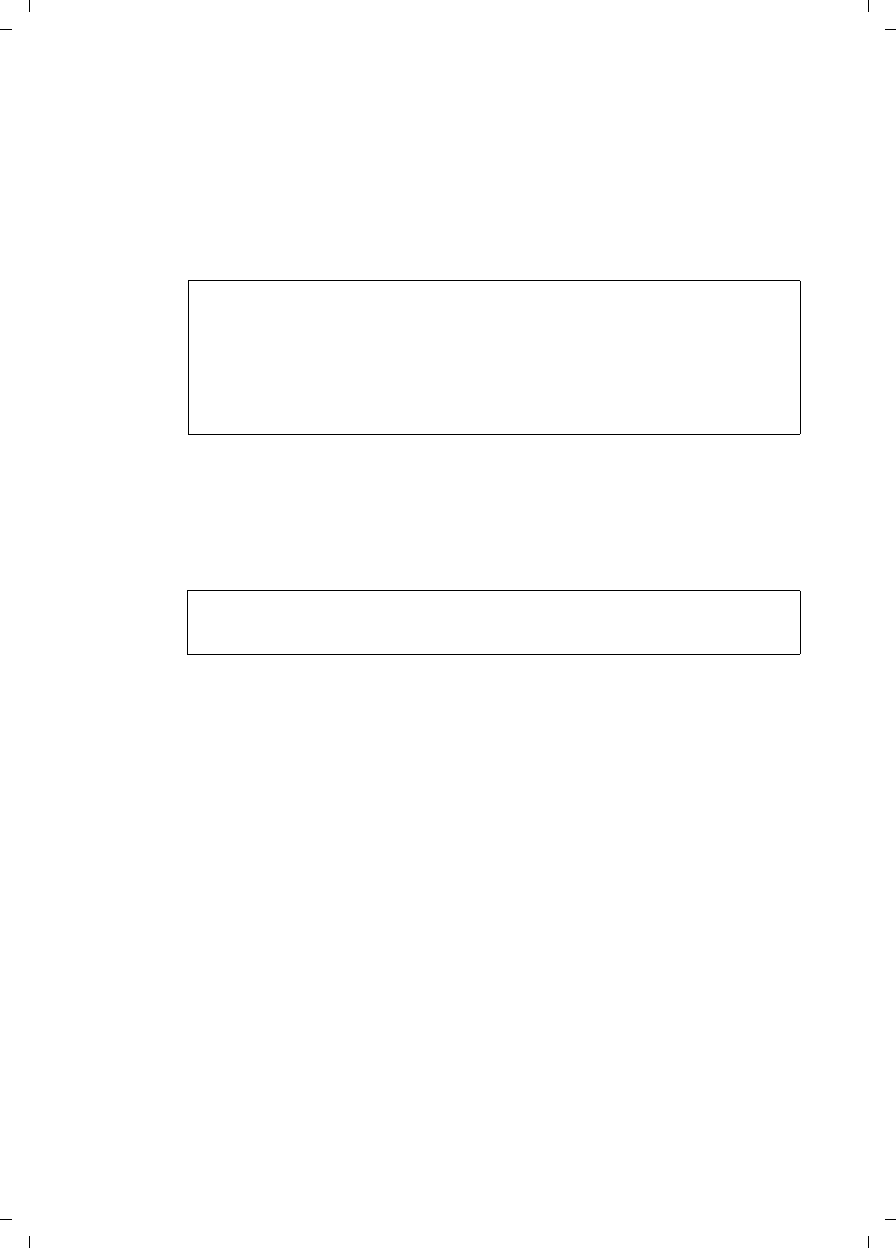
170
Gigaset A580 IP – free software
Gigaset A580 IP / US English / A31008-xxxx-xxxx-x-xxxx / appendix.fm / 24.04.2009
Version 8, 03.09.2008
Applying These Terms to Your New Libraries
If you develop a new library, and you want it to be of the greatest possible use to the
public, we recommend making it free software that everyone can redistribute and
change. You can do so by permitting redistribution under these terms (or, alternatively,
under the terms of the ordinary General Public License).
To apply these terms, attach the following notices to the library. It is safest to attach them
to the start of each source file to most effectively convey the exclusion of warranty; and
each file should have at least the "copyright" line and a pointer to where the full notice is
found.
You should have received a copy of the GNU Lesser General Public License along with this
library; if not, write to the Free Software Foundation, Inc., 59 Temple Place, Suite 330,
Boston, MA 02111-1307 USA
Also add information on how to contact you by electronic and paper mail.
You should also get your employer (if you work as a programmer) or your school, if any,
to sign a "copyright disclaimer" for the library, if necessary. Here is a sample; alter the
names:
<one line to give the library's name and a brief idea of what it does.>
Copyright (C) <year> <name of author>
This library is free software; you can redistribute it and/or modify it under the terms of
the GNU Lesser General Public License as published by the Free Software Foundation;
either version 2.1 of the License, or (at your option) any later version.
This library is distributed in the hope that it will be useful, but WITHOUT ANY WAR-
RANTY; without even the implied warranty of MERCHANTABILITY or FITNESS FOR A PAR-
TICULAR PURPOSE. See the GNU Lesser General Public License for more details.
Yoyodyne, Inc., hereby disclaims all copyright interest in the library `Frob' (a library for
tweaking knobs) written by James Random Hacker. <signature of Ty Coon>, 1 April 1990
Ty Coon, President of Vice
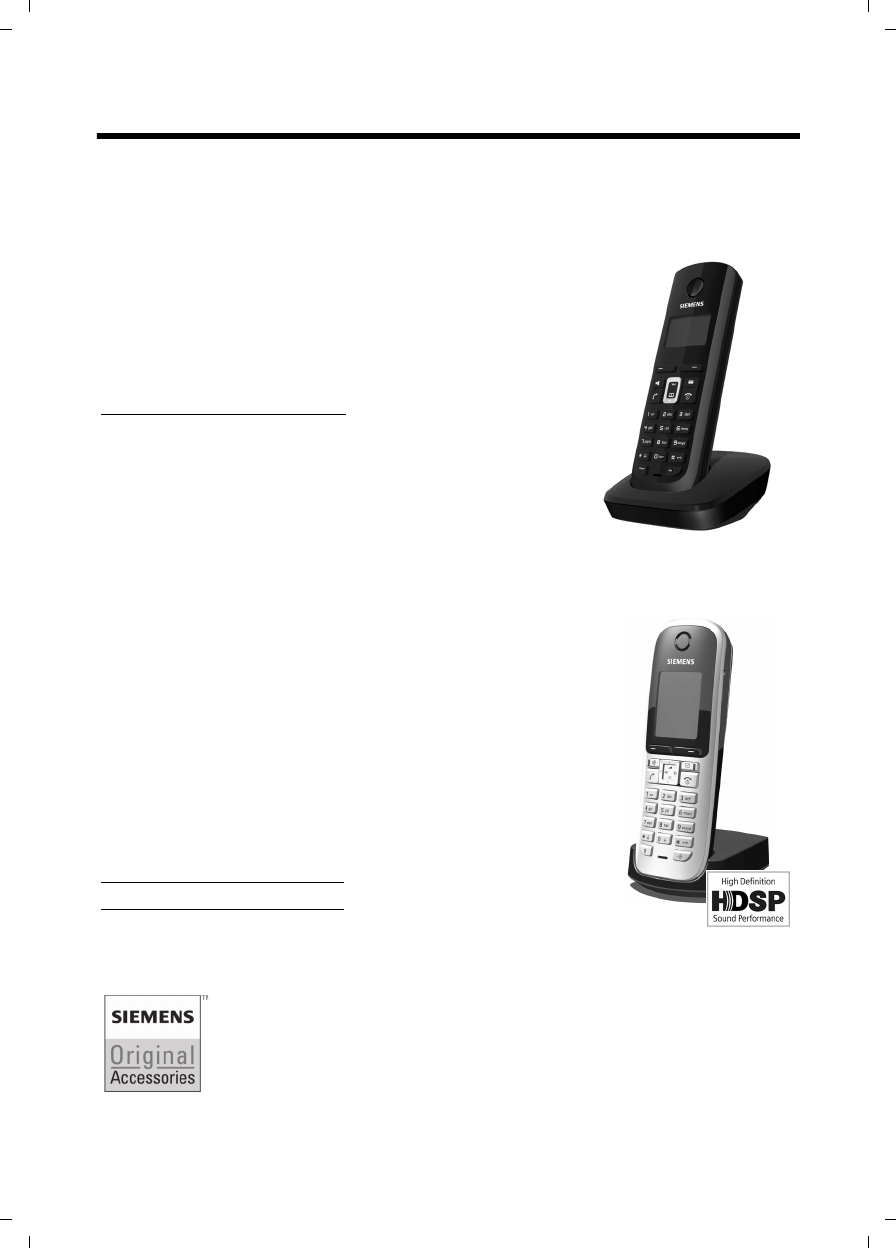
171
Accessories
Gigaset A580 IP / US English / A31008-xxxx-xxxx-x-xxxx / accessories_SAG.fm / 24.04.2009
Version 8, 03.09.2008
Accessories
Gigaset handsets
Upgrade your Gigaset to a cordless PABX:
Gigaset A58H handset
uIlluminated graphic display
uIlluminated keypad
uHandsfree talking
uPolyphonic ringer melodies
uDirectory for around 150 entries
www.gigaset.com/gigaseta58h
Gigaset S67H or S68H handset
uHDSP ready
uIlluminated graphical color display (65k colors)
uIlluminated keypad
uHandsfree talking
uPolyphonic ringer melodies
uDirectory for around 250 entries
uPicture Caller ID
uHeadset socket
uBluetooth (Gigaset S68H only)
uRoom monitor
www.gigaset.com/gigasets67h
www.gigaset.com/gigasets68h
All accessories are available from your phone retailer.
Use only original accessories. This will avoid possible health risks and dam-
age to property, and also ensure that all the relevant regulations are com-
plied with.

172
Glossary
Gigaset A580 IP / US English / A31008-xxxx-xxxx-x-xxxx / glossary.fm / 24.04.2009
Version 8, 03.09.2008
Glossary
A
ADSL Asymmetric Digital Subscriber Line
Special form of DSL.
ALG Application Layer Gateway
NAT control mechanism of a router.
Many routers with integrated NAT use ALG. ALG lets the data packets in a VoIP
connection pass and adds the public IP address of the secure private network.
The router's ALG should be deactivated if the VoIP provider offers a STUN server
or an outbound proxy.
£ Firewall, NAT, Outbound proxy, STUN
Authentication
Restriction of access to a network/service by use of an ID and password to
log in.
Automatic ringback
£ Ringback when the number is busy.
B
Block dialing
Enter the complete phone number, and correct it if necessary. Then pick up the
handset or press the Handsfree key to dial the phone number.
Broadband Internet access
£ DSL.
Buddy Subscriber with whom you exchange brief messages on the Internet in real
time (chatting).
£Instant messaging.
C
Call waiting = CW
VoIP provider feature. A beep during a call indicates that another caller is wait-
ing. You can accept or reject the second call. You can activate/deactivate the
feature.

173
Glossary
Gigaset A580 IP / US English / A31008-xxxx-xxxx-x-xxxx / glossary.fm / 24.04.2009
Version 8, 03.09.2008
Call forwarding
= CF
Automatic forwarding (CF) of a call to a different telephone number. There are
three kinds of call forwarding:
uCFU, Call Forwarding Unconditional
uCFB, Call Forwarding Busy
uCFNR, Call Forwarding No Reply
CF £ Call forwarding
Chatting Form of communication on the Internet. During a chat, brief messages are
exchanged between the communicating parties in real time. Chatting in this
sense is understood to be a written form of communication.
Client Application that requests a service from a server.
Codec Coder/decoder
Codec is a procedure that digitizes and compresses analog voice before it is
sent via the Internet, and decodes – i.e. translates into analog voice – digital
data when voice packets are received. There are different codecs, with differing
degrees of compression, for instance.
Both parties involved in the telephone connection (caller/sender and recipient)
must use the same codec. This is negotiated between the sender and the recip-
ient when establishing a connection.
The choice of codec is a compromise between voice quality, transmission speed
and the necessary bandwidth. A high level of compression, for example, means
that the bandwidth required for each voice connection is low. However, it also
means that the time needed to compress/decompress the data is greater, which
increases execution time for data in the network and thus impairs voice quality.
The time required increases the delay between the sender speaking and the
recipient hearing what has been said.
COLP / COLR
Connected Line Identification Presentation/Restriction
Service characteristic of a VoIP connection for outgoing calls.
COLP displays the phone number accepting the call on the calling party's dis-
play unit.
The number of the party accepting the call is different to the dialed number,
e.g. if the call is forwarded or transferred.
The called party can use COLR (Connected Line Identification Restriction) to
prevent the number from appearing on the calling party's display.
Consultation call
You are on a call. With a consultation call, you interrupt the conversation briefly
to establish a second connection to another participant. If you terminate the
connection to this participant immediately, then this was a consultation call. If
you switch between the first and second participant, it is called Toggling.
CW £ Call waiting

174
Glossary
Gigaset A580 IP / US English / A31008-xxxx-xxxx-x-xxxx / glossary.fm / 24.04.2009
Version 8, 03.09.2008
D
DHCP Dynamic Host Configuration Protocol
Internet protocol which regulates the automatic assignment of IP addresses to
Network subscribers. The protocol is made available in the network by a
server. A DHCP server can, for example, be a router.
The phone contains a DHCP client. A router that contains a DHCP server can
assign the IP addresses for the phone automatically from a defined address
block. The dynamic assignment means that several Network subscribers can
share one IP address, although they can only use it alternately and not simulta-
neously.
With some routers you can specify that the IP address for the phone is never
changed.
Displayed name
VoIP provider feature. You can specify any name that is to be shown to the
other party during a call instead of your phone number.
DMZ (Demilitarized Zone)
DMZ describes a part of a network that is outside the firewall.
A DMZ is set up, as it were, between a network you want to protect (e.g. a LAN)
and a non-secure network (e.g. the Internet). A DMZ permits unrestricted
access from the Internet to only one or a few network components, while the
other network components remain secure behind the firewall.
DNS Domain Name System
Hierarchical system that enables assignment of IP addresses to Domain
names that are easier to memorize. This assignment must be managed in each
(W)LAN from a local DNS server. The local DNS server determines the IP
address, if necessary by enquiring about superordinate DNS servers and other
local DNS servers on the Internet.
You can specify the IP address of the primary/secondary DNS server.
£ DynDNS.
Domain name
Name of one (several) Web server(s) on the Internet (e.g. gigaset.net).
The domain name is assigned to the relevant IP address by DNS.
DSCP Differentiated Service Code Point
£ Quality of Service (QoS).
DSL Digital Subscriber Line
Data transfer technology that allows Internet access with, for e.g. 1.5 Mbps
over a conventional telephone line. Prerequisites: DSL modem and the appro-
priate service offered by the Internet provider.
DSLAM Digital Subscriber Line Access Multiplexer
The DSLAM is a switch cabinet in an exchange at which all subscriber connec-
tors converge.

175
Glossary
Gigaset A580 IP / US English / A31008-xxxx-xxxx-x-xxxx / glossary.fm / 24.04.2009
Version 8, 03.09.2008
DTMF Dual Tone Multi-Frequency
Another description for dual tone multi-frequency dialing (DTMF).
Dynamic IP address
A dynamic IP address is assigned to a network component automatically via
DHCP. The dynamic IP address for a network component can change every
time it registers or at certain time intervals.
£ Static IP address
DynDNS Dynamic DNS
Domain names and IP addresses are assigned via DNS. For Dynamic IP
addresses this service is enhanced with "DynamicDNS". This permits the use of
a network component with a dynamic IP address as a Server on the Internet.
DynDNS ensures that a service can always be addressed on the Internet at the
same Domain name, regardless of the current IP address.
E
ECT Explicit Call Transfer
Participant A calls participant B. The participant puts the connection on hold
and calls participant C. Rather than connect everyone in a three-party confer-
ence, A now transfers participant B to C and hangs up.
EEPROM Electrically Erasable Programmable Read Only Memory
Memory building block in your phone with fixed data (e.g. default and custom-
ized settings) and data saved automatically (e.g. entries to the list of callers).
Ethernet network
Wired LAN.
F
Firewall You can use a firewall to protect your network against unauthorized external
access. This involves combining various measures and technologies (hard and/
or software) to control the flow of data between a private network you wish to
protect and an unprotected network (e.g., the Internet).
£NAT.
Firmware Software for a device in which basic information is stored for the device's func-
tion. To correct errors or update the device software, a new version of the
firmware can be loaded into the device's memory (firmware update).
Flat rate Billing system for an Internet connection. The Internet provider charges a set
monthly fee. There are no additional charges for the duration of the connection
or number of connections.
Fragmentation
Data packets that are too big are split into smaller packets (fragments) before
they are transferred. They are put together again when they reach the recipient
(defragmented).

176
Glossary
Gigaset A580 IP / US English / A31008-xxxx-xxxx-x-xxxx / glossary.fm / 24.04.2009
Version 8, 03.09.2008
Full duplex Data transmission is a mode in which data can be sent and received at the same
time.
G
G.711 a law, G.711 µ law
Standard for a Codec.
G.711 delivers a very good voice quality that corresponds to that in the ISDN
fixed line. As there is little compression, the necessary bandwidth is around 64
kbit/s per voice connection, but the delay caused by coding/decoding is only
0.125 ms.
"a law" describes the European standard and "µ law" describes the North Amer-
ican/Japanese equivalent.
G.722 Standard for a Codec.
G.722 is a broadband language codec with a bandwidth of 50 Hz to 7 kHz, a
net transmission rate of 64 kbit/s per language connection and integrated
speech pause recognition and comfort noise generation (silence suppression).
G.722 delivers very good voice quality. A higher sampling rate provides clearer
and better voice quality than other codecs and enables a speech tone in High
Definition Sound Performance (HDSP).
G.726 Standard for a Codec.
G.726 delivers a good voice quality. It is inferior to the quality with codec G.711
but better than with G.729.
G.729A/B Standard for a Codec.
The voice quality is more likely to be lower with G.729A/B. As a result of the
high level of compression, the necessary bandwidth is only around 8 kbit/s per
voice connection, but the delay is around 15 ms.
Gateway Connects two different Networks, e.g. a router as an Internet gateway.
For phone calls from VoIP to the telephone network, a gateway has to be con-
nected to the IP network and the telephone network (gateway/VoIP provider).
It forwards calls from VoIP to the telephone network as required.
Gateway provider
£SIP provider.
Global IP address
£IP address.
GSM Global System for Mobile Communication
Originally, a European standard for mobile networks. GSM can now be
described as a worldwide standard. In the USA and Japan national standards
are now more frequently supported than in the past.

177
Glossary
Gigaset A580 IP / US English / A31008-xxxx-xxxx-x-xxxx / glossary.fm / 24.04.2009
Version 8, 03.09.2008
H
Headset Combination of microphone and headphone. A headset makes handsfree talk-
ing more convenient. There are headsets available that can be connected to the
handset by a cable.
HTTP Proxy
Server via which the Network subscribers can process their Internet traffic.
Hub Uses one Infrastructure network to connect several Network subscribers.
All data sent to the hub by one network subscriber is forwarded to all network
subscribers.
£Gateway, Router.
I
IEEE Institute of Electrical and Electronics Engineers
International body that defines standards in electronics and electro-technol-
ogy, concerned in particular with the standardization of LAN technology, trans-
mission protocols, data transfer rate and wiring.
Infrastructure network
Network with central structure: All Network subscribers communicate via a
central Router.
Instant messaging
Service that uses a client program to allow chatting in real time, i.e. to send
brief messages to other subscribers on the Internet.
Internet Global WAN. A series of protocols have been defined for exchanging data,
known by the name TCP/IP.
Each Network subscriber is identifiable via his IP address. DNS assigns a
Domain name to the IP address.
Important services on the Internet include the World Wide Web (WWW), e-mail,
file transfer and discussion forums.
Internet Service Provider
Enables access to the Internet for a fee.
IP (Internet Protocol)
TCP/IP protocol on the Internet. IP is responsible for addressing subscribers in
a Network using IP addresses and transfers data from the sender to the recip-
ient. IP determines the paths (routing) along which the data packets travel.

178
Glossary
Gigaset A580 IP / US English / A31008-xxxx-xxxx-x-xxxx / glossary.fm / 24.04.2009
Version 8, 03.09.2008
IP address A unique address for a network component within a network based on the TCP/
IP protocols (e.g. LAN, Internet). On the Internet, domain names are usually
assigned instead of IP addresses. DNS assigns the corresponding IP address to
the domain name.
The IP address consists of four three-digit decimal numbers separated from one
another by a period (e.g. 223.94.233.2). The first decimal number can be
between 1 and 126 and between 128 and 223, the second and third between
0 and 255, and the fourth between 1 and 254.
The IP address is made up of the network number and the number of the Net-
work subscriber (e.g. phone). Depending on the Subnet mask, the front one,
two or three parts make up the network number and the rest of the IP address
addresses the network component. The network number of all the components
in any one network must be identical.
IP addresses can be assigned automatically with DHCP (dynamic IP addresses)
or manually (static IP addresses).
£DHCP.
IP pool range
Range of IP addresses that the DHCP server can use to assign dynamic
IP addresses.
L
LAN Local Area Network
Network with a restricted physical range. A LAN can be wireless (WLAN) and/or
wired.
Local IP address
The local or private IP address is the address for a network component in the
local network (LAN). The network operator can assign any address he or she
wants. Devices that act as a link from a local network to the Internet (gateway
or router) have a public and a private IP address.
£IP address.
Local SIP Port
£SIP port/Local SIP port.
M
MAC address
Media Access Control Address
Hardware address by means of which each network device (e.g. network card,
switch, phone) can be uniquely identified worldwide. It consists of 6 parts
(hexadecimal numbers) separated by a "-" (e.g. 00-90-65-44-00-3A).
The MAC address is assigned by the manufacturer and cannot be changed.
Mbps Million bits per second
Unit of the transmission speed in a network.

179
Glossary
Gigaset A580 IP / US English / A31008-xxxx-xxxx-x-xxxx / glossary.fm / 24.04.2009
Version 8, 03.09.2008
MRU Maximum Receive Unit
Defines the maximum user data volume within a data packet.
MTU Maximum Transmission Unit
Defines the maximum length of a data packet that can be carried over the net-
work at a time.
Music on hold
Music that is played while you are on a Consultation call or Toggling.
The waiting participant hears music while on hold.
N
NAT Network Address Translation
Method for converting (private) IP addresses to one or more (public) IP
addresses. NAT enables the IP addresses of Network subscribers (e.g. VoIP tel-
ephones) in a LAN to be concealed behind a shared IP address for the Router
on the Internet.
VoIP telephones behind a NAT router cannot be reached by VoIP servers (on
account of the private IP address). To "get around" NAT, it is possible to use
(alternately) ALG in the router, STUN in the VoIP telephone, or for the VoIP pro-
vider to use an Outbound proxy.
If an outbound proxy is made available you must allow for this in the VoIP set-
tings for your phone.
Network Group of devices. Devices can be connected in either wired or wireless mode.
Networks can also differ in range and structure:
uRange: local networks (LAN) or wide-area networks (WAN)
uStructure: Infrastructure network or ad-hoc network
Network subscriber
Devices and PCs that are connected to each other in a network, e.g. servers, PCs
and phones.
O
Outbound proxy
Alternate NAT control mechanism to STUN and ALG.
Outbound proxies are implemented by the VoIP provider in firewall/NAT envi-
ronments as an alternate to SIP proxy server. They control data traffic through
the firewall.
Outbound proxy and STUN servers should not be used simultaneously.
£STUN and NAT.

180
Glossary
Gigaset A580 IP / US English / A31008-xxxx-xxxx-x-xxxx / glossary.fm / 24.04.2009
Version 8, 03.09.2008
P
Paging (handset search)
A base station function to locate registered handsets. The base station estab-
lishes a connection to every registered handset. The handsets start to ring.
Paging is activated by briefly pressing the button on the base station and is
deactivated by briefly pressing the same button again.
PIN Personal Identification Number
Protects against unauthorized use. When the PIN is activated, a number combi-
nation has to be entered to access a protected area.
You can protect your base station configuration data with a system PIN (4-digit
number combination).
Port Data is exchanged between two applications in a Network via a port.
Port forwarding
The Internet gateway (e.g. your router) forwards data packets from the Inter-
net that are directed to a certain Port to the port concerned. This allows servers
in the LAN to offer services on the Internet without you needing a public IP
address.
Port number
Indicates a specific application of a Network subscriber. Depending on the set-
ting in the LAN, the port number is permanently assigned or else it is newly
assigned with each access.
The combination of IP address/Port number uniquely identifies the recipient
or sender of a data packet within a network.
Predialing £Block dialing.
Private IP address
£Public IP address.
Protocol Describes the agreements for communicating within a Network. It contains
rules for opening, administering and closing a connection, about data formats,
time frames and possible error handling.
Proxy/Proxy server
Computer program that controls the exchange of data between Client and
Server in computer networks. If the phone sends a query to the VoIP server, the
proxy acts as a server towards the phone and as a client towards the server.
A proxy is addressed via Domain names/IP addresses and Ports.
Public IP address
The public IP address is the address for a network component on the Internet.
It is assigned by the Internet Service Provider. Devices that act as a link from a
local network to the Internet (gateway, router) have a public and a local IP
address.
£IP address and NAT

181
Glossary
Gigaset A580 IP / US English / A31008-xxxx-xxxx-x-xxxx / glossary.fm / 24.04.2009
Version 8, 03.09.2008
Q
Quality of Service (QoS)
Quality of service
Describes the Quality of Service in communication networks. Differentiations
are made between various Quality of Service classes.
QoS influences the flow of data packets on the Internet, e.g. by prioritizing data
packets, reserving bandwidth and data packet optimization.
In VoIP networks, QoS influences the voice quality. If the whole infrastructure
(router, network server, etc.) has QoS, the voice quality is better, i.e. fewer
delays, less echoing, less crackling.
R
RAM Random Access Memory
Memory in which you have reading and storage rights. Items such as melodies
and screen pictures are saved in the RAM after you have loaded them onto the
phone via the Web configurator.
Registrar The registrar manages the Network subscribers' current IP addresses. When
you register with your VoIP provider, your current IP address is saved on the reg-
istrar. This means you can also be reached when on the move.
ROM Read Only Memory
A type of memory that can only be read.
Router Routes data packets within a network and between different networks via the
quickest route. Can connect Ethernet networks and WLAN. Can be a Gateway
to the Internet.
Routing Routing is the transfer of data packets to another subscriber in your network.
On their way to the recipient, the data packets are sent from one router to the
next until they reach their destination.
If data packets were not forwarded in this way, a network like the Internet
would not be possible. Routing connects the individual networks to this global
system.
A router is a part of this system; it transfers data packets both within a local net-
work and from one network to the next. Transfer of data from one network to
another is performed on the basis of a common protocol.
RTP Realtime Transport Protocol
Global standard for transferring audio and video data. Often used in conjunc-
tion with UDP. In this case, RTP packets are embedded in UDP packets.
RTP port (Local) Port that is used to send and receive voice data packets for VoIP.
Ringback when the number is busy
= CCBS (Completion of Calls to Busy Subscriber). If a caller hears the busy tone,
he or she can activate the ringback function. As soon as the connection is free
the caller is rung back. As soon as the caller lifts the receiver the connection is
made automatically.

182
Glossary
Gigaset A580 IP / US English / A31008-xxxx-xxxx-x-xxxx / glossary.fm / 24.04.2009
Version 8, 03.09.2008
Ringback when the call is not answered
= CCNR (Completion of Calls on No Reply). If a participant does not respond
when called, a caller can arrange an automatic ringback. As soon as the desti-
nation phone has completed a call and is free again, the caller is rung back. This
feature must be supported by the exchange. The ringback request is automat-
ically canceled after about 2 hours (depending on the VoIP provider).
S
Server Provides a service to other Network subscribers (Clients). The term can indi-
cate a computer/PC or an application. A server is addressed via IP addresses/
Domain names and Ports.
SIP (Session Initiation Protocol)
Signaling protocol independent of voice communication. Used for establishing
and ending a call. It is also possible to define parameters for voice transmission.
SIP address £URI.
SIP port/Local SIP port
(Local) Port that is used to send and receive SIP signaling data for VoIP.
SIP provider £VoIP provider.
SIP proxy server
IP address of your VoIP provider's gateway server.
Static IP address
A static IP address is assigned to a network component manually during net-
work configuration. Unlike a Dynamic IP address, a static IP address does not
change.
STUN Simple Transversal of UDP over NAT
NAT control mechanism.
STUN is a data protocol for VoIP telephones. STUN replaces the private IP
address in the data packets of the VoIP telephone with the public address of the
secure private network. To control data transfer, a STUN server is also required
on the Internet. STUN cannot be implemented with symmetric NATs.
£ALG, Firewall, NAT, Outbound proxy.
Subnet Segment of a Network.
Subnet mask
IP addresses consist of a fixed network number and a variable subscriber
number. The network number is identical for all Network subscribers. The size
of the network number part is determined in the subnet mask. In the subnet
mask 255.255.255.0, for example, the first three parts of the IP address are the
network number and the last part the subscriber number.

183
Glossary
Gigaset A580 IP / US English / A31008-xxxx-xxxx-x-xxxx / glossary.fm / 24.04.2009
Version 8, 03.09.2008
Symmetric NAT
A symmetric NAT assigns different external IP addresses and port numbers to
the same internal IP addresses and port numbers – depending on the external
target address.
T
TCP Transmission Control Protocol
Transport protocol. Session-based transmission protocol: it sets up, monitors
and terminates a connection between sender and recipient for transporting
data.
TLS Transport Layer Security
Protocol for encrypting data transmissions on the Internet. TLS is a superordi-
nated Transport protocol.
Toggling Toggling allows you to switch between two callers or between a conference call
and an individual caller without allowing the waiting caller to listen to the call.
Transmission rate
Speed at which data is transmitted in the WAN or LAN. The transmission rate
is measured in data units per unit of time (Mbit/s).
Transport protocol
Controls data transport between two communication partners (applications).
£UDP, TCP, TLS.
U
UDP User Datagram Protocol
Transport protocol. Unlike TCP, UDP is a non session-based protocol. UDP
does not establish a fixed connection. The data packets ("datagrams") are sent
as a broadcast. The recipient is solely responsible for making sure the data is
received. The sender is not notified about whether it is received or not.
URI Uniform Resource Identifier
Character sequence for identifying resources (e.g. e-mail recipient, http://
gigaset.com, files).
On the Internet, URIs are used as a uniform identification for resources. URIs
are also described as SIP addresses.
URIs can be entered in the phone as a number. By dialing a URI you can call an
Internet subscriber with VoIP equipment.
URL Universal Resource Locator
Globally unique address of a domain on the Internet.
A URL is a subtype of URI. URLs identify a resource by its location on the Inter-
net. For historical reasons the term is often used as a synonym for URI.
User ID £User identification.

184
Glossary
Gigaset A580 IP / US English / A31008-xxxx-xxxx-x-xxxx / glossary.fm / 24.04.2009
Version 8, 03.09.2008
User identification
Name/number combination for access, e.g. to your VoIP account.
V
Voice codec £Codec.
VoIP Voice over Internet Protocol
Telephone calls are no longer placed and transmitted over the telephone
network but over the Internet (or other IP networks).
VoIP provider
A VoIP, SIP or Gateway provider is an Internet service provider that provides a
Gateway for Internet telephony. As the phone works with the SIP standard,
your provider must support the SIP standard.
The provider routes calls from VoIP to the telephone network (analog, ISDN and
cellular) and vice versa.
W
WAN Wide Area Network
Wide-area network that is unrestricted in terms of area (e.g. Internet).

185
Index
Gigaset A580 IP / US English / A31008-xxxx-xxxx-x-xxxx / Gigaset_A580_IPSIX.fm / 24.04.2009
Version 8, 03.09.2008
Index
A
Access code (PABX) . . . . . . . . . . . . . . 94
Access protection. . . . . . . . . . . . . . . . 84
Access to Web configurator
from other networks . . . . . . . . . 104
Accessories . . . . . . . . . . . . . . . . . . . 171
Account name (e-mail). . . . . . . . . . . 132
Acknowledge tones . . . . . . . . . . . . . . 82
Activating
advisory tones . . . . . . . . . . . . . . . . 82
Annex B for G.729 . . . . . . . . . . . . 118
auto answer . . . . . . . . . . . . . . . . . . 80
handset . . . . . . . . . . . . . . . . . . . 1, 32
keypad lock . . . . . . . . . . . . . . . . . . 32
network mailbox. . . . . . . . . . . . . . 125
speaker . . . . . . . . . . . . . . . . . . . . . 44
Address assignment (IP address) . . . . 103
ADSL . . . . . . . . . . . . . . . . . . . . . . . . 172
Advisory tones. . . . . . . . . . . . . . . . . . 82
Alarm clock . . . . . . . . . . . . . . . . . . . . 70
Alarm repeat . . . . . . . . . . . . . . . . . . . 70
ALG. . . . . . . . . . . . . . . . . . . . . . . . . 172
Alternate DNS server
(Web configurator) . . . . . . . . . . 104
Anonymous calling . . . . . . . . . . . . . . 52
Application Layer Gateway (ALG) . . . 172
Application signal (Flash key) . . . . . . 127
Application type (Flash key) . . . . . . . 127
Arabic characters, entering. . . . . . . . 100
Area code
dialing automatically. . . . . . . . . . . 122
entering own . . . . . . . . . . . . . . . . 122
Area code predialing
activating/deactivating . . . . . . . . . 122
Area codes. . . . . . . . . . . . . . . . . . . . . 87
extra area codes . . . . . . . . . . . . . . . 87
extra codes. . . . . . . . . . . . . . . . . . . 87
local area code . . . . . . . . . . . . . . . . 87
own area code . . . . . . . . . . . . . . . . 87
Assigning send number to handset . . 120
Asterisk key . . . . . . . . . . . . . . . . . . 1, 82
Asymmetric Digital Subscriber Line . . 172
Audio (DTMF signaling) . . . . . . . . . . 126
Authentication. . . . . . . . . . . . . . . . . 172
Authentication name
e-mail . . . . . . . . . . . . . . . . . . . . . 132
Auto answer . . . . . . . . . . . . . . . . . . . 41
activating/deactivating. . . . . . . . . . 80
Automatic configuration
of a VoIP connection . . . . . . . . . . 108
Automatic version check . . . . . . . . . 138
Available codecs . . . . . . . . . . . . . . . 117
B
Base station
activating/deactivating eco mode . . 69
changing system PIN . . . . . . . . . . . 84
checking service information . . . . 148
connecting . . . . . . . . . . . . . . . . . . 18
connecting to electrical power
supply. . . . . . . . . . . . . . . . . . . 19
connecting to fixed line network . . 19
connecting to router . . . . . . . . . . . 20
operating on PABX . . . . . . . . . . . . . 94
power consumption. . . . . . . . . . . 151
reducing power consumption. . . . . 69
reducing transmission power . . . . . 69
restoring factory settings . . . . . . . . 85
setting . . . . . . . . . . . . . . . . . . . . . 84
setting default connection . . . 86, 119
setting up . . . . . . . . . . . . . . . . . . . 17
system PIN . . . . . . . . . . . . . . . . . . 84
updating firmware. . . . . . . . . 87, 137
wall mounting . . . . . . . . . . . . . . . 195
Base station power consumption
reducing . . . . . . . . . . . . . . . . . . . . 69
Battery
charge status. . . . . . . . . . . . . . . . . . 2
charging . . . . . . . . . . . . . . . . . . 1, 14
display . . . . . . . . . . . . . . . . . . . 1, 14
icon . . . . . . . . . . . . . . . . . . . . . 1, 14
inserting . . . . . . . . . . . . . . . . . . . . 11
recommended batteries . . . . . . . . 150
tone . . . . . . . . . . . . . . . . . . . . . . . 83
Block dialing . . . . . . . . . . . . . . . . . . 172
Blocking your caller ID. . . . . . . . . . . . 52
Broadband connections. . . . . . . . . . . . 9
Broadband Internet access. . . . . . . . 172
Broadband voice codec . . . . . . 115, 176
Buddy. . . . . . . . . . . . . . . . . . . . . . . 172
Buttons (Web configurator) . . . . . . . 101

186
Index
Gigaset A580 IP / US English / A31008-xxxx-xxxx-x-xxxx / Gigaset_A580_IPSIX.fm / 24.04.2009
Version 8, 03.09.2008
C
Call
accepting . . . . . . . . . . . . . . . . . . . . 41
disconnecting (toggling) . . . . . . . . . 55
ending . . . . . . . . . . . . . . . . . . . . . . 41
external . . . . . . . . . . . . . . . . . . . . . 43
incoming . . . . . . . . . . . . . . . . . . . . . 2
internal . . . . . . . . . . . . . . . . . . . . . 74
number/name display . . . . . . . . . . . 42
rejecting external . . . . . . . . . . . . . . 76
transferring (connecting) . . . . . . . . 75
Call acceptance
automatic. . . . . . . . . . . . . . . . . . . . 80
Call display . . . . . . . . . . . . . . . . . . . . 42
fixed line network. . . . . . . . . . . . . . 42
VoIP . . . . . . . . . . . . . . . . . . . . . . . . 42
Call duration . . . . . . . . . . . . . . . . . . . 46
Call forwarding . . . . . . . . . . . . . . . . 173
Gigaset.net. . . . . . . . . . . . . . . 53, 121
VoIP (handset) . . . . . . . . . . . . . . . . 53
VoIP (Web configurator) . . . . . . . . 121
Call waiting . . . . . . . . . . . . . . . 172, 173
accepting/rejecting (VoIP) . . . . . . . . 56
activating/deactivating (VoIP) . . . . . 54
internal call . . . . . . . . . . . . . . . . . . 76
Caller ID . . . . . . . . . . . . . . . . . . . . . . 42
Calling
anonymously . . . . . . . . . . . . . . . . . 52
entering IP address . . . . . . . . . . . . . 40
external . . . . . . . . . . . . . . . . . . . . . 38
Gigaset.net. . . . . . . . . . . . . . . . 49, 51
internal . . . . . . . . . . . . . . . . . . . . . 74
via VoIP/fixed line network . . . . . . . 38
Calls list. . . . . . . . . . . . . . . . . . . . . . . 58
Canceling
dialing . . . . . . . . . . . . . . . . . . . . . . 40
operation . . . . . . . . . . . . . . . . . . . 101
Care of the telephone . . . . . . . . . . . 150
CF . . . . . . . . . . . . . . . . . . . . . . . . . . 173
Changing
dialing mode . . . . . . . . . . . . . . . . . 94
earpiece volume . . . . . . . . . . . . . . . 80
handsfree volume. . . . . . . . . . . . . . 80
internal number . . . . . . . . . . . 73, 133
system PIN . . . . . . . . . . . . . . . . . . . 84
to daylight saving time . . . . . . . . . 139
Charge status display (battery) . . . . 1, 14
Charge status of the batteries. . . . . . . . 2
Charging cradle
connecting . . . . . . . . . . . . . . . . . . 13
wall mounting . . . . . . . . . . . . . . . 195
Chatting . . . . . . . . . . . . . . . . . . . . . 173
Checking EEPROM version . . . . . . . . 140
Checking service information . . . . . 148
Client . . . . . . . . . . . . . . . . . . . . . . . 173
Codecs . . . . . . . . . . . . . . . . . . . . . . 173
Codecs, available . . . . . . . . . . . . . . 117
COLP . . . . . . . . . . . . . . . . . . . . 44, 173
COLR . . . . . . . . . . . . . . . . . . . . 44, 173
Conference. . . . . . . . . . . . . . . . . . . . 76
Conference call
fixed line network . . . . . . . . . . . . . 53
VoIP . . . . . . . . . . . . . . . . . . . . . . . 55
Configuration
via PC . . . . . . . . . . . . . . . . . . . . . . 96
VoIP connection (automatic) . . . . 108
Configuring
VoIP connection (handset) . . . . . . . 90
VoIP connection (Web config.) . . . 106
Confirmation tone. . . . . . . . . . . . . . . 82
Connected Line
Identification Presentation . 44, 173
Connecting
PC to the Web configurator. . . . 96, 97
phone to internal company
network . . . . . . . . . . . . . . . . 105
Connection
activating (VoIP) . . . . . . . . . . . . . 114
Internet (troubleshooting) . . . . . . . 27
name/provider (Web config.) . . . . 106
phone to an internal company
network . . . . . . . . . . . . . . . . 105
selecting (line suffix) . . . . . . . . 38, 39
to Gigaset.net . . . . . . . . . . . . . . . 114
Connection name
fixed line network . . . . . . . . . . . . 114
VoIP . . . . . . . . . . . . . . . . . . . . . . 108
Connection type
selecting (Display key) . . . . . . . 38, 39
selecting (Talk key). . . . . . . . . . . . . 38
Connection wizard
starting (getting started) . . . . . . . . 21
Consultation call . . . . . . . . . . . . . . . 173
ending . . . . . . . . . . . . . . . . . . . . . 76
external (fixed line network) . . . . . 53
external (VoIP). . . . . . . . . . . . . . . . 55
internal . . . . . . . . . . . . . . . . . . . . . 75
Control key . . . . . . . . . . . . . . . . . . 1, 30

187
Index
Gigaset A580 IP / US English / A31008-xxxx-xxxx-x-xxxx / Gigaset_A580_IPSIX.fm / 24.04.2009
Version 8, 03.09.2008
Correcting incorrect entries . . . . . . . . 31
Cost control. . . . . . . . . . . . . . . . . . 8, 45
defining dialing plans . . . . . . . . . . 123
Customer Care. . . . . . . . . . . . . 141, 159
Customer Service. . . . . . . . . . . . . . . 141
CW . . . . . . . . . . . . . . . . . . . . . . . . . 173
Cyrillic characters, entering . . . . . . . 100
D
Data packets, fragmentation. . . . . . . 175
Data server for firmware update . . . . 137
Date
set manually. . . . . . . . . . . . . . . . . . 14
transferring from time server . . . . 139
Daylight saving time
changing automatically. . . . . . . . . 139
Deactivating
advisory tones . . . . . . . . . . . . . . . . 82
auto answer . . . . . . . . . . . . . . . . . . 80
handset . . . . . . . . . . . . . . . . . . . 1, 32
keypad lock . . . . . . . . . . . . . . . . . . 32
network mailbox. . . . . . . . . . . . . . 125
speaker . . . . . . . . . . . . . . . . . . . . . 44
Default gateway
entering (handset) . . . . . . . . . . . . . 92
entering (Web configurator) . . . . . 103
Default settings
handset . . . . . . . . . . . . . . . . . . . . . 83
Delete key . . . . . . . . . . . . . . . . . . . . . 30
Deleting characters . . . . . . . . . . . . . . 31
Demilitarized Zone. . . . . . . . . . . . . . 174
De-registering
from Web configurator . . . . . . . . . . 98
handset from base station. . . . . . . . 72
DHCP. . . . . . . . . . . . . . . . . . . . 174, 175
Dialing
canceling . . . . . . . . . . . . . . . . . . . . 40
directory . . . . . . . . . . . . . . . . . . . . 63
IP address. . . . . . . . . . . . . . . . . . . . 40
using shortcuts. . . . . . . . . . . . . . . . 64
Dialing mode . . . . . . . . . . . . . . . . . . . 94
Dialing plans . . . . . . . . . . . . . 8, 45, 123
activating/deactivating . . . . . . . . . 124
defining . . . . . . . . . . . . . . . . . . . . 123
deleting . . . . . . . . . . . . . . . . . . . . 125
for emergency numbers . . . . . . . . 125
Differentiated Service Code Point . . . 174
Digit key
changing assignment . . . . . . . . . . . 79
Digital clock. . . . . . . . . . . . . . . . . . . . 78
Digital Subscriber Line. . . . . . . . . . . 174
Digital Subscriber Line
Access Multiplexer . . . . . . . . . . 174
Directory . . . . . . . . . . . . . . . . . . . . . 62
copying number . . . . . . . . . . . . . . 65
copying number from text . . . . . . . 65
deleting (Web configurator) . . . . . 136
editing via PC. . . . . . . . . . . . . . . . 134
Gigaset.net . . . . . . . . . . . . . . . . . . 48
loading from PC . . . . . . . . . . . . . . 135
managing entries. . . . . . . . . . . . . . 64
opening . . . . . . . . . . . . . . . . . . . . 30
order of entries . . . . . . . . . . . . . . . 63
saving entry . . . . . . . . . . . . . . . . . 63
saving the first number . . . . . . . . . 62
sending entry/list to handset . . . . . 65
transferring to/from PC. . . . . . . . . 134
Directory file
content (vCard format) . . . . . . . . 136
Display
appointment/alarm activated . . . . . . 2
call duration . . . . . . . . . . . . . . . . . 46
call duration/costs . . . . . . . . . . . . . 46
caller’s number (CID) . . . . . . . . . . . 42
changing display language. . . . . . . 77
charge status of the batteries . . . . . . 2
in idle status . . . . . . . . . . . . . . . 1, 32
incoming call. . . . . . . . . . . . . . . . . . 2
keypad lock . . . . . . . . . . . . . . . . . . . 2
name (CID) . . . . . . . . . . . . . . . . . . 43
ringer melody deactivated . . . . . . . . 2
screensaver . . . . . . . . . . . . . . . . . . 78
Display keys . . . . . . . . . . . . . . . . . 1, 30
assigning. . . . . . . . . . . . . . . . . . . . 79
changing assignment. . . . . . . . . . . 79
Displayed name (VoIP). . . . . . . 110, 174
Disposal . . . . . . . . . . . . . . . . . . . . . 149
DMZ. . . . . . . . . . . . . . . . . . . . . . . . 174
DNS . . . . . . . . . . . . . . . . . . . . . . . . 174
DNS server . . . . . . . . . . . . . . . . . . . . 92
alternate (Web configurator) . . . . 104
preferred (handset) . . . . . . . . . . . . 92
preferred (Web configurator) . . . . 104
Domain . . . . . . . . . . . . . . . . . . . . . 111
Domain name. . . . . . . . . . . . . . . . . 174
Domain Name System. . . . . . . . . . . 174
DSCP . . . . . . . . . . . . . . . . . . . . . . . 174
DSL . . . . . . . . . . . . . . . . . . . . . . . . 174
DSLAM . . . . . . . . . . . . . . . . . . . . . . 174
DTMF (tone dialing) . . . . . . . . . . . . . 95

188
Index
Gigaset A580 IP / US English / A31008-xxxx-xxxx-x-xxxx / Gigaset_A580_IPSIX.fm / 24.04.2009
Version 8, 03.09.2008
DTMF signaling for VoIP . . . . . . . . . . 126
Dynamic DNS. . . . . . . . . . . . . . . . . . 175
Dynamic Host Configuration
Protocol . . . . . . . . . . . . . . . . . . 174
Dynamic IP address . . . . . . . . . 103, 175
DynDNS. . . . . . . . . . . . . . . . . . . . . . 175
E
Earpiece mode. . . . . . . . . . . . . . . . . . 44
Earpiece volume . . . . . . . . . . . . . . . . 80
Echo service
Gigaset.net. . . . . . . . . . . . . . . . . . . 46
ECO DECT . . . . . . . . . . . . . . . . . . . . . 69
Eco mode . . . . . . . . . . . . . . . . . . . . . 69
E-mail
account name . . . . . . . . . . . . . . . 132
authentication name/password . . . 132
entering access data . . . . . . . . . . . 132
incoming e-mail server . . . . . . . . . 132
settings (Web config.). . . . . . . . . . 132
Emergency numbers
dialing . . . . . . . . . . . . . . . . . . . . . . 40
dialing plans for . . . . . . . . . . . . . . 125
End Call key . . . . . . . . . . . . . . . 1, 40, 41
Ending, call . . . . . . . . . . . . . . . . . . . . 41
Entering
access data (e-mail) . . . . . . . . . . . 132
flash . . . . . . . . . . . . . . . . . . . . . . . . 1
user data . . . . . . . . . . . . . . . . . . . . 24
Entering Cyrillic/Arabic
characters . . . . . . . . . . . . . . . . . 100
Entry
selecting from directory . . . . . . . . . 63
Error tone . . . . . . . . . . . . . . . . . . . . . 82
Ethernet network. . . . . . . . . . . . . . . 175
Explicit Call Transfer . . . . . . . . . . . . . 175
External consultation call
fixed line network. . . . . . . . . . . . . . 53
VoIP . . . . . . . . . . . . . . . . . . . . . . . . 55
External line prefix (PABX) . . . . . . . . . 94
Extra area codes. . . . . . . . . . . . . . . . . 87
Extra codes . . . . . . . . . . . . . . . . . . . . 87
F
Factory settings
base station . . . . . . . . . . . . . . . . . . 85
Fast access. . . . . . . . . . . . . . . . . . . . . 66
Firewall . . . . . . . . . . . . . . . . . . . . . . 175
Firmware . . . . . . . . . . . . . . . . . . . . 175
automatic update . . . . . . . . . 88, 138
checking version . . . . . . . . . 140, 148
starting update (handset). . . . . . . . 87
starting update (Web conf.) . . . . . 137
updates. . . . . . . . . . . . . . . . . . . . . 11
Fixed line network
conference call . . . . . . . . . . . . . . . 53
connection name. . . . . . . . . . . . . 114
external consultation call . . . . . . . . 53
settings for calls. . . . . . . . . . . . . . . 53
Fixed line network connection
line suffix . . . . . . . . . . . . . . . . . . 107
Flash key . . . . . . . . . . . . . . . . . . . . . . 1
function for VoIP . . . . . . . . . . . . . 127
Flat rate . . . . . . . . . . . . . . . . . . . . . 175
Fragmentation of data packets. . . . . 175
Free software, licenses . . . . . . . . . . 163
Full duplex . . . . . . . . . . . . . . . . . . . 176
G
G.711 µ law . . . . . . . . . . . . . . . . . . 116
G.711 a law . . . . . . . . . . . . . . . . . . 116
G.722. . . . . . . . . . . . . . . . . . . . . 9, 115
G.722 Broadband language codec . . 115
G.726. . . . . . . . . . . . . . . . . . . . . . . 116
G.729. . . . . . . . . . . . . . . . . . . . . . . 116
Gateway . . . . . . . . . . . . . . . . . . . . . 176
Gateway provider . . . . . . . . . . . . . . 176
Getting help with your phone . . . . . 141
Gigaset config. . . . . . . . . . . . . . . 96, 97
Gigaset HDSP, see HDSP
Gigaset.net. . . . . . . . . . . . . . . . . . . . 46
(de)activating connection . . . . . . 114
call forwarding . . . . . . . . . . . 53, 121
calling participant . . . . . . . . . . 49, 51
changing/deleting own name. . . . . 50
directory . . . . . . . . . . . . . . . . . . . . 48
Echo service . . . . . . . . . . . . . . . . . 46
entering name. . . . . . . . . . . . . 47, 50
Jabber server. . . . . . . . . . . . . . . . 131
messaging. . . . . . . . . . . . . . . . . . 131
searching for subscriber . . . . . . . . . 48
Gigaset.net directory
open . . . . . . . . . . . . . . . . . . . . . . . 30
specifying/editing own name . . . . . 50
Global IP address. . . . . . . . . . . . . . . 176
Global System for
Mobile Communication. . . . . . . 176
GNU Lesser General Public License. . 163

189
Index
Gigaset A580 IP / US English / A31008-xxxx-xxxx-x-xxxx / Gigaset_A580_IPSIX.fm / 24.04.2009
Version 8, 03.09.2008
Group call . . . . . . . . . . . . . . . . . . . . . 74
GSM . . . . . . . . . . . . . . . . . . . . . . . . 176
H
Handset
activating/deactivating . . . . . . . . 1, 32
activating/deactivating advisory
tones . . . . . . . . . . . . . . . . . . . . 82
assigning receive number . . . . . . . 120
assigning send number. . . . . . . . . 120
changing internal names. . . . . 74, 133
changing internal number. . . . 73, 133
changing name . . . . . . . . . . . 74, 133
checking service information. . . . . 148
contact with liquid . . . . . . . . . . . . 150
de-registering. . . . . . . . . . . . . . . . . 72
display language. . . . . . . . . . . . . . . 77
diverting a call . . . . . . . . . . . . . . . . 75
earpiece volume . . . . . . . . . . . . . . . 80
handsfree volume. . . . . . . . . . . . . . 80
idle status . . . . . . . . . . . . . . . . . . . 32
locating . . . . . . . . . . . . . . . . . . . . . 73
muting. . . . . . . . . . . . . . . . . . . . . . 45
registering . . . . . . . . . . . . . . . . 16, 71
restoring to factory settings. . . . . . . 83
setting (individual) . . . . . . . . . . . . . 77
setting up. . . . . . . . . . . . . . . . . . . . 11
using several . . . . . . . . . . . . . . . . . 71
Handset directory, see Directory
HDSP. . . . . . . . . . . . . . . . . . . . 8, 9, 115
Headset. . . . . . . . . . . . . . . . . . . . . . 177
Hearing aids . . . . . . . . . . . . . . . . . . . . 7
High Definition Sound Performance,
see HDSP
HTTP Proxy . . . . . . . . . . . . . . . 105, 177
Hub. . . . . . . . . . . . . . . . . . . . . . . . . 177
I
Icon
display . . . . . . . . . . . . . . . . . . . . . . 30
for new messages . . . . . . . . . . . . . . 58
Idle status
display . . . . . . . . . . . . . . . . . . . . 1, 32
returning to . . . . . . . . . . . . . . . . . . 32
IEEE. . . . . . . . . . . . . . . . . . . . . . . . . 177
Incoming e-mail server (e-mail) . . . . 132
Incorrect input (correction). . . . . . . . . 31
Info services . . . . . . . . . . . . . . . . . . 133
configuring . . . . . . . . . . . . . . . . . 133
Infrastructure network . . . . . . . . . . . 177
Installing, base station . . . . . . . . . . . 17
Instant messaging. . . . . . . . . . 130, 177
Institute of Electrical and
Electronics Engineers . . . . . . . . 177
Interface language
handset. . . . . . . . . . . . . . . . . . . . . 77
Web configurator. . . . . . . . . . . . . . 98
Internal call. . . . . . . . . . . . . . . . . . . . 74
call waiting . . . . . . . . . . . . . . . . . . 76
Internal company network. . . . . . . . 105
Internal consultation call . . . . . . . . . . 75
Internal key. . . . . . . . . . . . . . . . . . . . . 1
Internet . . . . . . . . . . . . . . . . . . . . . 177
no connection to . . . . . . . . . . . . . . 27
Internet access (broadband) . . . . . . 172
Internet protocol . . . . . . . . . . . . . . . 177
Internet Service Provider . . . . . . . . . 177
Intranet . . . . . . . . . . . . . . . . . . . . . 105
IP . . . . . . . . . . . . . . . . . . . . . . . . . . 177
IP address . . . . . . . . . . . . . . . . . . . . 178
assigning (handset) . . . . . . . . . . . . 91
assigning (Web configurator) . . . . 103
checking (Web configurator) . . . . 140
dialing. . . . . . . . . . . . . . . . . . . . . . 40
display on handset. . . . . . . . . . . . . . 2
dynamic . . . . . . . . . . . . . . . . . . . 175
global . . . . . . . . . . . . . . . . . . . . . 176
local . . . . . . . . . . . . . . . . . . . . . . 178
obtaining automatically . . . . . 91, 103
private . . . . . . . . . . . . . . . . . . . . 180
public . . . . . . . . . . . . . . . . . . . . . 180
static. . . . . . . . . . . . . . . . . . . . . . 182
IP address type . . . . . . . . . . . . . . . . 103
IP configuration
handset. . . . . . . . . . . . . . . . . . . . . 91
Web configurator. . . . . . . . . . . . . 103
IP pool range . . . . . . . . . . . . . . . . . 178
J
Jabber ID (messenger). . . . . . . . . . . 131
Jabber server (messenger). . . . . . . . 131
Jabber server port (messenger) . . . . 131
K
Key 1 (fast access). . . . . . . . . . . . . . . . 1
assigning. . . . . . . . . . . . . . . . . . . . 66
Key click . . . . . . . . . . . . . . . . . . . . . . 82
Keypad lock . . . . . . . . . . . . . . . . . . . 32

190
Index
Gigaset A580 IP / US English / A31008-xxxx-xxxx-x-xxxx / Gigaset_A580_IPSIX.fm / 24.04.2009
Version 8, 03.09.2008
Keys
assigning directory entry. . . . . . . . . 64
Asterisk key . . . . . . . . . . . . . . . . 1, 82
Control key. . . . . . . . . . . . . . . . . 1, 30
Delete key . . . . . . . . . . . . . . . . . . . 30
delete key. . . . . . . . . . . . . . . . . . . . 30
Display keys . . . . . . . . . . . . . . . . 1, 30
End Call key . . . . . . . . . . . . . 1, 40, 41
fast access . . . . . . . . . . . . . . . . . . . . 1
Flash key . . . . . . . . . . . . . . . . . . . . . 1
Internal key . . . . . . . . . . . . . . . . . . . 1
keypad lock . . . . . . . . . . . . . . . . . . 32
Message key. . . . . . . . . . . . . . . . . . . 1
On/Off key . . . . . . . . . . . . . . . . . . . . 1
Paging key (base station) . . . . . . . . . 2
Pound key . . . . . . . . . . . . . . . . . 1, 32
Shortcut. . . . . . . . . . . . . . . . . . . . . 64
Speaker key . . . . . . . . . . . . . . . . . . . 1
Talk key . . . . . . . . . . . . . . . . . . . . . .1
L
LAN. . . . . . . . . . . . . . . . . . . . . . . . . 178
Language
handset . . . . . . . . . . . . . . . . . . . . . 77
Web configurator . . . . . . . . . . . . . . 98
Last number redial . . . . . . . . . . . . . . . 57
LGPL . . . . . . . . . . . . . . . . . . . . . . . . 163
Licenses, free software. . . . . . . . . . . 163
Line suffix
dialing with . . . . . . . . . . . . . . . 38, 39
display (Web configurator) . . . . . . 107
Line type
for outgoing calls . . . . . . . . . . . . . 119
Liquid . . . . . . . . . . . . . . . . . . . . . . . 150
List
Calls List. . . . . . . . . . . . . . . . . . . . . 58
Missed Calls . . . . . . . . . . . . . . . 58, 60
Network Mailbox . . . . . . . . . . . 58, 67
Local area code . . . . . . . . . . . . . . . . . 87
Local Area Network . . . . . . . . . . . . . 178
Local communication ports . . . . . . . 128
Local IP address . . . . . . . . . . . . . . . . 178
Local network . . . . . . . . . . . . . . . . . 103
Local SIP port. . . . . . . . . . . . . . . . . . 182
Lock (keypad lock) . . . . . . . . . . . . . . . 32
Login password
e-mail . . . . . . . . . . . . . . . . . . . . . 132
messenger . . . . . . . . . . . . . . . . . . 131
M
MAC address. . . . . . . . . . . . . . . . . . 178
checking (handset) . . . . . . . . . . . . 93
checking (Web configurator) . . . . 140
Mailbox
defining for fast access. . . . . . . . . . 66
Main menu. . . . . . . . . . . . . . . . . . . . 34
Making calls
accepting a call . . . . . . . . . . . . . . . 41
cost-effective calls . . . . . . . . . . . . . 45
external (VoIP, fixed line network). . 38
internal . . . . . . . . . . . . . . . . . . . . . 74
Maximum Receive Unit . . . . . . . . . . 179
Maximum Transmission Unit . . . . . . 179
Mbps . . . . . . . . . . . . . . . . . . . . . . . 178
Media Access Control . . . . . . . . . . . 178
Medical appliances . . . . . . . . . . . . . . . 7
Menu
end tone . . . . . . . . . . . . . . . . . . . . 82
phone overview. . . . . . . . . . . . . . . 34
prompting . . . . . . . . . . . . . . . . . . . 31
Web configurator overview . . . . . . 37
Menu bar (Web configurator) . . . . . . 99
Message key . . . . . . . . . . . . . . . . . . . . 1
opening lists . . . . . . . . . . . . . . . . . 58
Messages
listening to network mailbox . . . . . 67
Messaging
Gigaset.net . . . . . . . . . . . . . . . . . 131
Messenger
account. . . . . . . . . . . . . . . . . . . . 131
entering access data . . . . . . . . . . 130
priority . . . . . . . . . . . . . . . . . . . . 130
resource name. . . . . . . . . . . . . . . 130
Microphone . . . . . . . . . . . . . . . . . . . . 1
Million bits per second . . . . . . . . . . 178
Missed calls . . . . . . . . . . . . . . . . 58, 60
MRU. . . . . . . . . . . . . . . . . . . . . . . . 179
MTU . . . . . . . . . . . . . . . . . . . . . . . . 179
Music on hold . . . . . . . . . . . 45, 86, 179
Muting
microphone. . . . . . . . . . . . . . . . . . 45
Muting the handset. . . . . . . . . . . . . . 45
Muting the microphone. . . . . . . . . . . 45

191
Index
Gigaset A580 IP / US English / A31008-xxxx-xxxx-x-xxxx / Gigaset_A580_IPSIX.fm / 24.04.2009
Version 8, 03.09.2008
N
Name
changing name of the
handset . . . . . . . . . . . . . . 74, 133
displayed (VoIP) . . . . . . . . . . . . . . 174
displaying caller’s name (CID) . . . . . 43
fixed line network connection . . . . 114
NAT. . . . . . . . . . . . . . . . . . . . . . . . . 179
symmetric . . . . . . . . . . . . . . . . . . 183
updating . . . . . . . . . . . . . . . . . . . 113
Navigation area (Web config.) . . . . . 100
Network . . . . . . . . . . . . . . . . . . . . . 179
Ethernet. . . . . . . . . . . . . . . . . . . . 175
Network Address Translation . . . . . . 179
Network area. . . . . . . . . . . . . . . . . . 111
Network mailbox . . . . . . . . . . . . . . . . 66
activating/deactivating . . . . . . . . . 125
calling . . . . . . . . . . . . . . . . . . . 67, 68
defining for fast access . . . . . . . . . . 66
entering number . . . . . . . . . . . . . 125
list . . . . . . . . . . . . . . . . . . . . . . . . . 67
Network services
fixed line network. . . . . . . . . . . . . . 52
fixed line network and VoIP . . . . . . . 52
settings for fixed line
network calls . . . . . . . . . . . . . . 53
settings for VoIP calls . . . . . . . . 53, 55
VoIP . . . . . . . . . . . . . . . . . . . . . . . . 53
Number
copying from directory . . . . . . . . . . 65
copying to directory . . . . . . . . . . . . 65
displaying caller’s number (CID) . . . 42
entering network mailbox number.125
entering with directory . . . . . . . . . . 65
saving in the directory. . . . . . . . . . . 63
Number assignment. . . . . . . . . . . . . 120
Number display
withholding . . . . . . . . . . . . . . . . . . 52
O
On/Off key. . . . . . . . . . . . . . . . . . . . . . 1
Online directory
Gigaset.net. . . . . . . . . . . . . . . . . . . 48
Operation (preparing to use
the phone) . . . . . . . . . . . . . . . . . 10
Order in directory. . . . . . . . . . . . . . . . 63
Outbound proxy. . . . . . . . . . . . 113, 179
mode . . . . . . . . . . . . . . . . . . . . . . 113
port . . . . . . . . . . . . . . . . . . . . . . . 113
Own area code
area code . . . . . . . . . . . . . . . . . . . 87
entering . . . . . . . . . . . . . . . . . . . 122
P
PABX
access code (external line
prefix). . . . . . . . . . . . . . . . . . . 94
operating base station on PABX . . . 94
pauses . . . . . . . . . . . . . . . . . . . . . 95
setting dialing mode . . . . . . . . . . . 94
setting recall . . . . . . . . . . . . . . . . . 94
Pack contents . . . . . . . . . . . . . . . . . . 10
Paging . . . . . . . . . . . . . . . . . 2, 73, 180
Pauses (PABX). . . . . . . . . . . . . . . . . . 95
Personal Identification Number . . . . 180
Personal provider data. . . . . . . . . . . 110
Phone
configuring via PC . . . . . . . . . . . . . 96
functions, overview . . . . . . . . . . . . 34
menu overview . . . . . . . . . . . . . . . 34
protecting . . . . . . . . . . . . . . . . . . . 84
setting (Web configurator) . . . . . . 102
setting base station (on handset) . . 84
setting up . . . . . . . . . . . . . . . . . . . 10
status (Web configurator). . . . . . . 140
Phone number display
withholding. . . . . . . . . . . . . . . . . . 52
PIN . . . . . . . . . . . . . . . . . . . . . . . . . 180
changing. . . . . . . . . . . . . . . . . . . . 84
POP3 server . . . . . . . . . . . . . . . . . . 132
Port . . . . . . . . . . . . . . . . . . . . . . . . 180
Port forwarding. . . . . . . . . . . . . . . . 180
Port number . . . . . . . . . . . . . . . . . . 180
Pound key. . . . . . . . . . . . . . . . . . . 1, 32
Power adapter . . . . . . . . . . . . . . . . . . 7
Power consumption of base station . 151
Predialing . . . . . . . . . . . . . . . . . . . . 180
Preferred DNS server
entering (handset). . . . . . . . . . . . . 92
entering (Web configurator). . . . . 104
Priority (messenger) . . . . . . . . . . . . 130
Private IP address . . . . . . . . . . . . . . 180
Protocol . . . . . . . . . . . . . . . . . . . . . 180
Proxy . . . . . . . . . . . . . . . . . . . . . . . 180
Proxy server address . . . . . . . . . . . . 111
Proxy-Server . . . . . . . . . . . . . . . . . . 180
Public IP address . . . . . . . . . . . . . . . 180

192
Index
Gigaset A580 IP / US English / A31008-xxxx-xxxx-x-xxxx / Gigaset_A580_IPSIX.fm / 24.04.2009
Version 8, 03.09.2008
Q
Quality . . . . . . . . . . . . . . . . . . . . . . 181
Quality of Service. . . . . . . . . . . . . . . 181
R
RAM . . . . . . . . . . . . . . . . . . . . . . . . 181
Random Access Memory . . . . . . . . . 181
Read Only Memory . . . . . . . . . . . . . 181
Recall . . . . . . . . . . . . . . . . . . . . . . . . 75
Receive number
assigning to handset. . . . . . . . . . . 120
display on the handset . . . . . . . . . . 42
Registering
handset . . . . . . . . . . . . . . . . . . 16, 71
with the Web configurator . . . . . . . 98
Registrar . . . . . . . . . . . . . . . . . . . . . 181
Registrar server . . . . . . . . . . . . . . . . 111
Registrar server port. . . . . . . . . . . . . 111
Registration name
VoIP account . . . . . . . . . . . . . . . . 110
Registration password
VoIP account . . . . . . . . . . . . . . . . 110
Registration refresh time . . . . . . . . . 111
Remote access to Web configurator . 104
Remote management. . . . . . . . . . . . 104
Resetting
base station . . . . . . . . . . . . . . . . . . 85
handset . . . . . . . . . . . . . . . . . . . . . 83
Resource name (messenger). . . . . . . 130
RFC 2833 (DTMF signaling) . . . . . . . 126
Ringback
initiating (fixed line network) . . . . . 53
when busy . . . . . . . . . . . . . . . . . . 181
when the call is not answered . . . . 182
Ringer
deactivating permanently . . . . . . . . 82
icon . . . . . . . . . . . . . . . . . . . . . . . . . 2
setting melody . . . . . . . . . . . . . . . . 81
Ringer melody
changing . . . . . . . . . . . . . . . . . . . . 81
muting. . . . . . . . . . . . . . . . . . . . . . 41
setting volume . . . . . . . . . . . . . . . . 81
ROM . . . . . . . . . . . . . . . . . . . . . . . . 181
Router . . . . . . . . . . . . . . . . . . . . . . . 181
connecting base station . . . . . . . . . 20
Routing . . . . . . . . . . . . . . . . . . . . . . 181
RTP . . . . . . . . . . . . . . . . . . . . . . . . . 181
RTP port . . . . . . . . . . . . . . . . . 129, 181
S
Safety precautions . . . . . . . . . . . . . . . 7
Scope of delivery . . . . . . . . . . . . . . . 10
Screen protection, see Screensaver
Screensaver . . . . . . . . . . . . . . . . . . . 78
Search for subscriber on Gigaset.net . 48
Searching
handset. . . . . . . . . . . . . . . . . . . . . 73
in directory . . . . . . . . . . . . . . . . . . 63
Sending
directory entry to handset . . . . . . . 65
Server . . . . . . . . . . . . . . . . . . . . . . 182
for firmware update. . . . . . . . . . . 137
Server port . . . . . . . . . . . . . . . . . . . 111
Service (Customer Care) . . . . . . . . . 159
Setting
base station. . . . . . . . . . . . . . . . . . 84
date . . . . . . . . . . . . . . . . . . . . . . . 77
date/time on handset. . . . . . . . . . . 14
default connection. . . . . . . . . 86, 119
handset. . . . . . . . . . . . . . . . . . . . . 77
melody (ringer) . . . . . . . . . . . . . . . 81
recall (PABX) . . . . . . . . . . . . . . . . . 94
time . . . . . . . . . . . . . . . . . . . . . . . 77
time zone . . . . . . . . . . . . . . . . . . 139
wake-up time . . . . . . . . . . . . . . . . 70
Settings for VoIP telephony . . . . . . . 107
Shortcut (digit combination) . . . . . . . 34
Shortcuts . . . . . . . . . . . . . . . . . . 62, 64
Signal strength . . . . . . . . . . . . . . . . . . 1
Signal tone, see Advisory tones
Simple Transversal of UDP over NAT . 182
SIP . . . . . . . . . . . . . . . . . . . . . . . . . 182
SIP address . . . . . . . . . . . . . . . . . . . 182
SIP Info (DTMF signaling). . . . . . . . . 126
SIP port . . . . . . . . . . . . . . . . . 129, 182
SIP provider . . . . . . . . . . . . . . . . . . 182
SIP proxy server . . . . . . . . . . . . . . . 182
Snooze (alarm clock). . . . . . . . . . . . . 70
Snooze mode (alarm clock) . . . . . . . . 70
Sound, see Ringer melody
Speaker . . . . . . . . . . . . . . . . . . . . . . 44
activating/deactivating. . . . . . . . . . 44
key . . . . . . . . . . . . . . . . . . . . . . . . . 1
mode . . . . . . . . . . . . . . . . . . . . . . 44
Specifications . . . . . . . . . . . . . . . . . 150
Starting connection wizard
(menu) . . . . . . . . . . . . . . . . . . . 89
Static IP address . . . . . . . . 91, 103, 182

193
Index
Gigaset A580 IP / US English / A31008-xxxx-xxxx-x-xxxx / Gigaset_A580_IPSIX.fm / 24.04.2009
Version 8, 03.09.2008
Status
VoIP connection . . . . . . . . . . . . . . 107
Status codes
activating display (handset). . . . . . . 93
activating display (Web config.). . . 136
table (VoIP) . . . . . . . . . . . . . . . . . 145
Structure of IP address . . . . . . . . . . . 178
STUN. . . . . . . . . . . . . . . . . . . . . . . . 182
STUN port . . . . . . . . . . . . . . . . . . . . 112
STUN refresh time . . . . . . . . . . . . . . 112
STUN server. . . . . . . . . . . . . . . . . . . 112
Subnet . . . . . . . . . . . . . . . . . . . . . . 182
Subnet mask . . . . . . . . . . . . . . . . . . 182
defining (handset) . . . . . . . . . . . . . 92
defining (Web configurator) . . . . . 103
Suffix . . . . . . . . . . . . . . . . . . . . . . . 107
dialing with . . . . . . . . . . . . . . . 38, 39
Suppressing
silence . . . . . . . . . . . . . . . . . . . . . 118
speech pauses . . . . . . . . . . . . . . . 118
speech pauses (VoIP) . . . . . . . . . . 118
Symmetric NAT . . . . . . . . . . . . . . . . 183
Synchronization with time server . . . 139
System settings . . . . . . . . . . . . . . . . . 84
T
Talk key . . . . . . . . . . . . . . . . . . . . . . . . 1
TCP . . . . . . . . . . . . . . . . . . . . . . . . . 183
Telephone connection
configuring (Web config.) . . . . . . . 106
Telephone jack pin connections . . . . 152
Telephone jack, pin connections . . . . 152
Text information
in idle display mode . . . . . . . . . . . 133
Time
set manually. . . . . . . . . . . . . . . . . . 14
transferring from time server . . . . 139
Time server . . . . . . . . . . . . . . . . . . . 139
TLS . . . . . . . . . . . . . . . . . . . . . . . . . 183
Toggling . . . . . . . . . . . . . . . . . . . . . 183
disconnecting call. . . . . . . . . . . . . . 55
VoIP . . . . . . . . . . . . . . . . . . . . . . . . 55
Touch tone dialing . . . . . . . . . . . . . . . 95
Transferring PC address book
to directory . . . . . . . . . . . . . . . . 134
Transmission Control Protocol. . . . . . 183
Transmission power
reducing for the base station. . . . . . 69
Transmission rate. . . . . . . . . . . . . . . 183
Transport Layer Security . . . . . . . . . . 183
Transport protocol. . . . . . . . . . . . . . 183
Troubleshooting
Internet connection . . . . . . . . . . . . 27
U
UDP . . . . . . . . . . . . . . . . . . . . . . . . 183
Uniform Resource Identifier. . . . . . . 183
Universal Resource Locator . . . . . . . 183
Unknown . . . . . . . . . . . . . . . . . . . . . 43
Unknown caller. . . . . . . . . . . . . . . . . 43
URI . . . . . . . . . . . . . . . . . . . . . . . . . 183
URL . . . . . . . . . . . . . . . . . . . . . . . . 183
Use random ports . . . . . . . . . . . . . . 129
User Datagram Protocol. . . . . . . . . . 183
User ID . . . . . . . . . . . . . . . . . . . . . . 183
User identification. . . . . . . . . . . . . . 184
User name (VoIP-Account). . . . . . . . 110
V
vCard format. . . . . . . . . . . . . . . . . . 136
vcf file . . . . . . . . . . . . . . . . . . . . . . 134
Version check, automatic. . . . . . . . . 138
Voice over Internet Protocol. . . . . 9, 184
Voice quality . . . . . . . . . . . . . . . . . . 115
Voice quality and infrastructure . . . . 118
VoIP . . . . . . . . . . . . . . . . . . . . . . . . 184
accepting/rejecting call waiting . . . 56
activating/deactivating call waiting. 54
activating/deactivating status
message . . . . . . . . . . . . . . . . . 93
advantages . . . . . . . . . . . . . . . . . . . 9
assigning IP address . . . . . . . . . . . . 91
call forwarding . . . . . . . . . . . . . . . 53
completing settings . . . . . . . . . . . . 26
conference call . . . . . . . . . . . . . . . 55
configuring account. . . . . . . . . . . 107
configuring account (first) . . . . . . . 24
connection name. . . . . . . . . . . . . 108
displaying called party's number. . . 44
external consultation call . . . . . . . . 55
loading provider data. . . . 23, 89, 109
making call settings . . . . . . . . . . . . 53
network services . . . . . . . . . . . . . . 53
phone number . . . . . . . . . . . 26, 108
prerequisites . . . . . . . . . . . . . . . . . . 9
settings (on handset) . . . . . . . . . . . 89
starting connection wizard. . . . 21, 89
status codes (table) . . . . . . . . . . . 145
toggling . . . . . . . . . . . . . . . . . . . . 55

194
Index
Gigaset A580 IP / US English / A31008-xxxx-xxxx-x-xxxx / Gigaset_A580_IPSIX.fm / 24.04.2009
Version 8, 03.09.2008
VoIP connection
activating/deactivating . . . . . 107, 114
automatic configuration . . . . . . . . 108
configuring (handset) . . . . . . . . . . . 89
configuring (Web configurator) . . . 107
line suffix . . . . . . . . . . . . . . . . . . . 107
name (Web configurator) . . . . . . . 108
name/provider (Web config.). . . . . 106
VoIP provider . . . . . . . . . . . . . . . . . . 184
downloading data. . . . . . . . . . 23, 109
selecting (Web configurator) . . . . . 109
VoIP status messages
activating display (handset). . . . . . . 93
activating display (Web config.). . . 136
status codes table. . . . . . . . . . . . . 145
VoIP telephony
settings (Web config.). . . . . . . . . . 107
VoIP user data
entering . . . . . . . . . . . . . . . . . . . . . 24
entering (handset) . . . . . . . . . . . . . 90
entering (Web configurator) . . . . . 110
Volume
earpiece . . . . . . . . . . . . . . . . . . . . . 80
earpiece volume . . . . . . . . . . . . . . . 80
handset handsfree volume . . . . . . . 80
loudspeaker . . . . . . . . . . . . . . . . . . 80
ringer melody. . . . . . . . . . . . . . . . . 81
W
Wall mounting
base station . . . . . . . . . . . . . . . . . 195
charging cradle. . . . . . . . . . . . . . . 195
WAN . . . . . . . . . . . . . . . . . . . . . . . . 184
Warning tone, see Advisory tones
Weather forecasts, in idle display
mode . . . . . . . . . . . . . . . . . . . . 133
Web configurator . . . . . . . . . . . . . . . . 96
activating VoIP connection . . . . . . 107
alternate DNS server . . . . . . . . . . . 104
assigning receive number . . . . . . . 120
assigning send number. . . . . . . . . 120
checking EEPROM version . . . . . . . 140
checking firmware version . . . . . . 140
checking IP address. . . . . . . . . . . . 140
checking MAC address . . . . . . . . . 140
connecting with PC. . . . . . . . . . . . . 96
creating e-mail settings. . . . . . . . . 132
deactivating VoIP connection . . . . 107
defining default gateway . . . . . . . 103
defining IP address . . . . . . . . . . . . 103
de-registering . . . . . . . . . . . . . . . . 98
directory transfer . . . . . . . . . . . . . 134
DTMF signaling for VoIP . . . . . . . . 126
firmware update . . . . . . . . . . . . . 137
interface language. . . . . . . . . . . . . 98
IP configuration . . . . . . . . . . . . . . 103
local network. . . . . . . . . . . . . . . . 103
menu . . . . . . . . . . . . . . . . . . . . . . 37
messenger access data. . . . . . . . . 130
name of a VoIP connection. . . . . . 108
name/provider of a connection. . . 106
number assignment. . . . . . . . . . . 120
opening web page. . . . . . . . . . . . 101
phone status . . . . . . . . . . . . . . . . 140
preferred DNS server . . . . . . . . . . 104
remote access . . . . . . . . . . . . . . . 104
selecting IP address type . . . . . . . 103
setting phone . . . . . . . . . . . . . . . 102
specifying dialing plans . . . . . . . . 123
status of a VoIP connection . . . . . 107
structure of the web pages. . . . . . . 99
subnet mask . . . . . . . . . . . . . . . . 103
Web interface, see Web configurator
Web page (Web configurator)
opening . . . . . . . . . . . . . . . . . . . 101
structure . . . . . . . . . . . . . . . . . . . . 99
Web server, see Web configurator
Wide Area Network . . . . . . . . . . . . . 184
Withholding
phone number display . . . . . . . . . . 52
Working area (Web configurator) . . . 100
Writing, editing text . . . . . . . . . . . . 152
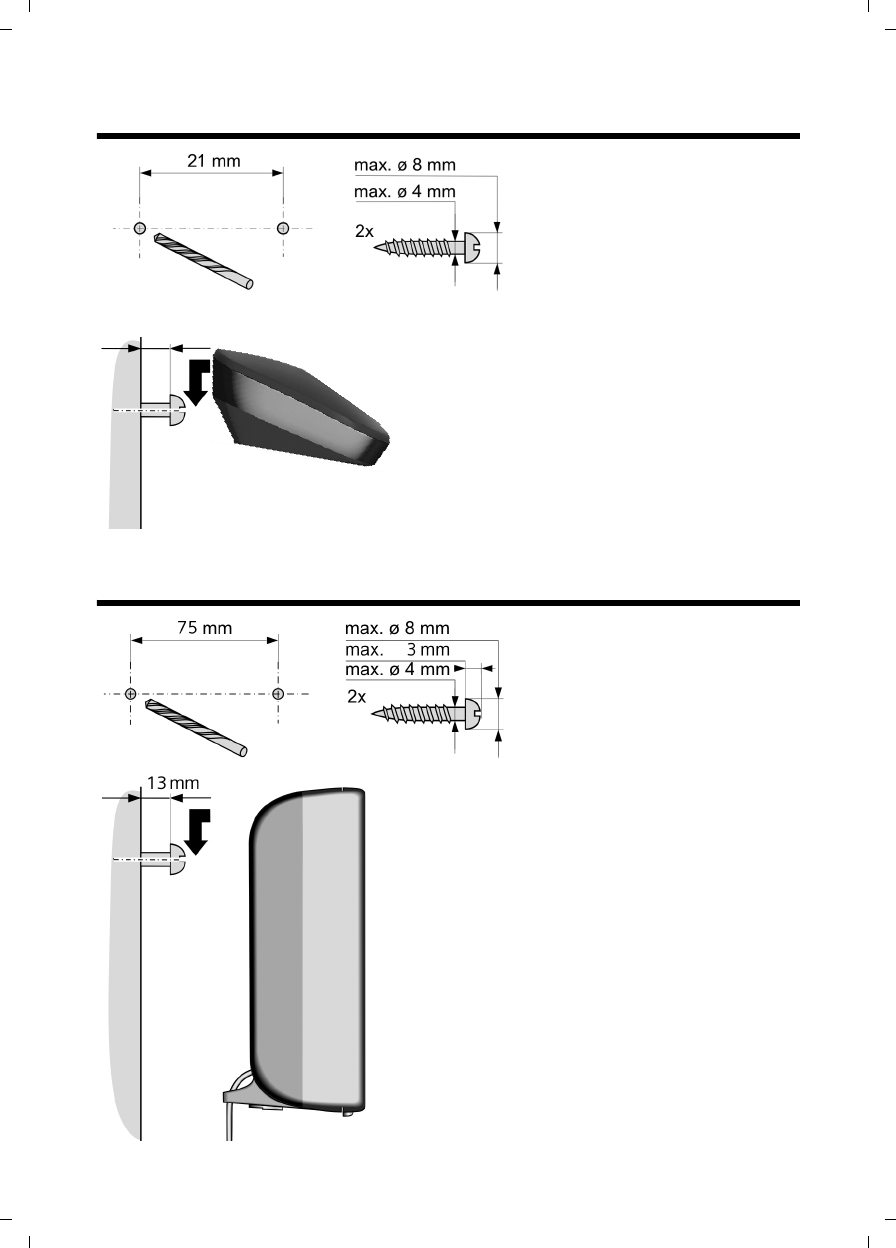
195
Mounting the charging cradle to the wall
Gigaset A580 IP / US English / A31008-xxxx-xxxx-x-xxxx / montage_charger_base.fm / 24.04.2009
Version 8, 03.09.2008
Mounting the charging cradle to the wall
Mounting the base station to the wall
approx. 2.5 mm